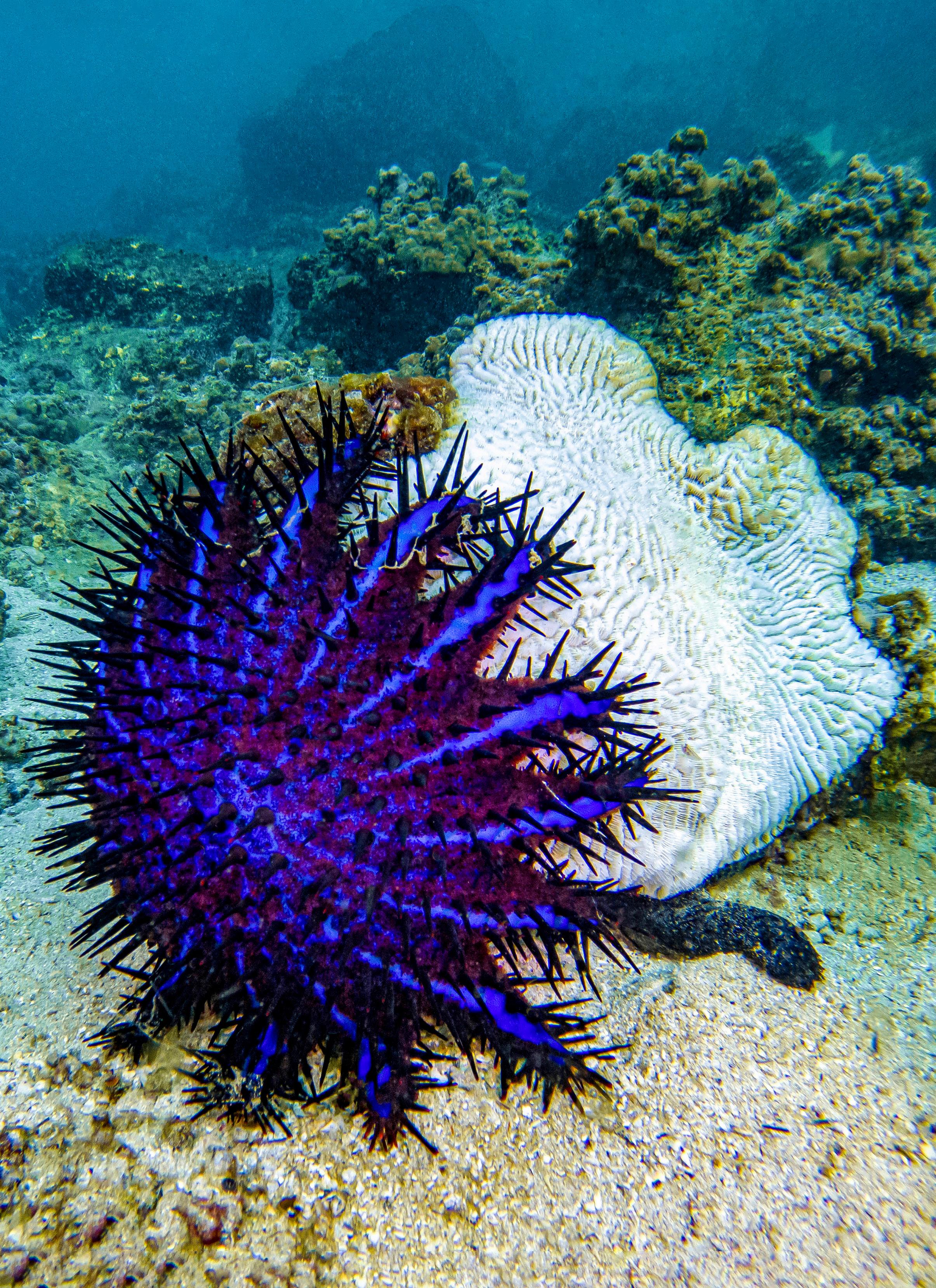
DIVERS FOR THE ENVIRONMENT WWW.EMIRATESDIVING.COM | MAGAZINE | MARCH 2024 | VOLUME 20 | ISSUE 1 Inspiring People to Care for our Oceans Since 1995 • LOCAL EDA CONSERVATION IMPACTS • PADI 2024 TRENDS • REEF CHECK NEWS • BPW BACK PLATE & WING REVIEW • CLEANUP ARABIA DIVE RESULTS • CUTTLEFISH! • DIGITAL ONLINE 2024 CROWN-OF-THORNS OUTBREAK RESEARCH A THREAT TO CORAL REEFS OFF THE EAST COAST OF THE UAE?
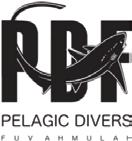

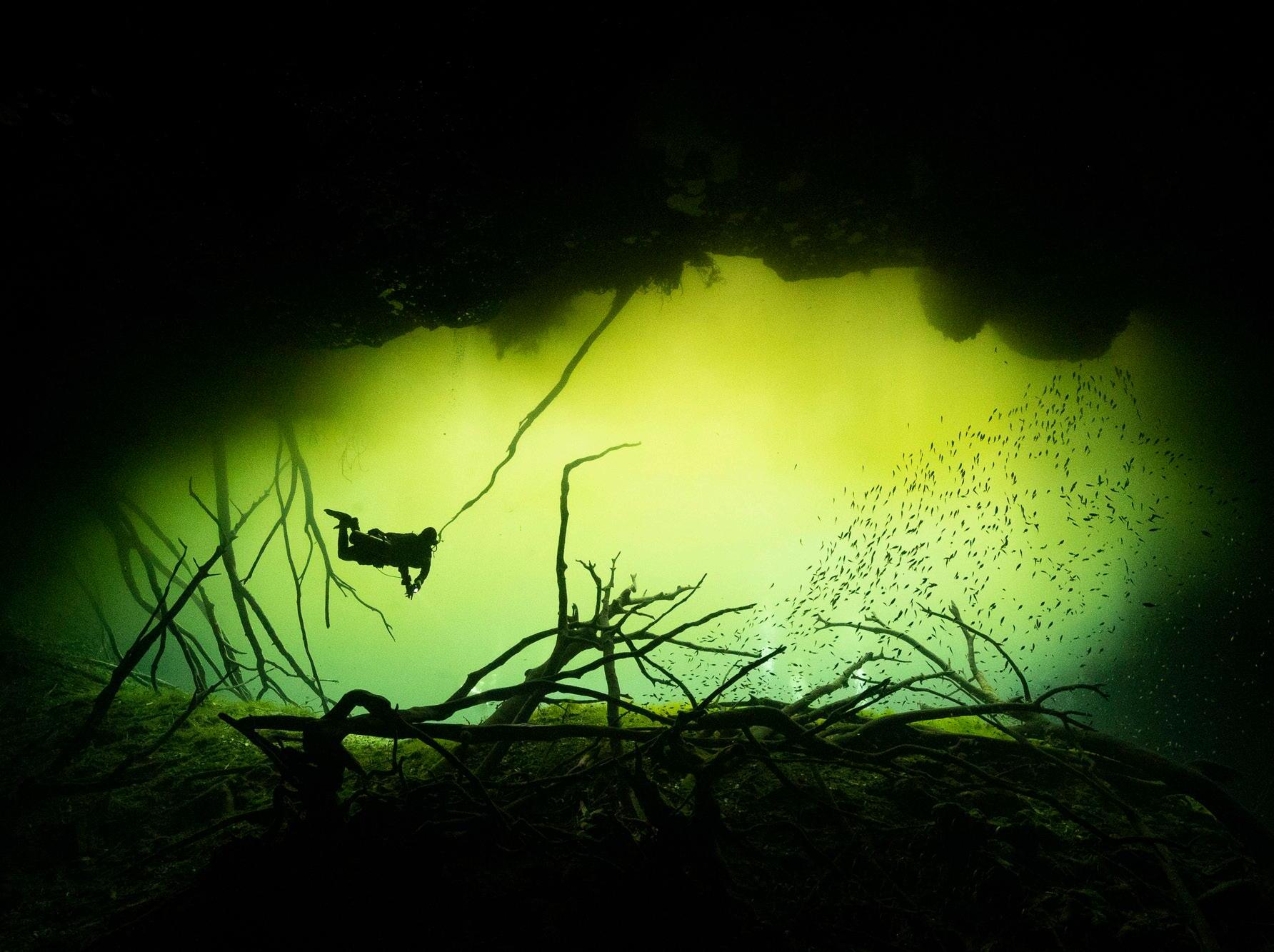



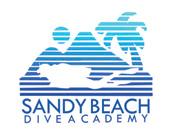
ENTER DIGITAL ONLINE EDA’S UNDERWATER PHOTOGRAPHY AND FILM COMPETITION 2024 WWW.EMIRATESDIVING.COM/EVENTS/DIGITAL-ONLINE SUBMISSION DEADLINE Thursday 4th April 2024 at 11:59pm (GST)
by Levente Rozsahegyi – Digital Online 2023
Photo
119
6
6
7
DIVERS FOR THE ENVIRONMENT
Please note that EDA’s magazine, ‘Divers for the Environment’ includes articles written by individuals whose opinions’, whilst valid, may or may not represent that of EDA’s. The magazine is a platform for individuals to voice their opinion on marine and diving related issues. You are



20 UNFCCC COP28 Marked an Important Milestone for Seagrass
With the Announcement of the 2030 Seagrass Breakthrough
21 EAD Recorded a Rare Green Turtle Nest for the First Time in Abu Dhabi
During its Annual Turtle Survey
22 MMF’s Decades-Long Research
Pivotal in Establishing New IUCN Important Shark and Ray Areas
23 The Transformative Power of Breathing
Understanding its Impact on Mind, Stress, and DecisionMaking
23 Kite Beach Clean-up Campaign
24 Diving into New Horizons:
Sandy Beach Dive Academy’s Urban Expansion
25 PADI Teams up with Wellness Brand Neuro
To Drive Ocean Change and Create a Blue State of Mind
26 PADI’s 2024 Scuba Trends
REEF CHECK
29 2023 Year in Review
30 Reef Check Malaysia Closes 2023
With Valuable Local Community Engagement
31 Transnational Reef Check Team Surveys Kelp Forest
At the Coronado Islands in Baja California, Mexico
32 EDA’s Reef Check Survey
On the Occasion of UAE Environment Day
PRODUCT REVIEWS
34 The BPW Back Plate and Wing


3 MARCH 2024 | DIVERS FOR THE ENVIRONMENT
June
Send
articles, feedback
comments to: magazine@emiratesdiving.com COVER PHOTO BY ALLY LANDES Crown-of-thorns Outbreak Research: A Threat to Coral Reefs off the East Coast of the UAE? REGULARS
EDA Co-Founder’s Note
Round-Up Upcoming Events
welcome to suggest an article for the next issue released in
2024.
all
or
5
119
Do You Know? Shark News: Issue 9 | January 2024 NEWS
EDA’s Strategic Partner Commitment to Protectin and Enhancing Ocean Health
A Natural History of the Emirates
A Presentation for EDA Members NYUAD’s Surveys Onboard the OceanXplorer
An EDA Movie Screening Inundation District 10 Local EDA Conservation Impacts
University of Khorfakkan Marine Research Institute: A Future Hub for Marine Science Excellence on the UAE’s East Coast 13 Navigating Two Decades: Divers Down’s Commitment to Sustainability and Success 14 Goumbook Celebrates Milestone with First “Save the Butts” Award Ceremony 15 Paddle Out for COP28 A Peaceful Campaign for Ocean Health + Human Health 16 Unleash Your Inner Explorer: Deep Dive Dubai Unveils Exclusive Commercial Diver Experience 17 Deep Inside –State of Mind 18 EAD Completes First Atmospheric Research Expedition in the Arabian Gulf Onboard Jaywun Research Vessel 19 EAD Signs Multi-Party MoU with OceanX, M42 and Bayanat to Further Marine Research 32 56 108 CONTENTS This issue is brought to you by DP World.
8
12
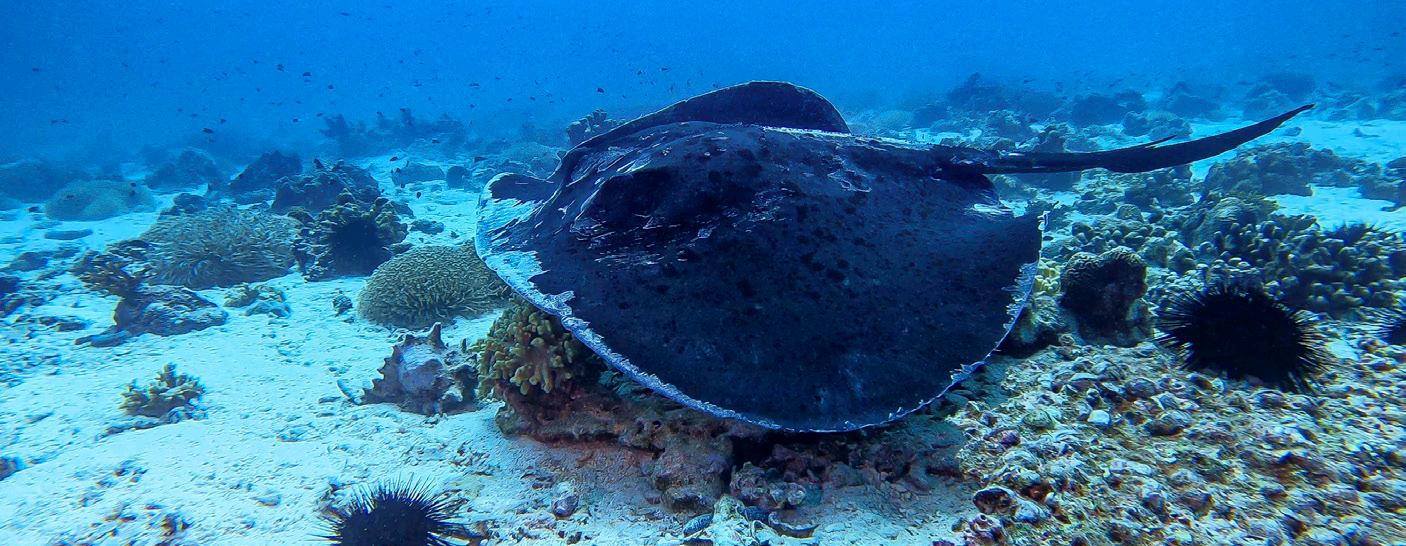
ALLY LANDES
Ally is EDA’s Project Director, Event Planner, Graphic Designer, Editor, and Photographer. She created and introduced ‘Divers for the Environment’ back in December 2004 as a free educational tool to share information by scientists, conservationists, underwater photographers, and other likeminded individuals from all over the world with a passion to conserve and protect our delicate marine life and underwater world.

Diving

ANTHONY
A
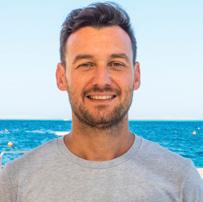
www.instagram.com/anthonyleydet_uw_photography
COVER STORY
DR HENRIK STAHL
Henrik is the Dean of the College of Marine Science and Aquatic Biology at the University of Khorfakkan. With over 20 years of experience in marine science, his professional career spans from deep-sea exploration to shallow coastal ecosystems, and from the Arctic to the Tropics.Today, Henrik is passionate about advancing marine research and education in the UAE, and about sustainable ocean management and conservation.
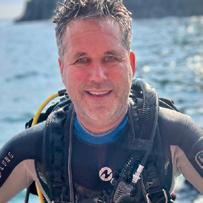
Meet the quarterly contributors who share their passions and stories with our readers. Want to
Email:
REBEKKA PENTTI
Rebekka is an environmental professional, marine scientist and a diving instructor with extensive scientific diving and regional environmental consultancy experience. In her current role as a Research Instrumentation Specialist and a Dive Safety Officer at NYU Abu Dhabi’s Marine Sciences Core, she oversees and conducts fieldwork and data collection operations, facilitates research projects by several scientists, and supports NYUAD’s oceanographic research goals with external collaborators.
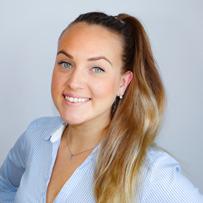
TONY SIDGWICK
Tony is a communications professional, writer and diver based in the UAE. He began his diving journey in 2016, and is now passionate about ocean conservation, with a Reef Check certification and several ocean clean-ups under his belt.
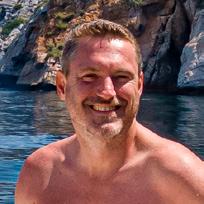
DR ADA NATOLI
Ada is a specialist in population genetics applied to conservation of species. Having been involved in whale and dolphin research since 1992, she is a member of the IUCN Cetacean Specialist List and founder of the UAE Dolphin Project.
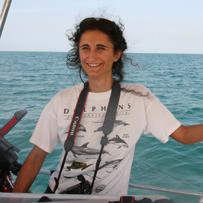
GORDON T. SMITH
Gordon has lived and dived in the Middle East region for the past 36 years. He is a frequent visitor to south east Asia, in particular to Indonesia and the Philippines. Nudibranchs and seahorses are his favourite subjects, and he’s always ready to dive in the UAE due to the variation in subjects he encounters. www.instagram.com/gordon.t.smith

4 DIVERS FOR THE ENVIRONMENT | MARCH 2024
102
CONTENTS EDITOR & GRAPHIC DESIGNER
CONTRIBUTORS
THE
contribute?
magazine@emiratesdiving.com FEATURES 38 Cleanup Arabia PCFC Marinas – Umm Suquiem 1 Dive Clean-up 44 Cuttlefish! 50 A Decade in the Making: First Dedicated Whale & Dolphin Survey in UAE Offshore Waters Onboard OceanXplorer 56 Hermit Crabs Take a Hit in the Property Market 60 rEvo Revisted 66 Crown-of-thorns Outbreak Research A Threat to Coral Reefs Off the East Coast of the UAE? 72 Probing the Depths: NYU Abu Dhabi Collaborates with OceanX for Marine Research on the UAE’s Coasts 78 Saving the Sargasso Sea A Major New Partnership to Support Sciencebased Stewardship UNDERWATER PHOTOGRAPHY 84 Enter Digital Online 2024 EDA’s Underwater Photography and Film Competition 87 Digital Online Rules and Guidelines 2024 88 The Digital Online Sponsors and Prizes 90 The Digital Online Judges 91 Tobias Friedrich To Make a Personal Guest Appearance DIVING DESTINATIONS 92 Sri Lanka South Ceylon Travel Diaries 102 Three Days of Diving The Daymaniyats
Mauritius Luxury Diving HEALTH & SAFETY
Regulators: CE Marking and Warranty
Silence in the Tower of Babel A Brief Story About Hand Signals
VAN HOESERLANDE
108
117
118
PATRICK
opens up a whole new world. Being a writer-diver and coeditor of the Flemish divers magazine, Hippocampus, Patrick personally explores our underwater world and shares his experiences through his articles. You’ll find a collection of them on www.webdiver.be
www.uaedolphinproject.org
LEYDET
graduate of
is
writer
to
Marine Biology, Anthony
an underwater photographer, blogger and
set on sharing articles and holding conferences dedicated to marine life in order
better observe nature underwater. www.zesea.com


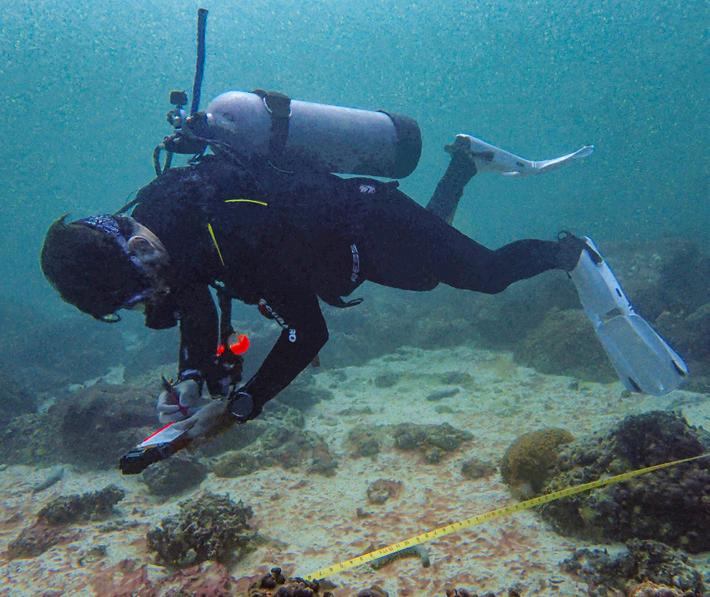
REACHING MORE OF OUR CONSERVATION GOALS IN 2024
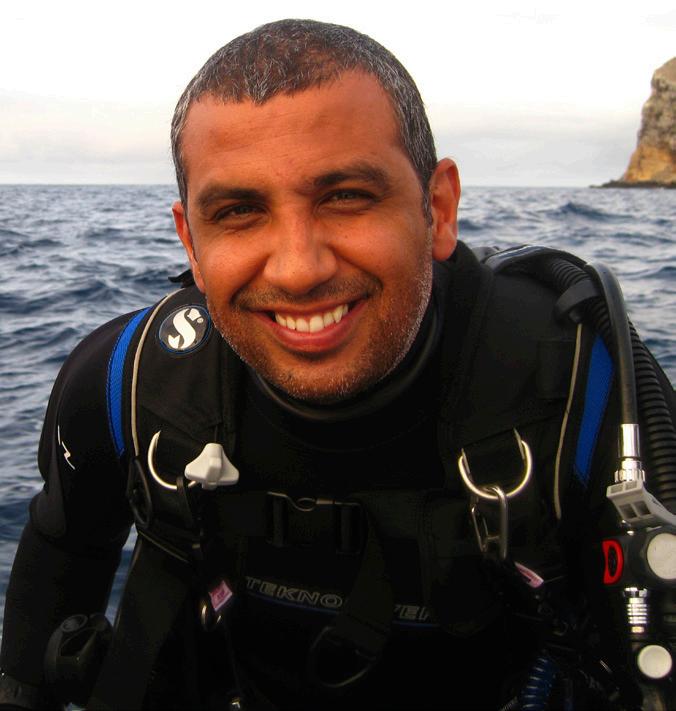 AL-ZU’BI Co-Founder
AL-ZU’BI Co-Founder
I’m thrilled to introduce you all to the March issue of ‘Divers for the Environment’. We have been incredibly productive so early on in the new year building on our marine conservation goals as a community. I would like to take this opportunity to thank our Stratgic Partner, DP World for the trust they have confided in us to work together, and to all our partners and sponsors for all the continued support they give EDA, enabling us to continue our mission in conserving and protecting the UAE marine resources. These collaborations are the only way forward for the future of our ocean health.
In January, we launched the new Local EDA Conservation Impacts plan to support local conservation projects we believe can help as a community. Individually, we can’t provide sponsorship at a corporate level, but collectively, we can provide support as a community under the EDA umbrella. If you feel so inclined, join us in taking small steps to make a big impact. You can read more about the impact plan on page 10.
The Dive MENA Expo 2024, co-located at the Dubai International Boat Show is back this March where the diving community of the UAE and the rest of the region meet to find all the latest tech, dive gear, and travel destinations. We look forward to catching up with our diving community during the show from the 28th of February, until the 3rd of March.
I am especially looking forward to this year’s Digital Online – EDA’s Underwater Photography and Film Competition to see all our member’s new images and films of all the marine life they have captured on their dive travels. A huge thank you to our partners of the past 15 years at Print Works/Giga Works for continually providing us with the winning prints.
There are some really outstanding prizes to win from our sponsors which we are also incredibly grateful for. I want to thank all our judges in advance and wish them luck in their tough job coming up to review all the amazing underwater photos and videos that will be submitted. It’s going to be another exciting awards ceremony this year at Deep Dive Dubai – not only our partner for our Digital Online Awards Night, but also for our quarterly EDA Movie Screenings.
I also want to take this opportunity to thank our EDA members who volunteer to take part in our clean-ups. We couldn’t do it without you. Thank you to our members who continuously share their insightful diving experiences and underwater photos with us. Your experiences are imperative in recommending when and where to go diving, as well as what to look out for on our trips.
I do hope you enjoy reading this issue. The EDA team continues to work tirelessly to bring more activities for EDA members to get involved in. We’re looking forward to seeing you all at the next EDA events.
Happy reading and safe diving,
 Ibrahim Al-Zu’bi
Ibrahim Al-Zu’bi
5 MARCH 2024 | DIVERS FOR THE ENVIRONMENT EDA C0-FOUNDER’S NOTE
IBRAHIM
L-R: First Cleanup Arabia dive event of 2024, photo by Muhammad R Ibrahim; Crown-of-Thorn Starfish survey, photo by Ally Landes; Reef Check survey, photo by Dr Henrik Stahl.
EDA’S STRATEGIC PARTNER COMMITMENT TO PROTECTING AND ENHANCING OCEAN HEALTH
The Emirates Diving Association (EDA) are very proud to announce their partnership with DP World as part of DP World’s sustainability strategy and commitment to protecting and enhancing ocean health.
On the 15th of December 2023, Nabil Qayed, Executive Vice President – Corporate Support, DP World GCC and Juma Khalifa Bin Thalith, EDA’s Chairman, signed the agreement in the presence of Abdulla bin Damithan, CEO & Managing Director, DP World GCC, and Abdulla Al Hashmi, Chief Operating Officer – Parks & Zones, DP World GCC.
We thank DP World for supporting our ocean and providing more opportunities throughout the next 3 years to keep our waters clean and healthy. We will be announcing more dive clean-ups throughout the year for our members to take part in.
Together, we are stronger in achieving environmental sustainability in the UAE.
FOLLOW DP WORLD
www.instagram.com/dpworlduae
www.facebook.com/DPWorld
www.dpworld.com
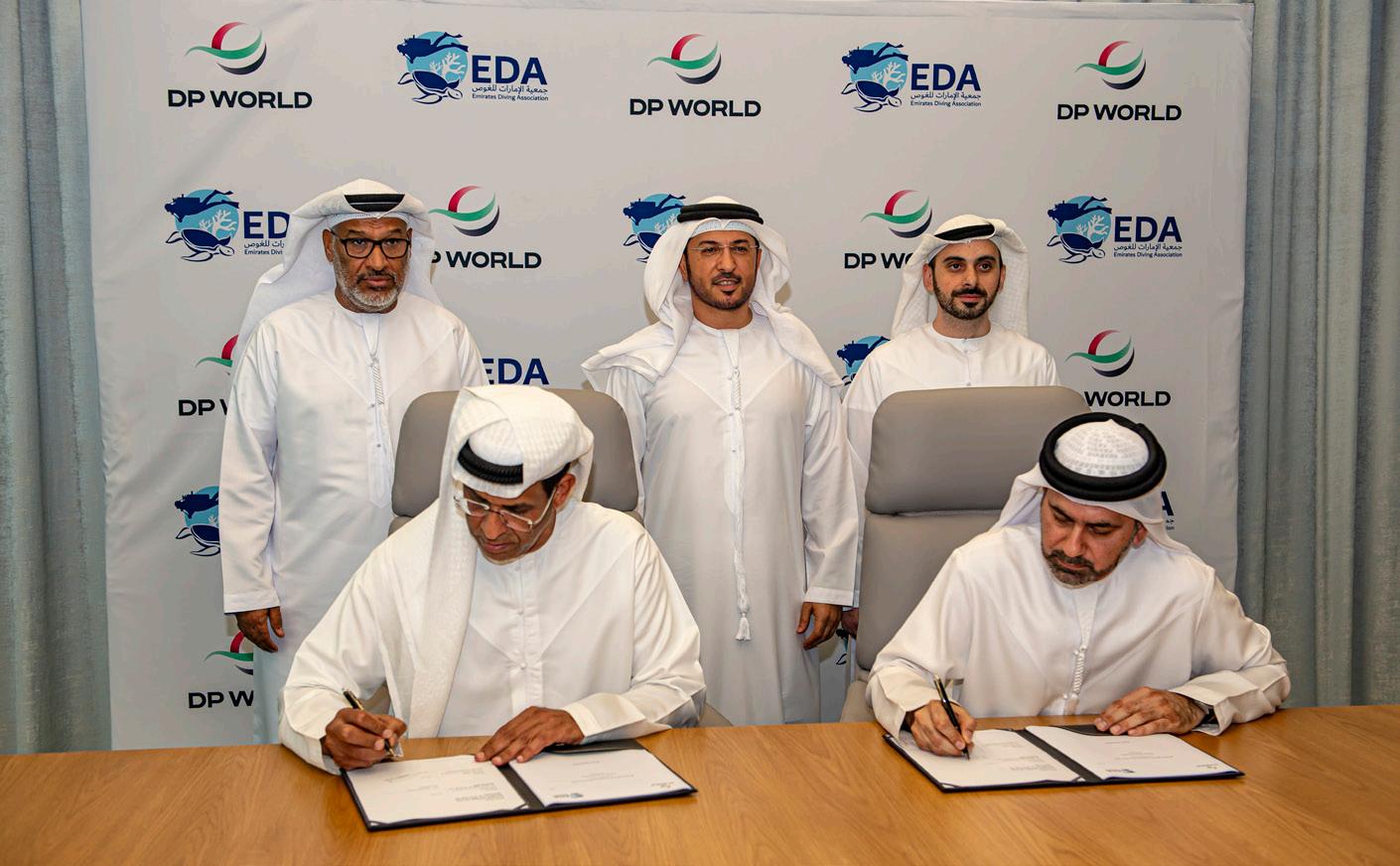

A NATURAL HISTORY OF THE EMIRATES
For many people, thoughts of the United Arab Emirates conjure images of ultramodern skyscrapers and rolling sand dunes. However, the Emirates are a rich mosaic of ecosystems and habitats that support surprisingly diverse communities of organisms, and there is growing awareness of the importance of these previously underappreciated natural assets. A Natural History of the Emirates provides a comprehensive overview of the unusual environmental setting of this young nation, and surveys the major ecosystems and the marine and terrestrial organisms occurring across the nation. From freshwater streams in the hyperarid Hajar Mountains to the world’s most temperature-tolerant coral reefs, the UAE is home to an astounding variety of uniquely adapted organisms that are providing insights into climate change and how organisms cope with and respond to extreme environmental conditions. The book closes with a section on human interactions with this unique environment, and proposes initiatives
to ensure the protection of these unique natural assets into the future.
ABOUT THE EDITOR
Dr John A. Burt is an Associate Professor of Biology and Head of the Environmental Studies programme at New York University Abu Dhabi (NYUAD), where he leads research in the Marine Biology Laboratory. He is also the co-director of the NYUAD Water Research Center and the Arabian Center for Climate and Environmental Sciences. Burt has published over 120 scholarly articles and book chapters, primarily focused on the unique environmental biology of the UAE and surrounding region. Burt also has a longstanding association with the Emirates Natural History Group, and was awarded the Sheikh Mubarak Al Nahyan Award for Natural History of the United Arab Emirates in 2017.
This book is open access, providing you free and unlimited access: https://bit.ly/4brr6ZO
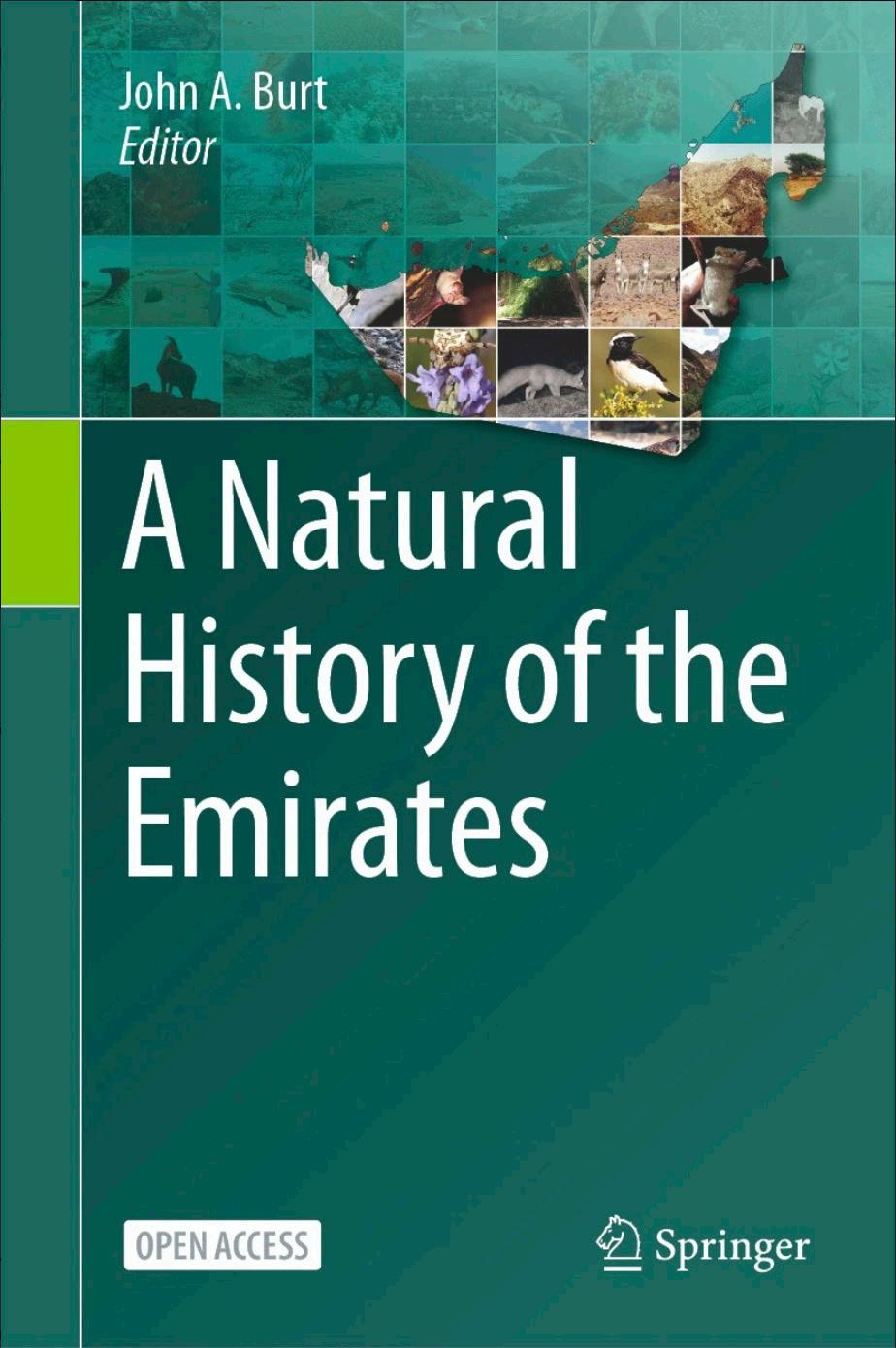
6 DIVERS FOR THE ENVIRONMENT | MARCH 2024 NEWS
A PRESENTATION FOR EDA MEMBERS NYUAD’S SURVEYS ONBOARD THE OCEANXPLORER



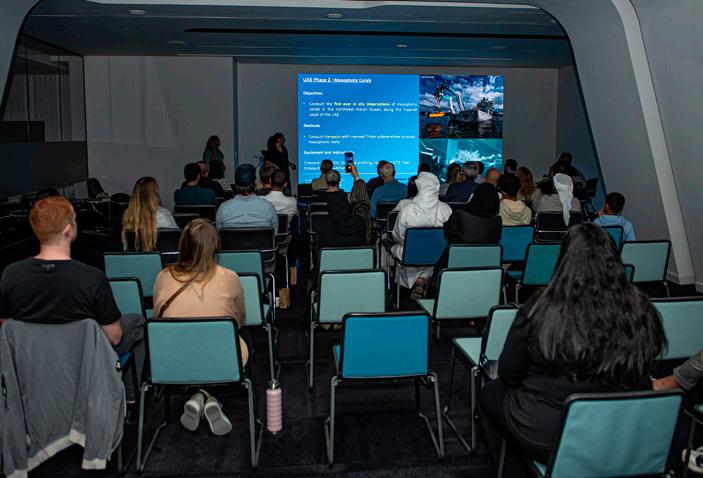
We want to thank the New York University Abu Dhabi’s (NYUAD) Research Team for sharing their collaborative work with OceanX on the 25th of January for our members at our events’ venue in partnership with Deep Dive Dubai.
OceanX, a global ocean exploration nonprofit, had recently signed a partnership to support the NYUAD’s Mubadala ACCESS Centre team and welcomed them onboard to study the unexplored marine ecosystems and biodiversity of the UAE. This unique environment boasts distinctive characteristics,
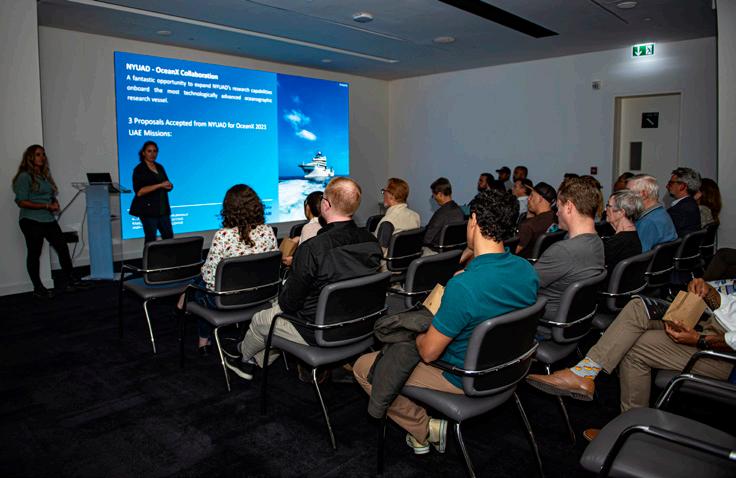
such as extreme temperatures and high salinity.
The Mubadala ACCESS Centre, a leading research group specialising in the climate and environment of the Arabian Peninsula and the Gulf region, is at the forefront of studying these challenging ecosystems.
The NYUAD team have now conducted two research missions onboard the OceanXplorer; the world’s most advanced oceanographic research vessel. From collecting samples to documenting habitats, researchers had all the tools available to study from the surface to the sea floor.
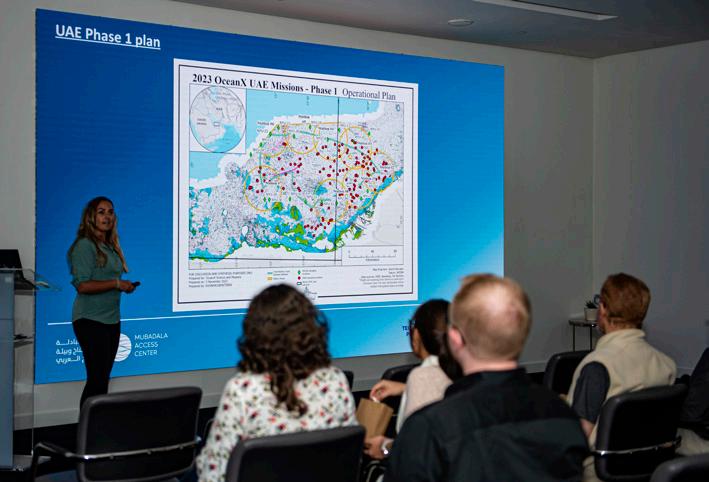
Rebekka Pentti and Beatrice Rivoira from NYUAD deepened our understanding of UAE waters, with exploring the ecosystems, biodiversity, and microbiology. We got to learn about their efforts contributing to developing a comprehensive baseline to enhance global predictions of climate change impacts and hearing of their exciting new discoveries.
Find out all about their research missions in more detail from page 72.
The Burt Marine Biology Lab at NYUAD: https://bit.ly/3wxPtF3
7 MARCH 2024 | DIVERS FOR THE ENVIRONMENT NEWS
AN EDA MOVIE SCREENING INUNDATION DISTRICT


The Emirates Diving Association (EDA) held their first members’ EDA Movie Screening of 2024 on the 1st of February at our event venue in partnership with Deep Dive Dubai, showcasing the new documentary film, Inundation District by David Abel, and Ted Blanco.The 79 minute film, a production by The Boston Globe, premiered in the fall of 2023.
EDA has screened two of David Abel’s other films over the past few years, also by filmmaker Andy Laub: Entangled in August 2021 which had to be watched as an online screening due to Covid; and In The Whale in August 2023, screened at Deep Dive Dubai.
SYNOPSIS
In a time of rising seas and intensifying storms, one of the world’s wealthiest, most-educated cities made a fateful decision to spend billions of dollars erecting a new district along its coast — on landfill, at sea level. Unlike other places imperiled by climate change, this neighborhood of glass towers housing some of the world’s largest companies was built well after scientists began warning of the threats, including many at its renowned universities. The city, which already has more high-tide flooding than nearly any other in the United States, called its new quarter the Innovation District. But with seas rising inexorably, and at an accelerating

rate, others are calling the neighborhood by a different name: Inundation District.
www.inundationdistrict.com
WANT TO JOIN OUR EVENTS?
EDA Movie Screenings are only accessible to EDA members. Members must register by email to join our social events, or to receive the special link (subject to availability) to view the films online.
Visit our website to acquire EDA membership, or to renew it, here:
www.emiratesdiving.com/membership-form
8 DIVERS FOR THE ENVIRONMENT | MARCH 2024
NEWS

9 MARCH 2024 | DIVERS FOR THE ENVIRONMENT NEWS
LOCAL EDA CONSERVATION IMPACTS
BY ALLY LANDES
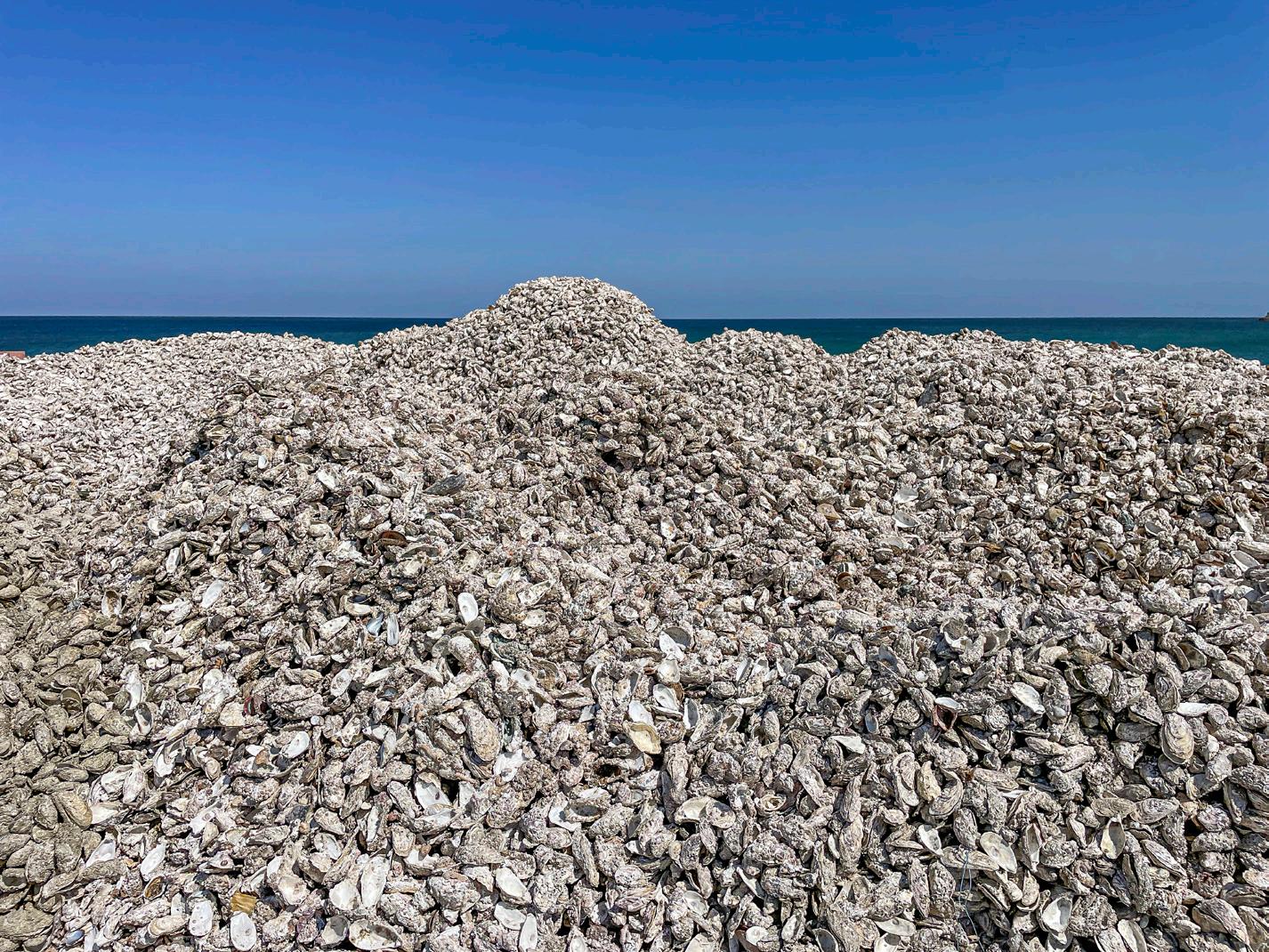

EDA COMMUNITY IMPACT PLAN
EDA has introduced the local conservation impact plan for 2024 to individual EDA Members who can opt into our new scheme to support local conservation projects. This is totally optional and not compulsory in any way.
EDA members have been removing plastics from our beaches and waters since 1995 through our Cleanup Arabia campaign.To date, we have removed 58,502.79kg of rubbish! We all want to do more to help save the ocean and fix the climate. Our eastern coastlines sit on the warmest sea on the planet, and we need to stop it from getting even hotter.
From the start of January 2024, we now have the opportunity to help local marine projects, and Dibba Bay’s Oyster Reef Creation Project is the first to have opened up to EDA with the plan of AED15/month. EDA members will be able to opt in to the


Local EDA Conservation Impacts when they acquire or renew their membership going forward by paying an extra AED180/year, on top of their AED100 EDA membership fee. 100% of this impact fund will go directly to the Oyster Reef Creation Project.
Your annual donation will go towards building and maintaining the 700m long, 40m wide reef:
• Each member who opts into the plan, will receive a digital Impact Certificate.
• Each member will receive the Impact Badge on their digital EDA membership status to show they are a supporting participant.
• Dibba Bay will provide an impact report at the end of the year which we will publish in the next December magazine issue.
• We will list each member’s name who has taken part in the impact for 2024 in the December magazine issue.
• We will organise an educational diving
trip and presentation for the participating members to visit and learn about the Dibba Bay Oyster Reef Creation Project’s progress at the end of the year.
Conservation is for absolutely everyone, and as an ocean loving community we want to bring you on the journey in our conservation objectives. As an environmental marine organisation, we create communities and connections, provide a platform for education, and collaborate with our allies to create sustainable solutions for ocean life.
Individually, we can’t provide sponsorship at a corporate level, but collectively, we can provide support as a community under the EDA umbrella. It’s how we can help support projects to get started.
Join us in taking small steps to make a big impact!
10 DIVERS FOR THE ENVIRONMENT | MARCH 2024 NEWS
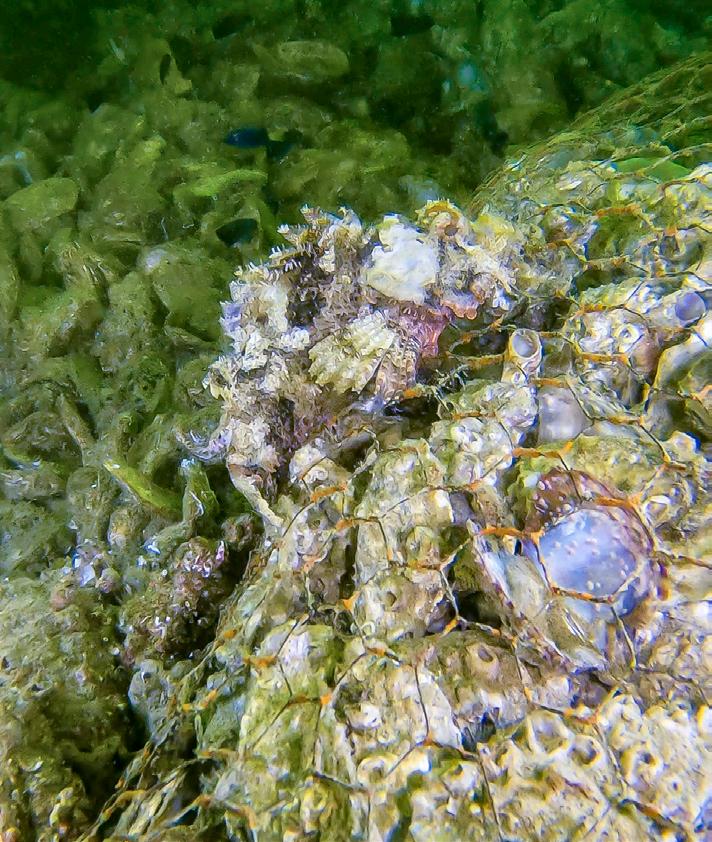




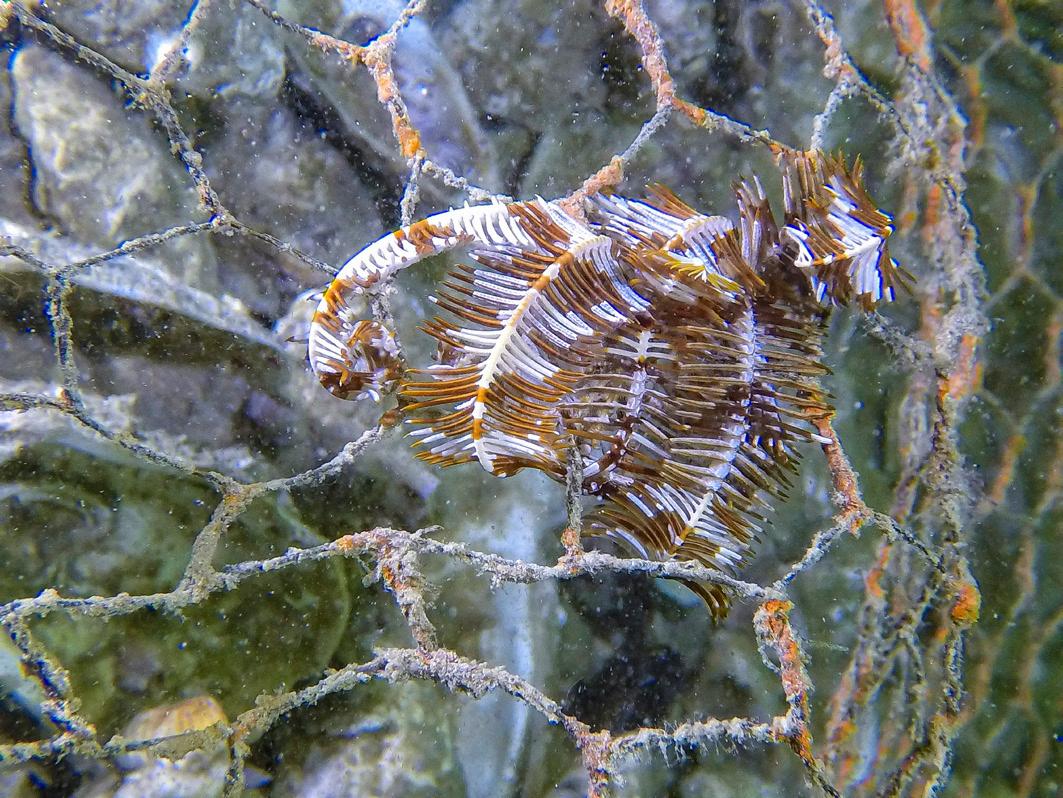
THE OYSTER REEF CREATION PROJECT
Every project needs a helping hand, and the Dibba Bay Oyster Reef Creation Project was one that piqued our interest for its simplicity, and for its environmentally friendly nature.
With the necessary funding needed to help create the project, the artificial reef aims to be a 700m structure put together with oyster shells packed into non pollutive gabion cylinder bags and dropped into the designated area to form a man-made reef from natural materials. The gabion bags will eventually break down in the salt water, but it is hoped the shells will be a supporting substrate for marine life to inhabit over time. We’re interested to see how it will develop over the course of the year. No harm can be done in this project as the shells come from the ocean to begin with.
On EDA’s first survey dive of the site in February, it was rewarding to see how much

life had settled in amongst all the nooks and crannies after only 3 months since Dibba Bay launched the project. The site lies at a depth between 7 and 10m. Despite having to contend with very poor visibility of about 3m on the day we visited due to a very strong presence of algal blooms, on close inspection, and equipped with some very good lighting, we discovered an eclectic biodiversity thriving on the reef.
Cuttlefish are using it as a nursery ground for their eggs which were safely placed under the gabion wire mesh, attached to the oyster shells. We counted 5 undulated morays, saw filefish, a couple of scorpionfish and lionfish feeding on the little critters amongst the backscatter, cuttlefish, featherstars, lots of juvenile groupers hiding amongst the gaps, plenty of hermit crabs, and lots of schools of small reef fish.
The project has been placed on soft sediment
in this experimental stage, which will show how this initial section will handle in this specific environment.
Dibba Bay will extend the reef, but need support for financing the logistics of the operation. This is where EDA comes in!
Your donations will go directly to funding the operational aspect of collecting the shells, creating the gabion bags, and transporting them to the site. Every dirham will count in this positive impact project!
HOW TO GET INVOLVED
To participate in our impact plan for Dibba Bay’s Oyster Reef Creation Project, go to our website for payment
instructions:
www.emiratesdiving.com/membership-form
11 MARCH 2024 | DIVERS FOR THE ENVIRONMENT NEWS
UNIVERSITY OF KHORFAKKAN MARINE RESEARCH INSTITUTE: A FUTURE HUB FOR MARINE SCIENCE EXCELLENCE ON THE UAE’S EAST COAST
BY DR HENRIK STAHL, DEAN
OF THE COLLEGE OF MARINE SCIENCES AND AQUATIC BIOLOGY AT THE UNIVERSITY OF KHORFAKKAN
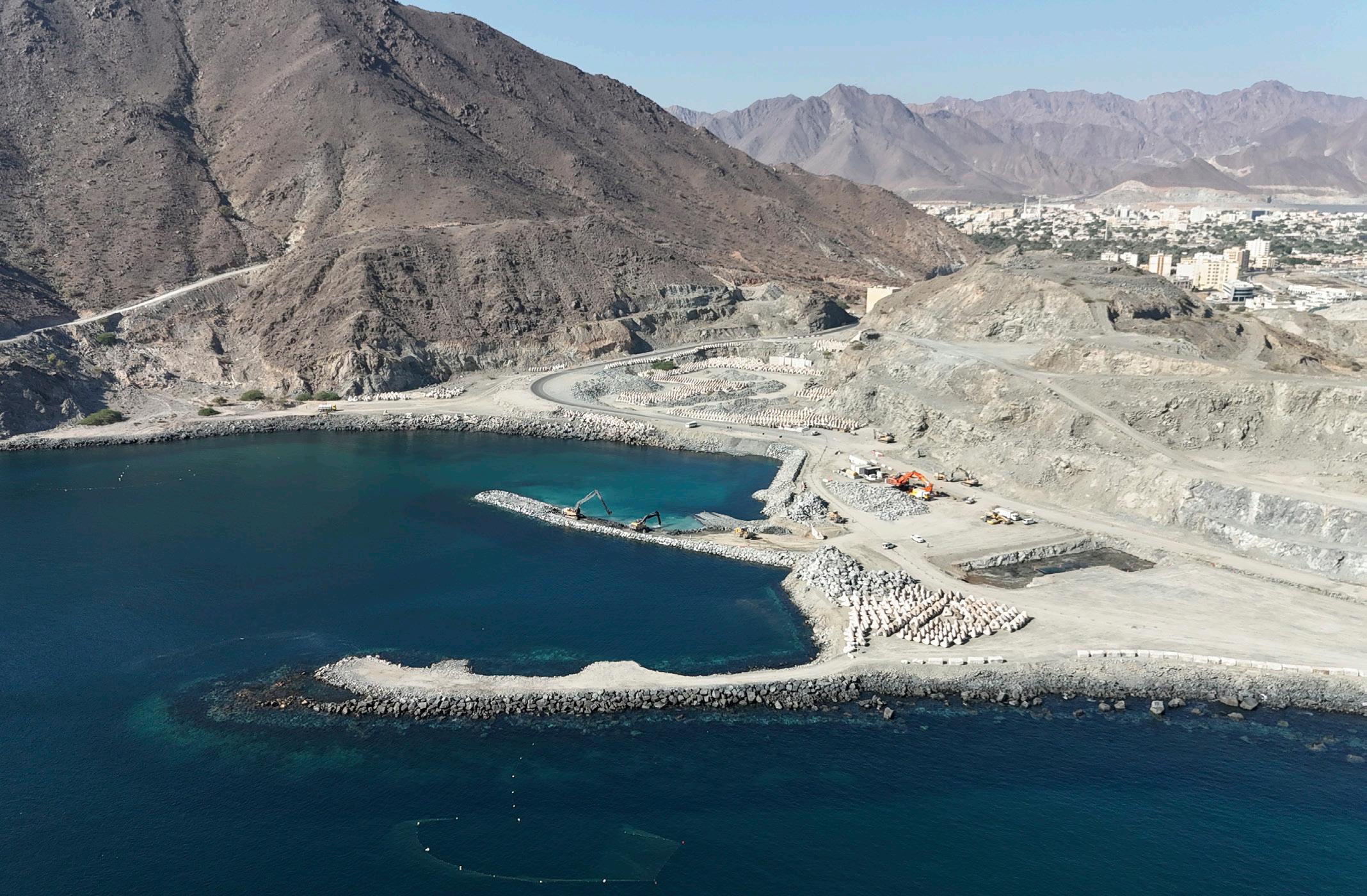
Excitement is brewing in the coastal town of Khorfakkan, Sharjah, UAE, as plans for the upcoming Khorfakkan Marine Research Institute (KMRI) are taking shape. This state-of-the-art marine research institute, generously funded by HH Sheikh Dr Sultan bin Muhammad Al Qasimi, Ruler of Sharjah and President of the University of Khorfakkan (UKF), is set to advance marine science in the United Arab Emirates (UAE) and beyond.
The KMRI will be nestled behind the bustling Khorfakkan harbour, overlooking the beautiful waters of the Gulf of Oman. Its physical infrastructure is due to be completed by the end of 2024, and the institute should be fully operational by September 2025. Boasting cutting-edge research laboratories, a scientific aquarium facility, dedicated teaching facilities, and a scientific dive centre, the institute promises to become a hub for innovation and discovery in marine science in the region.
"One cannot overstate the significance of the Khorfakkan Marine Research Institute for advancing marine science and innovation in our region. We are thrilled about the opportunities it will provide for research, education, and
national and international collaboration at UKF" says Prof. Ahmed Al- Shamma'a, Chancellor of the University of Khorfakkan.
One of the institute's standout features is its small harbour, which will accommodate coastal research vessels for expeditions into the rich marine ecosystems of the region. With space for up to 20 marine scientists and an equal number of post-graduate students, the KMRI will serve as a vibrant hub for marine research, education, and collaboration.
In addition to fostering scientific inquiry, the KMRI will play a pivotal role in nurturing the next generation of marine biologists and researchers in the UAE. Students from the newly developed Bachelor of Science programme in Marine Biology at UKF will have the unique opportunity to conduct their final two years of study at this research-active institute, gaining hands-on experience and mentorship from leading experts in the field.
The KMRI's mission extends beyond academic pursuits to address pressing marine conservation challenges and drive technological innovation in marine science.
With a focus on the unique marine ecosystems of the region, the institute aims to advance our understanding of marine biodiversity, ecosystem dynamics, and sustainable management practices.
As construction progresses and anticipation builds, the new Khorfakkan Marine Research Institute stands poised to make waves in the world of marine science. With its visionary leadership, state-of-the-art facilities, and commitment to excellence, the KMRI is set to chart a course toward a brighter, more sustainable future for our oceans and marine environments.

12 DIVERS FOR THE ENVIRONMENT | MARCH 2024 NEWS
ABOVE: Drone overview of the Khorfakkan Marine Research Institute building site from November 2023, with Khorfakkan city in the background. BELOW: The location of KMRI on google maps.
NAVIGATING TWO DECADES:
DIVERS DOWN’S COMMITMENT TO SUSTAINABILITY AND SUCCESS

Divers Down was established in 2003 and recently marked a significant milestone with its 20th Anniversary Celebration. Reflecting on two decades of success, the centre reminisced its journey, achievements, and memorable moments, while also treating its customers and staff to exciting giveaways as part of the festivities. Divers Down leads in offering inclusive and expert diving lessons, welcoming divers of all skill levels to experience the wonders of the underwater realm. Scuba Diver, Open Water Diver, and Adventure Diver are just a few of the courses offered by their qualified instructors, who can accommodate a wide range of interests and demands. Divers Down offers something for everyone, regardless of their experience level, from beginners looking to learn about the world of diving, to skillful divers looking for new experiences.
When it comes to sustainability Divers Down aims to be the leader, and it accomplishes that by instilling a strong sense of responsibility for the ecosystem in all its divers, and by participating in various educational projects and programmes. Divers Down efforts to address marine pollution are supported by programmes such as Project AWARE's Dive Against Debris, which helps to preserve marine habitats by sending volunteers to clear debris from underwater areas while also gathering substantial information to guide conservation efforts. Additionally, Divers Down's participation in AWARE Week and World Clean-Up Day reflects its commitment to the environment. We have also collaborated with Dubai Police Headquarters to

organise a large-scale clean-up event, in which more than 1,000kg of debris was removed. Another 200kg worth of debris was removed in collaboration with Emirates NBD.
Divers Down expands its sustainability efforts into the field of education through interactive educational experiences which seek to shift children's perspectives of the ocean to inspire the next generation of environmental leaders. We do so by educating students on marine ecosystems and their conservation, and by also informing them of sustainable practices. The students can then obtain PADI Speciality Certification, which enables them to actively participate in the preservation of marine habitats.
Divers Down also actively addresses the detrimental effects of plastic waste such as plastic straws and bags and advocates for a more recycled economy. Moreover, we establish partnerships with local communities, schools, and organisations to promote sustainable practices and foster a culture of environmental stewardship.
Divers Down ensures to promote eco-friendly practices among its staff, and it accomplishes that by providing them with accommodation close to their place of work and by transporting them in one single vehicle, which would lead to a reduction in their ecological footprint.
Additionally, we have implemented a ban on single-use plastics, setting a standard for responsible environmental changes by promoting reusable alternatives, and encouraging consumers to do the same. Moreover, we also work to create environmentally friendly clothing by using recycled materials such as coffee grounds and ocean waste. These decisions not only help the environment but also raise awareness about the importance of sustainable fashion.
Amongst their future initiatives for 2024, is the formation of partnerships to recycle plastic in various bins, which expands efforts to limit the usage of plastic.
To conclude, Divers Down is committed to sustainability, encouraging ethical diving, and protecting marine environments through partnerships, education, and advocacy. We actively look for methods to improve sustainability programmes and participate in campaigns to preserve the environment and marine life in 2024 and beyond. We are launching new projects for an environmentally responsible business. By including sustainability in our basic principles and functioning methods, Divers Down sets a positive example for the diving industry and beyond, which is essential for the present and future generations' well-being.
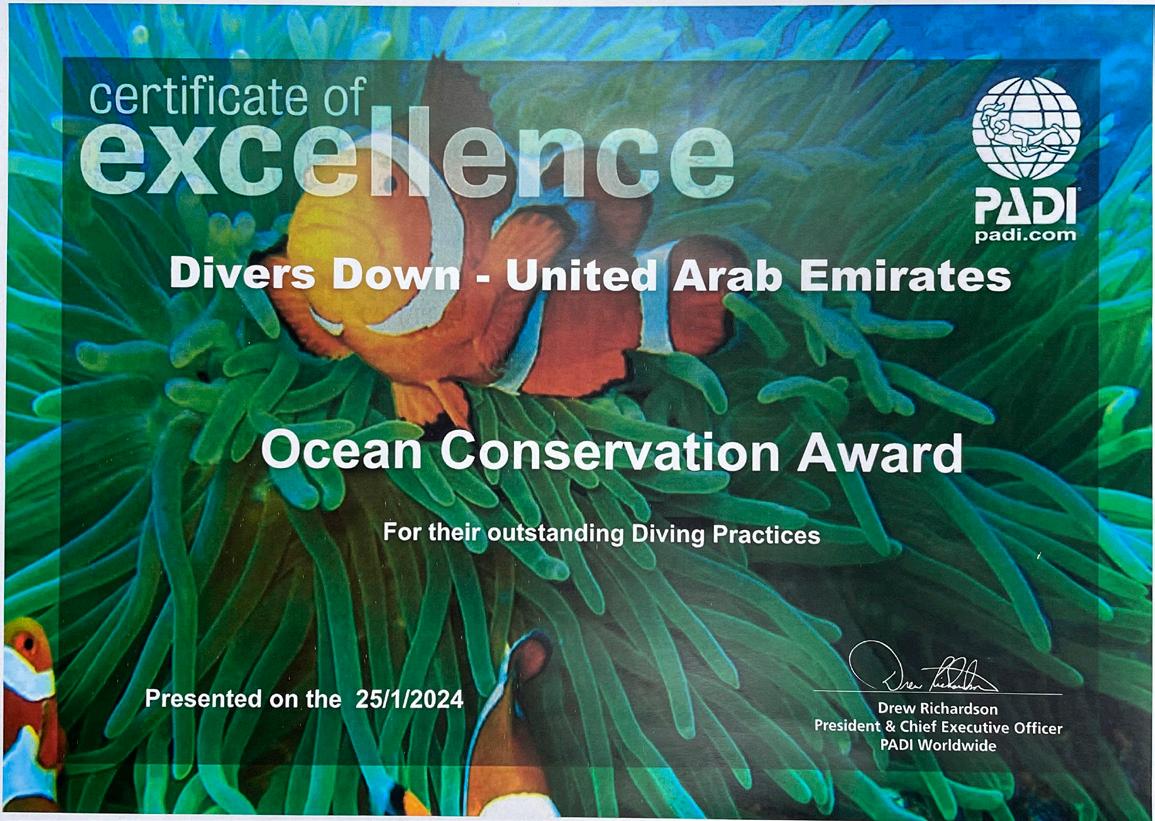
www.diversdownuae.com
13 MARCH 2024 | DIVERS FOR THE ENVIRONMENT NEWS
GOUMBOOK CELEBRATES MILESTONE WITH FIRST “SAVE THE BUTTS” AWARD CEREMONY

On the occasion of UAE Environment Day, Goumbook, a pioneer in sustainability initiatives in the UAE, proudly announced the success of the first “Save the Butts” award ceremony on the 2nd of February 2024. The event marked a milestone in the history of the campaign, celebrating the collection of one million cigarette butts from the environment and their transformation into a valuable manufacturing material.
“Save the Butts – Waste to Value” is a Goumbook campaign in partnership with the Ocean Conservancy, and Atlantis Dubai as part of their Atlas Project. The campaign is the first community-based sustainability initiative in the UAE that adopts a circular economy approach to environmental pollution: it collects and converts cigarette butts – the second mostlittered item in the world – into a sustainable manufacturing material. The cigarette butts are collected by the local waste recycling company, Ecyclex and are then transformed by the UAE-based start-up Terrax. Since its launch in February 2022, “Save the Butts” has engaged with over 3,100 volunteers, across 74 beach clean-ups, and collected over one million cigarette butts – the equivalent to almost 230kg of highly toxic plastic waste.
Goumbook presented awards to all participants that were crafted from a unique material produced by Terrax. This material is made by mixing cigarette butts with other hard-to-recycle materials. The trophies symbolise circularity and serve as tokens of appreciation for the trust and support extended by all participants. Some of the award recipients include Dubai Municipality, Accenture, Abdulla Al Ghurair Foundation,
Arbor School, Bloomberg, Dubai College, HSBC, LinkedIn, Nord Anglia School, Omnicom Group, Emirates Diving Association (EDA), and Surf House.
“Our beach clean-ups in particular have gained a lot of traction with corporates, schools, and community groups. Through the embedded educational element, these events foster a sense of collective responsibility and environmental stewardship”, said Tatiana Antonelli Abella, Founder and Managing Director of Goumbook.
Pointing out an interesting observation, Goumbook’s Senior Campaign Manager, Marta Roman, commented, “A significant portion of the collected cigarette butts – approximately 55% – originated from annual commitment members, comprising businesses, hotels, and community centres, that established permanent collection points at their premises. This underscores the potential of preventing waste from going to landfill and emphasises the impact of establishing waste collection points in public spaces.”
Education is a key pillar of both legs of the campaign: Every clean-up event starts with an awareness session explaining that cigarette butts are mostly made up of plastic and throwing them into the environment constitutes a littering problem. Each installation of a permanent collection point is accompanied by key messages around the plastic pollution crisis, behavioural aspects of littering, and the value of waste in a circular economy.
TINY BUT DEADLY
Cigarette butt pollution poses a persistent
environmental challenge, with an estimated 4.5 trillion a year discarded worldwide. The ubiquity of this issue extends beyond the visible littering problem, as cigarette butts release toxic chemicals that contaminate soil and water. Despite their small size, they pose significant ecological threats, adversely impacting wildlife, marine ecosystems, and public health. The lack of awareness surrounding the environmental repercussions of improper disposal exacerbates the problem, necessitating urgent collective action, innovative waste management solutions, and increased public education to mitigate the far-reaching consequences of cigarette butt pollution on a global scale.
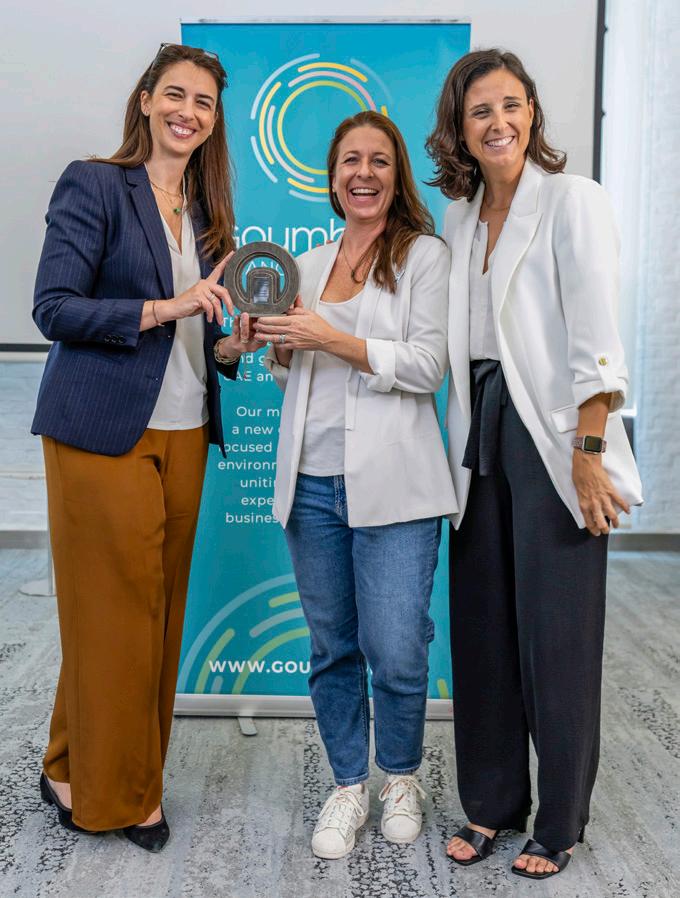
14 DIVERS FOR THE ENVIRONMENT | MARCH 2024 NEWS
L-R: Tatiana Antonelli Abella, Goumbook’s Founder & Managing Director, Ally Landes, EDA’s Project Director, and Marta Roman, Goumbook’s Senior Campaign Manager.
PADDLE OUT FOR COP28
A PEACEFUL CAMPAIGN FOR OCEAN HEALTH + HUMAN HEALTH

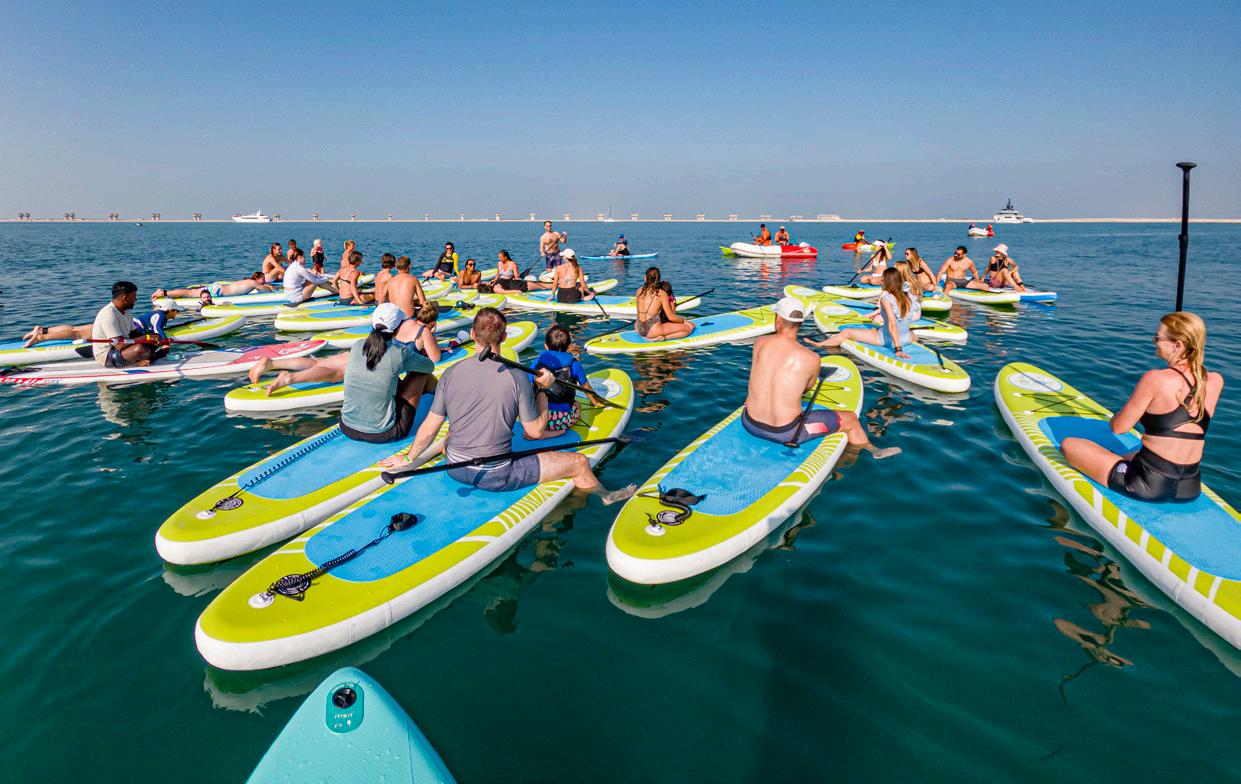

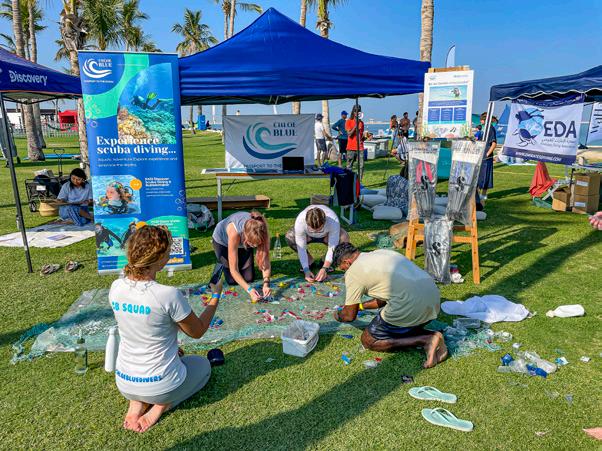

On the 10th of December last year, EDA took part in Shore Thing Surf Therapy’s event: Paddle Out for COP28 which was a symbolic community gathering in the ocean uniting surfers, SUPers, divers, ocean lovers and ocean stewards to raise awareness for ocean conservation during COP28.
We were there with our stand, Chloe Blue Diving Club was also there, as well as ice baths by Heal Hub, yoga by YoFit Studios, an art workshop by Studio Passepartout, art by Melissa Goodenough, and The Ecoheroes children’s books by Colette Barr at www.saveourworld.me, illustrated by Leona Collins, to name a few.
The participants paddled along a 2km route to link and form a circle where we experienced an Indigenous Water Ceremony with music and ocean blessings by an ancient Hawaiian tradition used to celebrate and pay tribute

to surfers who pass away. Today, the ceremony has evolved beyond the concept of memorials and is now a way of honouring or paying tribute to other causes related to the ocean.
We are all guardians of the ocean. Without ocean health, there is no human health.This marked a very special day for everyone to share with friends and family.
Shore Thing is a UAE-based community initiative that launched in December 2021. Designed to heal and enable recovery from issues such as PTSD and depression, Surf Therapy leans into the science of Blue Mind. The experience of being in the water creates a profound connection that has proven to be beneficial to various communities all over the world.
www.dothemostglobal.com/surftherapy




NEWS
UNLEASH YOUR INNER EXPLORER:
DEEP DIVE DUBAI UNVEILS EXCLUSIVE COMMERCIAL DIVER EXPERIENCE
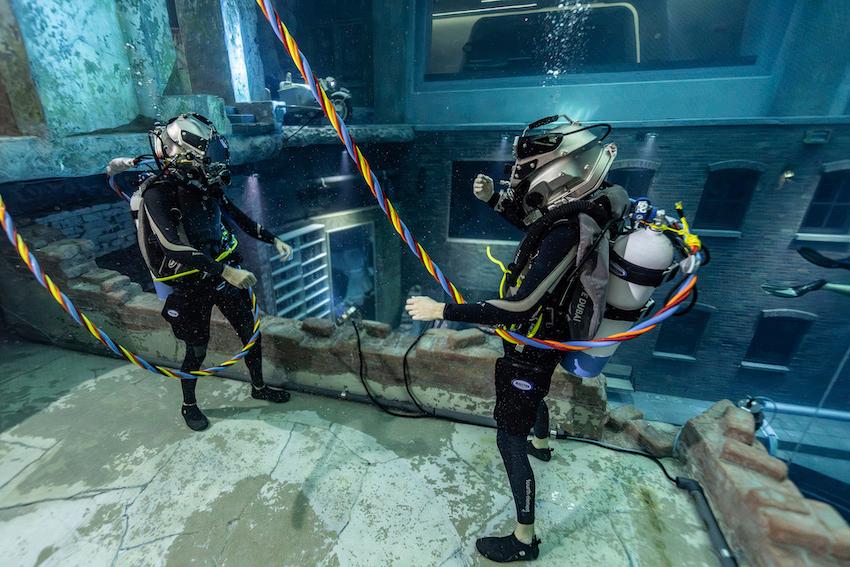
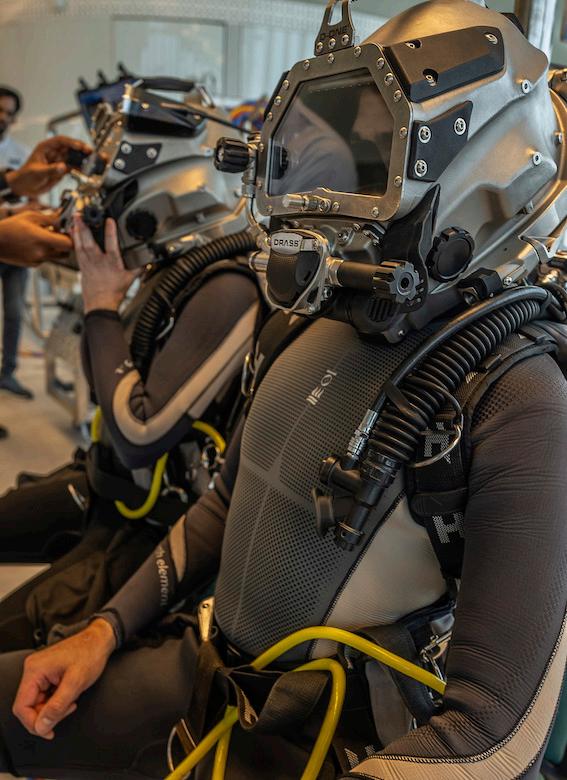

Deep Dive Dubai is proud to announce the launch of an unparalleled experience – the Discover Commercial Diving experience. Breaking new ground, Deep Dive Dubai is the first and only facility in the world to offer enthusiasts a chance to delve into the intricate world of commercial diving.
The Discover Commercial Diving experience invites certified scuba divers to explore the fascinating equipment, tools, techniques, and procedures that define the realm of commercial diving. Participants will embark on a journey into the depths of underwater professionalism, experiencing the challenges and rewards of a commercial diver’s world firsthand.
Key highlights of the Discover Commercial Diving experience includes immersive experiences with cutting-edge equipment such as surfacesupplied gases, two-way communication systems, and helmet-mounted video cameras. The experience kicks off with a comprehensive briefing, followed by engaging field drills that prepare participants for the unique challenges that commercial divers encounter.


Participants will have the opportunity to collaborate with another diver and the expert surface crew, working together to solve a variety of tasks. The emphasis on teamwork and communication underscores the importance of these skills in the successful execution of a commercial dive. It’s not just an adventure; it’s an opportunity to discover the vital role that collaboration plays in the world of commercial diving.
Deep Dive Dubai, known for pushing the boundaries of underwater exploration, is excited to offer this exclusive experience to the global community of adventure seekers and diving enthusiasts. Whether you’re a seasoned diver or someone looking to take the plunge into the world of commercial diving, the Discover Commercial Diving experience promises to be an unforgettable and educational journey.
“We’re thrilled to introduce the Discover Commercial Diving experience at Deep Dive Dubai, providing a unique opportunity for certified scuba divers to step into the shoes of
a commercial diver. This experience not only offers a thrilling adventure but it’s also a chance to gain insights into the skills and teamwork required for a successful commercial dive,” explains Richard Lundgren, Technical Manager at Deep Dive Dubai.
COMMERCIAL DIVER EXPERIENCE
PRICE: AED3,000
MAKE A BOOKING
Book your spot for a one-of-a-kind underwater adventure at www.deepdivedubai.com or book directly at https://bit.ly/3SCiNC0
WATCH THE VIDEO
See our video explaining commercial diving here: https://bit.ly/49zS1kl
16 DIVERS FOR THE ENVIRONMENT | MARCH 2024 NEWS
DEEP INSIDE – STATE OF MIND
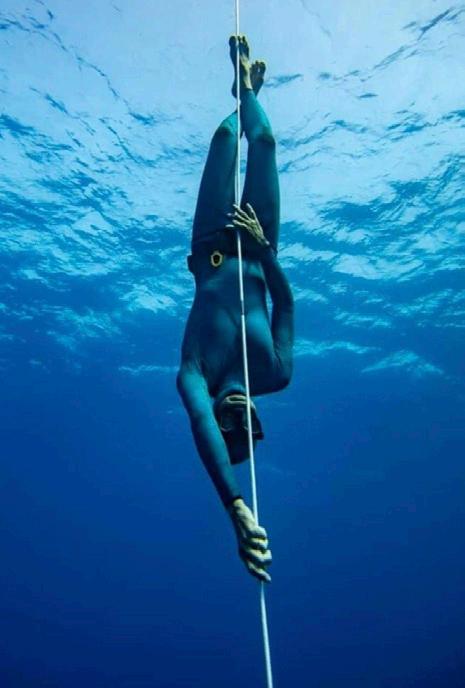
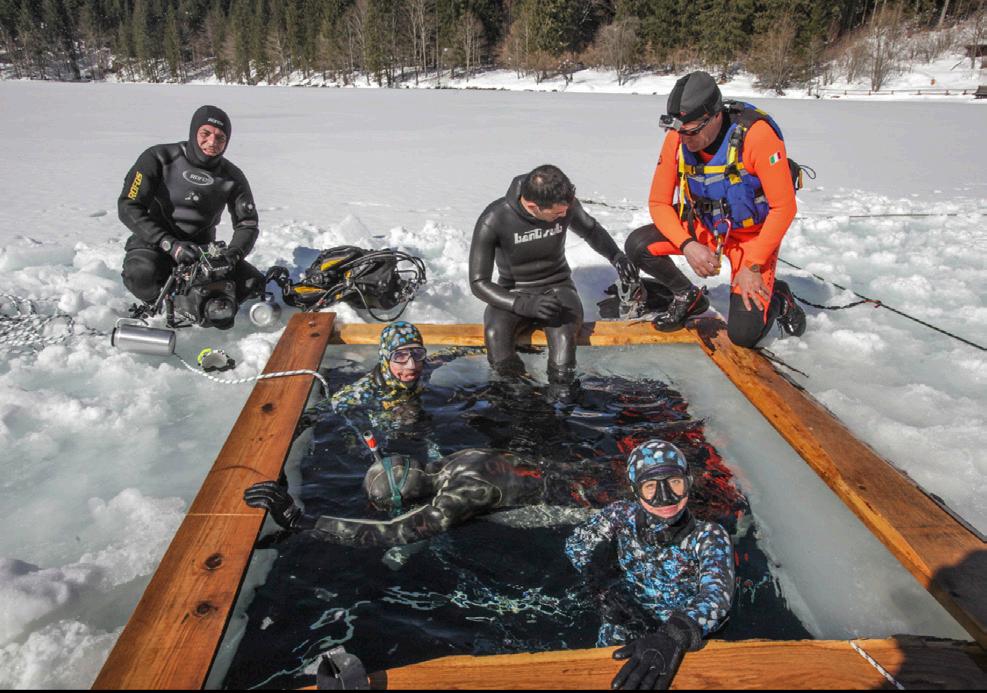
Nature never ceases to amaze us. It surprises and moves us in every form. From the extraordinary expression of biodiversity to beauty, survival strategies, and the correlation between living beings and ecosystems, it reveals how DNA has been capable of adapting and evolving, creating diverse forms of life expression: plants, animals, and fish. This wonder infects us every time we find ourselves immersed in nature, making us understand how, in his evolution, Man feels today more than ever the fundamental need for this contact. A need for real nourishment to draw energy, in every form, from breathing to food and mental regeneration. Various research confirms how powerful the regenerative power can be, and in some cases even healing, when in contact with nature. We can all sense it, and science today confirms it.
Less known, but under the scrutiny of the scientific world, is how water and immersion are powerful tools that can be used to improve well-being, concentration, and cognitive functions. This is what Alessandro Vergendo, one of the leading international experts in cognitive neuro-enhancement, who works alongside both top Olympic champions, national sports teams, and important top managers and companies, explains to us.
“It all started when I began scuba diving, first with breathing apparatus, and then becoming passionate about freediving, which led me to eventually becoming an instructor. I met the great champion Umberto Pelizzari, and today I work alongside him to teach freediving instructors mental training techniques. Thanks to the studies I have conducted, I immediately understood the potential that diving could offer, especially when combined with a specific path and method of stimulation. I realised how this practice could also be useful in everyday life. Diving in the sea changed my life, and I believe anyone who has tried it knows very well the sensations and well-being that come after a dive. It’s a true immersion not only physically, but also mentally.”
Today, Alessandro Vergendo works with Rosarita Gagliardi and a team of researchers, in collaboration with various universities, to monitor both physiological and neurophysiological parameters. “I wanted to understand if the aquatic element, combined with underwater immersion and appropriate stimuli, could help improve some useful mental abilities not only to relax but also to improve one’s performance, even cognitive. For this reason, I involved neurophysiologists and the European neuroscience department to monitor a mental training protocol with an evocative name, called ‘Deep Inside – State of Mind.’ The results of the scientific monitoring were astonishing.”
The work was carried out with both athletes and managers, and the results led to an improvement in performance and well-being for both. Alessandro Vergendo explains, “Immersion combined with certain stimuli leads us to improve concentration, selfawareness, and stress management. It has also been seen to improve problem-solving, decision-making, cognitive flexibility, and emotional regulation. All characteristics of the person’s higher cognitive functions.”
Today, thanks to underwater activities, Alessandro Vergendo leads these great champions and top managers to immerse themselves, with a preference for sea dives. While it may seem normal to train our minds by immersing swimmers, it’s more curious to see skiers, fencers, rugby players, and triathletes immersed. The same has been done with some top managers, with results that have attracted the attention of one of the world’s most important economics universities, such as the Bocconi University in Milan, Italy. Thanks to the team with Rosarita Gagliardi and Silvia Pozzi, a research protocol called ‘mind the deep’ was executed, applying the deep inside methodology to managers. Neuroscientific monitoring carried out by IRCan – European Institute of Neuroscience Research on the EMBA managers of Bocconi University highlighted a significant improvement in
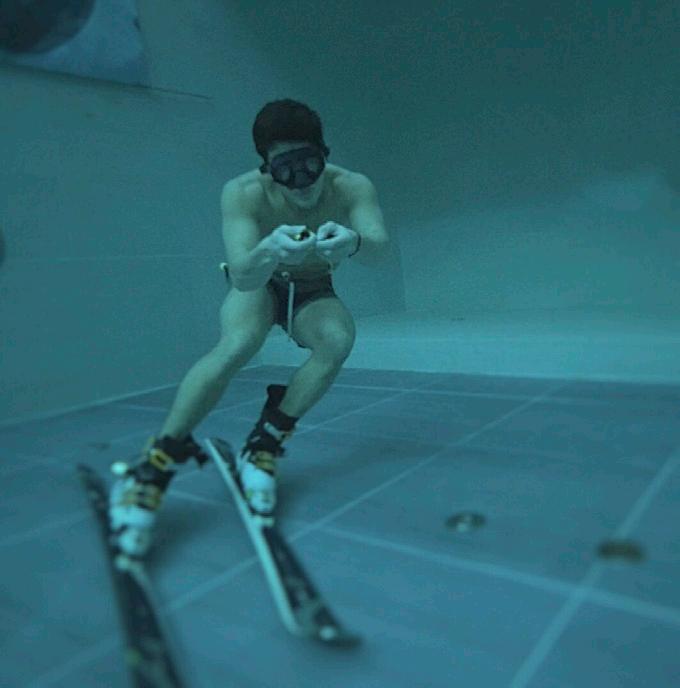
attentive focus, stress management, selfawareness, and emotional regulation in just six sessions. A recently proposed experience is also here in the UAE at Deep Dive Dubai with the top managers of Alunni Arabian Bocconi Peninsula.
“The regenerative power and emotional impact that the sea offers us are extraordinary. Just think about how many common words in everyday life refer to diving practices. The sea and water have the ability to bring sensations and automatic rationing mechanisms that people experience in everyday life often unconsciously, in just a few minutes of practice. For example, people learn to recognise how they manage stress, automatic reactions under pressure, when they run out of breath, their thoughts, and emotions, etc.
All aspects highlighted in immersion, and today, thanks to this path of cognitive neuroenhancement with Deep Inside – State of Mind, people have the opportunity to become aware and modify their behaviours. Therefore, we delve into the aspect of internal thought, activation state, expectations, and emotions. Today, together with Rosarita Gagliardi, an expert in breath training and apnea, I take athletes to the sea and immerse them, letting the profound language of nature connect humans to the regenerative power of the sea. It’s surprising to observe that without many words but with a real experiential laboratory, the sea and water bring out patterns of reaction and automatic behaviours.”
It’s precisely the case to say, nature and the sea give us an extraordinary opportunity. Immersed deeply within ourselves, a mental state that only water can give us!
ALESSANDRO VERGENDO
Mobile: +971 55 671 5307
https://alessandrovergendo.com
https://vegaconsultancies.com
17 MARCH 2024 | DIVERS FOR THE ENVIRONMENT NEWS
EAD COMPLETES FIRST ATMOSPHERIC RESEARCH EXPEDITION IN THE ARABIAN GULF
ONBOARD JAYWUN RESEARCH VESSEL
The Environment Agency – Abu Dhabi (EAD) announced that it has successfully completed the first ever Atmospheric Research Expedition in the Arabian Gulf onboard its state-of-the-art marine research vessel – Jaywun.
The Agency was the first organisation in the world to conduct atmospheric research from Spain to Abu Dhabi, which covered 25 countries and eight seas and oceans on a journey of more than 10,000km from December 2022 to January 2023, also onboard Jaywun.
The pioneering Atmospheric Research Expedition in the Arabian Gulf undertook a comprehensive examination of the transportation and the subsequent transformation of hydrocarbons and nitrogen oxides. The campaign also sought to assess how pollution from the Arabian Gulf is transported to other regions and to evaluate its contribution to the formation of ozone in the United Arab Emirates.
The expedition was a collaboration between EAD and the Climate and Atmosphere Research Centre (CARE-C) of The Cyprus Institute from Cyprus and the Max Planck Institute for Chemistry from Germany. In addition, the project received assistance from scientists from the University of Bremen in Germany and the Climate and Environment Sciences Laboratory in France. The King Abdullah University of Science and Technology (KAUST) in Saudi Arabia will also be involved when the project reaches the model simulation stage.
His Excellency Faisal Hammadi, Executive Director of Environmental Quality Sector, said, “Following our extremely successful Atmospheric Research Expedition from Vigo in Spain to Abu Dhabi in the UAE to measure air quality, we have now completed the first ever atmospheric research expedition in the Arabian Gulf using the new EAD research vessel Jaywun. Gathered by a multinational team, the results will be available in 2024 and serve several purposes. From a scientific perspective, they will enhance our understanding of ozone formation in the region and improve atmospheric models. By unravelling the dynamics of ozone formation and its connections to regional sources in this largely understudied area, policymakers will have a better foundation for implementing effective measures to control and regulate emissions, thereby addressing concerns related to ozone.”
He added, “The research and data obtained from this expedition will also benefit Abu


Dhabi in several ways. Firstly, Abu Dhabi experiences high levels of ozone, and this study will help determine the extent to which this pollution is transported within the emirate. By understanding these transport patterns, policymakers and authorities can develop targeted mitigation measures to alleviate the impact of ozone on the local environment and public health. Furthermore, the data collected will be combined with the existing extensive atmospheric monitoring network established across Abu Dhabi. This integration will provide a more comprehensive and detailed understanding of the region's ozone levels and air quality. This enhanced understanding will enable authorities to make informed decisions, implement effective strategies, and take necessary actions to improve air quality and safeguard the well-being of residents in Abu Dhabi.”
Under the patronage of His Highness Sheikh Hamdan bin Zayed Al Nahyan, Ruler’s Representative in Al Dhafra Region and Chairman of EAD, the Agency built the Middle East's most advanced research vessel, Jaywun.
The 50-metres state-of-the-art, multipurpose marine conservation and fisheries vessel uses environment-friendly technologies to conduct specialised research in the Arabian Gulf – the world’s hottest sea and a natural climate change laboratory – as part of the UAE’s forwardlooking science and innovation-based initiatives.
EAD undertook the atmospheric research
from Spain to Abu Dhabi as a result of a Memorandum of Understanding (MOU) with the Max Planck Society – Germany’s most successful research organisation, which has produced 30 Nobel Prize winners, including Albert Einstein, and publishes more than 15,000 papers each year – and The Cyprus Institute, a regional hub for air pollution and climate change research that seeks sustainable solutions factoring in the societal challenges of the Eastern Mediterranean and Middle East region.
Atmospheric monitoring was conducted across eight major bodies of water: Atlantic Ocean, Mediterranean Sea, Gulf of Suez, Red Sea, Gulf of Aden, Arabian Sea, Sea of Oman, and Arabian Gulf, and covered three continents: Europe, Africa, and Asia.
The agreement saw the EAD research vessel fitted with advanced monitoring equipment supplied and operated by researchers of the Climate and Atmosphere Research Centre (CARE-C) of The Cyprus Institute, a leading regional Centre of Excellence for air pollution and climate change research, and the Max Planck Institute for Chemistry, a leading research institute focusing on chemical processes in the Earth’s system.
More than 22 parameters were monitored, including air quality regulated parameters, greenhouse gas concentrations, volatile organic compounds and aerosol properties. “By differentiating between the unique range of locations downwind of continental emissions, the researchers will be able to determine the human influence on the marine environment”, says Professor Jos Lelieveld, Managing Director of the Max Planck Institute.
“These two expeditions are setting up the foundation for long-term atmospheric observations in the Gulf region which will provide a better understanding of the interlinks between atmospheric composition, air pollution and climate change. They pave the road towards the development of highly competitive atmospheric research infrastructures that will be key to further build capacity and promote regional scientific collaborations,” adds Professor Jean Sciare, Director of the Climate and Atmosphere Research Centre (CARE-C) of the Cyprus Institute.
The results of the atmospheric research from Spain to Abu Dhabi and the Atmospheric Research Expedition in the Arabian Gulf will be vital to understanding air quality and help develop policies and mitigation plans for a safer environment for all.
18 DIVERS FOR THE ENVIRONMENT | MARCH 2024 NEWS
EAD SIGNS A MULTI-PARTY MOU WITH OCEANX, M42 AND BAYANAT TO FURTHER MARINE RESEARCH
As part of the Year of Sustainability and the Abu Dhabi Climate Change Strategy, the Environment Agency – Abu Dhabi (EAD) has signed a Memorandum of Understanding (MoU) with OceanX, M42, and Bayanat to partner on a marine research initiative that will help further understanding across a range of environmental conservation parameters.
The MoU was signed to facilitate the use of best practice marine research technologies on board EAD’s vessel Jaywun, and OceanXplorer, in support of marine exploration with a focus on fisheries and biodiversity data. Various entities from the Abu Dhabi Environmental Research Network (ADERN) community will also work on board and play a role in gathering and analysing the data.
As part of the agreement, the Agency will provide marine research vessel technologies and workflows of mutual benefit, especially with regards to mapping marine and fisheries resources, while M42 will support with genome sequencing and DNA analysis of marine species as well as organic and inorganic chemistry research, imaging and artificial intelligence.
Meanwhile, OceanX will partner with EAD on a joint research mission to be conducted around the time the UAE hosts COP28 that will leverage both Jaywun and OceanXplorer, with Bayanat assisting the project via its AIpowered surveying and mapping expertise. During the mission, OceanX will help revolutionise traditional approaches to fishery assessments by testing advanced methods developed with EAD and M42, leveraging genomic technology like eDNA sampling.
M42’s advanced AI will enable real-time ocean data analysis, species identification, and habitat mapping, while making valuable inferences about ecosystem health and biodiversity to support future research and conservation efforts. The goal is to create tools that are both cost-effective and reduce the environmental impact of fisheries assessments. Combining eDNA and AI analysis can create a new, minimally invasive, high-resolution data collection method to support conservation planning, accurate stock assessment, plus understanding of the changing conditions that affect marine species.
Her Excellency Dr Shaikha Salem Al Dhaheri, Secretary General of EAD said, “We are very pleased to sign this important MoU with our local, regional and global partners. The agreement will provide a range of benefits to the UAE’s wider environmental community, including biodiversity conversation, ecosystem management, climate change resilience, fisheries management, pollution monitoring, and

sustainable coastal development. By generating data, knowledge and evidence, this research will also contribute to informed decisionmaking and policy formulation, as well as the sustainable use and protection of the UAE’s water resources and marine ecosystems.”
She added, “This MoU with established partners such as OceanX, M42 and Bayanat will help us better understand the marine ecosystem of Abu Dhabi’s Emirate. It will also allow to regulate and enforce Abu Dhabi’s environmental laws to protect biodiversity and preserve the quality of marine life, providing a more sustainable future for all.”
Ahmed Al Hashmi, Executive Director of the Terrestrial and Marine Biodiversity Sector at EAD said, “The agreement will also prove invaluable from a human talent development perspective. With OceanX as a partner, local scientific researchers will get the opportunity to learn first-hand how to operate and use the complex, high-end equipment on board. These vessels are essential platforms that enable scientist to access marine environments, collect data, undertake multidisciplinary research, while supporting long-term monitoring efforts, the collation of samples, new technology development as well as education and outreach activities.”
Vincent Pieribone, Co-CEO and Chief Science Officer at OceanX said, “OceanX strives to discover the wonders of the world’s oceans through in-depth scientific research, media, and education.To do this, our team collaborates with an incredibly talented network of international partners and collaborators. This multilateral partnership is a testament to the importance of international cooperation and will provide generational benefits to the UAE and the region’s wider environmental community.”
Hasan Jasem Al Nowais, Managing Director and Group Chief Executive Officer of M42
said, “M42’s mission is to reshape the future of health in a sustainable manner with technology as a key enabler. The health of our planet, and in particular our oceans, plays a big part in human health. M42 is proud to contribute to the advancement of marine research and environmental conservation. By harnessing the power of innovation and technology, we aim to further research for the good of our planet and respond to its most critical challenges. This initiative combines Ocean X and EAD's cuttingedge marine research vessel technologies with the expertise of M42, in genomic sequencing, DNA analysis, chemistry research, imaging, and AI to protect biodiversity, promote ecosystem resilience, and address the pressing issue of climate change. Global health is our concern and we need a healthy planet to achieve this.”
Hasan Al Hosani, MD, Bayanat said, “This partnership represents a beacon of innovation, uniting advanced AI technology with a passion for marine exploration. We are excited to come together to pioneer a future where data-driven solutions can safeguard our oceans, nurturing a thriving ecosystem for generations to come. Bayanat stands ready to offer its expertise in AI-powered surveying and mapping to support comprehensive marine conservation efforts and preserve the delicate balance of our oceans for a sustainable future."
Jaywun, the Middle East’s most advanced research vessel, was commissioned under the patronage of His Highness Sheikh Hamdan bin Zayed Al Nahyan, Ruler’s Representative in Al Dhafra Region and Chairman of EAD.
The 50-metre, state-of-the-art multipurpose marine conservation and fisheries vessel uses environment-friendly technologies to conduct specialised research in the Arabian Gulf – the world’s hottest sea and a natural climate change laboratory – as part of the UAE’s forwardlooking science and innovation-based initiatives.
Its scientific equipment includes: a remotely operated vehicle; trawling and trapping kit; seabed mapping and acoustics; CTD (conductivity, temperature, and depth sensing device); and scuba-diving facilities, and the vessel also houses six laboratories: a fisheries laboratory; an acoustic laboratory; a chemical analysis laboratory; a bio-physical laboratory; a wet laboratory, and is also set up to operate an air quality laboratory.
With its high fuel efficiency and hydrodynamic performance that allows for less drag when sailing, Jaywun consumes less fuel and energy than other similarly sized vessels. It also reduces the amount of carbon dioxide emissions into the atmosphere, which supports the UAE’s goals in addressing climate change.
19 MARCH 2024 | DIVERS FOR THE ENVIRONMENT NEWS
UNFCCC COP28 MARKED AN IMPORTANT MILESTONE FOR SEAGRASS WITH THE ANNOUNCEMENT OF THE 2030 SEAGRASS BREAKTHROUGH

The Convention on Migratory Species (CMS) Office – Abu Dhabi announced the initiative at the event “Preserving the World’s Biodiversity Heritage”, held on the 5th of December 2023 in the UAE Pavilion at UNFCCC COP28. The initiative, spearheaded by the CMS Office –Abu Dhabi in collaboration with the UN HighLevel Climate Champion for the UNFCCC COP28 leadership team, aims to establish a collective framework of action for seagrass conservation worldwide, aligning with global agendas. Ms Rouba Abou-Atieh, Executive Coordinator of the CMS Office – Abu Dhabi stated, “I'm extremely delighted to announce a ground breaking initiative, the 2030 Seagrass Breakthrough, spearheaded by my incredible CMS Team in Abu Dhabi in collaboration with UN High-Level Climate Champions. This initiative aims to establish a collective framework for seagrass conservation worldwide, aligning with global agendas such as the Sharm-El Sheikh Adaptation Agenda, Race to Resilience, and Race to Zero”.
On the 9th of December, HE Mariam Almehri, Minister of Climate Change and Environment of the UAE, formally announced that the UAE had joined the 2030 Seagrass Breakthrough during her remarks at the COP28 Core Nature Day Event – “From Agreement to Action”.The event looked at how governments are delivering their commitment to conserve, protect, and restore at least 30% of the planet’s land and ocean by 2030. The UAE is the first country to officially join and its endorsement marks a crucial starting point under the broader Ocean Breakthroughs Initiative.
To further support the initiative, the CMS Office – Abu Dhabi hosted a dialogue with key stakeholders on the 12th of December 2023. Held at the UAE Pavilion, the event aimed to open discussions on the 2030 Seagrass Breakthrough and collect crosssectoral feedback to help shape the initiative. Distinguished speakers included HE Razan Al Mubarak, UN Climate Change High-Level Champion for the COP28 leadership team; HE Dr Shaikha Salem Al Dhaheri, Secretary General
of the Environment Agency – Abu Dhabi (EAD); HE Dr Mohammed Al Hammadi, Asssistant Undersecretary of the Ministry for Climate Change and Environment in the UAE; Mr David Cooper, Acting Executive Secretary of the Convention on Biological Diversity (CBD); and, Mr Almotaz Abadi, Deputy Secretary General in charge of Water, Environment and Blue Economy, Union for the Mediterranean (UfM).
During the dialogue, HE Razan Al Mubarak noted, “A breakthrough provides a compass by which governments and non-Parties stakeholders can chart their course. The 2030 Seagrass Breakthrough will help provide the required attention to leverage this critical ecosystem to deliver on our global biodiversity and climate targets.”
At the event, the UAE re-confirmed its commitment to the 2030 Seagrass Breakthrough, with Mr Almotaz Abadi, announcing the support of the Union for the Mediterranean.
HE Dr Shaikha Al Dhaheri, Secretary General of EAD said, “The Environment Agency –Abu Dhabi recognises seagrass as a critical marine ecosystem, given its essential role in climate change mitigation through its highly effective capacity to capture and store carbon. We are fully committed to supporting the Breakthrough’s diverse initiatives aimed at achieving the ambitious targets set for the preservation of this crucial habitat, benefiting both our precious and vulnerable marine life and environment.”
Following the event, HE Dr Mohammed Al Hammadi said, “With the historic UAE Consensus achieved by the UAE COP28 Presidency, the Ministry of Climate Change and Environment is committed to implementing path breaking initiatives to achieve the goals set and serve as a model in climate action”.
He added, “Seagrass isn't just underwater vegetation; it's a crucial player in our marine
ecosystems and a powerful ally against climate change. The UAE is delighted to be the first country in the world to join the 2030 Seagrass Breakthrough. The initiative, among the many accomplishments at COP28, will help to create a coordinated global approach to seagrass conservation and ensure its longterm protection.
We urge governments, businesses, and communities to support the 2030 Seagrass Breakthrough. Protecting seagrass is a shared responsibility with global implications but together, we can make a significant impact”.
The event was also attended by representatives from the private sector, including financial institutions such as HSBC and Standard Chartered Bank, some inter-governmental organisations (IGO) such as the International Union for Conservation of Nature (IUCN), and non-governmental organisations (NGOs) such as Emirates Nature-WWF.
Building on the success of the existing Coral and Mangrove Breakthroughs, the 2030 Seagrass Breakthrough aims to mobilise a broad range of state and non-state actors, from governments, intergovernmental organisations to technical experts, civil society, private sector, indigenous and local communities and funding agencies, to accelerate a comprehensive, coordinated global approach to seagrass conservation and restoration at a significant scale and in alignment with international climate-related commitments.
Ms Rouba Abou-Atieh, Executive Coordinator of CMS Office – Abu Dhabi added, “Endorsing the 2030 Seagrass Breakthrough transcends boundaries, fuelling progress toward global agreements and ecosystem transformation. It aligns with the Paris Agreement, the KunmingMontreal Global Biodiversity Framework, Ramsar resolutions, 30x30 targets, the UN Decade on Ecosystem Restoration, and the UN Decade of Ocean Science.”
Seagrass, an often overlooked and under protected ecosystem, has enormous potential as a marine Nature-based Solution (NbS) for mitigating the impacts of climate change. Seagrass meadows cover approximately 0.1% of the ocean surface, provide 18% of the ocean’s carbon storage and support 20% of the world’s largest fisheries, but are shrinking at a rate of 7% per year.
The 2030 Seagrass Breakthrough will be officially launched ‘in the first half of 2024, for World Seagrass Day.
20 DIVERS FOR THE ENVIRONMENT | MARCH 2024 NEWS
Find more information on
Download the
the 2030 Seagrass Breakthrough: https://bit.ly/3SFoPTD
2030 Seagrass Breakthrough leaflet here: https://bit.ly/3vVMB4H
DURING ITS ANNUAL TURTLE SURVEY

During its annual turtle survey and as part of the marine assessment and conservation programme, the Environment Agency – Abu Dhabi (EAD) recorded the first nest of Green turtles at one of the core Hawksbill turtle nesting sites in Al Dhafra Region. Although Green turtles are found extensively in Abu Dhabi’s waters, nesting activity has never been reported before.
Ahmed Al Hashmi, Executive Director of Terrestrial and Marine Biodiversity Sector at EAD, said, “During one of our nocturnal turtle surveys conducted this year, we spotted a Green sea turtle nesting at one of our core Hawksbill turtle nest locations. Abu Dhabi offshore islands are known Hawksbill turtle nesting sites, however this discovery is considered an aberration and will be added to the sporadic records of Green turtle nesting behaviour in the United Arab Emirates and in countries along the Arabian Gulf.
“We normally conduct annual monitoring of all recognised and potential nesting areas, and although Green turtles forage extensively on seagrass meadows in Abu Dhabi, no evidence has ever been found to suggest that they have nested in any other location within the Abu Dhabi Emirate. We have also seen from previous satellite tracking studies on Abu Dhabi’s Green turtles that the majority have migrated to Oman to nest before making their way back to our waters.”
He added, “The island where the nest was seen is characterised by multiple, small pocket beaches separated by rocky outcrops – a contrast to Oman’s long and wide beaches where Green sea turtles nest in abundance, which is why this is an unexpected sighting,
but EAD is committed to continue extensive monitoring of all confirmed and potential beaches for any similar occurrences. We also recorded a total of 247 Hawksbill turtle nests this year, in comparison to 193 nests in 2022, with a 72% hatching success – a sign of this species’ population stability in Abu Dhabi waters. This increase in nesting activity reflects EAD’s ongoing efforts to protect its marine turtle populations, with nesting seen as a key indicator of a healthy marine ecosystem.
There are seven marine turtle species found worldwide. Four of those species can be spotted in Abu Dhabi’s waters, with a total population of more than 6,000 individuals – two of which, the Hawksbill and Green turtle – are predominantly found here, with two other species – the Loggerhead turtle and the Olive Ridley turtle – considered occasional visitors.
In Abu Dhabi, most Hawksbill and Green turtles have been spotted in the waters of Al Dhafra region between the islands of Abu Al Abyadh and Bu Tinah, as well as in the waters bordering the islands of Al Yasat and Muhayimat. These areas offer extensive seagrass beds, marine algae and coral reef habitats.
Nesting takes place between mid-March to mid-June, and usually, more than 200 nests are reported during the nesting season. Hatching usually occurs between mid-June to early August. Females are quite selective when it comes to choosing their nest site and have often been spotted emerging onto a beach for several consecutive nights before finding an ideal spot with soft sand, secluded from human activity.
The increased nesting and hatchling activity recorded during this year’s turtle survey provides further evidence of Abu Dhabi’s healthy marine ecosystems and reinforces the effectiveness of EAD’s robust marine environment protection and rehabilitation policies and its efforts to establish and manage natural reserves through Sheikh Zayed Protected Areas Network. Its 6 marine reserves represent 14% of the Emirate’s marine environment area and contribute to preserving biodiversity and the stability of important species in Abu Dhabi. In 2022, UNEP named EAD's Coastal and Marine Ecosystem Preservation and Rehabilitation Programmes among its top ten global initiatives.
The Agency has been researching, monitoring, and protecting marine turtles in Abu Dhabi since 1999 and has succeeded in maintaining a stable population in Abu Dhabi’s territorial waters. To further understand sea turtle behaviour, EAD alongside its partners have conducted two studies to collect data on migration through satellite transmitters. The projects successfully tagged 75 Hawksbill turtles and 45 Green turtles, and revealed migration paths, important turtle areas and feeding sites.
Data related to Hawksbill turtles identified important feeding areas in the waters of the Arabian Gulf and their temporary migration patterns from warm, shallow waters to cold, deep waters during the summer months. Data related to Green turtle tracking also linked two areas, the feeding area in the emirate and the nesting area in Ras Al Hadd in Oman, and showed that Green turtles covered distances ranging from 2,340km to 7,148km. These results contribute to strengthening marine turtle conservation efforts at the national and regional levels in the Arabian Gulf region.
Information about Green Turtles:
• According to the IUCN Red list for Threatened Species (IUCN 2008), the Green turtle is listed as “Endangered”.
• The Green Turtle’s shell is oval without ridged scales. It has two prefrontal scales and one claw. Juvenile Green turtles are dark green or black in colour with white plastron.
• Juveniles feed on jellyfish, molluscs and sponges, while adults feed on seagrass and algae.
• Green turtles are usually found near seagrass meadows, coral reefs and bays in subtropical and tropical seas.
• Green turtles have the most widespread distribution of any marine turtle and can be found around North and South America, Africa, Asia, Europe and the Arabian Gulf.
21 MARCH 2024 | DIVERS FOR THE ENVIRONMENT NEWS EAD RECORDED A RARE GREEN TURTLE NEST FOR THE FIRST TIME IN ABU DHABI
MMF’S DECADES-LONG RESEARCH
PIVOTAL IN ESTABLISHING NEW IUCN IMPORTANT SHARK AND RAY AREAS
BY MADELEINE PIERCE MMF’S COMMUNICATIONS DIRECTOR

The Marine Megafauna Foundation (MMF) takes immense pride in its significant contribution to the designation of new Important Shark and Ray Areas (ISRAs) by the International Union for Conservation of Nature (IUCN).
MMF’s dedicated research across Mozambique, Tanzania, Madagascar, Qatar, Oman, and Mayotte has been instrumental in identifying these key habitats in the Western Indian Ocean. Recognised as crucial for showcasing biodiversity hotspots for various shark, ray, and chimaera species, these ISRAs are pivotal tools in guiding the development and implementation of area-based conservation strategies – including Marine Protected Areas (MPAs) – marking a major step forward in marine conservation research.
RESEARCH CREATING CONSERVATION TOOLS
MMF’s research has been instrumental in the designation of four ISRAs along the Mozambican coastline: namely the Greater Bazaruto area, Pomene, Southern Inhambane Province (Tofo and Zavora), and a substantial southern Mozambique movement corridor.
Dr Andrea Marshall, co-founder of MMF, shares her enthusiasm, “We are incredibly proud of how our long-term sightings, aerial surveys, and tagging datasets have contributed to this important recognition. It underscores the critical role of rigorous scientific research in effective conservation.”
In Tanzania, MMF’s decade-long whale shark research led to the designation of the Kilindoni Bay ISRA at Mafia Island, centred on a significant whale shark feeding area. Dr Chris
Rohner, MMF Principal Scientist, comments, “It’s fantastic to highlight the importance of Mafia Island as a home for endangered whale sharks – some of the individual sharks have lived in the Bay for more than a decade – as well as the other shark and ray species that share this habitat.”
THE SIGNIFICANCE OF ISRA DESIGNATIONS FOR MARINE CONSERVATION
The establishment of Important Shark and Ray Areas (ISRAs) in the Western Indian Ocean is a vital precursor to dedicated conservation efforts. ISRAs are selected based on comprehensive scientific data, emphasising sites that have a particularly high biodiversity of sharks, rays, and chimaeras, as well as areas that are vital for breeding, feeding or other aspects of their life history.
This process of designation recognises the ecological significance of these areas and paves the way for enhanced conservation measures. The ISRA e-Atlas, as a dynamic and accessible tool, empowers governments, conservationists, and communities to make informed decisions, fostering the protection of endangered marine species and their core habitats.
COLLABORATION FOR CONSERVATION
MMF worked with the Madagascar Whale Shark Project, who led the charge for an ISRA in the waters around Nosy Be in northwest Madagascar, a major feeding area for whale sharks and mobulid rays, and we worked alongside Parc Naturel Marin Mayotte to designate areas around the Mayotte lagoon in the northern Mozambique Channel, a key habitat for reef manta rays. MMF also contributed to ISRAs focused on major whale shark feeding areas and movement corridors in Qatar and Oman led by
Sundive Byron Bay (Sundive Research) and the Qatar Whale Shark Project.
The compilation and analysis of many years of data from these sites was a massive team effort, with additional contributions from All Out Africa Marine Projects, Wildlife Conservation Society Moçambique, SAAMBR, Oceans Without Borders, Mission Blue, KAUST (Reef Ecology Lab), Alison Kock at SANParks, the Tanzania Fisheries Research Institute (TAFIRI), and the entire process was guided by the ISRA team.
MMF co-founder Dr Simon Pierce added, “The ISRA initiative has been a fantastic way to pull together and summarise these large collaborative datasets to showcase sharks and ray hotspots and, in doing so, to illustrate how important the Western Indian Ocean is to the global conservation of this group. We are looking forward to working with national governments to ensure that these critical habitats are well-managed for the benefit of both wildlife and people.”
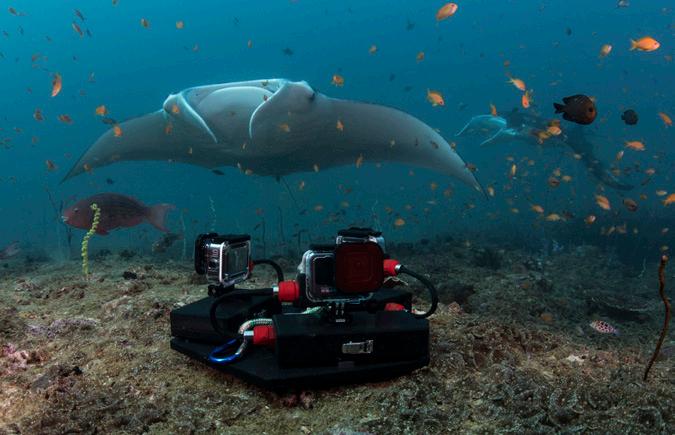
ABOUT THE MMF
The Marine Megafauna Foundation (MMF) is a non-profit conservation organisation based in Palm Beach, Florida. Founded in 2009, MMF is dedicated to the research and protection of threatened marine megafauna, focusing on large marine species like sharks, rays, and sea turtles, often referred to as ‘megafauna’. Their mission is to ensure these majestic creatures thrive in harmony with humans. With a global reach, MMF works to understand these species’ intricacies and the threats they face.
Discover more at www.marinemegafauna.org
ABOUT ISRA (IMPORTANT SHARK AND RAY AREAS)
ISRA, an initiative by the International Union for Conservation of Nature (IUCN), plays a critical role in the conservation of shark and ray species worldwide. These designated areas are identified based on their ecological significance as key habitats for sharks and rays, often marking breeding grounds, feeding areas, or migration routes. The ISRA programme aims to highlight these essential zones to guide global and local conservation efforts, including the implementation of Marine Protected Areas (MPAs). By focusing on these vital regions, ISRA seeks to ensure the long-term survival and health of these crucial marine species, contributing significantly to the broader goal of maintaining marine biodiversity and ecosystem balance.
SOURCE: https://bit.ly/3SEdaV3
22 DIVERS FOR THE ENVIRONMENT | MARCH 2024 NEWS
IUCN’s Marine e-Atlas shows the newly designated Important Shark and Ray Areas (ISRA) in red.
Photo by Andrea Marsall.
THE TRANSFORMATIVE POWER OF BREATHING UNDERSTANDING ITS IMPACT ON MIND, STRESS, AND DECISION-MAKING
BY BASSEL OUNAH (APNEA ZONE DIVING & SNORKELLING CLUB) PHOTO BY COSTAS CONSTANTINOU
Often overlooked, breathing holds the key to physical well-being, mental, and emotional health. The way we breathe has far-reaching implications for our daily lives. The following information delves deeper into the science of breathing and its profound influence on our minds, stress levels, and decision-making abilities.
Breathing does more than sustain life; it's a conduit between the physical body and the mental state. The autonomic nervous system is split into the sympathetic and parasympathetic systems, directly influenced by our breathing patterns. Deep, mindful
breathing activates the parasympathetic system, signalling the body to relax, reducing stress and anxiety. On the other hand, shallow breathing stimulates the sympathetic system, triggering a stress response.
Engaging in deep breathing exercises can have a significant impact on cognitive functions. Techniques such as diaphragmatic or rhythmic breathing enhance the oxygen supply to the brain, which is essential for maintaining neural health. This increased oxygenation leads to improved concentration, sharper memory, and greater mental clarity, aiding in making more

informed and balanced decisions.
Mindful breathing practices, integral to disciplines like yoga and meditation, encourage present-moment awareness. This mindfulness helps detach from overwhelming thoughts and emotions, allowing for a more balanced and objective viewpoint. Regular practice can significantly aid in managing mental health conditions such as anxiety, depression, and chronic stress.
Specific breathing techniques, such as alternate nostrils or 4-7-8 breathing, effectively manages stress. These practices help regulate the heart rate and blood pressure, leading to a more relaxed state. By mastering these techniques, individuals can evoke a sense of calm during stressful situations, leading to more composed and thoughtful responses.
In the realm of decision-making, a calm and clear mind is crucial. Breathing techniques can differ between a reactive, impulsive decision and a well-thought-out response. Proper breathing can lead to more effective and rational decision-making by reducing stress and enhancing mental clarity.
Learning and practicing breathing techniques isn't just about better breathing; it's about creating a better life
KITE BEACH CLEAN-UP CAMPAIGN
The Dubai Developments and Roda Beach Resort held an underwater and beach clean-up on the 10th of December 2023 in partnership with Dubai Municipality and Paradise Blue Diving Centre. The Emirates Diving Association (EDA) provided the activity


with the bags and gloves needed for both the beach and dive clean-ups.
550kg of rubbish was collected in total by 166 volunteers, of which 68 were divers.The Dubai Voluntary Diving Team (DVDT) supported the

event by also providing their dive boat and 3 kayaks to facilitate the clean-up.
The Roda Beach Resort kindly did a raffle for the participants offering free overnight stays at the resort, and free dinner vouchers.


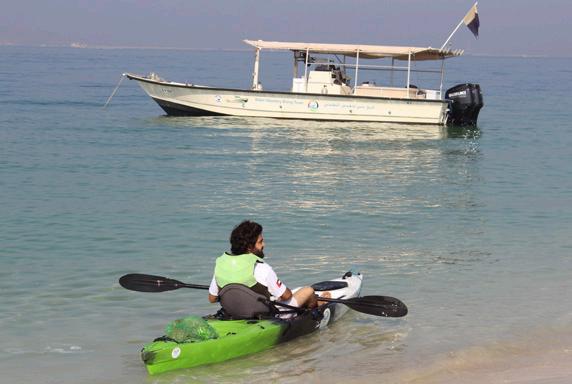
23 MARCH 2024 | DIVERS FOR THE ENVIRONMENT NEWS
DIVING INTO NEW HORIZONS: SANDY BEACH DIVE ACADEMY’S URBAN EXPANSION
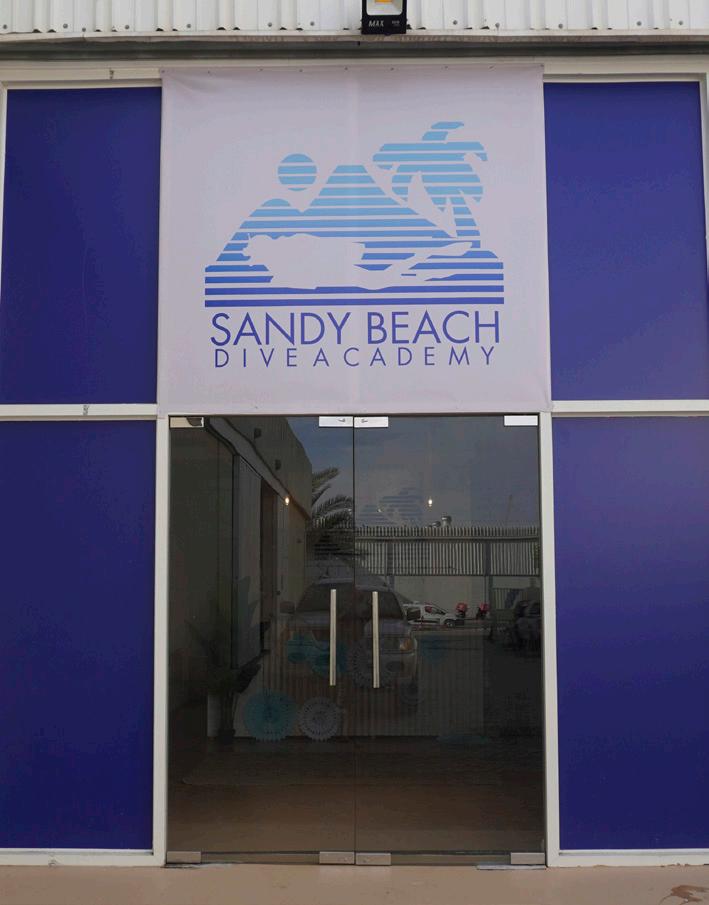
Sandy Beach Dive Academy is breaking new ground by expanding its operations from the tranquil shores to the bustling streets of Dubai city. This strategic move marks a significant milestone for the renowned diving institution as it seeks to bring the wonders of the underwater world closer to urban dwellers and adventure enthusiasts alike. With its roots firmly planted in coastal communities, Sandy Beach Dive Academy has long been synonymous with beachside escapades and marine exploration on the Fujairah coastline. Now, with the launch of its urban branch, the academy is poised to redefine the boundaries of diving culture and accessibility.
Located in Dubai’s industrial zone of Al Quoz 4, the new branch offers a convenient alternative to traditional coastal dive centres, allowing new divers to be trained in their indoor swimming pool made from 3 shipping containers offering 3 different depths – 2.7 metres being the maximum depth. The urban branch provides the same high-quality training and diving experiences that have made Sandy Beach Dive Academy a trusted name in the industry.
The decision to expand into the city was driven from a desire by founder Milan Smole to reach a broader audience and provide greater convenience for diving enthusiasts who may not have easy access to coastal regions, or simply lack time to come to the east coast. By bringing the spirit of the sea to urban locales, Sandy Beach Dive Academy aims to make the transformative experience of diving more accessible than ever before. From recreational diving to professional certifications, technical training, swimming lessons, and even pool rentals, the academy’s new urban branch is poised to be a one-stop destination for water enthusiasts of all levels.

PADI CERTIFICATION COURSES: UNLOCKING UNDERWATER POTENTIAL
Whether you're a novice eager to take your first breaths underwater, or an experienced diver looking to advance your skills, the Dive Academy offers a range of PADI certification courses to suit every level. From Open Water Diver to Advanced Open Water, Rescue Diver, and beyond, our experienced instructors provide personalised training that instills confidence and competence in every diver.
PROFESSIONAL AND TECHNICAL COURSES: ELEVATING EXPERTISE
For those seeking to turn their passion for diving into a profession or explore the cutting edge of technical diving, Sandy Beach Dive Academy offers a variety of professional and technical courses. Whether you aspire to become a Divemaster, Instructor, or pursue advanced technical certifications like TecRec, our expert instructors provide the knowledge and guidance needed to excel in the world of diving.
POOL RENTAL:
MAKING WAVES IN THE CITY
In a city where space is at a premium, finding a suitable venue for training or practice can be a challenge. That's why the Dive Academy offers pool rental services, providing a convenient and controlled environment for divers to hone their skills or host private events. Whether you're conducting training sessions, practicing dive skills, or simply enjoying a leisurely swim, our indoor pool facilities offer flexibility and convenience without compromising on quality.
SWIMMING LESSONS: FROM SURFACE TO SEA
But Sandy Beach Dive Academy isn't just for divers; it's for anyone who loves the water. That's why we also offer swimming lessons for individuals of all ages and skill levels. Whether you're a beginner learning to float or an advanced swimmer looking to refine your technique, our certified instructors provide personalised instruction that promotes water safety and confidence in every stroke.
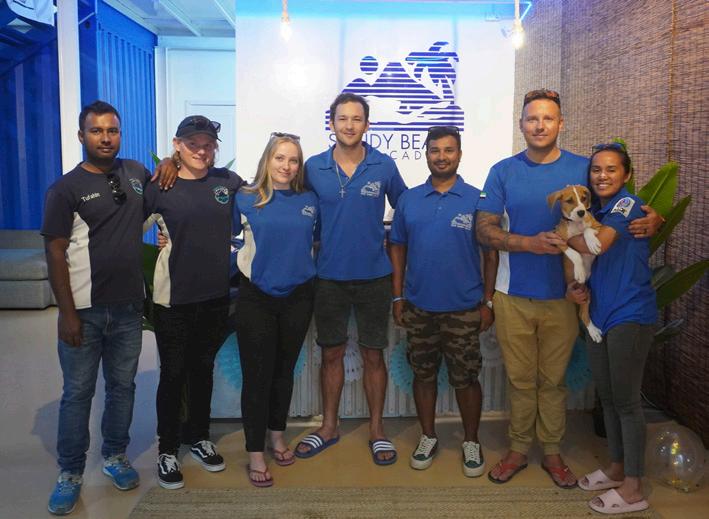
RETAIL STORE: GEAR UP FOR ADVENTURE
No diving experience is complete without the right gear, the Dive Academy has you covered. Our retail store offers a wide selection of top-quality diving equipment, apparel, and accessories from leading brands in the industry. From wetsuits and masks, to fins, regulators, and dive computers, we have everything you need to gear up for your next aquatic adventure.
Moreover, the urban branch serves as a hub for community engagement and environmental stewardship, offering school programmes, conservation initiatives, and educational workshops to raise awareness about marine conservation and promote sustainable diving practices.
In summary, Sandy Beach Dive Academy's urban branch is more than just a dive centre – it's a dynamic aquatic hub that caters to the diverse needs and interests of water enthusiasts in the city. Whether you're looking to learn, train, practice, or gear up for your next underwater excursion, we invite you to dive in and discover the endless possibilities that await beneath the surface.
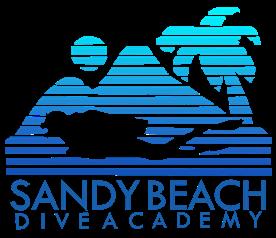
24 DIVERS FOR THE ENVIRONMENT | MARCH 2024 DUBAI BRANCH 29 Street 23B, Al Quoz Industrial Area 4 +971 50 453 1340 +971 4 824 6024 FUJAIRAH BRANCH Sandy Beach Hotel & Resort – Al Aqah +971 50 206 2440 +971 9 244 5050 www.instagram.com/divesandybeach www.facebook.com/divesandybeach NEWS
PADI TEAMS UP WITH WELLNESS BRAND NEURO TO DRIVE OCEAN CHANGE AND CREATE A BLUE STATE OF MIND
The two leading lifestyle and purpose-driven brands have united in a shared mission that is born out of the transformational powers of the water and are offering a streamlined way to enhance your wellbeing and that of the ocean. Throughout the year, they will be releasing a collection of two limited edition re-usable Neuro x PADI tins designed to be used with all the bulk Neuro bag products, with 20% of profits donated to PADI AWARE FoundationTM and $100K USD committed to the world’s largest purpose-driven diving organisation’s non-profit charity by the end of 2024.
The first of the co-branded tins that are now available for purchase showcases artwork created by Neuro co-founder Kent Yoshimura, who is also a renowned mural artist and depicts a whale breaching in the ocean.
“The whale is symbolic of how everything is interconnected and small changes can have a huge impact upon our ocean – and all life that calls it home,” explains Yoshimura. “By refilling and using this tin, you’ll cut down on your packaging waste, fuel yourself with clean ingredients to live your best life and do more for all vulnerable marine species.”
“At least 8 million tons of plastic end up in our oceans every year and more than 250 million tons of plastic are estimated to pollute our waters by 2025,” says Julie Andersen, PADI’s Senior Director of Brand. “Much of that debris is ingested by all of the ocean’s creatures –including the symbolic megafauna like whales. By creating this campaign, PADI and Neuro have come together to drive change and heal ourselves, our communities, and the ocean –our largest and most important ecosystem on this blue planet, and the very thing responsible for life on earth.”
UNITING 2 PURPOSE-DRIVEN BRANDS
Founded in 2015 by Yoshimura and his cofounder Ryan Chen on their first dive trip in Catalina, the two college friends and PADI Scuba Divers were looking for a more sustainable way to optimise one’s health and energy – and soon after established Neuro®, a collection of functional gum and mints crafted with a patented formula and clean ingredients to help you do more.
What started as a small start-up conceived on a dive boat, led them to garner international recognition for their appearance on Shark Tank in 2020 – and they have now sold over 90 million pieces of Neuro products.
“Core to our purpose-driven ethos, we want to encourage the world to not only improve their own lives, but the lives of others,”
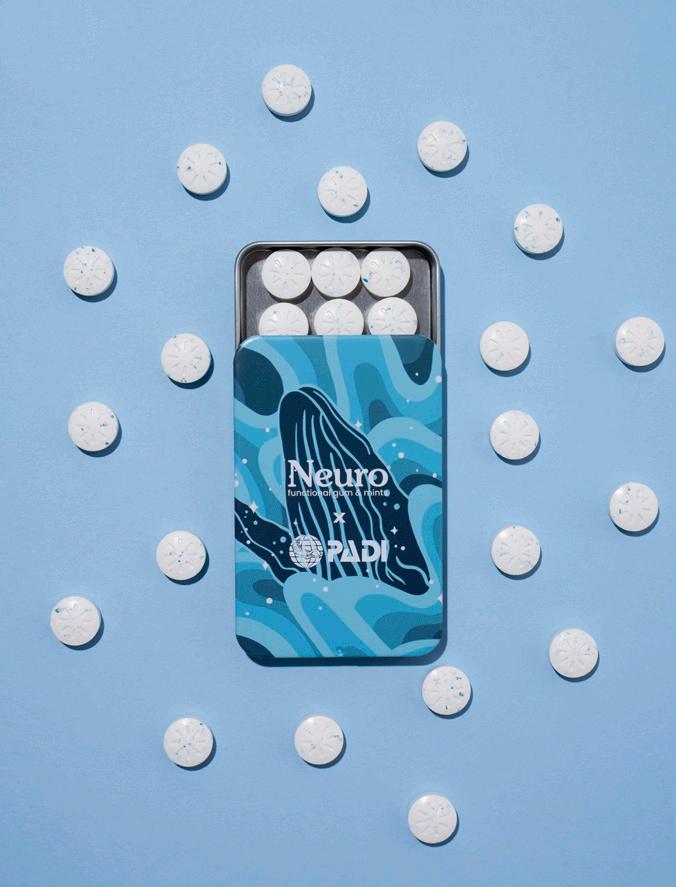
explains Chen. “We understand that being a truly sustainable company is more than just protecting the environment. That is why we prioritise environmental, social, and economic sustainability to ensure Neuro operates in a way that benefits everyone – including the smallest of plankton to the largest of whales that live beneath the surface.”
“Just like Neuro, PADI empowers people to become the best version of themselves when they are in a state of ‘blue mind’, where you become deeply aware of your own personal health’s connection to that of our blue planet’s – realising that your own wellbeing gives you superpowers to make a real difference,” says Andersen. “We are obsessed with creating positive ocean change and transforming lives by making the wonder of the underwater world accessible to all and ensuring that communities and ecosystems live in harmony that mutually support one another. Together, we are magnifying our powers to do more by raising awareness to the issues facing our ocean, while at the same time, providing meaningful ways to take action.”
HOW THE OCEAN HEALED NEURO COFOUNDERS
Scuba diving isn’t just a passionate hobby for Neuro co-founders Yoshimura and Chen. It is from this that they experienced the
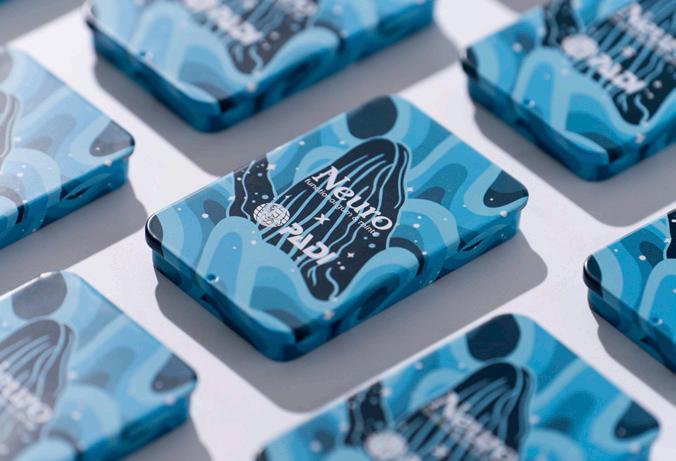
entrepreneurial side-effects of scuba diving, in which the dive trip was a core driver to their business success and personal wellbeing –giving them both their “million-dollar idea” and a renewed sense of purpose and belief that anything is possible.
“It was during this dive trip that we realised the need to have a practical, sustainable, and approachable system that can be shared with fellow divers that provide clean energy during surface intervals,” Yoshimura explains. “When you fall in love with the ocean, you want to spend as much time as possible exploring and protecting it. So, we wanted to create a product that supported this passion and gives you a prolonged state of ‘blue mind’.”
For Chen, earning his PADI Open Water Diver certification also provided him with a pivotal moment in his own healing journey after he had suffered a tragic snowboarding accident that left him partially paralysed. He became certified through the PADI Adaptive Techniques Diving Course and benefited greatly from the physical and mental therapy the sport of scuba diving provides. Soon after, his renewed sense of purpose led him to be named to Forbes 30 Under 30 in 2019.
“There’s no cooler feeling than taking that first breath underwater,” Chen recalls. “All of a sudden you have this superpower, to breathe underwater and explore. Learning to dive reignited my passion for life but also my belief that I too could make a difference in protecting and saving the ocean.”
“Learning to scuba dive unlocks hidden superpowers that are not only empowering –but essential to keep our shared blue planet healthy,” Andersen explains. “As a PADI scuba diver, you not only develop a new passion, but you also earn the unique ability to protect what you love, engaging in impactful citizen science with your own two hands. Through a shared mission of instilling hope, connecting with other species, and fuelling hands-on conservation, we hope that we can make a better world for all of us.”
“That is why we rebuilt our company mission at PADI to reach every 1 in 10 people on our shared blue planet and inspire them to join us as Ocean Torchbearers to create positive ocean change,” says Andersen. “Our work with Neuro helps us inspire more people to experience, fall in love with, and protect the ocean and all life that calls it home. Together, Neuro and PADI are supporting more people in achieving a state of “blue mind”, in which they realise they too are superheroes that can accelerate and optimise healing: our own, our communities, and our planets.”
25 MARCH 2024 | DIVERS FOR THE ENVIRONMENT NEWS
PADI’S 2024 SCUBA TRENDS

FOUR TRENDS THAT WILL HELP SAVE THE OCEAN IN 2024
PADI, the world’s largest purpose-driven diving organisation, is going into the new year with optimism and hope for the future of our shared blue planet.
With new credentials, courses and mindsets around scuba diving, the ocean has never been more accessible for people to explore and protect. Here are the top four scuba diving trends that are empowering more people to become superheroes for the ocean.
TREND 1: ECO DIVING IS ACCELERATING
Conde Nast Traveller recently named ecodiving with PADI the #2 travel trend for 2024. For PADI’s 30 million+ scuba divers, one of the most important things when diving is knowing they are making sustainable and responsible decisions.They are making choices based upon their commitment to our shared blue planet by choosing to dive in marine protected areas (and in Adopt the Blue sites), participate in citizen science initiatives, including education and volunteering on their dive trips, and ensuring their dive trips give back by booking with PADI Eco Centres.
On Earth Day 2023 PADI launched an all-new accreditation known as PADI Eco Centres to further recognise and elevate our planet’s most environmentally committed dive operators.
This accreditation uses the United Nations Environment Programme and the Reef-World Foundation’s Green Fins programme, making PADI Eco Centres the premier choice for all divers, adventurers and travel experts seeking ocean-first, marine-conscious dive experiences that place sustainability at the forefront.
Fast Facts about PADI Eco Centres:
• 100 accredited PADI Eco Centres in 32 countries to date
• 300+ additional PADI Dive Centres in 64 countries actively working towards their PADI Eco Centre accreditation
• International travel chains are committing to becoming PADI Eco Centres, including:
- First international resort chain: Sandals
- First international liveaboard fleet: Explore Ventures
- First national dive centre chain: Dive Friends Bonaire
- 3 biggest diving tourism operations in Australia: Divers Dan, Tusa Reef Tours and Freedom
• Spain (10) and South East Asia (24) are the two most rapidly growing regions to acquire accredited PADI Eco Centres
• 12 months + to become accredited due to the rigorous checks and balances in place by the programme
• 10% of PADI’s Global Membership is the goal for PADI Eco Centres by 2030
• Generation Z is willing to spend 10% more on diving with verified sustainable operators
• Collectively, PADI Eco Centres have helped:
- Remove 2.3 million pieces of plastic from the ocean with PADI’s Dive Against Debris programme
- Detangled 34,773 marine animals
- Adopted 5.8K dive sites to monitor and support becoming Marine Protected Areas
TREND 2: SHARKS ARE FRIENDS AND SCUBA DIVERS ARE SAVING THEM
For the last two years, PADI scuba divers have helped secure protection for vulnerable shark ray species. In 2021 they helped secure protection for Mako Sharks at the International Commission for the Conservation of Atlantic Tuna (ICCAT). In 2022 they helped secure protection for requiem sharks (54 species of sharks and rays) at CITES.
Now, in 2024 PADI is launching their new Global Shark + Ray Census and Shark and Ray Speciality Course.The census will be the largest of its kind that also includes several megafauna and will be critical to garnering governmental protection of species. The course will teach scuba divers how to identify, monitor and log shark and ray activity so that the data can be used to influence governmental policies that give these vulnerable species the essential protection they need.
26 DIVERS FOR THE ENVIRONMENT | MARCH 2024 NEWS
Photo by Jay Clue and PADI
To further empower the 6,600+ PADI Dive Centres and Resorts in 183 countries, PADI has created their own responsible shark + ray tourism guide to ensure best practices are followed by operators and that scuba divers can positively contribute to the shark tourism economy.
TREND 3: SCUBA DIVERS ARE BECOMING VOLUNTEER CORAL GARDENERS
There has been an increase in both recreational and professional PADI Divers planting coral around the world. To further support this, PADI is re-launching their Coral Restoration Speciality Course to enable more scuba divers to participate in the re-establishment of one of our planets most critical ecosystems. Top coral success stories from PADI scuba divers and members include:
• Coral Restoration Foundation is the largest coral reef restoration organisation in the world. Since 2012, they have outplanted more than 74,000 corals on the Florida Reef Tract. Volunteer divers can help with a myriad of tasks all year round and they host their annual Coralpalooza event on World Oceans Day (June 8th).
• Diver’s Paradise in Key Biscayne are studying the microbiomes of coral and how different environments help them thrive. They’ve found that coral within the Miami yachting harbours has not been impacted by coral bleaching and are working on launching a framework that allows dive centres and divers around the world to take part in regenerating reefs in their own local coastlines.
• In the Caribbean, Reef Renewal Foundation Bonaire invites volunteer scuba divers to help restore Bonaire’s coral reefs –including during their annual ReeFiesta event on World Reef Day (June 1st).
• In Australia, Reef Restoration Foundation is the Great Barrier Reef’s first coral restoration initiative – seeking volunteer divers to help reach their goal of planting 25,000 new corals on the reef by 2021.
• In French Polynesia and Fiji, Coral Gardeners invite interested divers to be directly involved in their efforts to plant healthy corals on the reefs of Moorea and the Mamanuca Islands.
• In Kenya, REEFolution seeks hearty volunteers to help collect healthy corals, place them in nurseries, and outplant them on their local Indian Ocean reefs.
TREND 4: THE OCEAN IS HEALING SCUBA DIVERS
One of the biggest wellness trends is scuba diving, with the range of mental and physical benefits being recognised by several studies recently made.
In general, scuba divers benefit from a boost of vitamin D, become more conscious of their breath, enhance their fitness levels, improve their quality of sleep, and become connected with a like-minded community. As a PADI Diver, you not only have a passport to the last frontier, but equally will have the skills to create real ocean change and make a difference for our blue planet – an enormous mental health benefit that solidifies a deep feeling of purpose.
That is also why PADI is committed to making the underwater world accessible to all through their Adaptive Diving Programmes. In 2018, PADI launched an Adaptive Techniques Course that teaches how to modify equipment configurations and develop a diver’s skills based on their needs – ensuring that regardless of physical or mental disability, everyone can find healing from water. There are also PADI Adaptive Diving Facilities that can be found all over the world – which include trained staff in adaptive diving techniques along with accessible classrooms, pools and boat decks.
The ocean is helping scuba divers heal from:
• BLINDNESS: Back in October 2023, PADI
teamed up with Reef Divers in Mozambique to certify Jessica Pita, who has been blind since the age of 11. Hearing the crackling of coral instilled a sense of confidence in her that has made her believe more in herself and instilled a new sense of wanderlust for underwater exploration.
• TRAUMA: Triple amputee US Military veteran Bryan Anderson and his commander Robert Currer found mental healing from the Iraq war, where the two reunited when Currer certified Anderson as a PADI Open Water Diver in Catalina Island.
• INJURY: Ryan Chen was in a tragic accident as a teenager that left him paralysed. He found healing and clarity through becoming a PADI Open Water Diver with his dive buddy Kent Yoshimura – so much so that during one scuba diving trip he and Kent ended up creating their current company Neuro Gum – a collection of functional gum and mints that help you get energised, calm or focused. This has led him to being named to Forbes 30 under 30 and teaming up with PADI to donate $100K to PADI’s global non-profit AWARE to support creating positive ocean change.

27 MARCH 2024 | DIVERS FOR THE ENVIRONMENT NEWS
Photo by Jay Clue and PADI

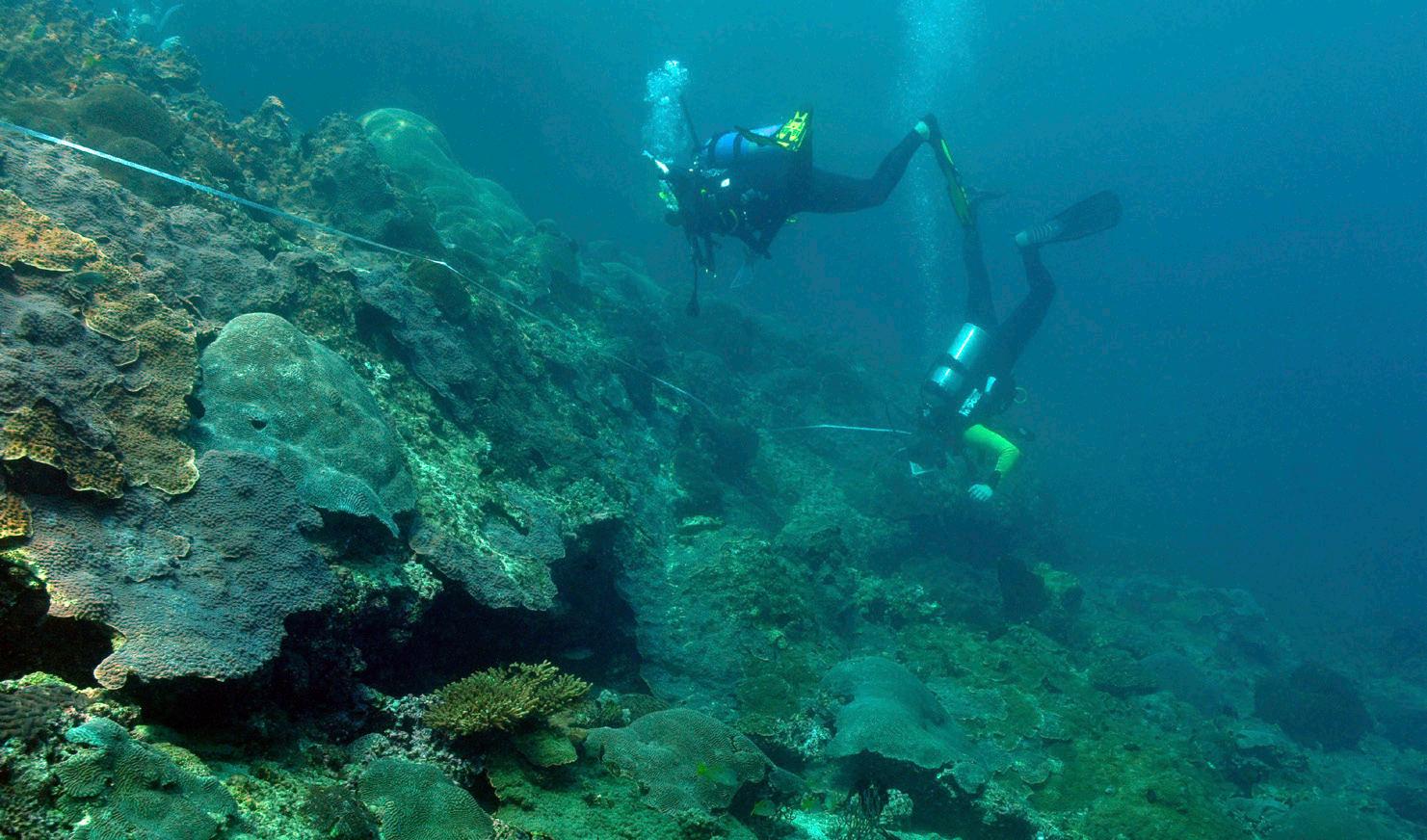
When you join a Reef Check EcoDiver Training Course, you will learn about our local ecosystems and you will be able to participate in our regular survey dives which will help us to understand the threats our corals are facing by providing important data.
EMAIL: reefcheck@emiratesdiving.com
WEBSITE: www.emiratesdiving.com/events/reef-check
28 DIVERS FOR THE ENVIRONMENT | MARCH 2024
EDA IS A NON-PROFIT NGO ACCREDITED BY UNEP AS AN INTERNATIONAL ENVIRONMENTAL ORGANISATION
2023 YEAR IN REVIEW

As we approach the end of another year, I find myself reflecting on the incredible achievements we have accomplished together in 2023. On behalf of the entire Reef Check team, I want to express my deepest gratitude to our global community of volunteers, donors, and partners. Without your unwavering support, none of this would have been possible.
Throughout the year, Reef Check has dedicated countless hours to the vital task of monitoring coral reefs and kelp forests, restoring habitats impacted by climate change, and advocating for environmental justice and equity. Our tireless efforts have yielded remarkable results, and I couldn’t be prouder of what we have achieved together.
I invite you to take a moment to explore some of our collective accomplishments in 2023, which are detailed at this link: www.reefcheck. org/2023-year-in-review
It is my hope that you will find inspiration and joy in reading about the positive impact we have made on our precious marine ecosystems.
As we look forward to the new year, I ask you to consider a donation to Reef Check if you are in a position to do so. Your generous contributions play a crucial role in enabling us to meet the growing demand for our work. Every donation is deeply appreciated and helps us continue our mission of protecting and preserving our oceans.
Here’s to a new year filled with even greater achievements and continued collaboration in the name of marine conservation.
With heartfelt gratitude,
Jan Freiwald
Executive Director
Reef Check Foundation
2023 SUCCESSES
KELP FOREST PROGRAMME
• Dirk Burcham Golden Slate Awards
• Reef Check Receives San Diego Foundation Grant for Baja Kelp Forests
• Spotted! Sunflower star in Northern California
CORAL REEF PROGRAMME
• Allen Coral Atlas Updated Coral Bleaching Tool
• Reef Check St. Kitts & Nevis Partner Secures
Funding for Programmes
• Reef Check Malaysia Celebrates 16 Years
• UAE Hosts Vital Reef Check Course
• Signs of Hope in the Maldives
RESTORATION PROGRAMME
• Reef Check Takes Restoration Pledge in Support of the Kelp Forest Challenge
• Experiment.com: Kelp Forest Restoration and Monitoring using Community Science
• Reef Check Big Sur Restoration Efforts
• Tales From Tanker’s Reef
EDUCATION PROGRAMME
• First North Coast “Dive into Science” Course Completed
• Dive into Science Wraps up Trainings on Catalina
29 MARCH 2024 | DIVERS FOR THE ENVIRONMENT REEF CHECK
TOP ROW: Newly certified kelp forest surveyor in San Diego (Photo:Vincent Pederson); EcoDivers from the Emirates Diving Association, Reef Check United Arab Emirates (Photo: Ally Landes); Sea otter in the Tanker’s Reef Restoration site (Photo: Annie Bauer-Civiello). MIDDLE ROW: Annie Bauer-Civiello, underwater at Big Sur Reef Restoration site (Photo: Calvin Abbott); Reef Check EcoDiver in Tobago (Photo: ERIC – Environmental Research Institute Charlotteville/ Don Markham). BOTTOM ROW: Dive into Science participants Dante Peterson and Carol Martinez are all smiles after a great dive (Photo: Morgan Murphy-Cannella); Reef Checkers in Washington pose for a team photo after completing their field weekend; Antelope Valley Dive into Science cohort ready to dive (Photo: Marco Mazza).
REEF CHECK MALAYSIA CLOSES 2023 WITH VALUABLE LOCAL COMMUNITY ENGAGEMENT
BY REEF CHECK MALAYSIA


Reef Check Malaysia (RCM) has been up to a lot in the last months of 2023!
In mid-October, our RCM colleagues, together with Sabah Forestry Department, WWFMalaysia, Forever Sabah, and PACOS Trust, organised the “Sabah State Conference on Community Based Marine Resource Management” in Sanadakan. This conference saw participation from Sabah Biodiversity Centre, Sabah Parks, the Ministry of Natural Resources, Environment and Climate Change, and the Department of Fisheries Malaysia, fortified by indigenous communities’ distinctive knowledge and profound connection to coastal ecosystems.
A mapping exercise during the conference revealed that 17 coastal community groups in Sabah are protecting more than 12,000 hectares of marine and coastal areas, spanning from Mantanani Island, Kudat, Pitas, Sandakan,

Kinabatangan to Semporna. While the figure is impressive, multiple stakeholders are strategising to appropriately recognise these areas as Other Effective Area-Based Conservation Measures (OECMs) to support marine conservation in Sabah, harnessing the power of local solutions in the face of global climate change.
RCM staff in Sabah also participated in a series of four online training sessions on Reef Star Welding.These Reef Star frames that are to be used for restoration projects must be made by trained welders. In the first session, the local welders were taught about the suitable materials used for the frames, the angle of the steel and all other requirements for the frames. The following sessions included introduction to the items and equipment, site selection, and the MARRS coral restoration techniques. This project is a collaborative effort with Sabah Parks and funded by the Ministry of Tourism, Culture and Environment Sabah. Towards the

end of October, 250 Reef Stars with more than 4300 coral fragments were deployed with the help of the Selakan Youth Group and the local community.
Our colleagues have also been actively running school education programmes on the islands we work on. In Tioman, the programme with SK Tekek, the local primary school in Tekek Village continued with a session on turtles. Our colleague from Sabah also participated as he was on a study trip to learn more about all our programmes on Tioman. Meanwhile in Mersing, RCM staff conducted a tidal walk with students of a local secondary school. During the educational tour, students were introduced to the fascinating marine organisms that inhabit the intertidal rocky shore environment. They were also reminded of activities completed in previous months, with an emphasis on the message of caring for coastal beaches to provide a better home for marine organisms.
30 DIVERS FOR THE ENVIRONMENT | MARCH 2024 REEF CHECK
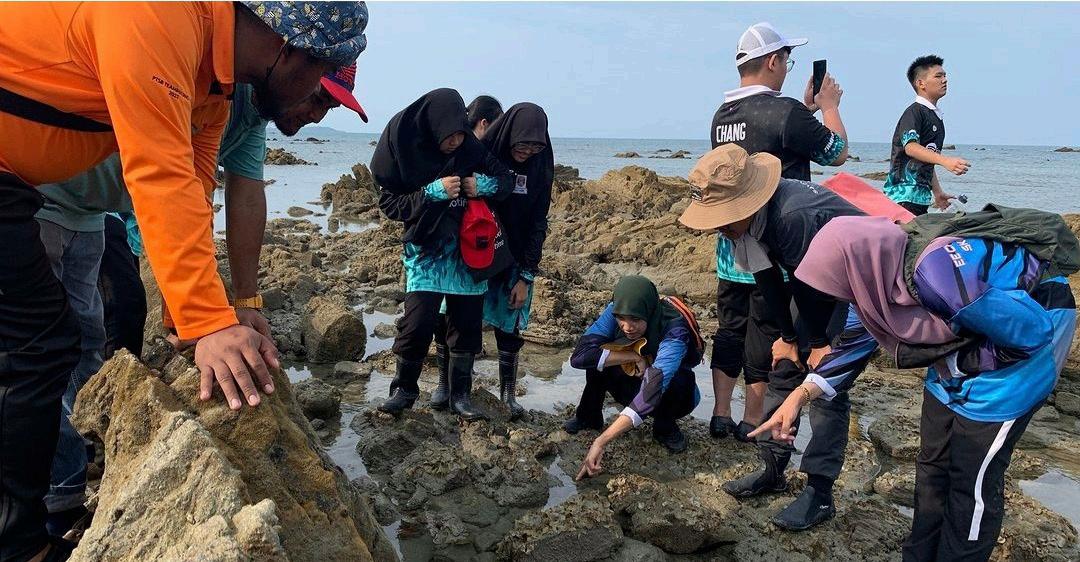
In November, RCM staff in Mersing also conducted a two-day marine awareness and conservation programme with Mersing’s local youths, between the ages of 15-18 years old. It consisted of indoor engagement activities and educational tours to marine ecosystem sites and conservation centres. This programme was organised in collaboration with the YSEALI Council of Malaysia (YCOM) and Mersing District Council, with support from Pejabat Daerah Mersing, Tengah Island Conservation, the US Embassy in Kuala Lumpur and YSEALI.
Our colleagues have also been conducting skills training sessions for representatives from the local community, to get them


more involved in the work we do. One local community member and one tourism operator were recently certified as EcoDivers and they will soon be helping us with the Reef Check surveys around Mersing. Around the same time, we also organised a SCUBA diving certification course for four local youths from the Mersing Islands, an initiative supported by the Star Foundation in Malaysia. This programme is an ongoing initiative aimed at enhancing the capacity of local youths and the community to actively engage in ongoing marine conservation initiatives with us on the Mersing Islands.
In early December, RCM, in collaboration with Sabah Parks, organised the Sabah Reef
Resilience Workshop in Semporna, attended by 22 participants from different agencies and organisations. This workshop is part of the Community-Based Coral Conservation & Restoration Project funded by the Ministry of Tourism, Culture, and Environment of Sabah (KePKAS). The three-day workshop consisted of theory and knowledge-sharing on the importance of reef resilience. Participants had the opportunity to get hands-on experience while putting their theoretical skills into practice. During a visit to Selakan Island, participants learned and familiarised themselves with the methods, underwater indicators and reef resilience assessments at two sites, namely Tanjung Kenanga, and Southrim within Tun Sakaran Marine Parks.
TRANSNATIONAL REEF CHECK TEAM SURVEYS KELP FOREST AT THE CORONADO ISLANDS IN BAJA CALIFORNIA, MEXICO

In October of this year, a transnational team of Reef Check divers embarked on a trip to monitor and safeguard the vital kelp ecosystems around the Coronado Islands just south of the Mexico/US border. The divers hailed from the coastal stretches of Southern California and Ensenada, Mexico and formed a unique partnership under the Reef Check banner. Fuelled by a shared commitment to safeguarding the ocean, these volunteers contributed their time and expertise to monitor and protect the marine ecosystems surrounding these islands.
The Coronado Islands, located roughly 10 miles off-shore of Baja California just south of the US border, became the stage for this

cross-border collaboration. Kelp forests are a cornerstone of marine biodiversity here, providing shelter and sustenance for an array of marine life. Along the California coast, Reef Check has documented declines in kelp from the overgrazing by sea urchins, the increasing prevalence of invasive species and other environmental stressors. These ecosystems do not stop at international borders, and data on the health of the kelp forest on these islands is lacking.
Our transnational team of divers, trained in Reef Check’s rigorous monitoring protocols, assessed the density of kelp, fish, and invertebrates. Their efforts contribute to a comprehensive understanding of the state of
the kelp ecosystems on these remote islands, vital for informed conservation strategies.
This expedition was more than a scientific undertaking; it was a celebration of crosscultural connections. Volunteers from Southern California and Ensenada joined forces, transcending geographical boundaries to unite under the common cause of marine conservation. The bonds forged underwater echoed the universal language of environmental stewardship.
Thank you to the San Diego Foundation, whose generous funding under the Binational Resilience Initiative (BRI), made this expedition possible.
31 MARCH 2024 | DIVERS FOR THE ENVIRONMENT
REEF CHECK
EDA’S REEF CHECK SURVEY ON THE OCCASION OF UAE ENVIRONMENT DAY
PHOTOS BY ALLY LANDES & HENRIK STAHL

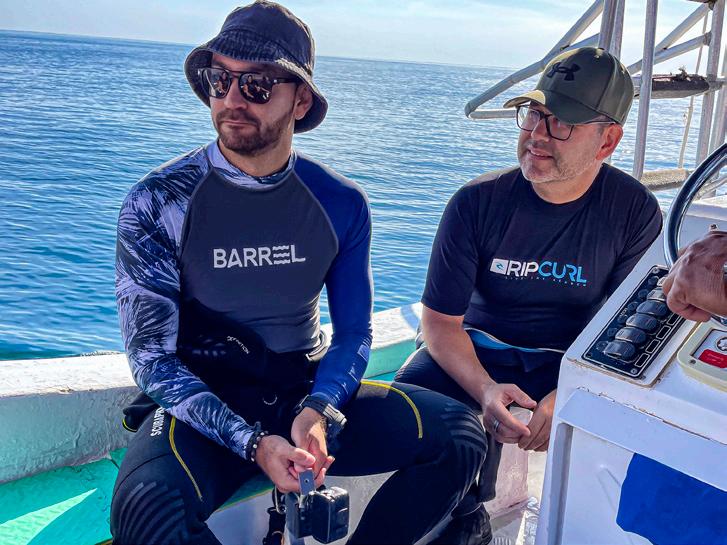
Due to poor weather conditions, and rough seas the week before, EDA had to postpone the first Reef Check survey dive of 2024 set to mark the occasion of the UAE Environment Day to the following week, on the 10th of February. Better late than never.
It turned out to be a very successful Citizen Science filled weekend! We got our Reef Check survey done at Shark Island led by EDA’s Reef Check Trainer, Rania Shawki Mostafa with some fantastic weather and calm sea conditions.
We only found one crown-of-thorns starfish (CoTS) in this location which is good news considering the outbreak at Martini Bay only a short distance away. We had a beautiful green turtle (Chelonia mydas) at the end of the dive who tagged along with Rania and Henrik as
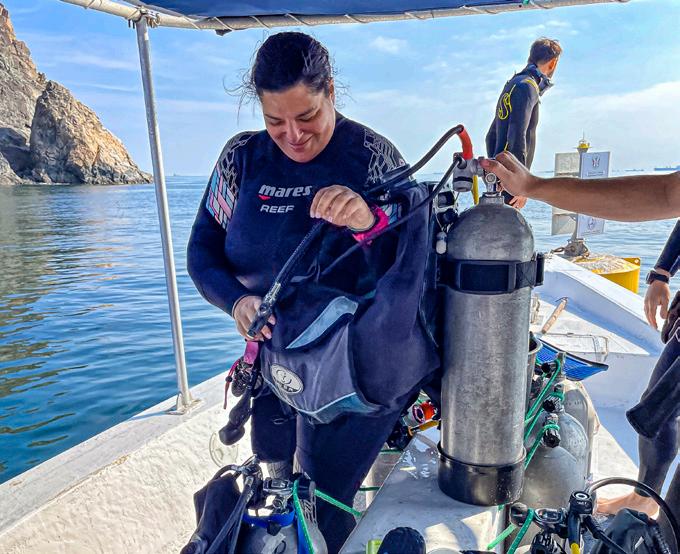
they wound the transects back in. As a safety stop surprise, the rest of the team were witnesses to a mobula ray swooping past. There are still so many wonderful surprises lurking about when we least expect them.
We followed a transect of 50m from south to north, and the second 50m, from east to west with an average depth of 8.1 metres. The water temperature was 24ºC, and the visibility was 13m with a lot of green algae backscatter.
We conducted two surveys: invertebrates and impacts, and substrates. The results show a mean cover of 31% hard corals, and 5% soft corals. There was a 37% sand coverage which we had expected given the site location. We were happy to find a very healthy hard coral cover despite the reports of the CoTS outbreak in the area.

The most common invertebrates were the long-spined sea urchins (Diadema antillarum) which we were very glad to see thriving again after a suspected disease hit them in 2023.
For our second dive, we opted to use our fun dive as a means to finish collecting the data needed (on 40 crown-of-thorns starfish) at Martini Bay for the CoTS survey we had taken part in 2 weeks prior led by Henrik Stahl from the University of Khorfakkan. To learn about the survey and results, turn to page 66.
Well done team for a productive day caring for our ocean. Thank you to Divers Down for the support, the plastics clean-up we ran during our surface interval at Martini Bay –found to be caused by the tourist boats taking visitors to Secret Beach for picnics; and for the surprise hot chocolate!
32 DIVERS FOR THE ENVIRONMENT | MARCH 2024 REEF CHECK



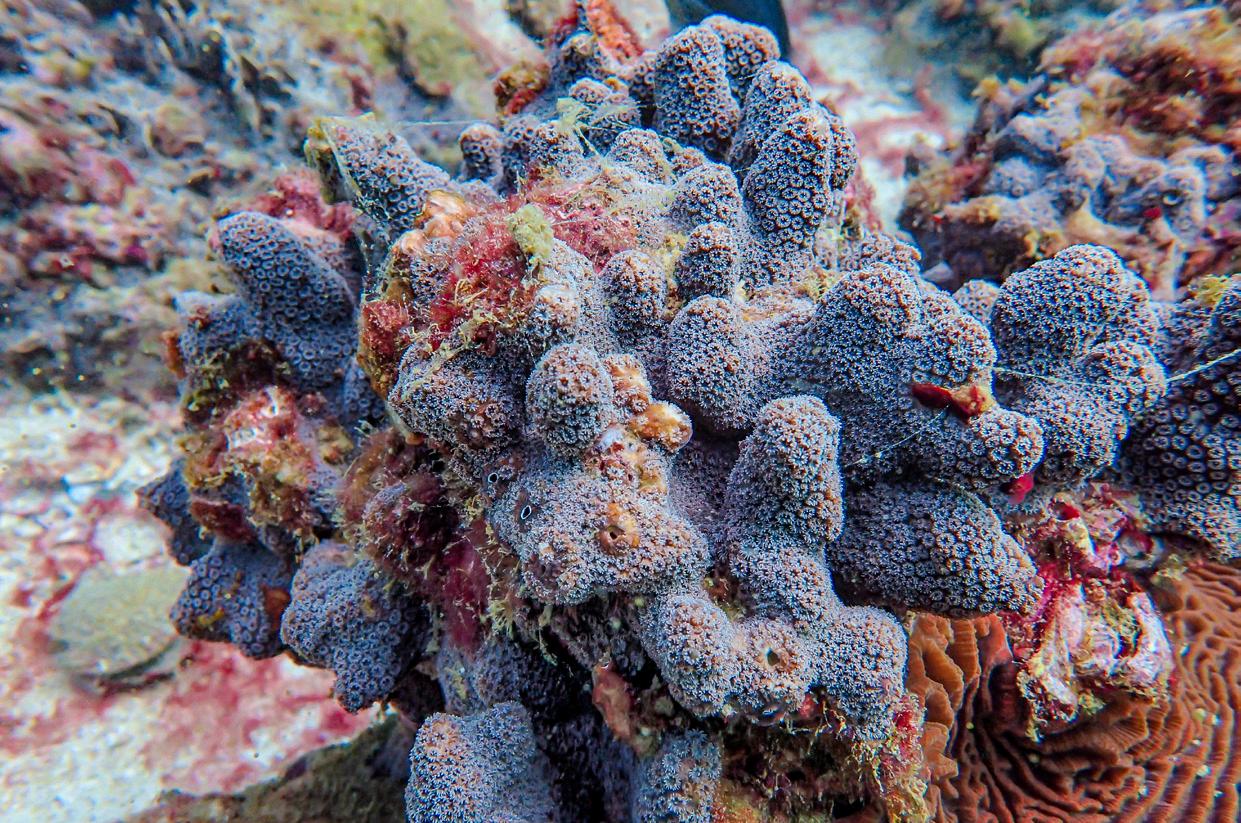



REEF CHECK
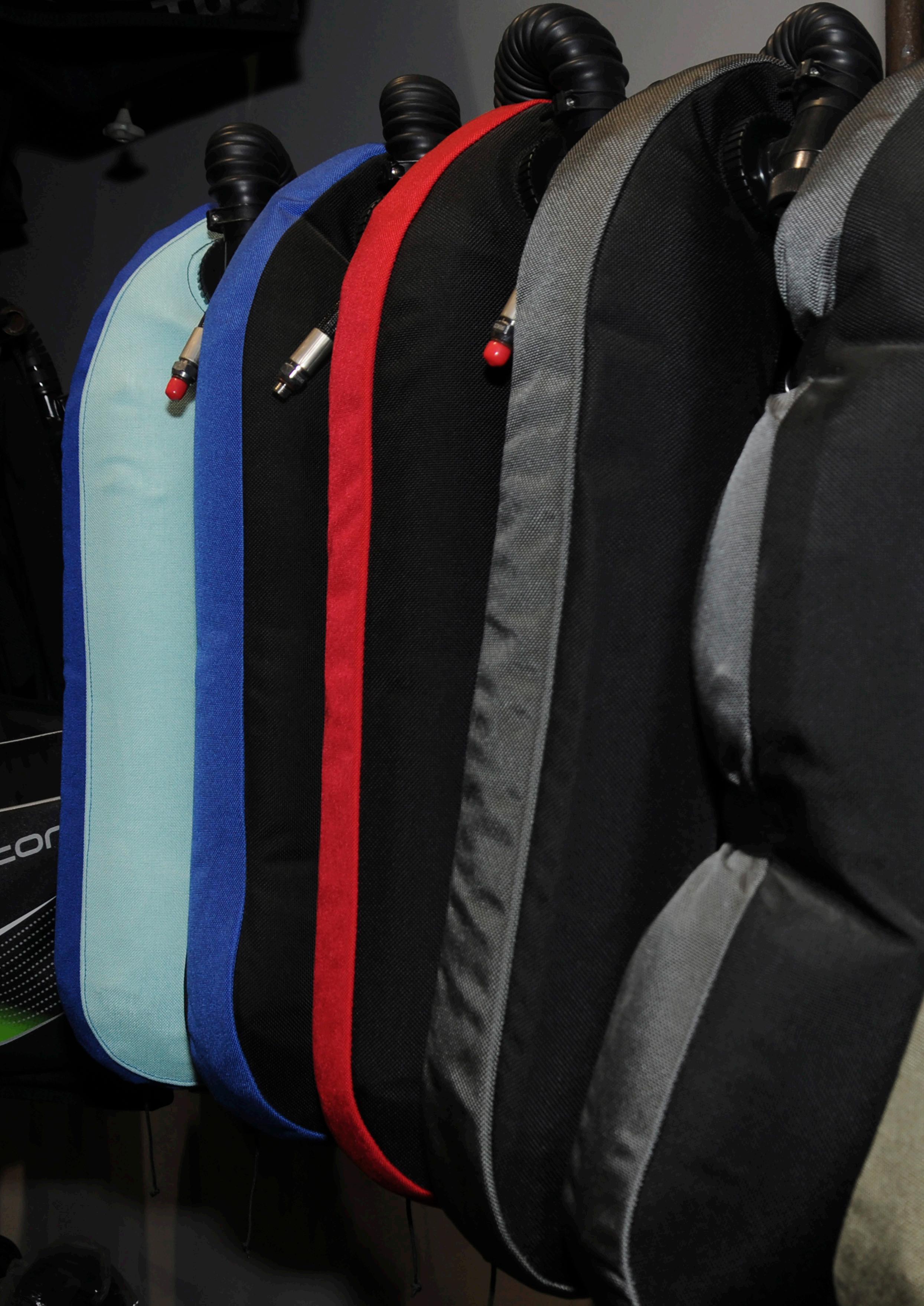
THE BPW BACK PLATE AND WING
FEATURE AND PHOTOGRAPHY GORDON T. SMITH
For those of you who are not yet familiar with BPWs, go and check out what is available in the local dive shops. Talk to divers who use them to get their own unique experiences using them versus BCDs. It will be a very helpful conversation to have.
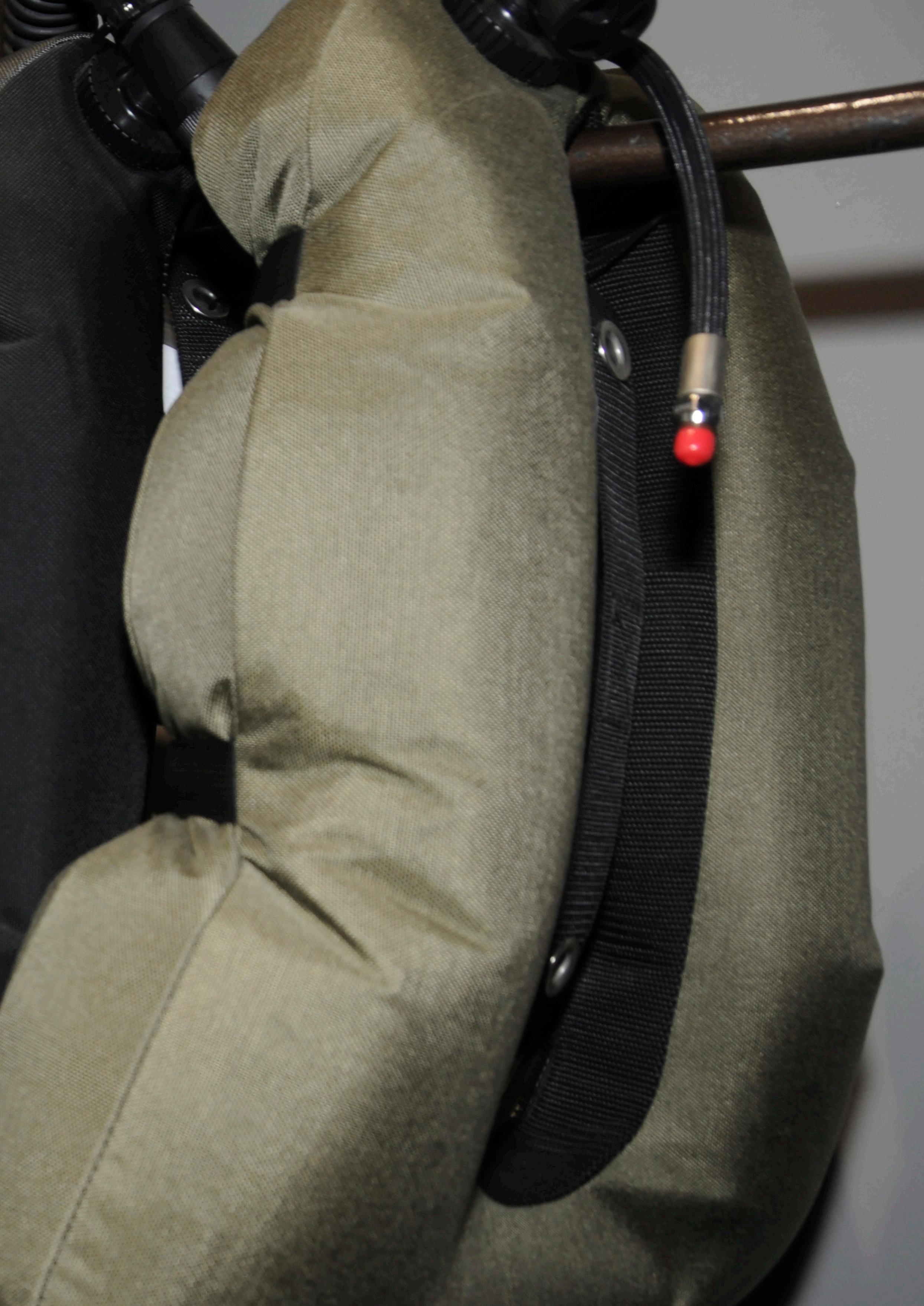
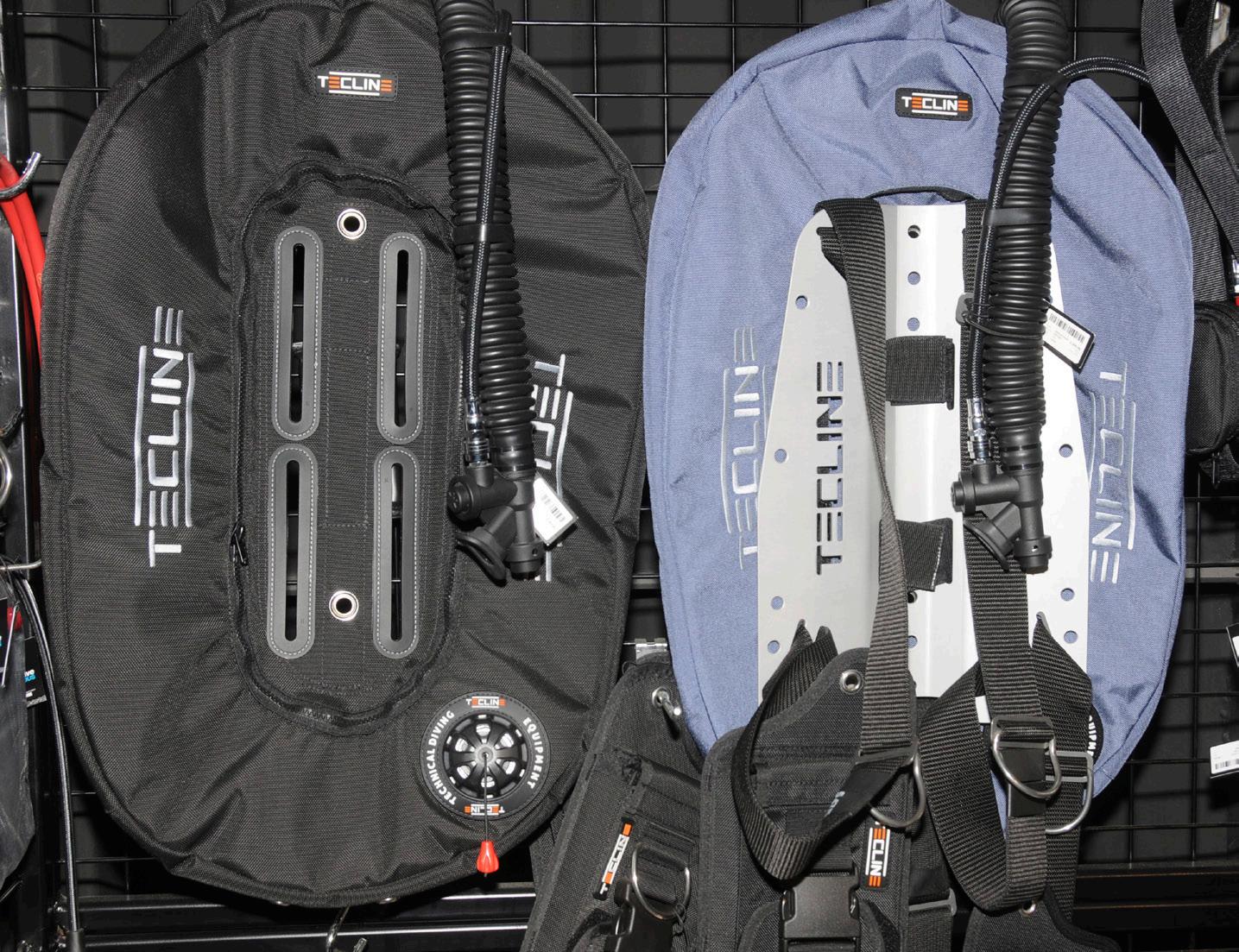
Back in 2019 when en route to Indonesia, I transited Singapore and attended the ADEX (Asian Dive Expo) conference and exhibition and was very surprised to not see any standard jacket buoyancy compensator devices (BCDs) on display. Everything on show was Back Plate and Wing (BPW), and in about every colour you could think of, except black. Halcyon very surprisingly, were only displaying neon lime and pink wings!
During my early days of diving in the 1980s I started off using a plastic back plate to hold my tank in place, no wing though as they didn’t exist. What most people used for buoyancy was referred to as a “horse collar” inflation device, introduced by a company called Fenzy back in the 70s, but this was more for buoyancy at the surface and not used while underwater as the inflated area was on your chest, not on your back.
BCDs or STAB jackets as they were commonly referred to in BSAC circles, were being introduced as the “Buddy Commando” which were fast becoming the one almost everyone aspired to owning at the time. The term STAB was, I believe, short for “stabilisation”.
Fast forward to 2013, I decided to construct a twinset using two AL50 tanks and the only way to mount them for use, was to employ a BPW. Nothing was instantly available here in the UAE at the time, apart from Dive Rite at Divers Down (pre-Dive Garage), and the current owner at that time, Paul Sant, sorted me out with everything very quickly. I used this for a single AL80 tank too, and I was so impressed that after two dives I purchased a Dive Rite TravelPac which has a soft backplate all in one design. I took it with me to the Philippines two days later without even testing it.
I was an instant convert, and for single tank use, I used the TravelPac and sold my older BCD. Within two years, I had changed everything over to a stainless steel (SS) backplate with harness and separate wing as the flexibility of this design was so easy to use and provided me better trim underwater, in particular whilst taking photographs. This also coincided with a move to technical diving, but that’s another story.
SO, WHAT EXACTLY IS THE BPW?
Basically, it consists of three parts:
1. Backplate
2. Harness
3. Wing
THE BACKPLATE
The Backplate itself can come in a variety of different materials. The most common is aluminium, which has to be anodized to avoid corrosion. This is perfect for travel purposes if trying to also save weight.
However, there are some other lightweight materials being used such as carbon fibre and titanium, as well as plastic.
If you want to avoid adding additional weights, then a stainless steel (SS) backplate is advisable. In general, they come in 3mm thick SS and weigh around 6lbs (2.7kg), however some companies (eg Techline) make a 6mm thick plate weighing in at 9.25lb (4.2kg) suitable for drysuit, and 7mm wetsuit diving.
The main advantage of an SS backplate is of course that the weight is spread over a larger area and thus avoiding areas that are likely to put the diver out of trim. Weight belts and pockets tend to concentrate the weight in specific areas, and some divers do suffer from lower back pain when using a lot of weight on

a weight belt as well as putting them out of horizontal trim.
Jacket BCDs these days, usually come with weight pockets, but again these concentrate the weight in one area and are not equally spread over the diver’s back, which can put the diver out of horizontal trim. Some manufacturers have started adding trim pockets but in fixed positions.
THE HARNESS
Generally, the harness for a BPW is one piece, however, some do come in two pieces with separate webbing for the waist.The standard is two inch nylon webbing similar to weight belts. Some webbing is softer than what you might use as a weight belt, and more comfortable.
Some manufacturers do make what they call “deluxe” harnesses with additional padding for the shoulders, as well as additional quick release clips similar to what you find on jacket BCDs. In some tech diver circles, it has been advocated that plastic clips break easily, a problem I have found with my dive computer, but never on my Dive Rite harness with over 1,000 dives.
However, there are other systems for the harness that allow easy tightening and release, avoiding the use of plastic clips, for example, the KAI harness. This can easily be installed onto any back plate, demonstrating the flexibility of BPW systems.
SS D-rings complete the harness, allowing the attachment of various bits of gear when not in use such as lights etc, and make customisation of your complete setup easy.
The backplate should fit snugly against the diver’s back and requires a crotch strap.
36 DIVERS FOR THE ENVIRONMENT | MARCH 2024
PRODUCT REVIEWS
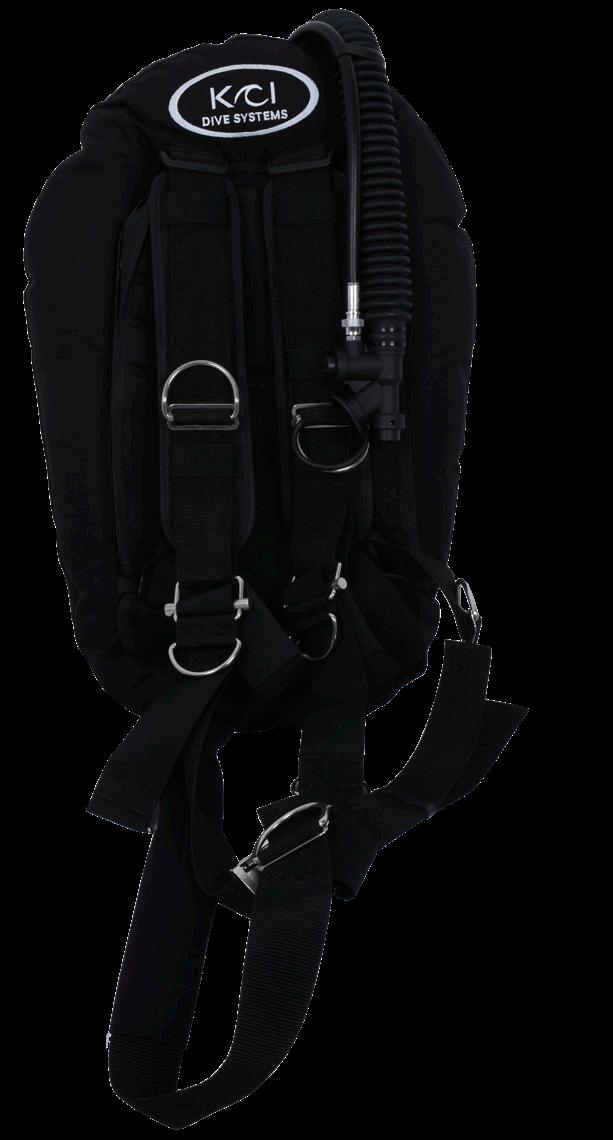


This is something that the majority of jacket BCDs don’t have. If you are a jacket BCD user, you may not be familiar with this system. I frequently see divers in jacket BCDs that don’t fit properly. The installation of a crotch strap would stop the BCD from riding up, and moving around.
THE WING
This is the air cell used for buoyancy control, and unlike the BCD, the air remains at the back of the diver only and cannot move around to the sides.
The wings themselves have internal bladders and are more robust to puncture, which is especially important when wreck diving. This is where some manufacturers promote their heavy-duty wings with thicker material such as Dive Rite’s XT range with 1680 denier ballistic nylon on the diver side, and a thicker “SuperFabric” on the outside with a 210-denier laminated nylon bladder in the inside of the wing.
Wings come in several sizes with different lift capacity normally indicated in lbs, and can be changed easily depending on what equipment you are using. A standard 20lb wing would be suitable for use with an AL80 tank (11.1L) used by most dive centres in the UAE, and in SE Asia.
However, if you start to carry additional equipment or use steel 12L tanks, then something with a bit more lift such as the KAI Dive Systems’ 25lb wing is a good choice. For twin tank diving, the wings used will be of a higher lift capacity and wider to accommodate the use of two tanks side by side. KAI will be introducing a larger wing option with 50lb lift and 45lb lift, the latter being slightly wider at the bottom for twinset diving.

Barely 10 years ago, the choice of a BPW in the UAE was limited to either Dive Rite or, if you were willing to wait, APEKS or ScubaPro. Then along came Halcyon, X-Deep and Mares, the former being at the top end of the dollar scale.
Late in 2023, the KAI Dive Systems launched a BPW (called Vagabond) here in the UAE. The aluminium plate is manufactured here in the UAE and assembled using some imported parts from four factories in two other countries. KAI Dive Systems had their official launch at Dive Campus in January 2024.
KAI offer a bespoke set-up according to the customer’s needs, and they are totally customisable with whatever additional parts you want. Aamer Al Hammadi, who owns the company, will give customers one-on-one advice for those who want to have a BPW system made up.
Currently, all the plates on offer are anodized aluminium and covered with some soft padding if desired. My view on the padding is that it’s not really necessary, especially when wearing a wetsuit. It also takes time to dry, something to consider when travelling. However, since everything is customisable, it’s up to the customer to decide.
Whilst an aluminium plate is good for travel, additional weight is required when wearing a wetsuit with aluminium tanks, and this is done with the use of weight pockets on the waist section, which in my opinion is not perfect. Aamer has informed me that he will be offering SS backplates if the customer requests this option.
After trying the KAI BPW demo model, which I used for a couple of dives over in Fujairah, I

found it comfortable in and out of the water, but I had to add weights to the waistband as I was wearing a 5mm wetsuit. Personally, I hate wearing weight belts and have been using a stainless steel backplate for over eight years. I found the weights in the pockets rather annoying, and prefer the simple addition of a couple of trim weights either on a tank band or on the plate itself, which is one of the great points of BPWs.
One thing I did like, was the KAI harness and how easy it was to adjust, so I bought one and fitted it to my new Dive Rite short SS plate.
KAI Dive Systems also offer wings in various colours, which should please many people. The Current colour line-up is: Black, Red, Blue, Purple, and Pink. More colours will be offered in the future based on demand.
BPW ECONOMY
My first BCD lasted just short of 500 dives, which wasn’t too bad. I bought a second one, same brand, but for some reason it didn’t last as long and was soon replaced by one last BCD. I have had over 1,000 dives with one BPW for single tank use.
New divers can easily start off with a BPW and probably only change a couple of things on it when required, which is not possible with jacket BCDs. In fact, some instructors here do teach Open Water using a BPW. It’s worth discussing with the instructor at the dive shop to get more information.
For those of you who are not yet familiar with BPWs, go and check out what is available in the local dive shops. Talk to divers who use them to get their own unique experiences using them versus BCDs. It will be a very helpful conversation to have.
37 MARCH 2024 | DIVERS FOR THE ENVIRONMENT PRODUCT REVIEWS
AN EVENT BY:
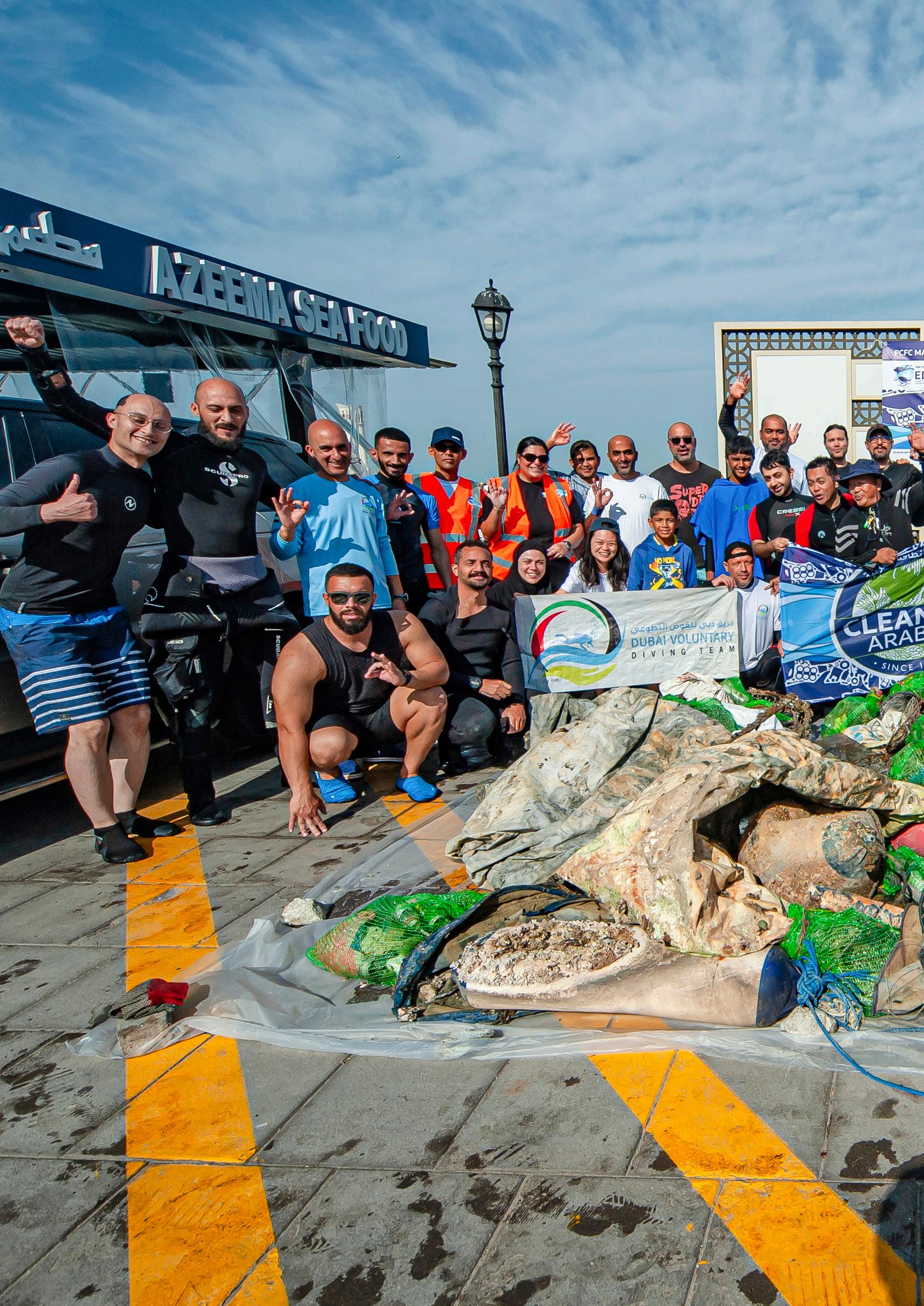
CLEAN-UP PARTNERS:

STRATEGIC PARTNER:

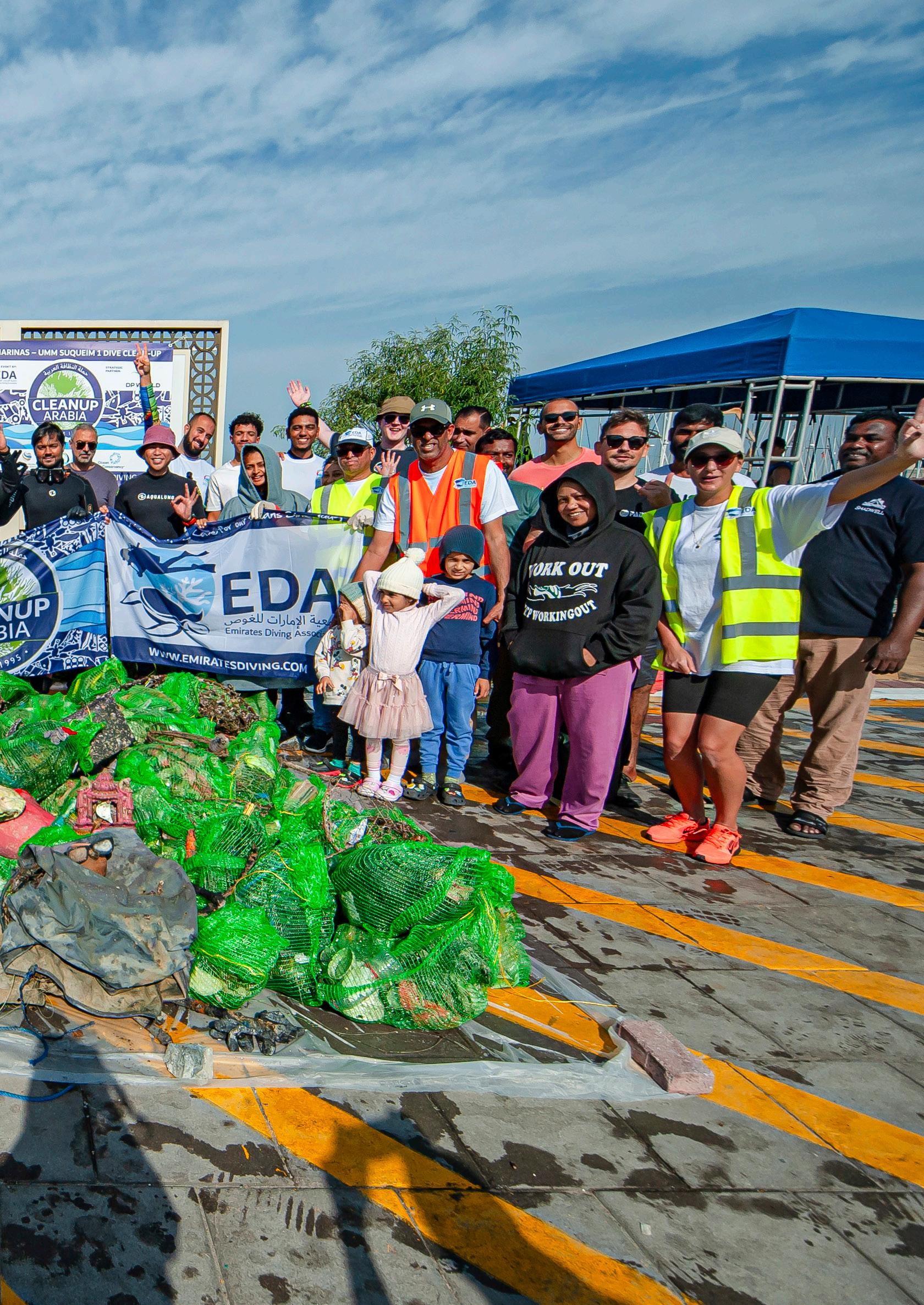
CLEANUP ARABIA
PCFC MARINAS – UMM SUQUIEM 1 DIVE CLEAN-UP
PHOTOGRAPHY ALLY LANDES
The clean-up forms part of a wider partnership between DP World and the Emirates Diving Association, which will see the two entities collaborate on a number of ocean conservation initiatives and educational activities throughout the year.
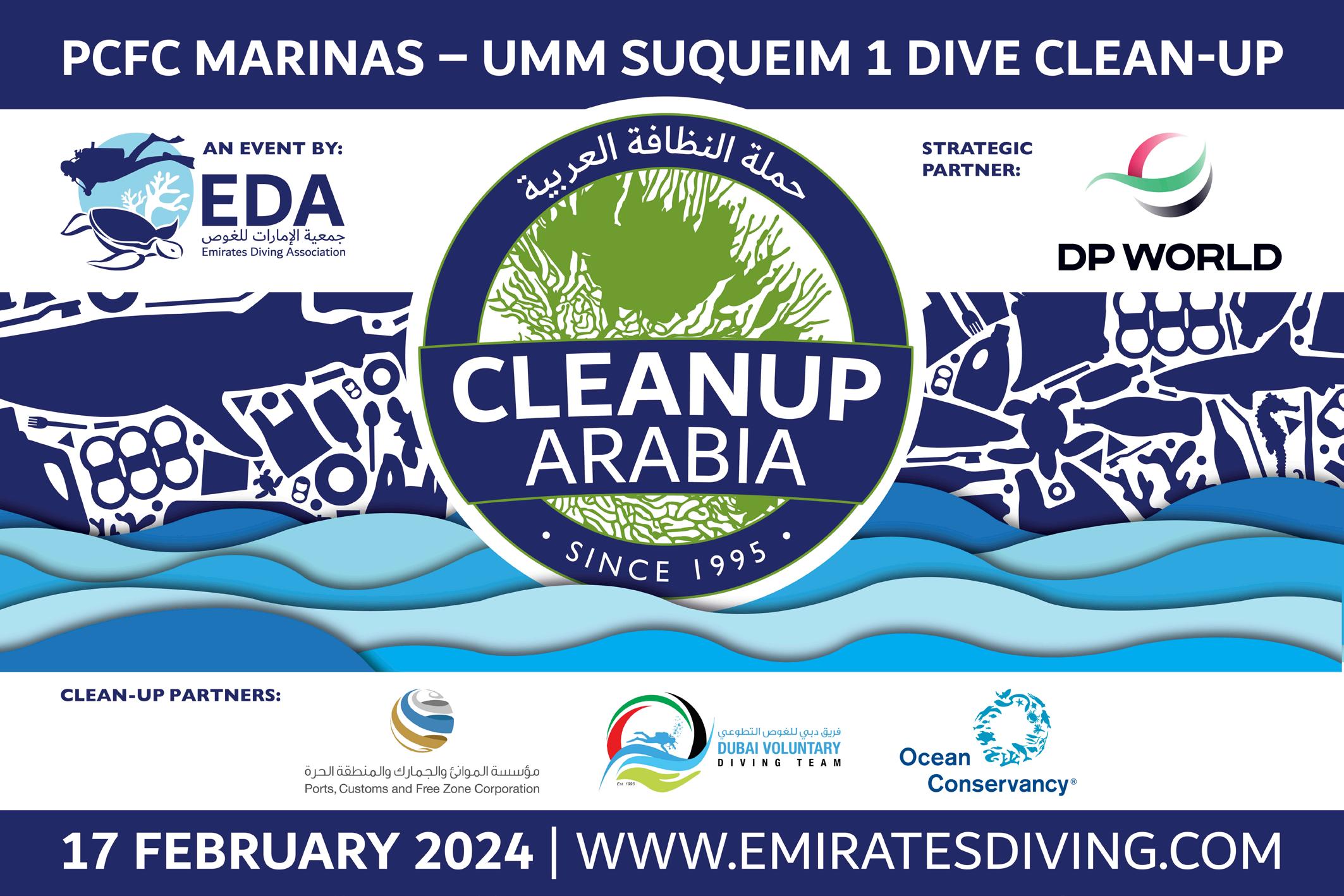
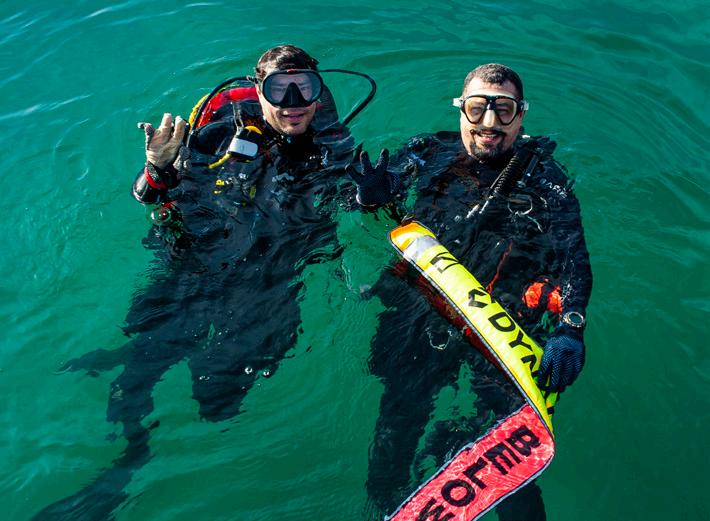
The Emirates Diving Association (EDA) and DP World, in cooperation with the Ports, Customs and Free Zone Corporation (PCFC) joined forces to conduct a highly successful dive cleanup at the PCFC Marinas – Umm Suqueim 1 in Jumeirah 3 on Saturday the 17th of February. The partnership underscores their shared commitment to environmental conservation and sustainable practices in the UAE.
At the event, a team of dedicated divers from EDA and the Dubai Voluntary Diving Team gathered at the harbour for a morning of intensive clean-up efforts beneath the surface of the water with the support of the PCFC, the harbour’s operators. Equipped with scuba gear and motivated by a common goal, the volunteers set out to rid the marina of marine debris and waste.
Commenting on the initiative, Juma Khalifa Bin Thalith, Chairman at the Emirates Diving Association said, “We are delighted to be in a partnership with DP World for these important initiatives. Together, we have made a

tangible contribution to preserving the marine ecosystem of the Dubai’s coastal areas. The collaborative effort between EDA and DP World exemplifies the power of partnership in addressing pressing environmental issues. By combining our expertise and resources, we were able to achieve significant results in cleaning up the underwater environment of the harbour.”
The clean-up forms part of a wider partnership between DP World and the Emirates Diving Association, which will see the two entities collaborate on a number of ocean conservation initiatives and educational activities throughout the year.
Nabil Qayed, Executive Vice President –Corporate Support at DP World GCC expressed his satisfaction with the outcome of the clean-up, stating, "At DP World, we are actively committed to protecting our oceans and marine life. Through partnerships like this one with the Emirates Diving Association, we can make a meaningful impact in safeguarding
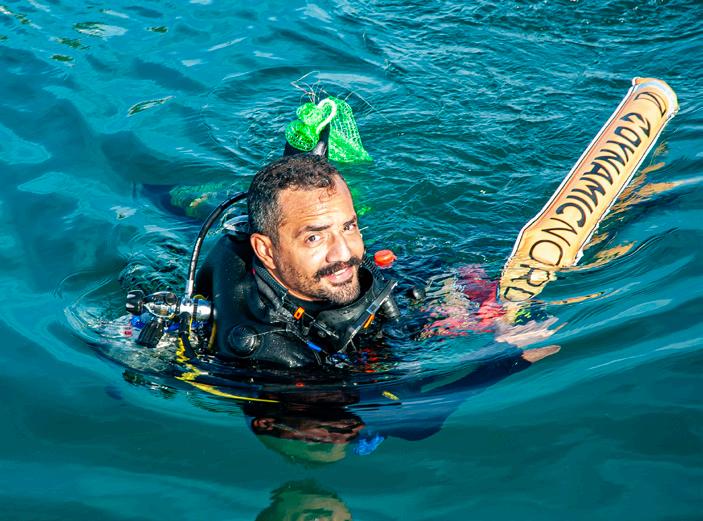
the environment for future generations. Looking ahead, we remain committed to our shared goal of environmental sustainability, with plans for future collaborative initiatives to further enhance marine protection efforts in Dubai and beyond. By working together and engaging the community, we can create a lasting impact on the health and vitality of our oceans."
In total, the EDA and DVDT dive teams removed an impressive 604kg of waste from the harbour. Amongst all the waste collected, the most common items collected included plastic and glass bottles, beverage cans, and fishing ropes and lines.
Once the waste was collected, it was counted, with the data submitted to the Ocean Conservancy and to the Ports, Customs and Free Zone Corporation to contribute towards the monitoring of marine waste at a national and global level.
A big thank you to Dubai Municipality for collecting the waste at the end of the event.
40 DIVERS FOR THE ENVIRONMENT | MARCH 2024 FEATURES

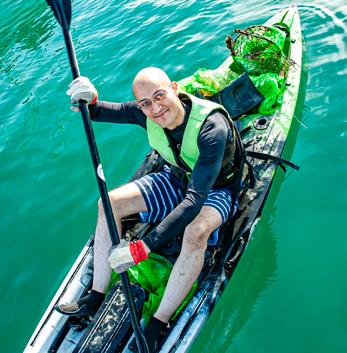



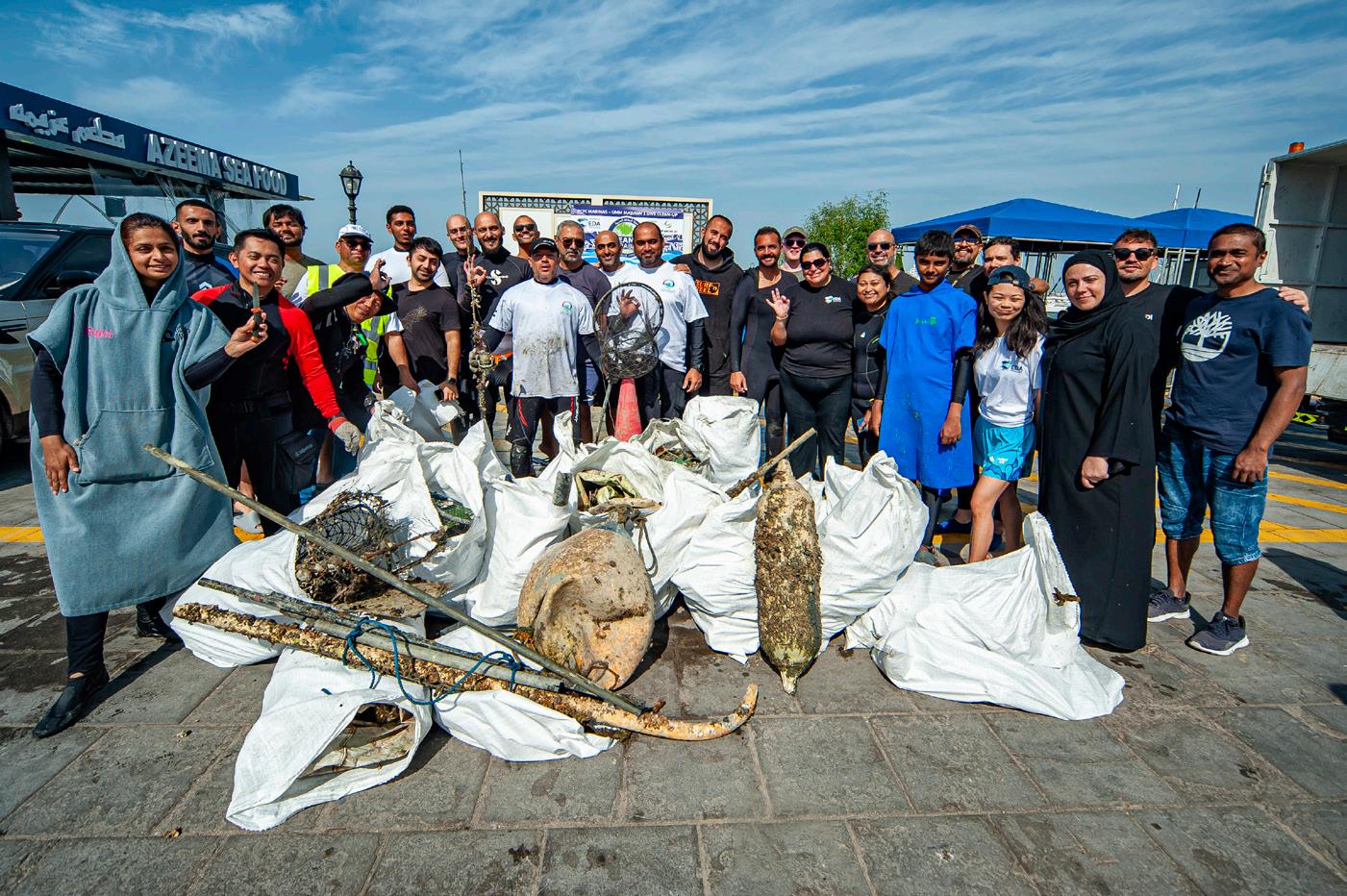

41 MARCH 2024 | DIVERS FOR THE ENVIRONMENT
DIVE CLEAN-UP | DUBAI PCFC Umm Suquiem 1 Marina | 29 Divers MOST LIKELY TO FIND ITEMS TOTAL Grocery Bags (plastic) 37 Other Bags (plastic) 81 Beverage Bottles (glass) 101 Beverage Bottles (plastic) 220 Beverage Cans 113 Beverage Sachets/Pouches 3 Bottle Caps (metal) 2 Bottle Caps (plastic) 43 Cups, Plates (paper) 2 Cups, Plates (plastic) 24 Food Containers (plastic) 57 Food Wrappers (candy, chips, etc) 35 Lids (plastic) 29 Straws/Stirrers (plastic) 3 Utensils (plastic) 25 FISHING & BOATING Line, Nets, Traps, Rope, etc 91 Foam Dock Pieces 2 PACKAGING MATERIAL Other Plastic Bottles (oil, bleach, etc) 22 ILLEGAL DUMPING Appliances 1 Construction Materials 47 Tyres 1 PERSONAL HYGIENE Gloves & Masks (PPE) 16 OTHER ITEMS/DEBRIS Clothing 46 E-cigarettes 14 Electronic Waste (phones, batteries) 12 Footwear (shoes/slippers) 2 Tobacco Products (lighters, wrap) 1 Other Plastic Waste 54 Other Waste (metal, paper, etc) 41 OTHER ITEMS NOT LISTED Boat Motor Parts 16 Fish Baskets 7 Knives, Scissors & Tools 34 PVC Banners 3 Canvas Covers 4 GRAND TOTAL OF ITEMS 2,382 TOTAL BAGS COLLECTED 26 TOTAL WEIGHT (KG) 604
FEATURES
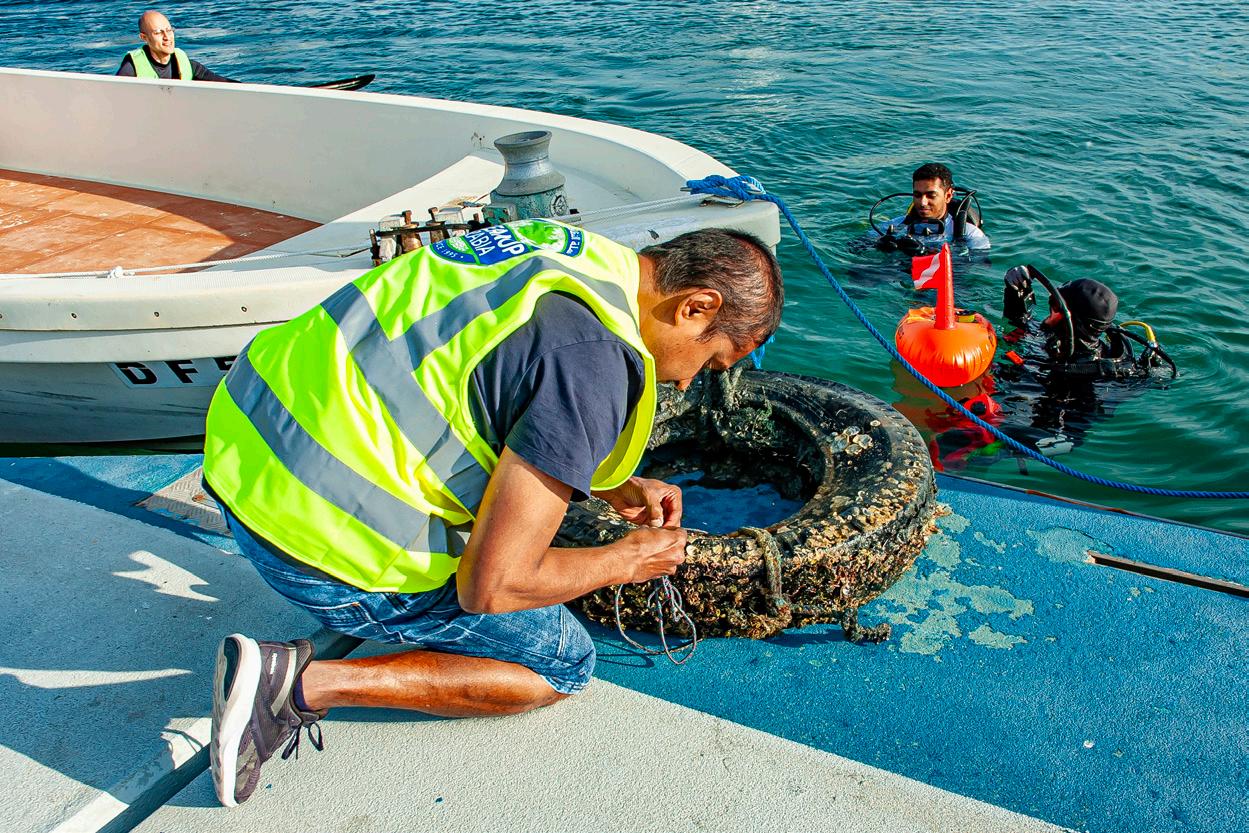


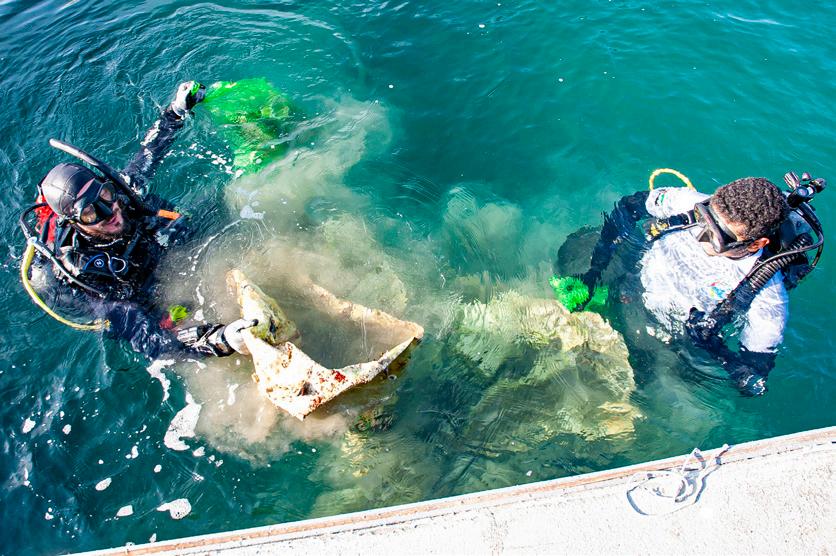
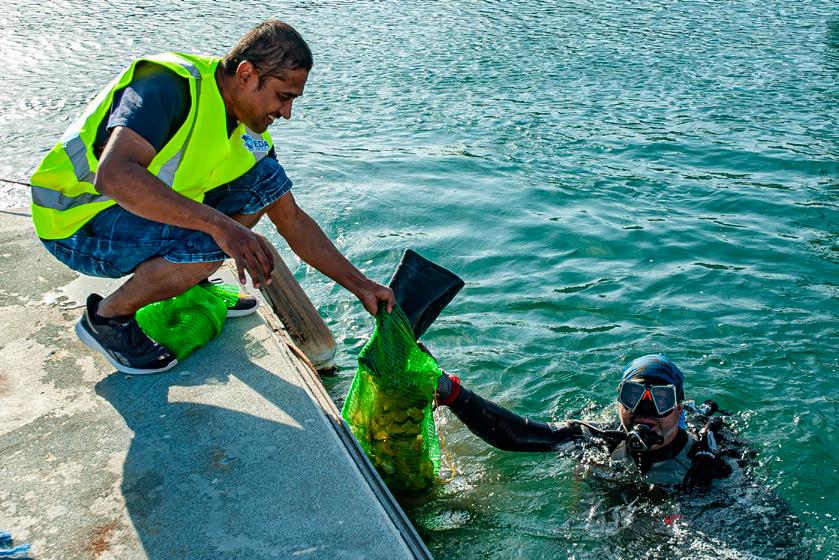



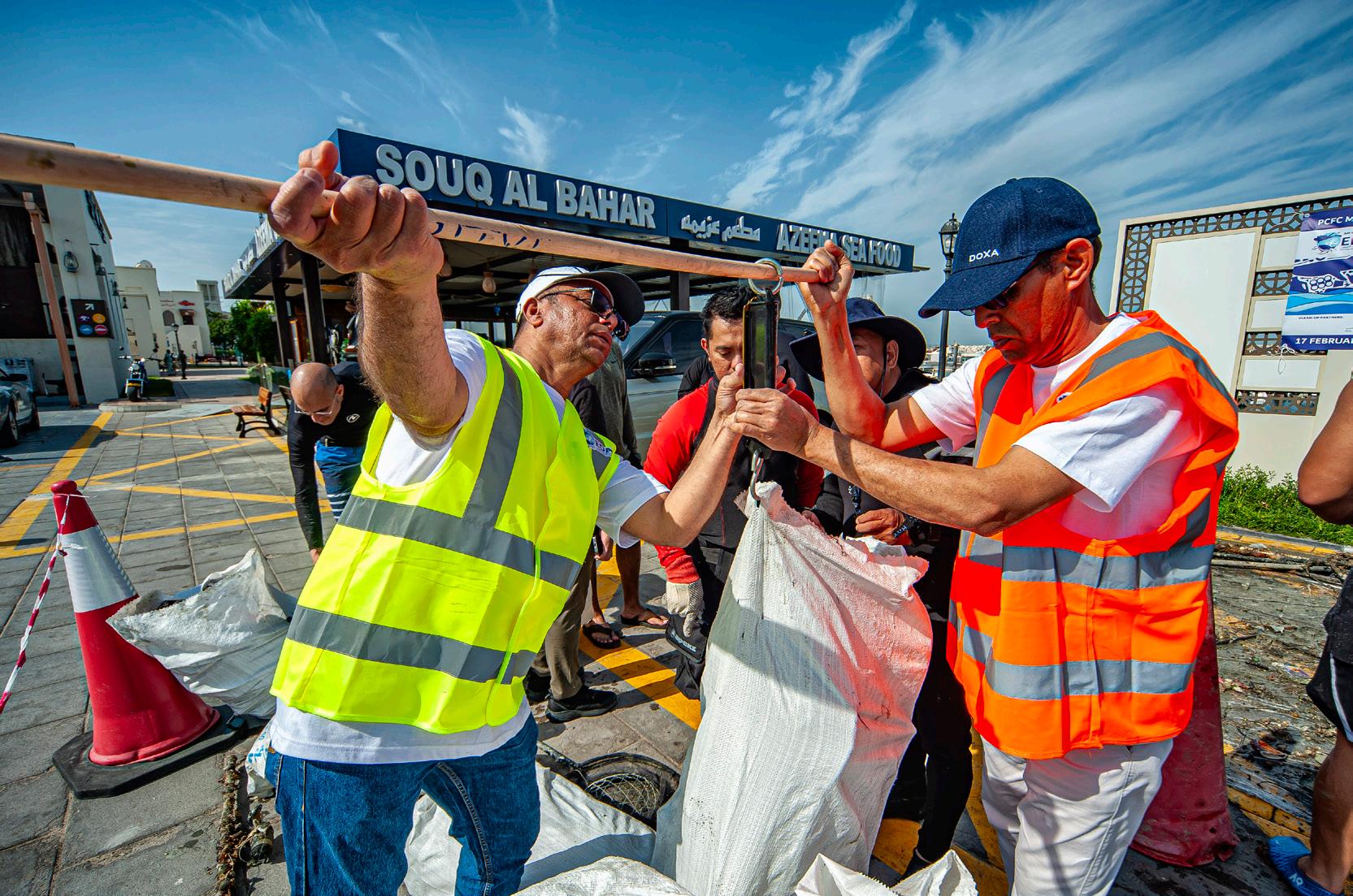
| MARCH 2024 FEATURES
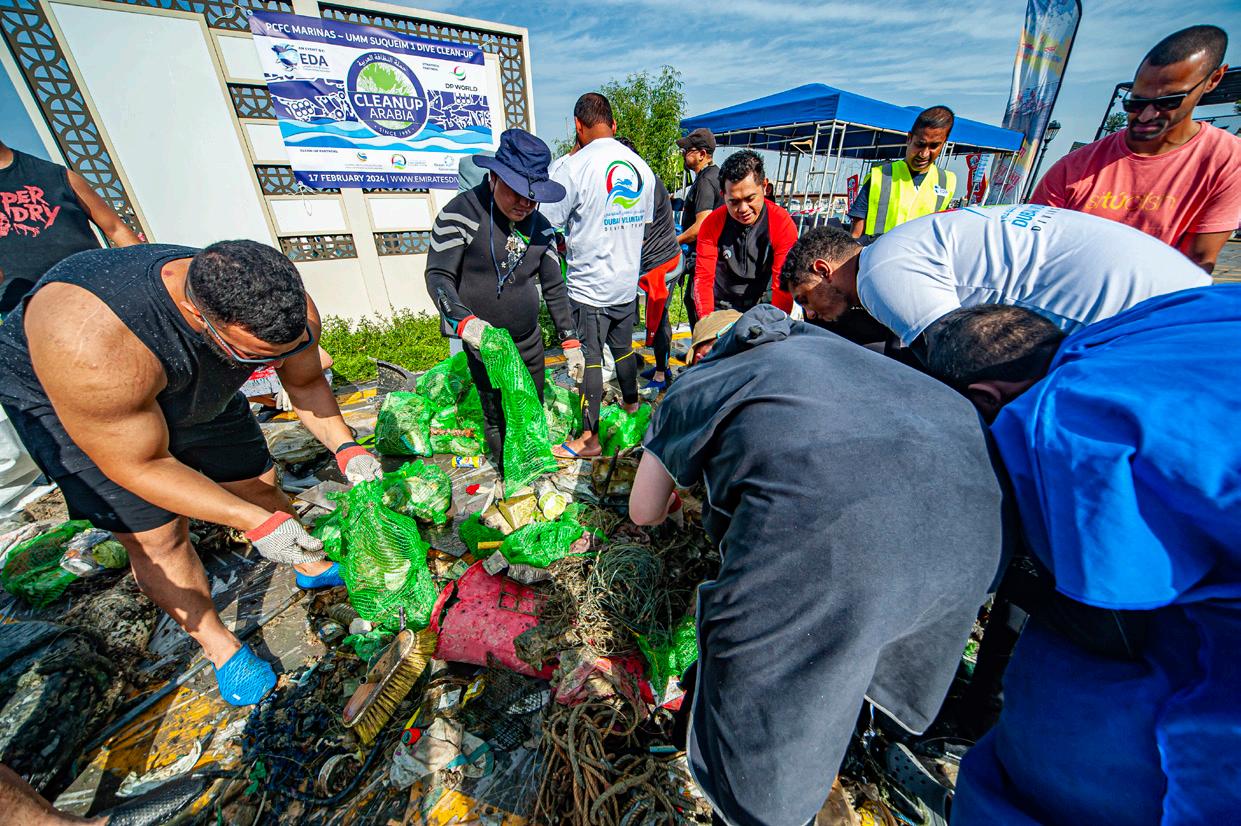
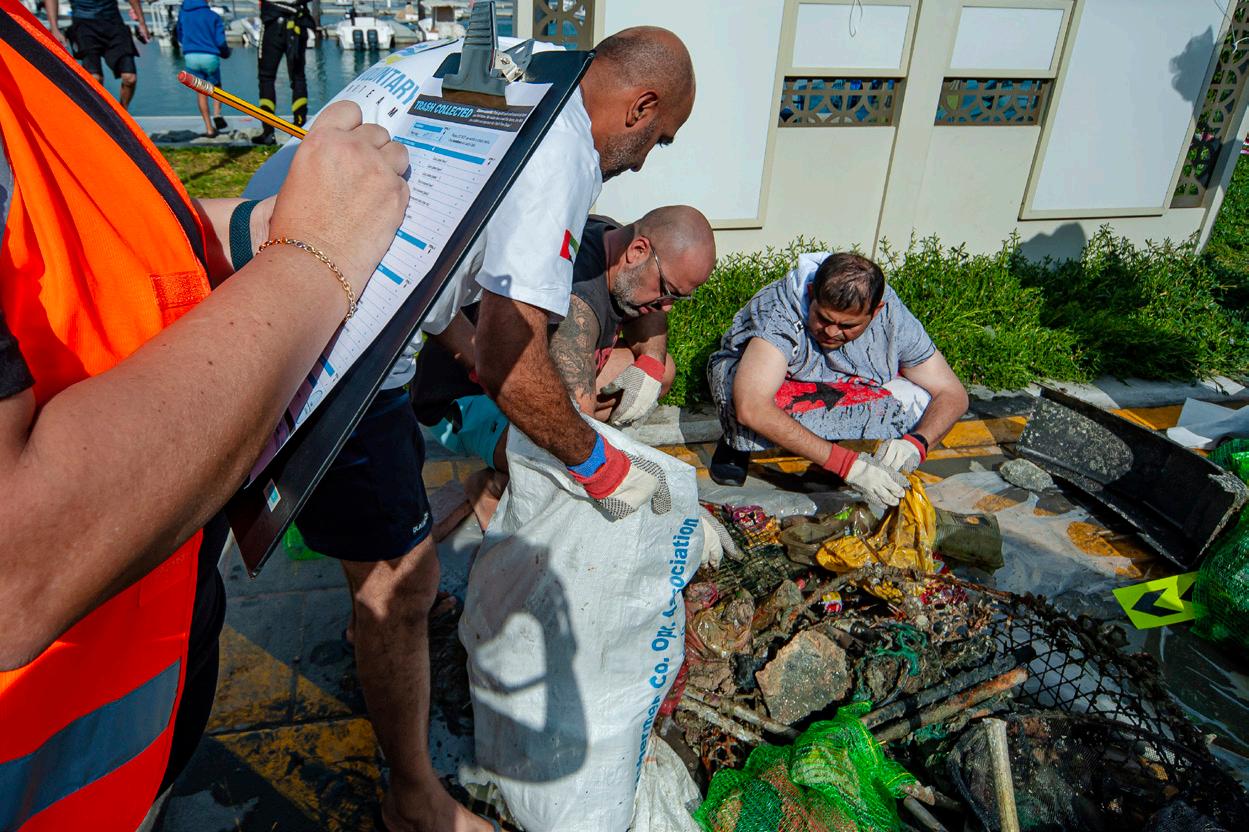


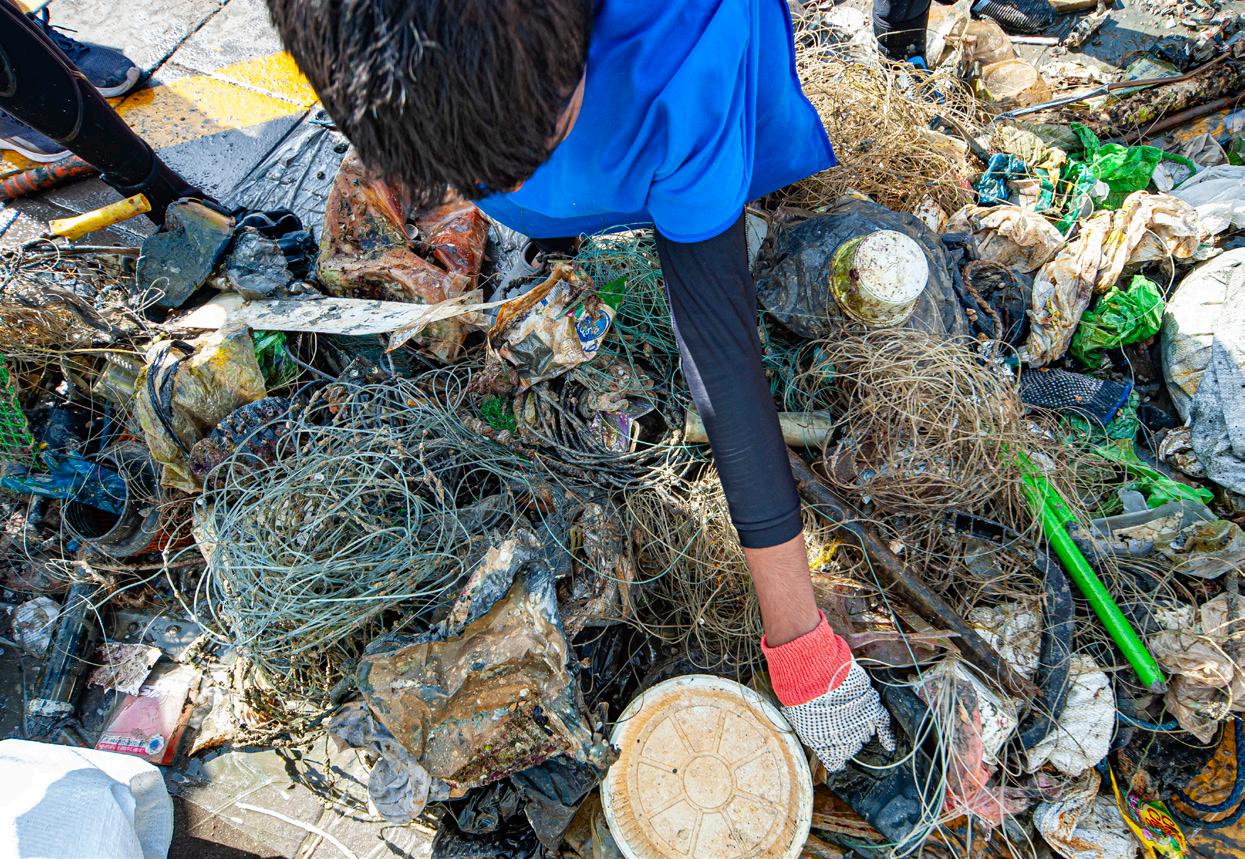



FEATURES

CUTTLEFISH!
FEATURE DR ALEXANDRA ALVES AND DR ELISE MARQUIS – THE YAS SEAWORLD RESEARCH & RESCUE CENTER, YAS ISLAND, ABU DHABI PHOTOGRAPHY ALLY LANDES
With this project, the community is called to voluntarily help conduct scientific research by assisting in data collection. Cuttlefish or cuttlebone sightings in the UAE can be registered in a short questionnaire where the community can also add photos. This data will allow the assessment of the local populations’ abundance, distribution, and habitat, as well as identifying nursery areas. All these figures shall be used to inform strategies for responsible fishing and conservation.
Cuttlefish can change their appearance, a technique that they use to hide from predators, ambush prey, and even fool rivals. They can change colour, pattern, and skin texture. Millions of chromatophore organs and iridophores cells present in their skin allow the cuttlefish to display amazing shifts in colouring and pattern, that can change in less than 200 milliseconds.
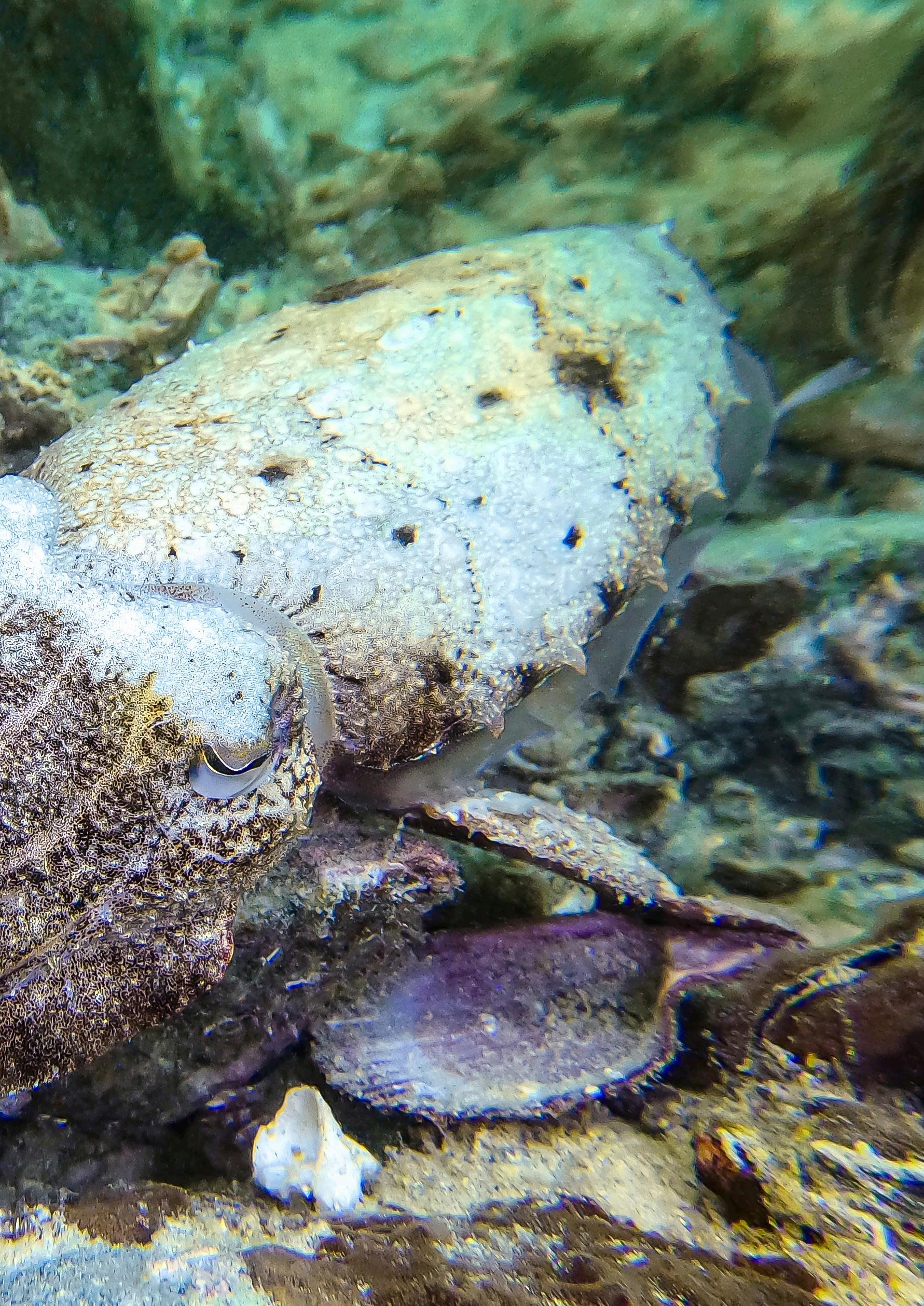

Many renowned mariners have fondly written about octopus and squids, divulging their most fascinating physical traits, their ingenuity, their life cycles and their behaviours. With this in mind, let us propose to add their humble cousins, the cuttlefish, to this pedestal of intelligence and phantasm.
On reflection, cuttlefish are perhaps the most frequently encountered of all the cephalopods – a washed up ‘bone’ on a beach, or a piece of food in a birdcage – we already know the cuttlefish and it is this rooted image, this familiarity, that may subdue our interest. That said, this interest should be instantly awakened once anyone has the chance to see them underwater. Imagine you are freediving at five metres deep on the edge of a fringe reef. Suddenly you freeze as a swarm of thirteen adults line up in front of you – their uniformity stretching menacingly across your field of vision, a haze of ejected ink from their leader slowly expanding as they big-eye-ball you to keep your distance. Small as they are, their arrangement is imposing, an evolution of behaviour from over a millennia. And like their cousins, in their underwater realm, they stress that they do indeed know more than us, as they drift inexorably away.
So, to come back to the start, cuttlefish are not fish, they are Molluscs of the Cephalopoda Class. Unlike their close mollusc relatives, most cephalopods have lost their external protective shells but have gained in dexterity and intelligent behaviour with their sucker-lined arms; elaborate camouflaged skin; complex eyes; and outstandingly well-developed brains and nervous systems.
The cuttlefish, belonging to the Sepidae Order, have a mollusc shell within their bodies known as the cuttlebone, the pupils of their eyes are often U or W-shaped, and they have 8 arms and 2 tentacles. The arms are shorter than the tentacles, and often only have 4 rows of suckers. Meanwhile, the 2 tentacles are retractable and have large densely stacked suckers. These suckers are used for hunting, enabling a strong grip on their prey.
There are many astonishing facts about the biology of cuttlefish.You may have already heard this one: cuttlefish have three hearts. Indeed, their circulatory system is complex and needs three hearts to function: one systemic heart to distribute the oxygen-rich blood throughout the body, and two branchial hearts to create the pressure necessary to oxygenate the blood
through the gills. Another fact concerns the colour of their blood. Contrary to humans, cuttlefish don’t have red blood cells, or the iron-based pigment known as haemoglobin that transports the oxygen in the red blood cells. Instead, these animals have a copperbased pigment named hemocyanin that is freely dissolved in the blood. This copper-based pigment turns blue/green when oxygenated; which is why cuttlefish blood appears green!
Now, if we look at their cuttlebone in detail, we quickly understand that this is much more than a bone. Cuttlefish can hover in the water thanks to their cuttlebone, which allows them to control their buoyancy via chambers with high porosity and permeability. In these chambers, the ratio between gas and liquid determines how much the animal will float or sink. By regulating this ratio, cuttlefish have very delicate control over their buoyancy.
To swim, cuttlefish use the horizontal fins around their mantle, and jet propulsion when they want to escape at speed. When facing a predator, they can also eject a black ‘ink’, giving them time to escape – this ink creates bizarre, animalian forms that are named pseudomorphs, confusing the predator.
46 DIVERS FOR THE ENVIRONMENT | MARCH 2024 FEATURES
ABOVE: Cuttlefish can hover in the water thanks to their cuttlebone which allows them to control their buoyancy via chambers with high porosity and permeability.

Some small species such as the flamboyant cuttlefish, in which the smaller cuttlebone is not as efficient in controlling buoyancy, use a remarkable locomotion strategy close to bipedalism as they use their arms and fins as legs to slowly move across the seafloor.
Yet the best-known trait of the cuttlefish is their mesmerising camouflage abilities. They are the kings of disguise! Cuttlefish can change their appearance, a technique that they use to hide from predators, ambush prey, and even fool rivals.They can change colour, pattern, and skin texture. Millions of chromatophore organs and iridophores cells present in their skin allow the cuttlefish to display amazing shifts in colouring and pattern, that can change in less than 200 milliseconds. Different skin textures and shapes are possible by use of the papillae, which are composed of erector muscles that lift bumps in the skin with a variety of shapes matching the animals surrounding 3D environment, such as the texture of algae, corals, or rocks.
Cuttlefish are solitary animals, except during the breeding season when they may form aggregations of thousands of individuals. Noteworthy species include the giant
cuttlefish inhabiting the southern part of the Australian coast. During the breeding season, males present a colouring known as the “Intense Zebra Display” (white and black bands on the mantle and 4th pair of arms), which they use to intimidate other males and impress females. A male initiates the courtship by hovering over and alongside a female, continually drawing its arms over her mantle, head, and arms. Eventually, the male grasps the female and mates head-to-head. In the breeding assemblies, the big males tend to be aggressive, and the escalation of fights are common. Small cuttlefish males have developed a technique to avoid fighting but still succeed in mating. These cheeky males mimic the appearance and posture of females, thus fooling the bigger males, enabling them to reach the protected females and mate without triggering any alarms and fighting behaviour from their rivals.
The fertilisation of the eggs occurs externally with spermatophores released by the male into a pouch located underneath the female’s mouth. The female fertilises the eggs one by one and wraps the stalk of each fertilised egg around a stable structure (rock, coral, seagrass, etc). The male may support the
female during several hours needed for egg laying, this behaviour is known as temporary mate guarding. Each batch of eggs laid differs in number. The colour of the eggs differ between species, the Atlantic and Mediterranean cuttlefish lay black eggs because they are inked, and species that inhabit warm waters like the UAE, lay white/transparent eggs.
The embryonic development of a cuttlefish inside the egg is temperature dependent. The embryo forms on top of a large yolk, that is used as an energy reserve. After approximately 10 days from fertilisation, the embryo starts to form organs, eyes, arms, ink sac, and cuttlebone. In the third week, the chromatophores appear, allowing changes in the skin pigmentation, and in the fourth week, a miniature version of the adult cuttlefish is ready to hatch. The hatchlings, measuring only 1-2cm long, are ready to eject ink, hunt, display patterns, and change the shape of their skin. In the wild, the survival rate of these hatchlings is very low due to predation and feeding challenges. The typical life expectancy of a cuttlefish is about 1-2 years, with sexual maturity reached as soon as 4-6 months after hatching.
Cuttlefish are not only astonishing for their
47 MARCH 2024 | DIVERS FOR THE ENVIRONMENT
FEATURES
ABOVE: Cuttlefish mate head-to-head after an elaborated courtship initiated by the males. Photo by Alexandra Alves.

biology and cognitive abilities, they are also very important to fisheries around the world. Globally, a total of 348,000 tons of cuttlefish were landed in 2018 (FAO, 2020). Unfortunately, little is known about cuttlefish behaviour and lifecycles within their natural habitats (Barrett et al. 2022) and most stock assessments are inadequate to determine whether populations have declined, and if intervention is required. As a result, conservation measures have been applied to relatively few cuttlefish species to date. Focused research and large-scale studies on cuttlefish populations are required to fill the knowledge gaps and improve conservation strategies.
At theYas SeaWorld Research & Rescue Center, Dr Alexandra Alves is leading the research project aiming to study the local species of cuttlefish, Sepia pharaonis (pharaoh cuttlefish), to better understand their physiological adaptations to natural environmental stressors (high salinity, temperature, and light intensity). Dr Alexandra is now working on optimising the methodologies to control the cuttlefish
life cycle within the centre’s laboratory. She is using a multidisciplinary approach using zoo-technological, molecular, and behavioural tools to improve fecundity and egg quality. This research will also support the development of cuttlefish cultures by the regional aquaculture farms, which could in turn help protect the wild populations of the Arabian region.
Most of the divers around the United Arab Emirates know that there are many cuttlefish within our waters. But still, little to nothing is known about the cuttlefish populations inhabiting the Arabian Gulf and Arabian Sea. A recent study on the landings of pharaoh cuttlefish in Iran’s waters of the Arabian Gulf showed signs of overfishing (Hashemi & Doustdar, 2021).
Based on the lack of information about local cuttlefish populations, Dr Alexandra and the centre’s team created a Citizen Science Initiative, simply named Cuttlefish! With this project, the community is called to voluntarily
help conduct scientific research by assisting in data collection. Cuttlefish or cuttlebone sightings in the UAE can be registered in a short questionnaire where the community can also add photos. This data will allow the assessment of the local populations’ abundance, distribution, and habitat, as well as identifying nursery areas. All these figures shall be used to inform strategies for responsible fishing and conservation.
Cuttlefish are part of the amazing marine biodiversity of the UAE coastal ecosystems and as every other species, they deserve everyone’s attention and care! We are counting on you to appreciate how marvellous cuttlefish are when you will encounter them on your future dives. Please let us know what you see down there.
Dr Alexandra Alves and the Yas SeaWorld Research & Rescue Center will keep you informed on their journey to unveil the secrets of the cuttlefish population of the UAE.
48 DIVERS FOR THE ENVIRONMENT | MARCH 2024 FEATURES
ABOVE: Dr Alexandra Alves is leading the Cuttlefish! research project aiming to study the local species of cuttlefish, Sepia pharaonis (pharaoh cuttlefish), to better understand their physiological adaptations to natural environmental stressors (high salinity, temperature, and light intensity). Photo by Elise Marquis.
OPPOSITE PAGE TOP IMAGE: The female cuttlefish wraps the stalk of each fertilised egg around a stable structure, rock in this example. Photo by Elise Marquis.
MIDDLE ROW: These eggs have unfortunately been attached to plastic waste that were discovered during underwater clean-ups: A canvas tarp, and plastic food packaging.
BOTTOM IMAGE: This very camouflaged young cuttlefish was about 10-12cm in length and was in full hunting mode as it caught this very unsuspecting mantis shrimp for lunch.
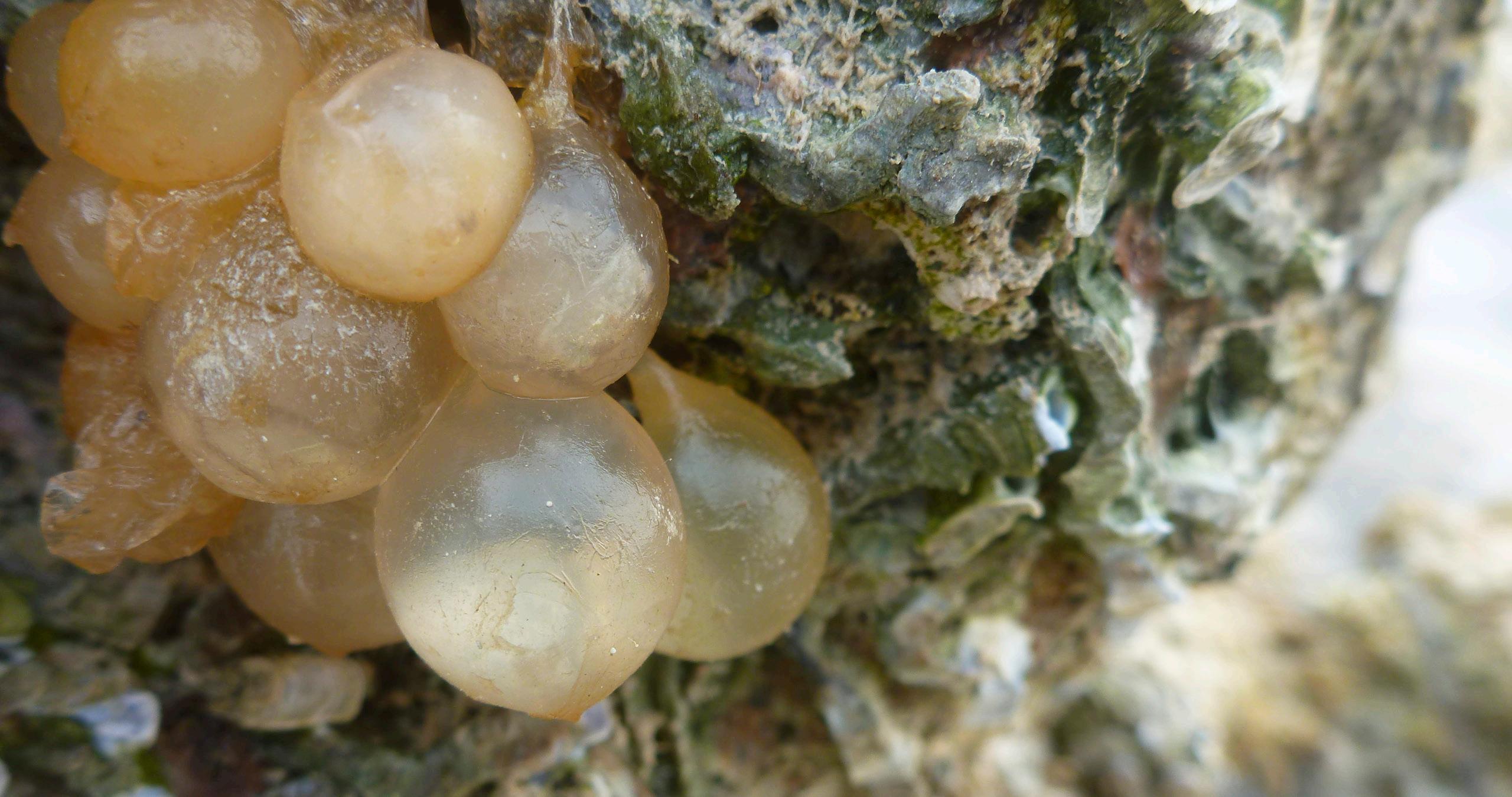
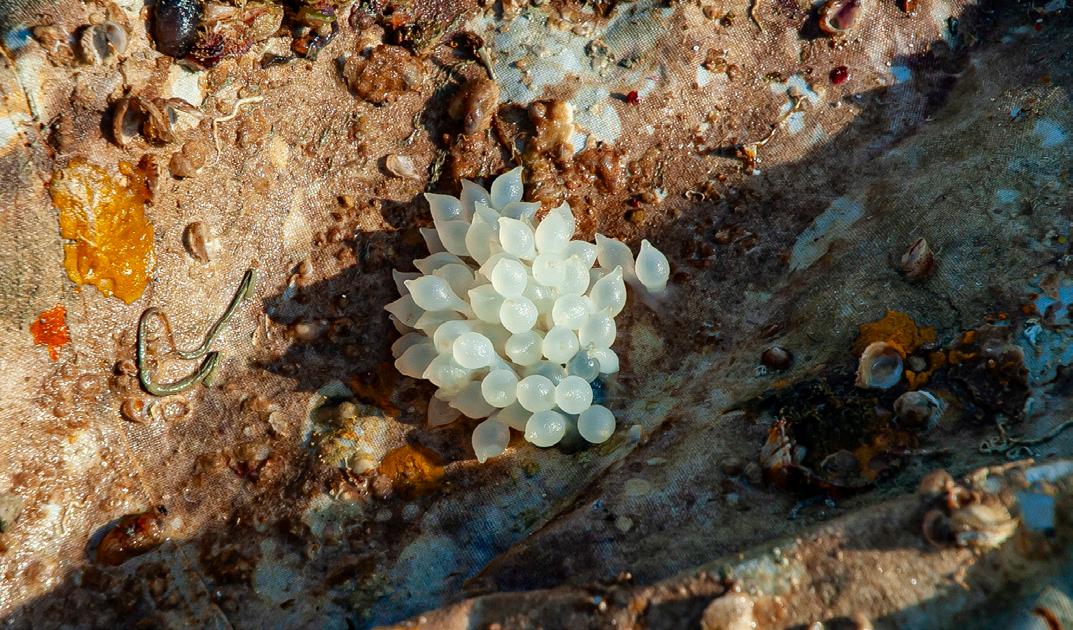



HOW TO GET INVOLVED
You can take part in the Citizen Science Initiative by filling out the form to report your sightings which can be found here:
https://www.seaworldabudhabi.com/ en/research-and-rescue/cuttlefish

49 MARCH 2024 | DIVERS FOR THE ENVIRONMENT
FEATURES
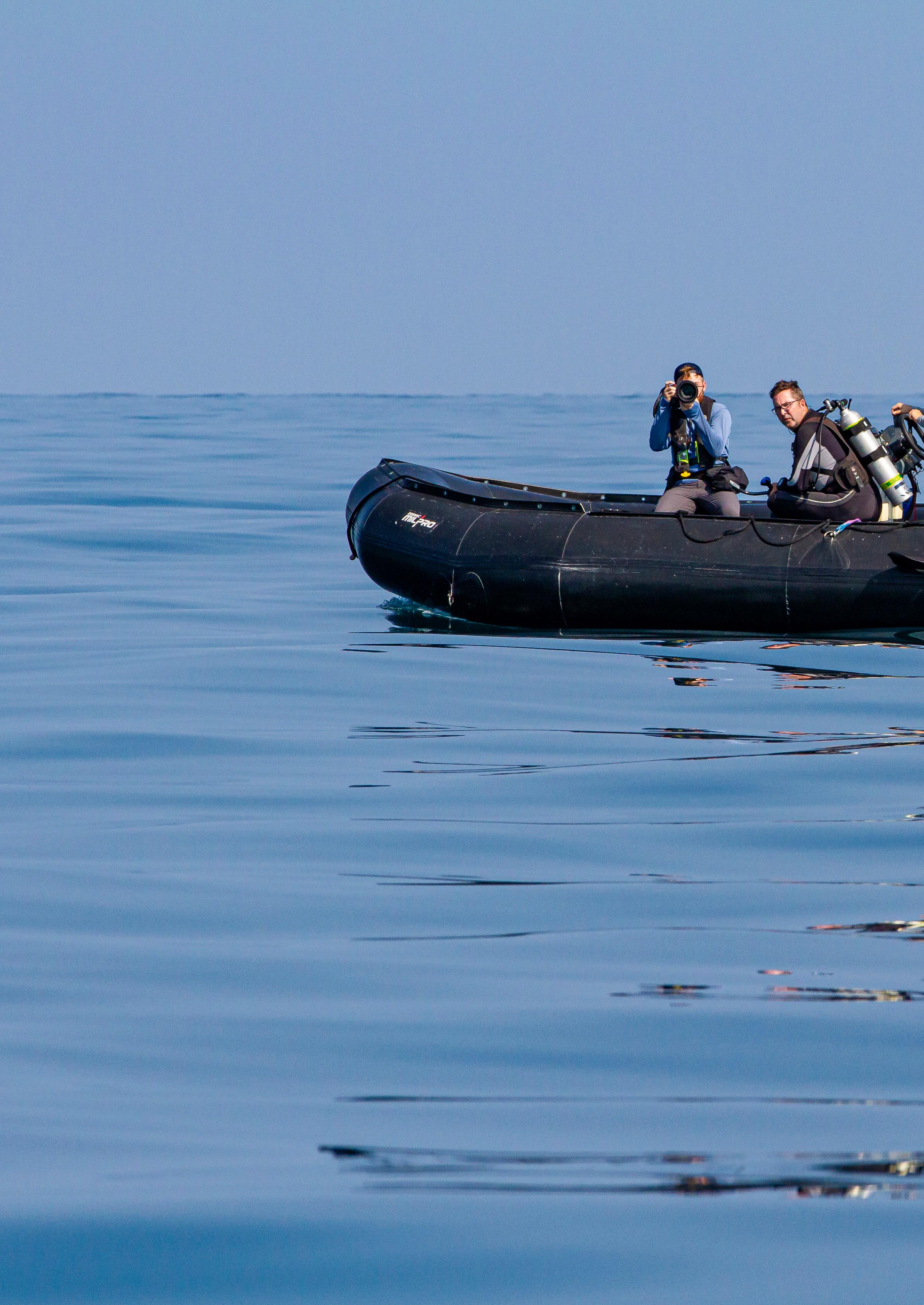
A DECADE IN THE MAKING:
FIRST DEDICATED WHALE & DOLPHIN SURVEY IN UAE OFFSHORE WATERS ONBOARD OCEANXPLORER
FEATURE BRYANA COPE FEATURE AND PHOTOGRAPHY ADA NATOLI
In conclusion, this mission proved there is an important presence of whales and dolphins in the offshore waters of the UAE and further stresses the need to conduct dedicated surveys for these species in the whole offshore Gulf area to better understand their occurrence, distribution and identify important areas for their survival.
to the public from all its
Here the
with
in
in the background: science, media, and
in one photo!
One of the main tenants of OceanX is bringing high quality media footage back
missions.
media team, complete
scuba divers, dove
near the dolphins to capture their behaviour underwater. OceanXplorer is seen
technology




For the first time, the UAE offshore waters were the target of a survey dedicated to investigating the occurrence of whales and dolphins in this poorly known marine area.
After a decade of effort, we now have a distinct idea of the species of cetaceans and the frequency to which they occur in the coastal waters, but the presence of these animals in the Gulf offshore waters is still unchartered. Opportunistic data collection from the Report a Sighting programme conducted by the UAE Dolphin Project Initiative over the last 10 years has shown that Bryde’s whales, killer whales, and pelagic small cetaceans occur in these waters. This data is limited, as the public that ventures in these areas is limited, and these species have not been recorded by the coastal surveys the project has been conducting since 2013. Stranding data also reported the presence of species that are not generally sighted coastally, and more worryingly an increased number of whale mortalities in the last few years.
The survey was conducted onboard the research vessel OceanXplorer as part of the Phase 1 OceanX Expedition in the UAE in
November 2023 following a call for a research proposal earlier in the fall. The UAE OceanX Expedition was the result of a collaboration between OceanX, Environment Agency Abu Dhabi, G42 and Bayanat, flanking the 2023 COP28 event. OceanX is a non-profit ocean exploration organisation founded by Mark and Ray Dalio in 2018. The organisation's mission is to "explore the ocean and bring it back to the world" and it is equipped with one of the most advanced marine research vessels, OceanXplorer (https://oceanx org/ oceanxplorer) and skilled crew in the world.
A team of cetacean experts from The UAE Dolphin project Initiative (Zayed University) and Fujairah Research Centre joined for a ten-day offshore expedition together with scientists from other research groups. The general target was to provide a baseline assessment of the species of cetaceans and their frequency occurring in the offshore waters, but the main interest was on checking for the presence of whales, ALIVE whales, after witnessing so many strandings in the past years of these majestic animals! Whales are known to occur in the Gulf, up to Kuwait quite regularly, but reports are rare, and little is
known about their population status.
Thanks to the top-notch vessel facilities and skilled OceanXplorer crew team, despite the unfriendly weather, the team succeeded in covering 641km corresponding to 78 hours of positive survey time. Surveys were conducted from the bridge deck, 16m above the sea surface, that proved to be an optimal observation platform. When sightings occurred from the bridge, the team was able to rush down to one of the small boats onboard OceanXplorer, and it was lowered into the water within minutes, thanks to the amazing collaboration of the OceanXplorer captain and crew! The team then followed the dolphins to gather photographic data to be able to identify the individuals as well as take behavioural data on the groups. When the main vessel was stationary on a location for the day, the team was able to use one of the small boats to survey the surrounding area, maintaining contact with the other 3 small boats that were out collecting their data, while also keeping an eye on the water in case of any sightings.
We were able to enter data as we collected
52 DIVERS FOR THE ENVIRONMENT | MARCH 2024 FEATURES
ABOVE: For the first time, a sighting of a Bryde’s whale was recorded by a dedicated research team searching for whales and dolphins on the offshore survey of Abu Dhabi waters, conducted on the Research Vessel OceanXplorer. This whale will hopefully be identified to past or present global records by the large scar on the body. Photo by Oliver Farrell.
BOTTOM ROW: The offshore survey of Abu Dhabi waters amassed 11 sightings of dolphins! Various behaviors were observed, including mating!
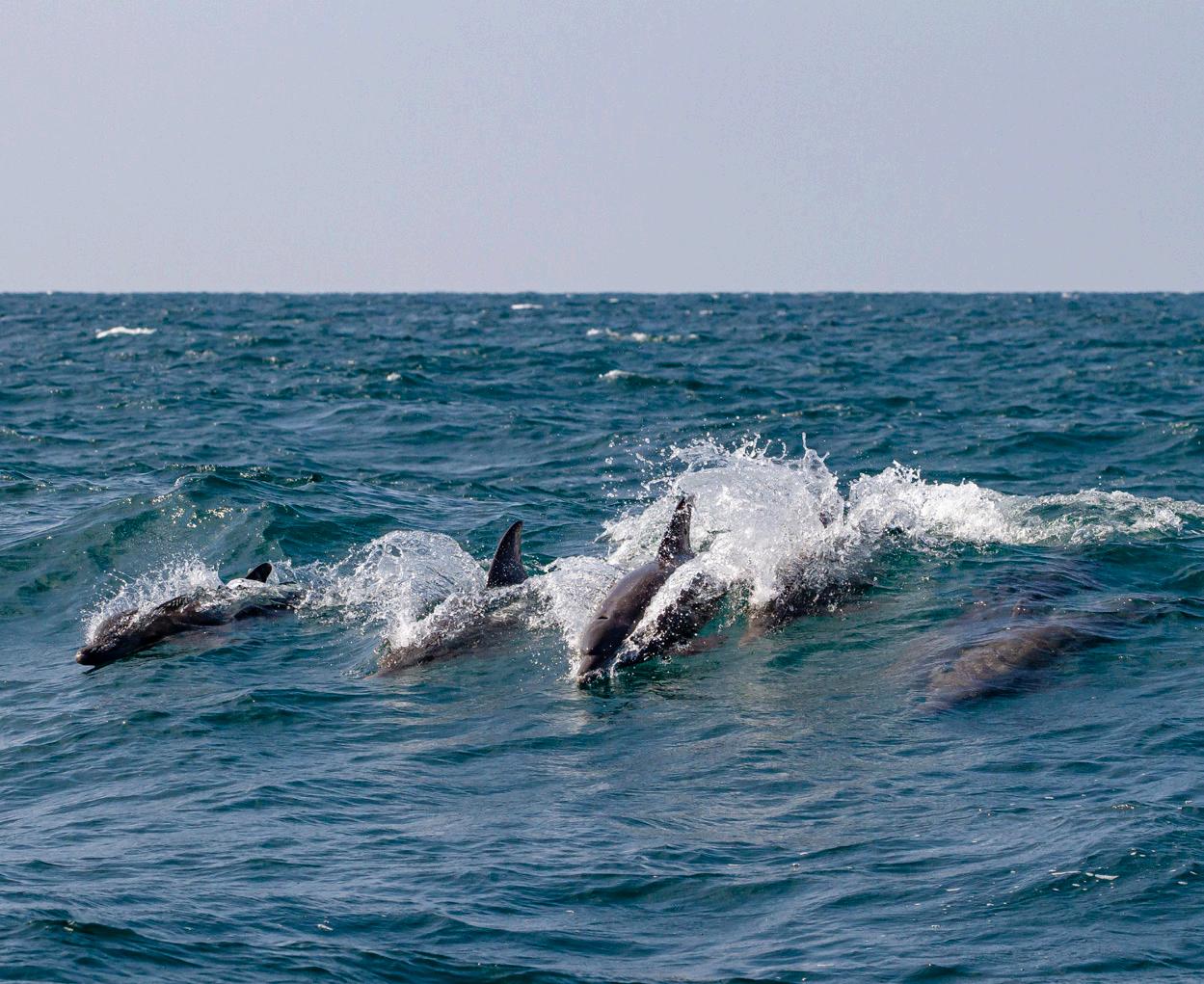
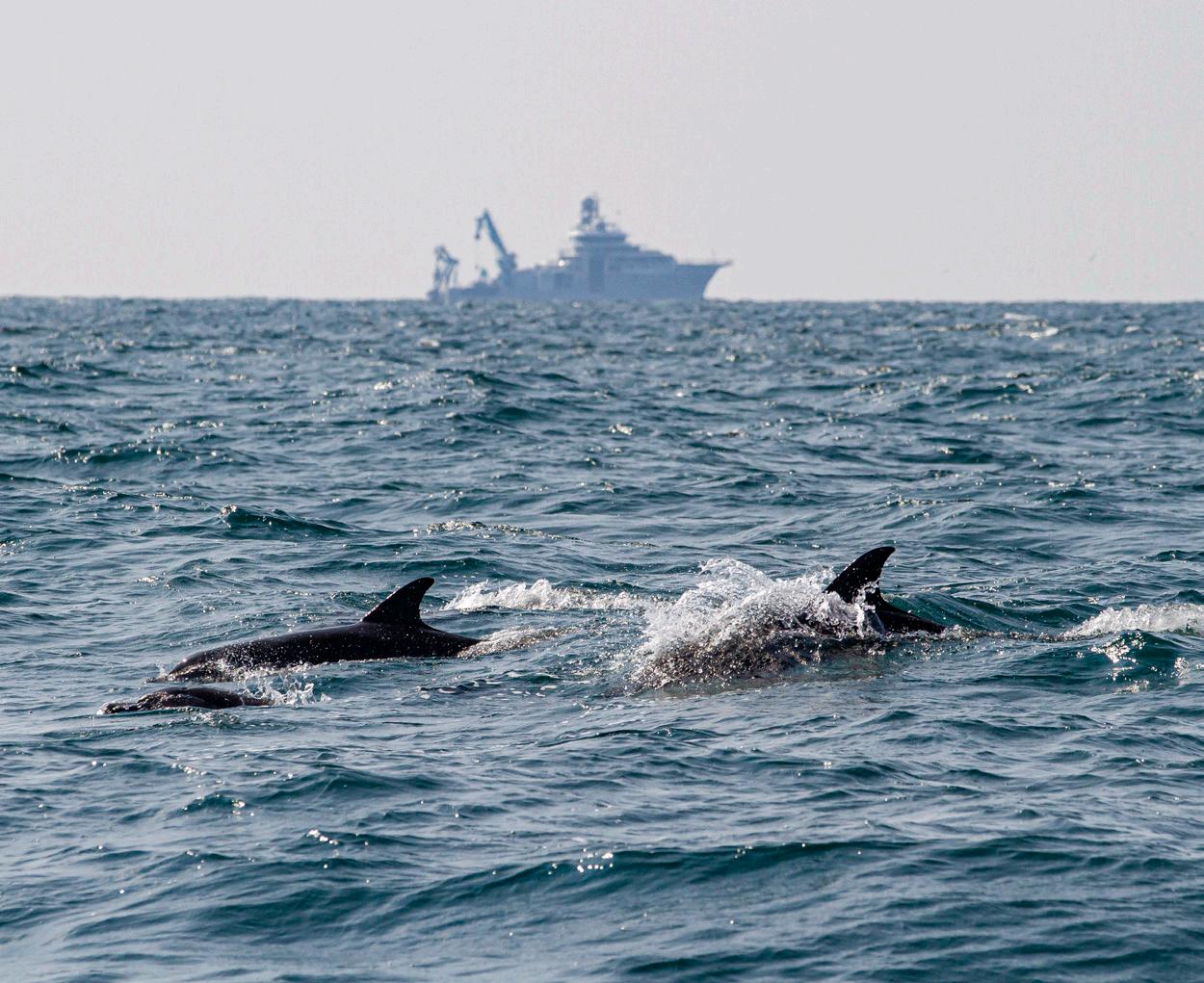
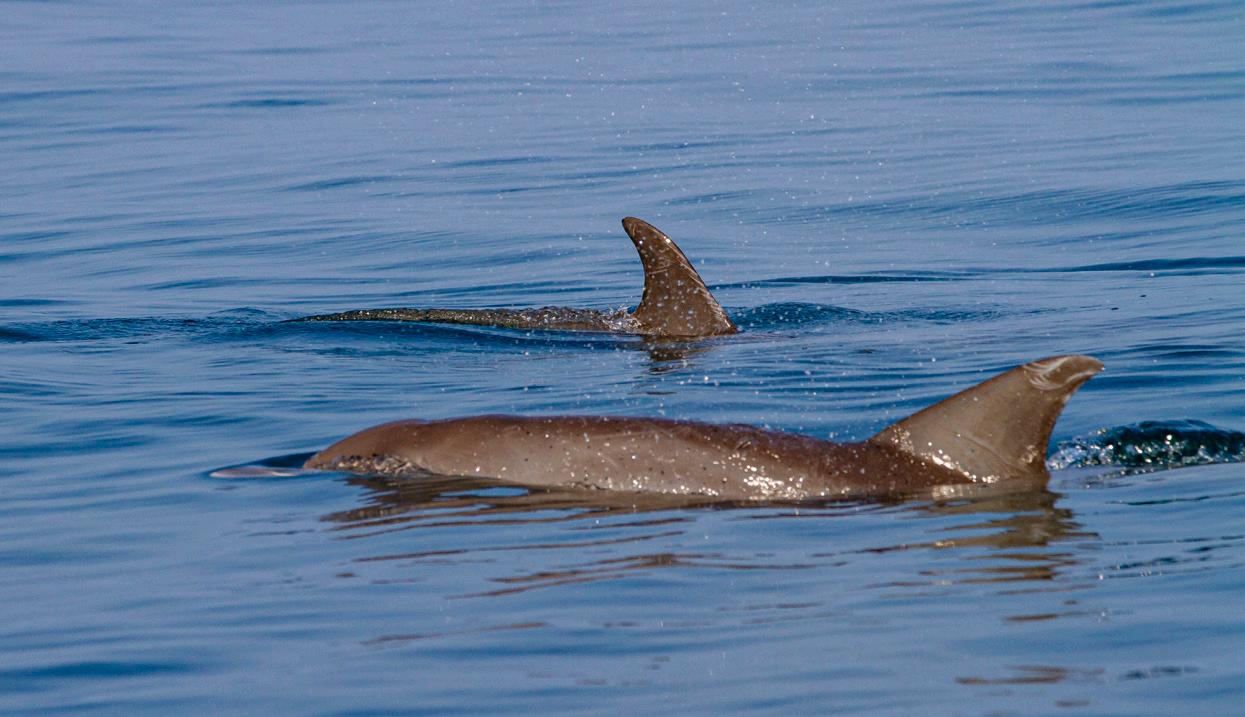

it, working in one of the four labs onboard, to optimise the survey for the following days’ mission. OceanX’s multidisciplinary model combines science, technology, education and media to uncover the unexplored depths of the ocean and bring the discoveries found on each mission back to the world. Meaning we had highly skilled media coverage of some of our sightings, even underwater footage taken of one of the groups we encountered!
The surveys resulted in a total of 12 sightings, overall, two species. These included 11 sightings of bottlenose dolphins, and to our surprise and thrill, one sighting of whales!
Two Bryde’s whales! The whales were seen feeding by one of the media team boats who promptly reported it to the survey team. Luckily, we were only a kilometre away and were able to reach the location of the whales and to photograph them both surfacing, dorsal fins on full display. The fact that they were seen feeding suggests that the area may be a feeding ground for these species and may occur more frequently than what is known so far. Bryde’s whales occur in the entire Indian Ocean, but whether they are one single species or multiple ones is still uncertain. It is known
that there are at least two types: a bigger one usually encountered in offshore waters and a smaller form, that prefers coastal waters and, in some regions, is observed to be resident. Unlike other whales, Bryde’s whales tend to be quite shy and do not tail up (show their tail) when diving, which makes the identification of individuals quite challenging. If we were lucky in finding them, we were not as lucky with the sea conditions that were pretty choppy that day. And after a few surfaces, they disappeared into the waves. Nothing looks big at sea.
We will feed the photographs collected into international catalogues and see if we are lucky enough to be able to see if any of the two individuals were seen before somewhere else and track potential movements of these species across oceans. One individual was observed with a big mark on its left side which may help with the recognition.
Photo identification data is some of the main data collected during the sightings. By taking photos of the dorsal fins, we can identify the individual by the unique notches, nicks and scratches each one has. Across the bottlenose dolphin sightings, we collected 8,700 photos
and some videos from 10 of these sightings. We will use this data to compare with our established catalogue of dorsal fins from the surveys in Dubai and Abu Dhabi coastal waters to attempt to track the single individuals and have an insight into whether the same individuals utilise the coastal and offshore waters, or if they are two separate populations. Ultimately, we can attempt to use the photo identification data to obtain an estimate of the size of the population that use these waters.
Behavioural data includes an estimated group size, presence of calves, and the overall behaviour of the group – what were they doing when observed. We encountered both relatively small groups, about 6 individuals, and big groups, with the largest reaching about 35 individuals. There were four sightings that included at least one calf, with one sighting having an estimated five calves! Interestingly, three of the sightings occurred close to the shores of islands. This will be investigated to see if there is any correlation for these animals in being close to the mainland coastal areas versus close to island coasts. Most likely, the preference for spatial use is based on
53 MARCH 2024 | DIVERS FOR THE ENVIRONMENT
FEATURES
TOP ROW: The various weather conditions didn’t stop the team and crew from spotting dolphins from the small boats or the main vessel. In rough seas, dolphins were ofter seen racing through the waves. BOTTOM ROW: Clear pictures of the dorsal fin for photo identification will allow the researchers to match these individuals with the available individual’s catalogues from the coastal population in Dubai and Abu Dhabi.
FEATURES

Body scars are often observed on bottlenose dolphins and are the results of interactions amongst individuals. They can be used to aid individual identification on a short term basis.
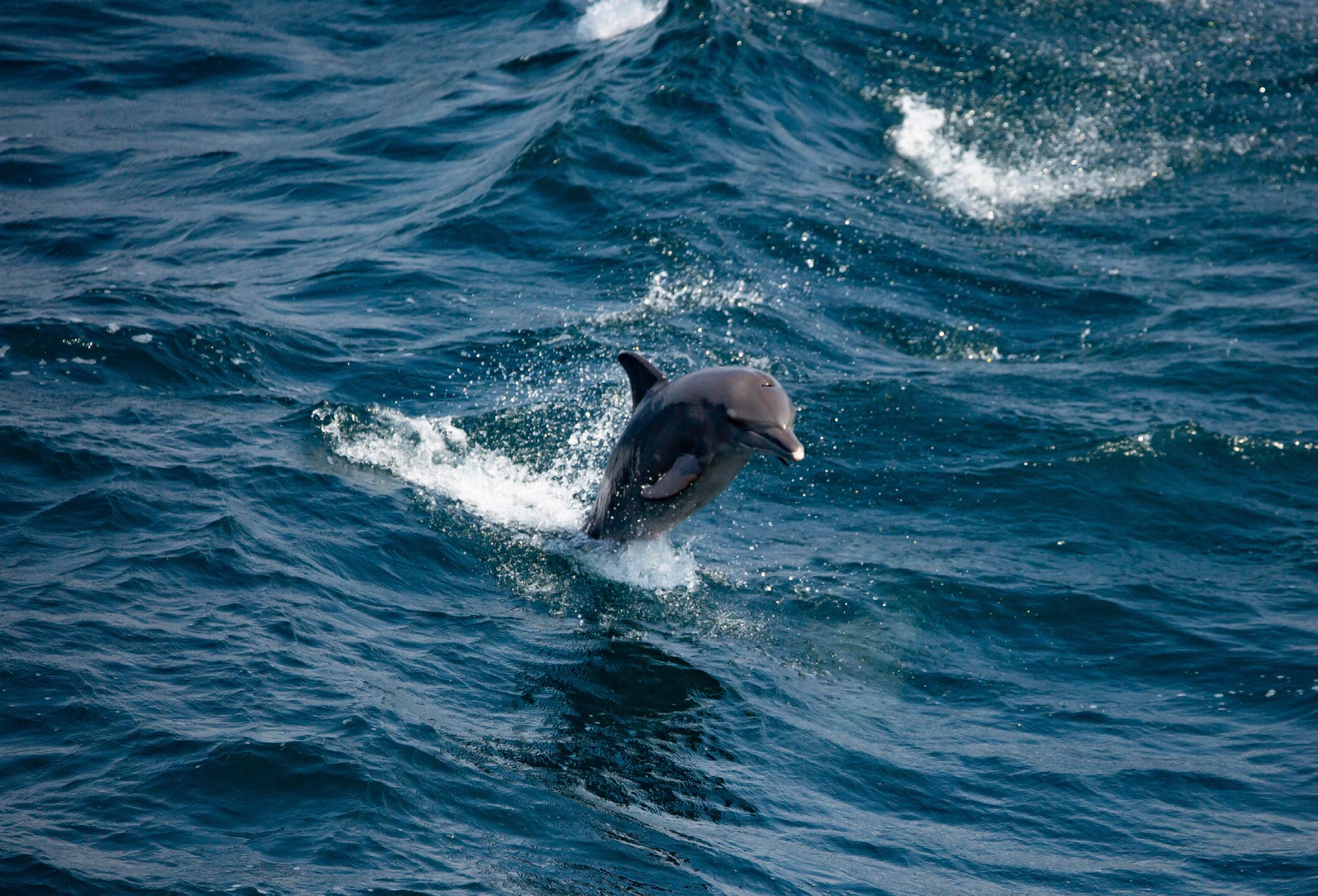 A dolphin leaping over the wake of the waves made by the OceanX vessel while moving. Observers stationed on the bridge spotted dolphins on multiple occasions.The team was able to get onto the smaller vessels and approach the dolphins from the surface whilst also observing from the bridge. Truly a team effort! Photo by Rebekka Pentti.
A dolphin leaping over the wake of the waves made by the OceanX vessel while moving. Observers stationed on the bridge spotted dolphins on multiple occasions.The team was able to get onto the smaller vessels and approach the dolphins from the surface whilst also observing from the bridge. Truly a team effort! Photo by Rebekka Pentti.

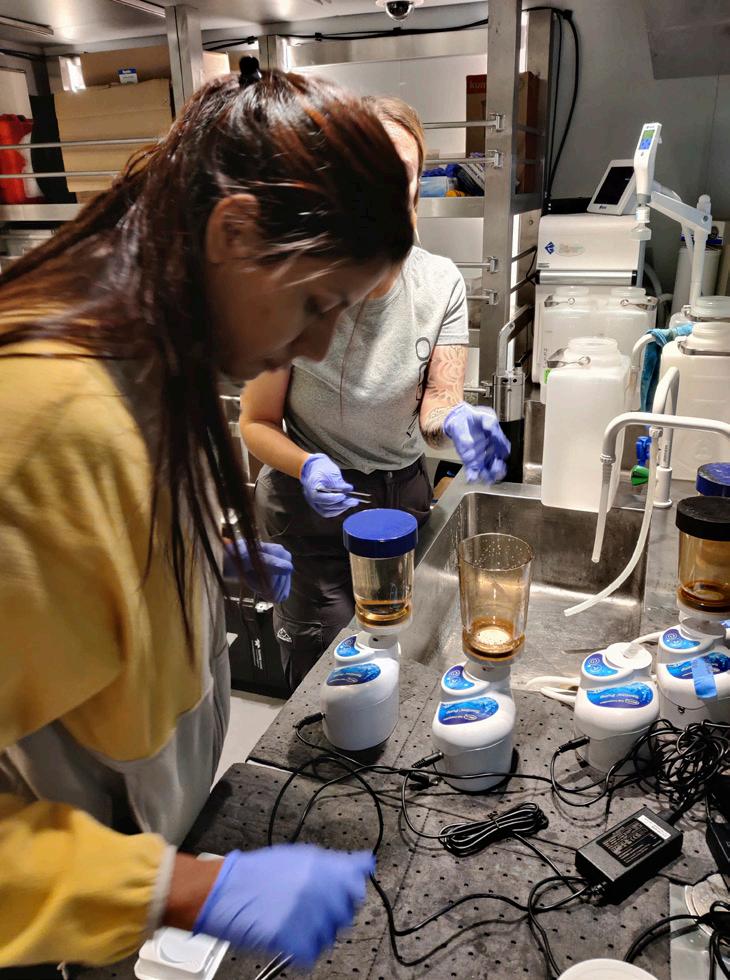
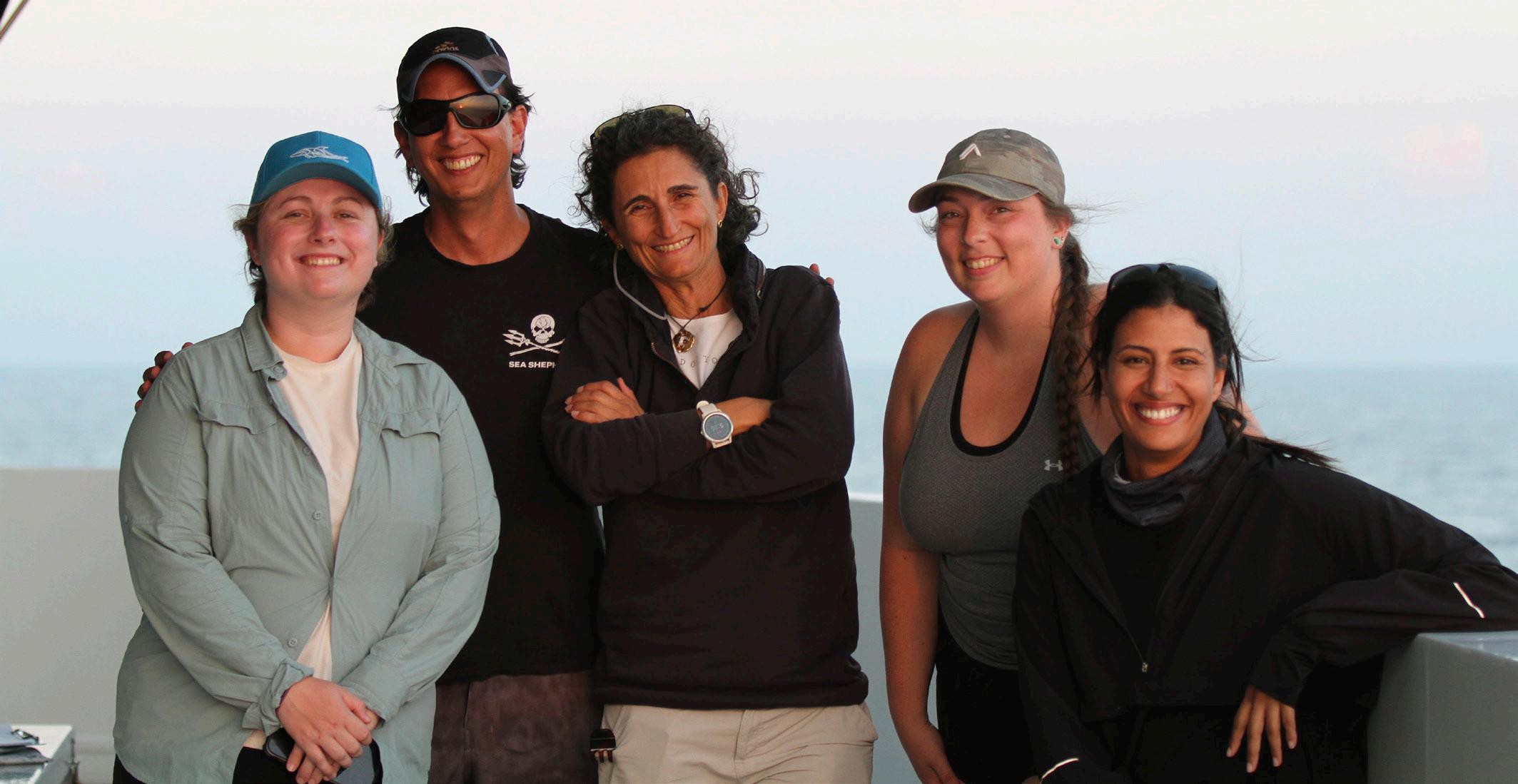
food availability and potential shelter from harsh weather.
Outsourcing the amazing laboratory facility and technical support onboard, the team also focused on conducting genetic analyses. One target was to investigate whether environmental DNA (eDNA) analysis could be an effective tool to monitor the presence of whales and dolphins in these waters. This technique consists of analysing the DNA collected in the environment, and through its analysis, checking for the presence of different species. It will provide an assessment of the biodiversity of an area but can also be useful to identify the presence of specific species, in our case whales and dolphins. This technique
is currently used in many other locations in the world. However, the extreme conditions of the Gulf waters, characterised by high temperatures and salinity can affect the eDNA, and whether this technique is viable here is still unclear.
In conclusion, this mission proved there is an important presence of whales and dolphins in the offshore waters of the UAE and further stresses the need to conduct dedicated surveys for these species in the whole offshore Gulf area to better understand their occurrence, distribution and identify important areas for their survival. For the whales in particular, regional collaboration across countries is needed to better understand these species
and how they utilise and move across the Gulf and surrounding waters, and what are the main threats that may hamper their survival. Extending the research area toward the Strait of Hormuz will highly enhance the information on the whale and dolphin species in this region. This data will be critical in supporting and raising awareness and effective conservation policies to protect these rare species.
This work was conducted on the R/V OceanXplorer in collaboration with OceanX. Special thanks to the Fujairah Research Centre, G42 Healthcare, Bayanat, NYU Marine Biology Lab, Environment Agency Abu Dhabi, and the OceanXplorer team for all the support during the mission.
55 MARCH 2024 | DIVERS FOR THE ENVIRONMENT
FEATURES
TOP RIGHT: The team gathered environmental DNA (eDNA) samples during sightings of dolphins and whales in order to test if this would be an effective tool to monitor the presence of these species in the Gulf. Here the samples are being processed through a rigorous filtration process, and later analysed for the presence of whales and dolphins species. A method used around the world but something that is still being tested for effectiveness in Gulf waters. THE TEAM: The whale and dolphin team onboard OceanX from left, Caitlin McFarlane (Zayed University/UAE Dolphin Project Initiative), Juan Pablo Torres-Florez (Fujariah Research Centre), and Ada Natoli, Bryana Cope, and Razan Alkhamis (Zayed University/ UAE Dolphin Project Initiative).
Photo by Rebekka Pentti


HERMIT CRABS
TAKE A HIT IN THE PROPERTY MARKET
FEATURE ALLY LANDES
SCIENTIST RESEARCHERS ZUZANNA JAGIELLO, ŁUKASZ DYLEWSKI, MARTA SZULKI PHOTOGRAPHY SHAWN MILLER
“Plastic is the most pervasive element of marine waste, with many harmful impacts on wildlife. By using iEcology (i.e. internet Ecology, using online data sources as a new tool in ecological research), scientists reported on the emergence of a novel behaviour in hermit crabs related to the use of plastic or other anthropogenic materials as protective shells.”
Coenobita purpureus with artificial shell: plastic cap.
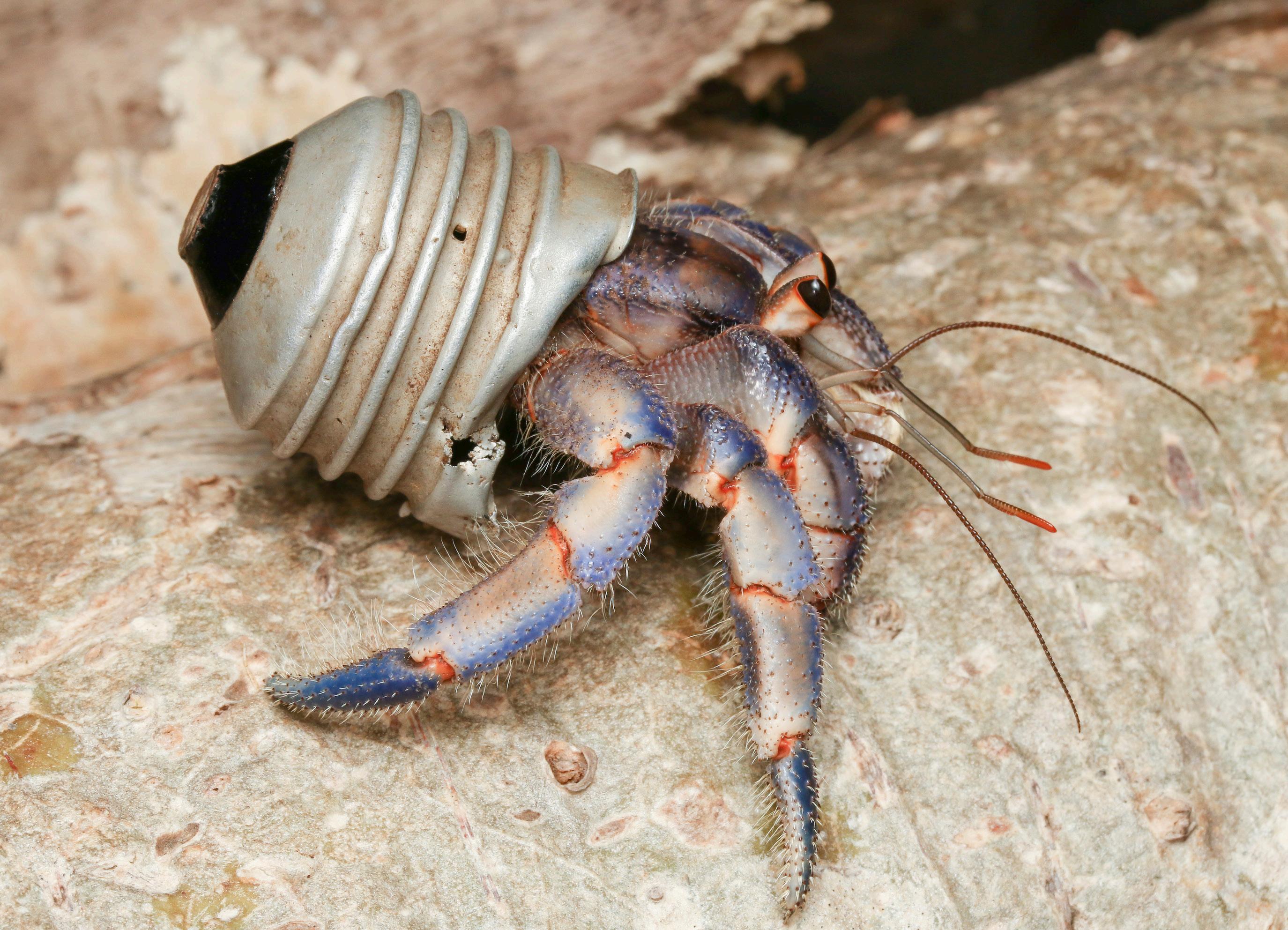
Everyone will have by now seen the recent posts hitting social media featuring the stunning photography of hermit crabs inhabiting some rather unusual real estate… our broken up plastic waste!
At first glance, we are impressed with the artful images by photographer Shawn Miller of these gorgeous hermit crabs strutting around in their fashionable new shapes and colours. Only then does it dawn on us that these photos are yet more evidence that we continue to destroy our natural world with our plague of plastics. When does it end?
Scientists Zuzanna Jagiello and Marta Szulkin from the University of Warsaw and Łukasz Dylewski from Poznań University conducted a thorough investigation by analysing all the images they could find posted on social media of hermit crabs with artificial protective makeshift shelling.
According to their report, “Plastic is the most pervasive element of marine waste, with many harmful impacts on wildlife. By using iEcology (i.e. internet Ecology, using online data sources as a new tool in ecological research), scientists reported on the emergence of a novel behaviour in hermit crabs related to the use
of plastic or other anthropogenic materials as protective shells.”
Unbeknownst to us, “10 of the world’s 16 terrestrial hermit crabs now use artificial shells, a behaviour observed on all of the Earth’s tropical coasts.” They identified 386 individuals – 84.5% of those were using plastic bottle caps. There are also instances of crabs using broken necks of glass bottles or metal ends of light bulbs, but they don’t make up any way near as much as plastics do, nor are they as contaminating and destructive.
The team discovered four reasons which may drive individual choice for artificial shells: sexual signalling, lightness of artificial shells, odour cues, and camouflage in a polluted environment, but the research is ongoing. The team is currently looking for funding to facilitate the project further to investigate the crabs’ innovative behaviour in their natural environment.
It has become alarming that natural seashells are in such short supply, and our harmful (longterm) plastic alternatives have taken over the real estate market in the hermit crabs’ world all over the globe. Shell quality dictates a hermit crab’s fundamental quality of life, and could possibly affect their long-term evolutionary course.
You have to ask the question: Why are natural seashells in such decline to begin with?
Zuzanna Jagiello says, “The main reason for the seashell shortage is the biodiversity crisis and the global decline in mollusk populations. Probably, there aren’t enough shells for hermit crabs.”
With plastics making up 85% (UNEP, 2021) of the world’s marine pollution, there will undoubtedly be many more perverse discoveries of wildlife being forced to adapt to our environmental destruction. The question this group of scientists is asking, is how will more individual species react in the long run physically, physiologically, and behaviourally?
We’ve seen the countless reports on marine birds, turtles, whales and dolphins ingesting stomachs full of plastics, the entanglements leading to serious injuries and/or deaths. We now know we have micro plastics in our blood, our faeces, mothers’ breast milk, in our drinking water, and most recently, found in human lungs after a study discovered we inhale a credit card’s worth of microplastics per week. We consume it because it’s found in our soils, in turn in our vegetables; consumed by our seafood and livestock, and we now
58 DIVERS FOR THE ENVIRONMENT | MARCH 2024
FEATURES
Coenobita purpureus with artificial shell: light bulb fragment.

Another recent study from 2023 has now estimated that at least 171 trillion pieces of plastic are now floating in our oceans. In 2005, it was estimated at 16 trillion pieces. Experts are warning that the new figures could nearly triple by 2040 if no action is taken. The way things are still today, we are failing miserably!
The ocean covers over 70% of the planet’s surface. All 5 oceans are linked together, so no matter where we are in the world, we are all linked by ONE ocean. Coastlines are the hotspots for plastic pollution and marine fauna is affected the most.
We should have solved this global issue yesterday, and yet we don’t seem to have made any progress at all – yet we can’t give up or else it is already too late. The future of the planet concerns every single one of us. Today, we need to heal our planet once and for all so our next generation doesn’t have to pay the full price of our mistakes all by themselves. Why do we constantly procrastinate?
It’s important for us all to get out there and
observe nature, take a deep look into the environment and learn from being outdoors. Only by doing so will we want to nurture and protect it more than ever once we really feel it, see it, sense it, and hear it. We are all a part of it. We need to do better.
We should conduct clean-ups every time we see plastic pollution out in nature, as it has become all of our mess. It might not be our own rubbish we will pick up, but it is in our power to make that small difference and dispose of it properly before it breaks up into more microplastics and ends up in our ocean, and eventually in our own bodies. We are all paying the price of plastic pollution with our health; animals and humans.
DO YOUR PART:
Have any of you seen hermit crabs using artificial protective shells? If so, where in the world have you seen them? How many? What artificial materials have you seen used?
We can all take part in reporting sightings that have proven to be valuable to science by uploading images to the iNaturalist app and social media with relevant keywords and hashtags such as #shell, #shelter, #debris, #anthropogenic, #plastic, #waste, and #hermitcrab.
SCIENTIFIC SOURCE:
Science of the Total Environment
The Plastic Homes of Hermit Crabs in the Anthropocene by Zuzanna Jagiello, Łukasz Dylewski, Marta Szulki
https://bit.ly/3HFfc0C
PROJECT SUPPORT
The authors above are currently seeking funding to investigate the innovative behaviour of hermit crabs in their natural environment.
For more information, interested parties can visit the lab’s website: http://leem.cent.uw.edu.pl
REPORT ARTIFICAL SHELLS
Please share hermit crab photos (with or without plastic shells) on social media and through the iNaturalist app, as the data collected through these channels has proven to be valuable.
SHAWN MILLER
www.instagram.com/okinawanaturephotography
www.facebook.com/OkinawaNaturePhotography
https://okinawanaturephotography.com
59 MARCH 2024 | DIVERS FOR THE ENVIRONMENT
FEATURES
Coenobita purpureus with artificial shell: metal cap with a glass bottle fragment.
inhale it because it’s also in our air. Plastics will be the end of all!

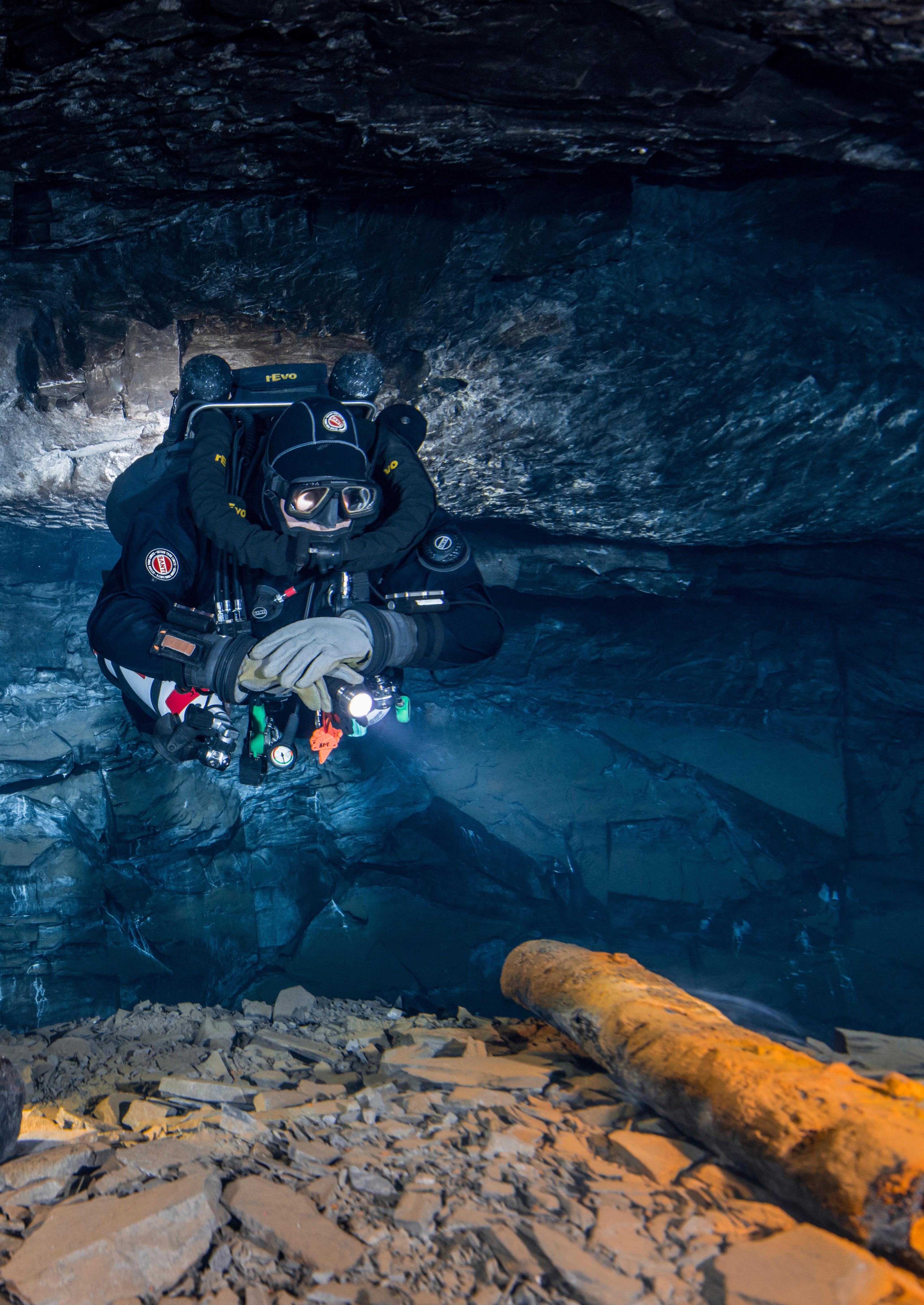
rEvo REVISTED
FEATURE PATRICK VAN HOESERLANDE PRODUCT PHOTOGRAPHY rEvo UNDERWATER PHOTOGRAPHY SUSANNE SCHMIDT
Quality, safety, and robustness comes first, and nothing less!

Over a year ago, I enjoyed the British documentary series, 'A Night on Earth' on Netflix. In it, the nocturnal lives of animals are followed with light-sensitive cameras, and above all, with a lot of patience. Nature documentaries are high on my list for sole TV nights, especially those about underwater fauna and flora. This series from 2020 is extra special because it tells a story that few have seen. In the episode 'Dark Seas', the camera crew dive at a remote, exotic reef to film mating rituals under a full moon. Suddenly, their brand of rebreathers caught my eye: rEvo. It’s not an unknown manufacturer to me, but it's been a while since my last visit with this brand.
Twelve years ago, I wrote an article on homemade rebreathers with a special focus on the build of the first rEvo by Paul Raymaekers. That was followed some seven years later with an interview. I ended that article on a positive note about rebreather diving and rEvo. Curious about the future of this top Belgian product, I wondered if I would ever return for another interview. So, 11 years later, I discovered via Netflix that the little company is still at the top of the rebreather market. It’s no surprise a professional camera crew would choose the best equipment available, especially for filming
a moment that only happens once a year. I sent a new e-mail requesting an interview following this, and I received a very prompt and positive reply.
Fortunately, the days of obligatory virtual interviews are over, and one late afternoon, I stepped out of the car, back in front of the building in Bruges where rEvo is homed. I had expected a large neon sign with a clear reference to their recent successes advertising something in the style of a diver and the word 'rEvo'. Nothing could be further from the truth, it was just a subtle billboard indicating rEvo's existence. The large, grey studio with 'Raytech' on it looked familiar. I stepped inside as if I knew it. When I asked for Pieter, a friendly employee directed me to an annexe.
Stepping into that building, I immediately knew I was in the right place.The birthplace of Belgian rebreathers had not changed much, but for a few things here and there. It looked just how I remembered it. The company had grown as more people on the shop floor spontaneously greeted me. There are currently five full-time members working in the production area. There is even room for a few more, but even in this industry, it is proving difficult to find new employees. Together, they assemble a few
a day. Besides the production of rebreathers, their maintenance also takes place in this room, and a major overhaul is done every five years to ensure their safe operation.
I was escorted to the office and test room, the innovation centre of this company, so to speak. With a cup of coffee in front of me, we started the interview, with Pieter, Matthias and Bram alternatively taking place. Although all three have a very thorough knowledge of the device and its production processes, their passions for certain aspects complement each other. Sometimes they challenged my knowledge of diving. Little by little, I got a clearer picture of what was happening here.
Since 2012, rEvo has outgrown the early days of the 'do-it-yourself' approach. Quality norms and standards have reassured the market that rebreather diving is no longer an eccentric activity. MARES had also observed this and so they wanted to complement the dwindling sports equipment market with more technical products in their gamma. The idea was to counterbalance sport hopping by offering more opportunities to progress. Their eye fell on rEvo because they offered a unique apparatus with proven design capabilities. MARES wanted to market its
62 DIVERS FOR THE ENVIRONMENT | MARCH 2024 FEATURES
ABOVE: Breathing can be simulated on the Ansti machine and all kinds of R&D tests can be performed. TOP RIGHT: Devices ready to be delivered to future rebreather divers.
BOTTOM RIGHT: BOV 6 – The rEvo BOV (Bail Out Valve).

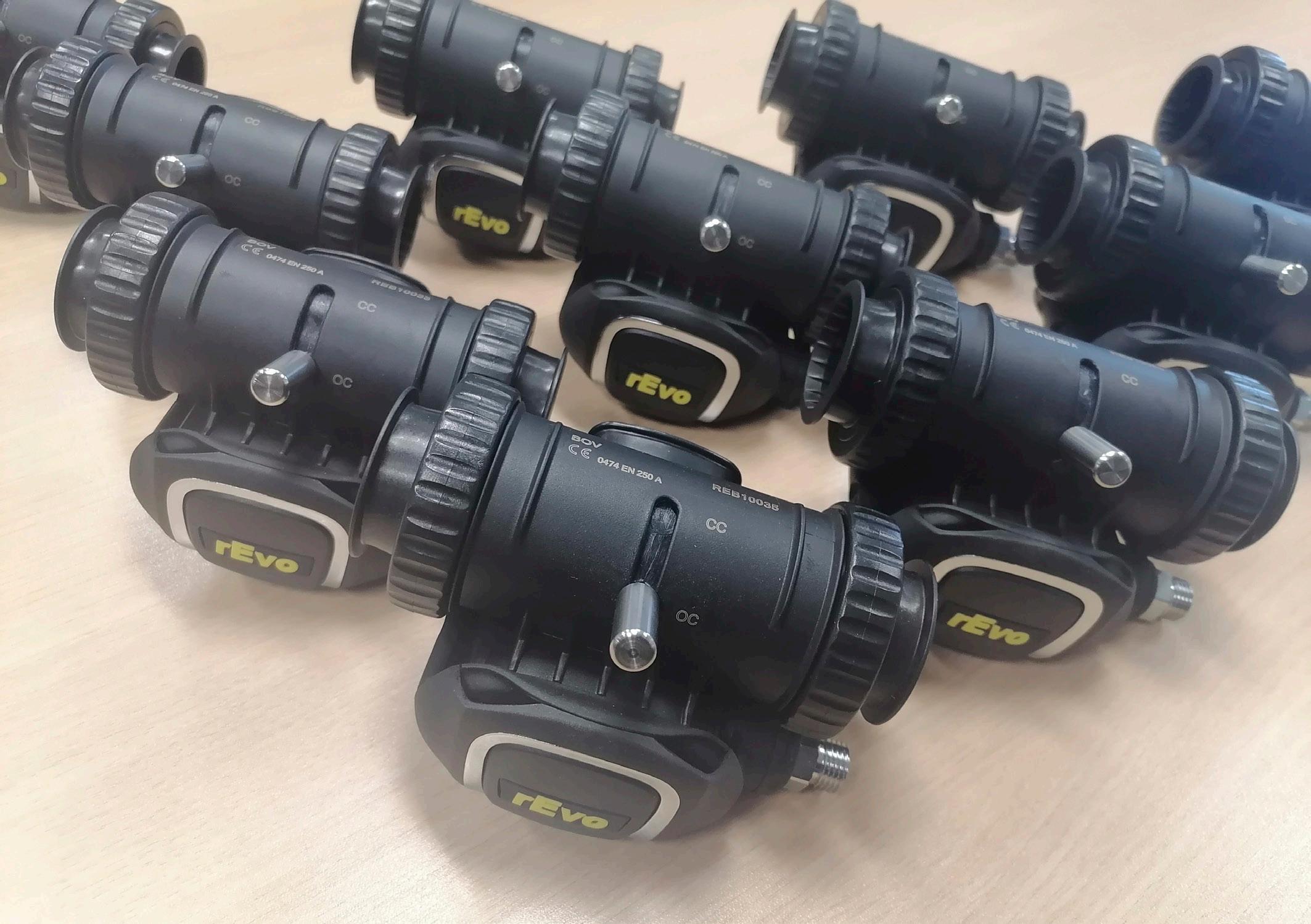
63 MARCH 2024 | DIVERS FOR THE ENVIRONMENT
FEATURES

own 'recreational' rebreather but lacked the necessary development expertise. Its testing capacity was also an added advantage and, of course, its knowledge of the standards.
To stay innovative as a company, you occasionally have to push your boundaries and start colouring outside your current pattern of thinking. It is therefore no coincidence that in 2015, around about the same time as MARES was surveying the market, the idea of developing a new type of rebreather gained a foothold at rEvo. This travel-friendly model should represent a sort of intermediate step from recreational to technical diving, at about a third of the price of a rEvo. There was also a need to build a global network to sell and support the successful, extended closed circuit rebreather (CCR) market.
On the 1st of July 2016, the acquisition of rEvo by the brand MARES was announced worldwide. The two had found each other. rEvo could rely on MARES’ network and the first brought in the expertise to develop a recreational rebreather. The production of certain components (harness, wing, breathing hoses, regulators, etc) was shifted from external suppliers to the MARES group. This collaboration also led to the production of a semi-closed circuit rebreather (SCR), the Horizon SCR Rebreather. An article on the difference between the Horizon SCR and the CCR rEvo will appear later.
Unlike the rEvo, which is controlled by a Canadian-built Shearwater computer, the
Horizon uses a MARES-built 'controller'. Officially, the design phase started in early 2016 and development led to the first prototype in 2018. The model received the CE mark at the end of 2019. From then on, the Horizon could be commercialised within the EU.
Development of the rEvo is not standing still either, although there are currently no concrete plans to release a rEvo 4. Nevertheless, they are busy experimenting and testing and monitor innovations in the market to collect ideas for further development. In addition, they continue to work with the platform of the rEvo 3. Indeed, the rebreather is modular, allowing for continuous modifications and improvement of modules without the need to design an entirely new device.The company's philosophy eschews selling cosmetic modifications as a new model. Quality, safety, and robustness comes first, and nothing less. Unlike other manufacturers, a new colour or casing does not mean a new model.
The high safety of both SCR and CCR is the result of the combination of a deliberate design-out with a layered safety strategy. The design-out approach ensures that no mistakes can be made during production and maintenance. The company philosophy of keeping the preparation of the device before and the care after a dive simply for the user, plays an important role in this. The diver operates the unit knowledgeably and, in terms of electronics, there is full redundancy.
Various alarms inform the diver of risky states that require intervention. To respond properly
to these, you have the pillar of 'educate in'.This means that before you are allowed to dive with a rEvo, you must have at least taken rEvo's curriculum. These courses are offered by a world-renowned instructor network. Applying simplicity in the design does not mean that diving with the rEvo is easy, it remains a highly technical device. The duration of the course depends on the depth you want to reach. The basic course lasts 5 days and includes modules in which you learn how the rebreather works, how to maintain it, how to run through the checklist before and after the dive, and how to react in different conditions during a minimum of 480 minutes of training in the water.
As an open-circuit diver, I can only listen with fascination to these specialists' explanations. The level of technicality sometimes goes beyond the story I am writing now, but it fascinates me. Diving with the rEvo must be challenging. The amount of info to digest must be overwhelming. For example, you are presented with the partial pressure of oxygen from the three sensors, what do you do if they are all different? What if they differ from the value on your backup monitor? Isn't there a danger of 'task overload'? That is clearly a question that one can only answer when diving with it (after proper training).
I also wonder what a 'recreational' rebreather will look like. Especially when I study the rEvo in front of me. How can you make something like this simpler and still ensure safety? Are you also curious about this manufacturer's recreational rebreather? More on this in my next article.
64 DIVERS FOR THE ENVIRONMENT | MARCH 2024 FEATURES
OPPOSITE PAGE TOP L-R: Breathing loop with ppO2 monitor and HUD; DSV loop 2 – The rEvo DSV (Diver-Surface valve); MAV 3 – The MAV (Manual addition valve) allows the diver to add the desired gas into the counter lungs of the rEvo.



FEATURES

THE EVOLUTION OF THE REVO REBREATHER
• rEvo Alfa (2003): the first rebreather built as a test model, mainly from the conversion of existing rebreathers such as the Dräger Ray.
• rEvo Beta: this is the original DIY test model of which only five were built to test them for 18 months. The model has too few ‘water inlets’ in the housing, but still incorporates several concepts, such as the double scrubber, which are still part of rEvo’s DNA. Of the rEvo Beta, there are still a few functioning models maintained regularly. The development of the Alfa and Beta brought the necessary knowledge and insights to arrive at today’s comfortable, well-functioning rebreather.
• rEvo 2 (2007): an improved, commercial version of which 200 were built for the US market. At that time, rebreathers in Europe were rare.
• rEvo 3 (2009): the current model with improvements in design and breathing comfort. This model achieved the CE certification.
• Micro-rEvo (2011): a lighter, smaller version of the standard rEvo 3 with the same breathing comfort but more travel-friendly.
• DiveCan/ rMs (2012): the ‘rEvo Monitoring System’ monitors the functioning of the breathing lime and provides an estimate of the remaining scrubber time. This unique concept is optional.
• rEvo MilSpec (2014): Development of a MilSpec (Military Specifications) version that meets the requirements for military use.
• rEvo BOV (2019): The ‘Bail Out Valve’, a valve on the mouthpiece that allows for quickly switching to the emergency air supply.
65 MARCH 2024 | DIVERS FOR THE ENVIRONMENT
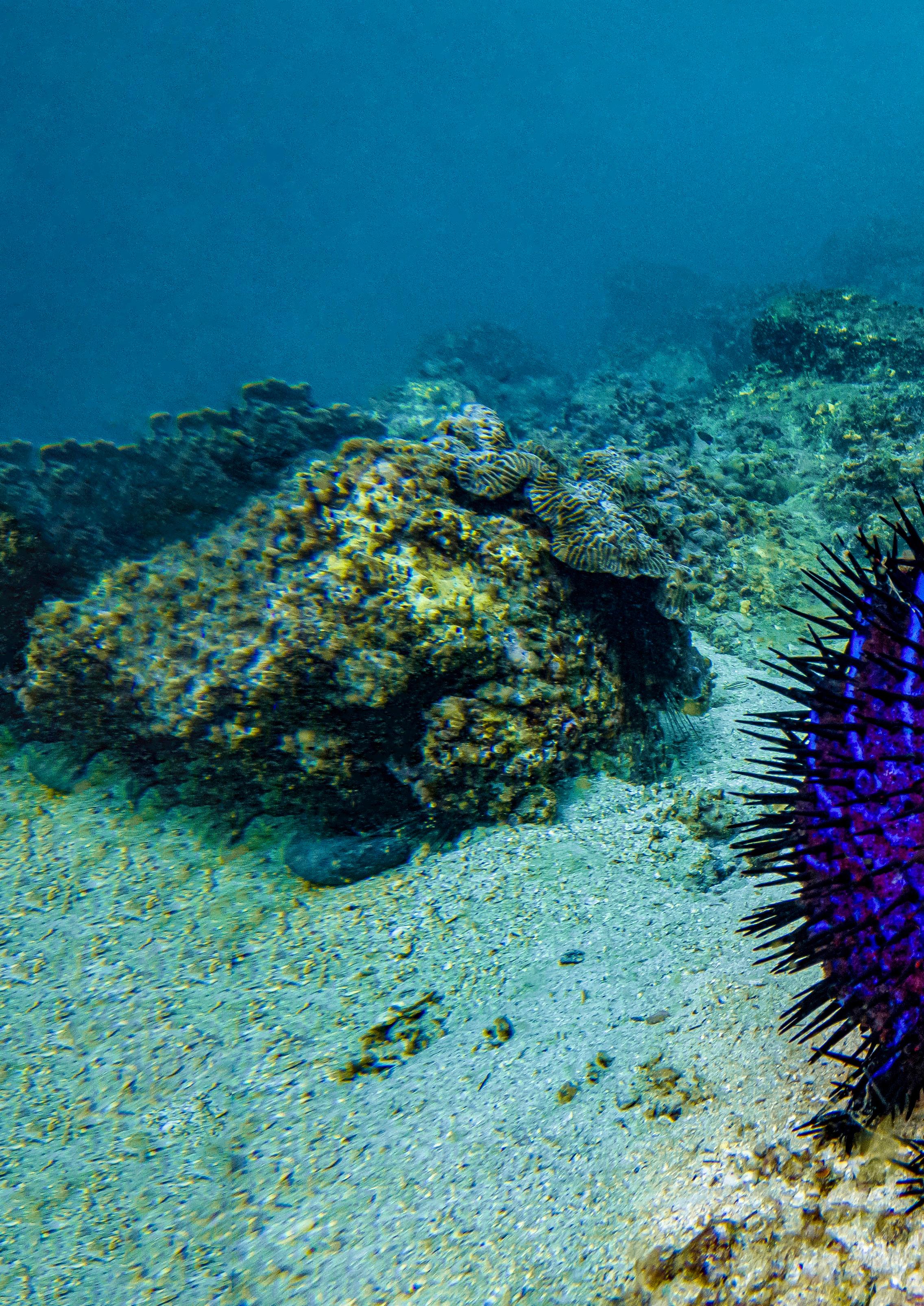
CROWN-OF-THORNS OUTBREAK RESEARCH
A THREAT TO CORAL REEFS OFF THE EAST COAST OF THE UAE?
FEATURE DR HENRIK STAHL: COLLEGE OF MARINE SCIENCE AND AQUATIC BIOLOGY – UNIVERSITY OF KHORFAKKAN PHOTOGRAPHY ALLY LANDES
Together, with proactive conservation efforts and ongoing monitoring, we can work towards mitigating the impacts of CoTS outbreaks and preserving the beauty and biodiversity of our coral reefs for future generations. We encourage divers to report any CoTS sightings to relevant authorities or research organisations to support ongoing monitoring and conservation initiatives in the region.
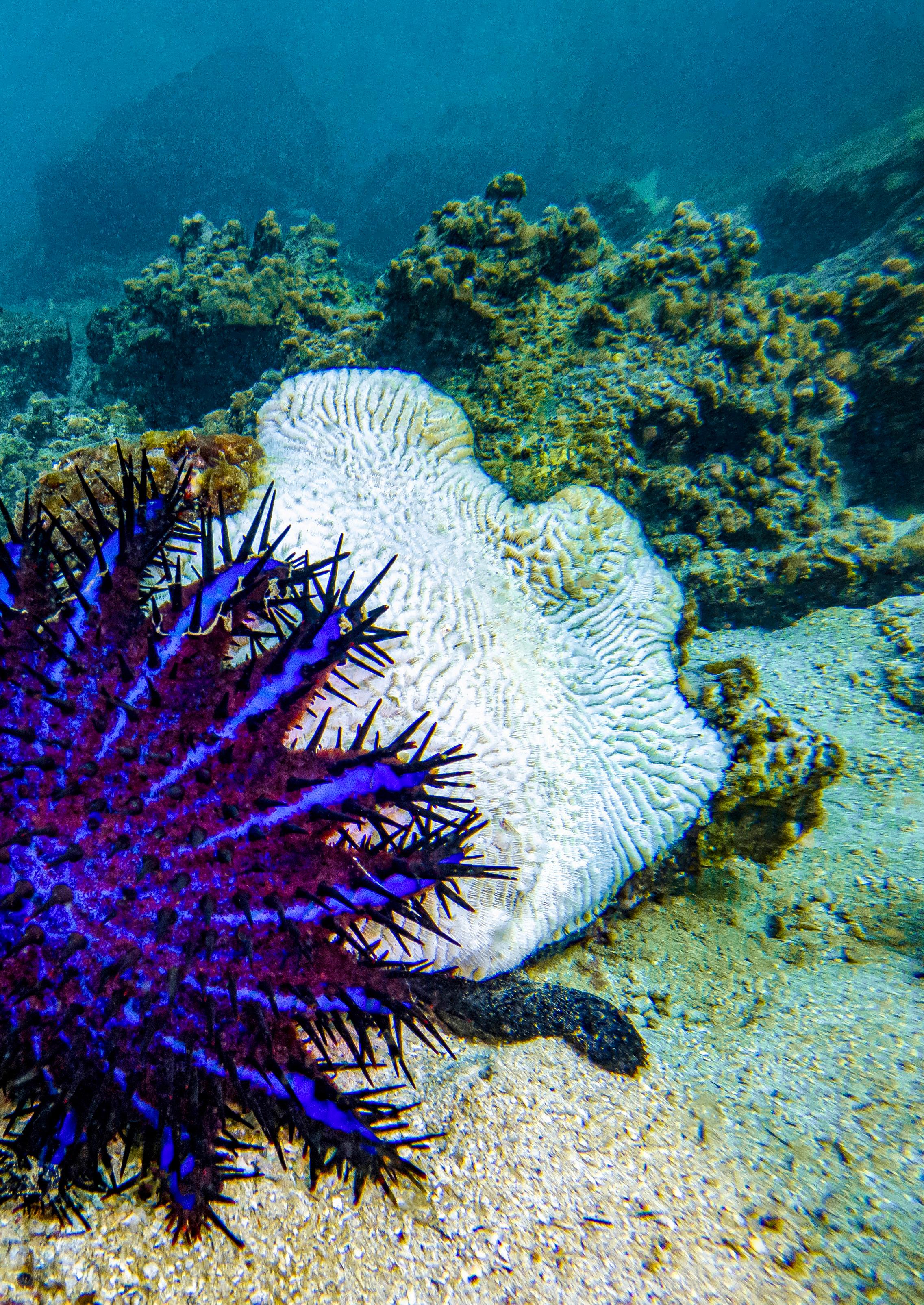


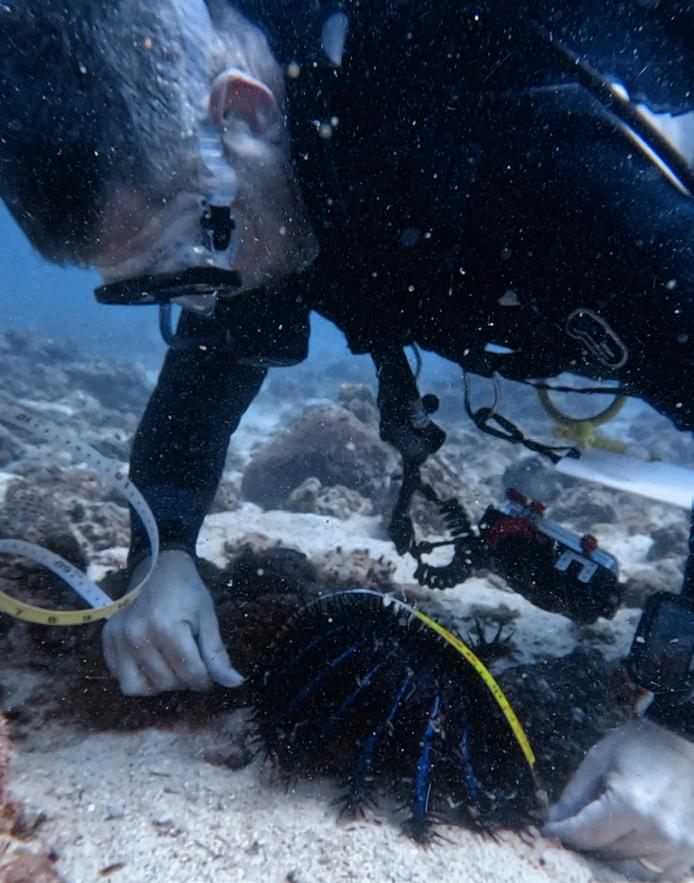
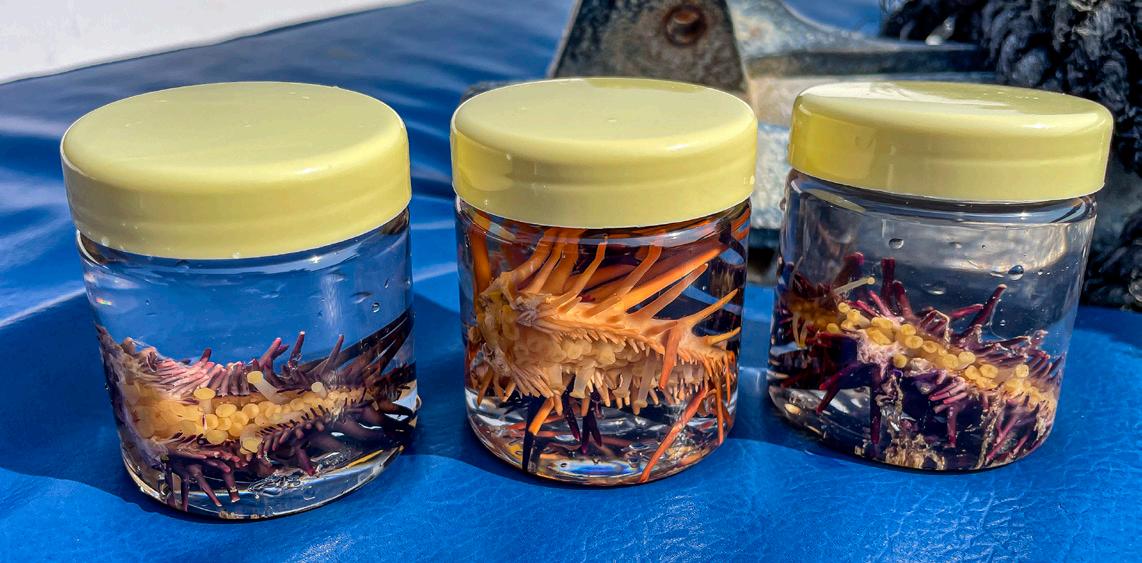
Coral reefs, often referred to as the "rainforests of the sea," are diverse and vibrant ecosystems that provide crucial habitats for marine life and offer essential services to coastal communities. However, these delicate ecosystems face numerous threats, including climate change, pollution, and overfishing. Among these threats is also the Crown-ofThorns Starfish, a voracious corallivorous predator that can devastate coral reefs if its population is left unchecked.
Crown-of-Thorns Starfish (CoTS), scientifically known as Acanthaster planci, are one of the largest starfish in the world, characterised by their numerous venomous spines and their ability to consume large amounts of coral tissue. Whilst CoTS can play a natural role in reef ecosystems

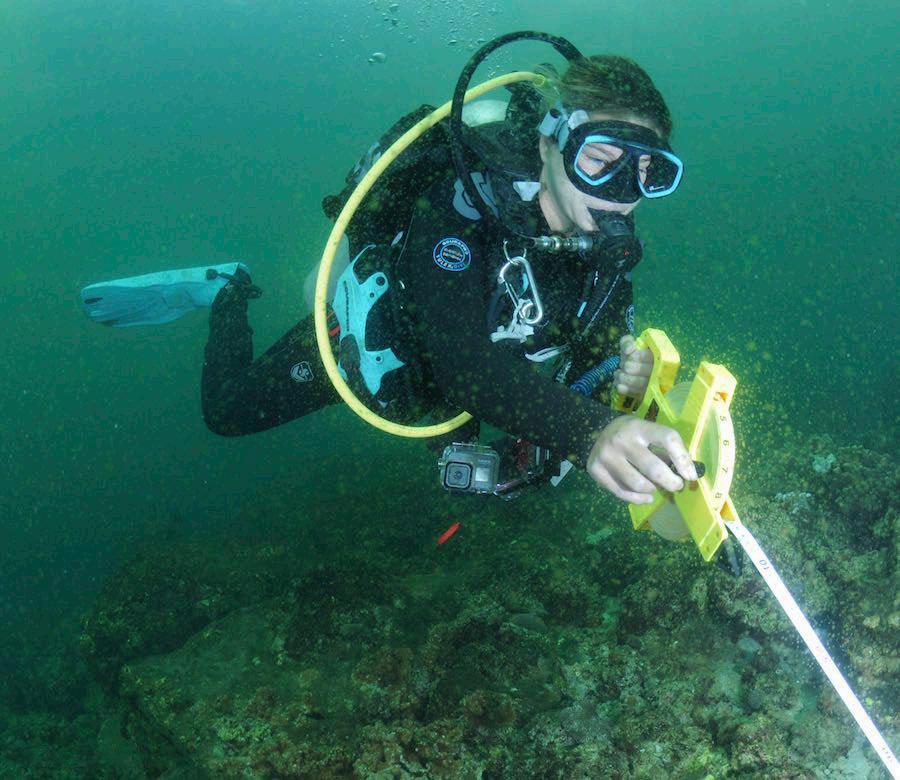
by controlling coral growth, outbreaks of these starfish can have severe consequences for coral reefs, leading to extensive coral mortality and habitat degradation.
An adult CoTS has the capacity to devour approximately 10 square metres of coral annually. Similar to other starfish species, they employ a unique feeding method where they extend their stomach out through their mouth, enveloping their coral prey. Through the secretion of digestive enzymes, they break down the coral tissue into a substance resembling a coral soup, leaving behind the bare white skeleton of the coral.
In a recent survey conducted off the east coast of the United Arab Emirates

(Khorfakkan, UAE), concerns were raised about a potential localised outbreak of CoTS threatening the health of coral reefs in the area. Led by Dr Henrik Stahl from the College of Marine Science and Aquatic Biology (University of Khorfakkan), in collaboration with members of the Emirates Diving Association (EDA), the survey aimed to assess the abundance of CoTS at two dive sites located near Khorfakkan: Martini Bay and Hole-in-The-Wall.
The survey revealed alarming findings, with 70 CoTS observed over an area of 2,250 square metres at Martini Bay, and 16 CoTS observed over an area of 2,550 square metres at Hole-in-The-Wall. These densities of CoTS, particularly at Martini Bay, suggest
68 DIVERS FOR THE ENVIRONMENT | MARCH 2024
FEATURES
Photo by Felipe Morales
Photo by Felipe Morales
Photo by Gordon T. Smith
Photo by Gordon T. Smith
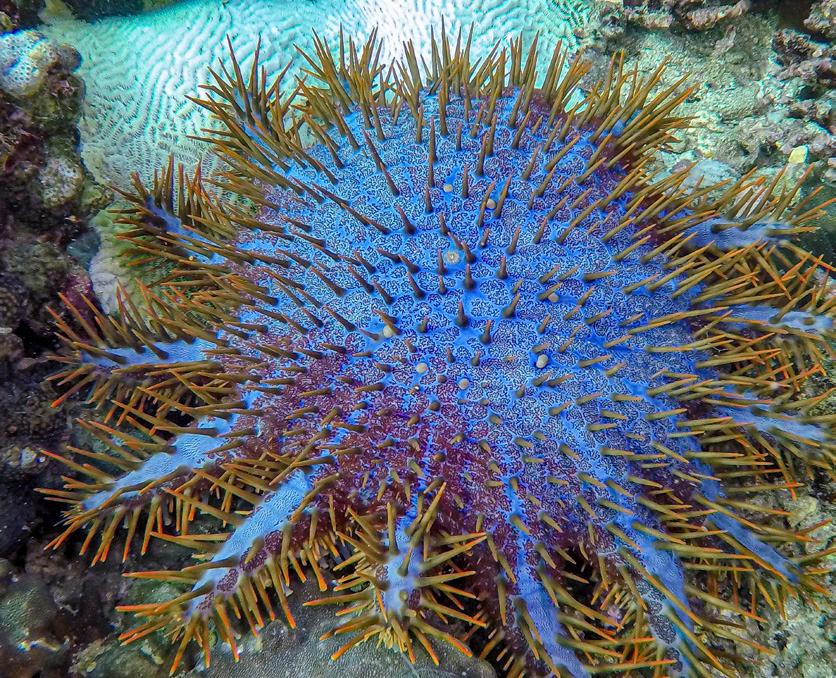

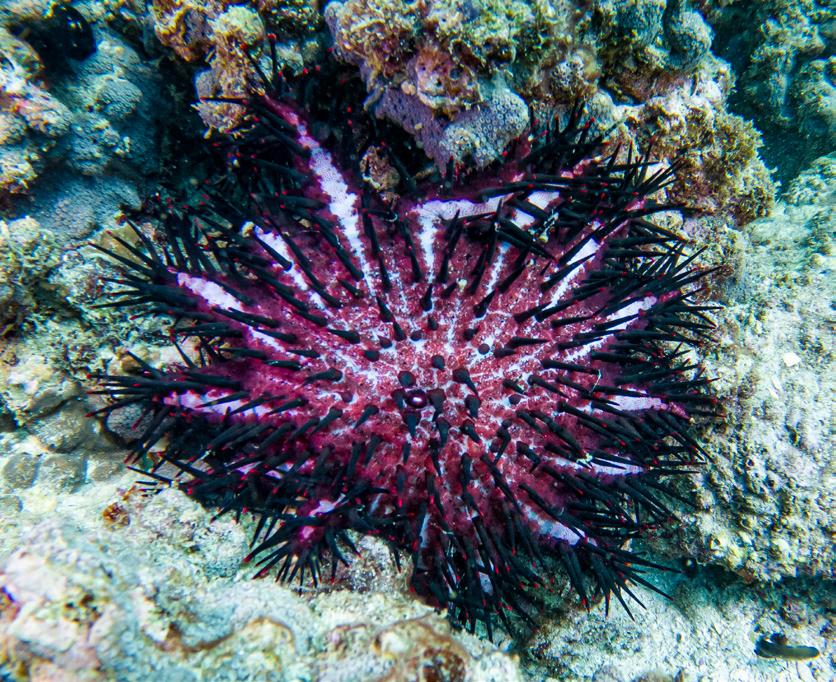
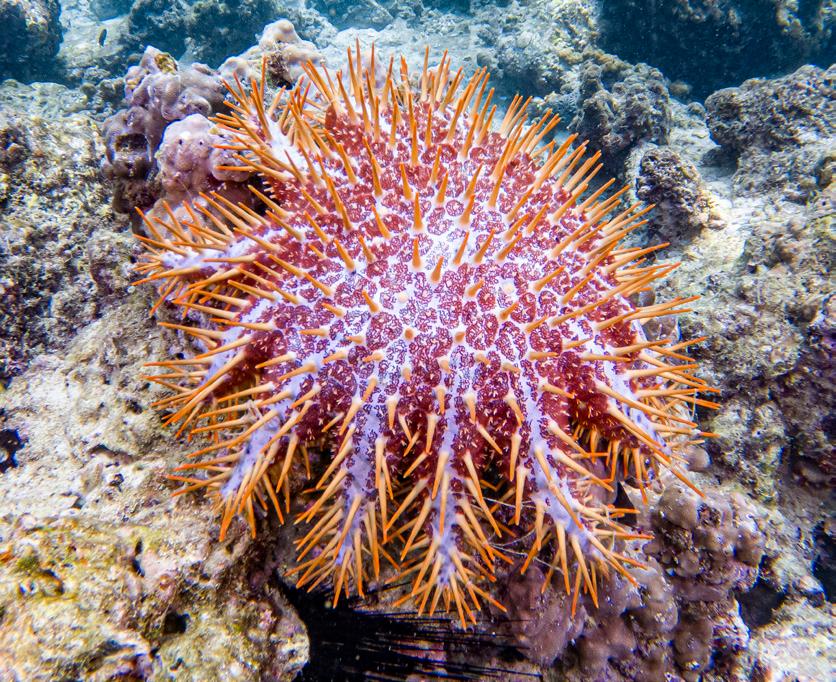
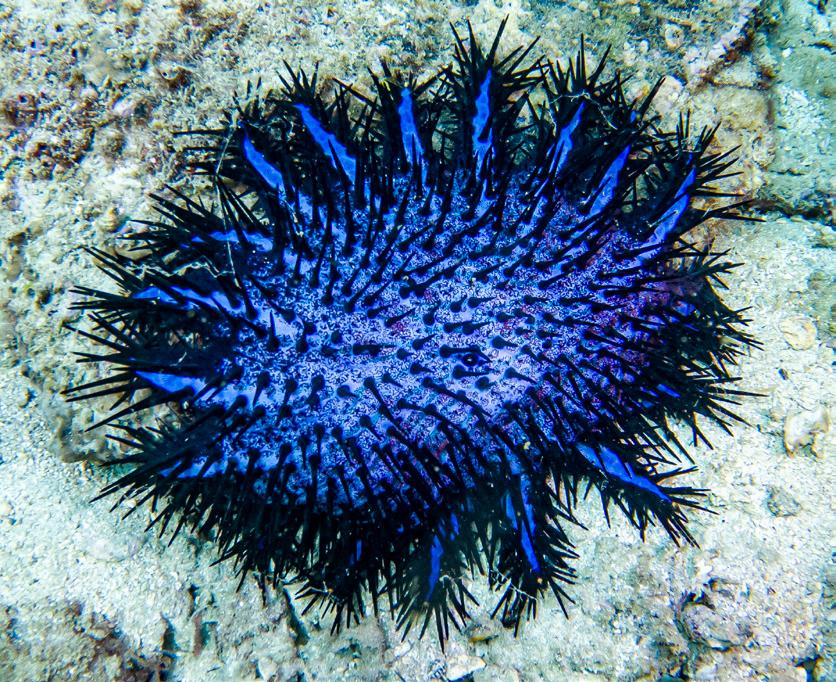
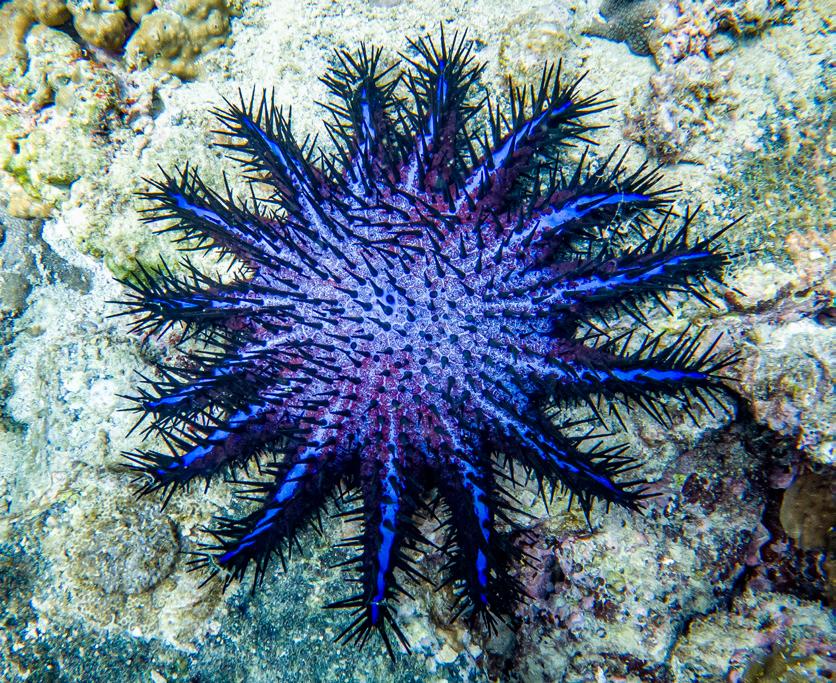
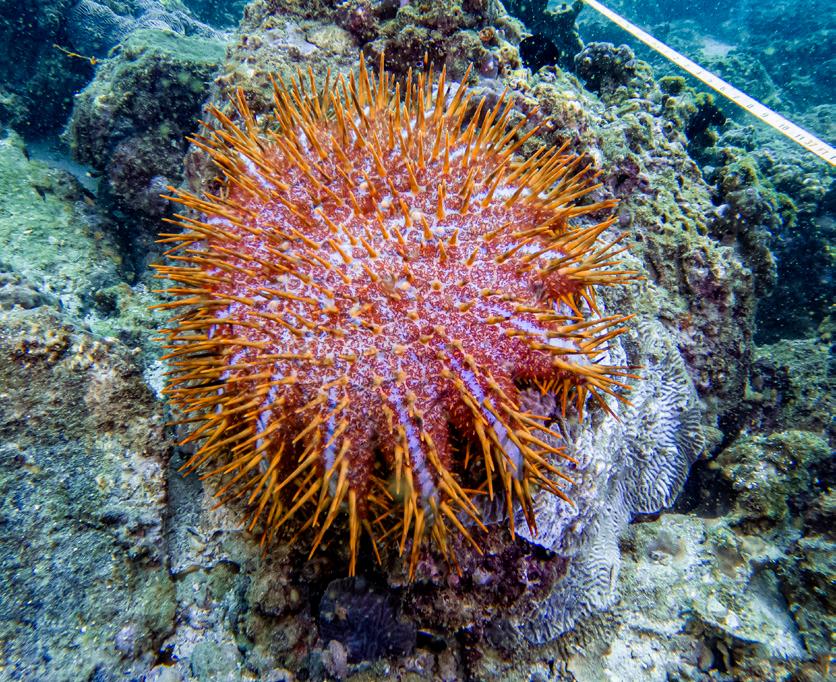

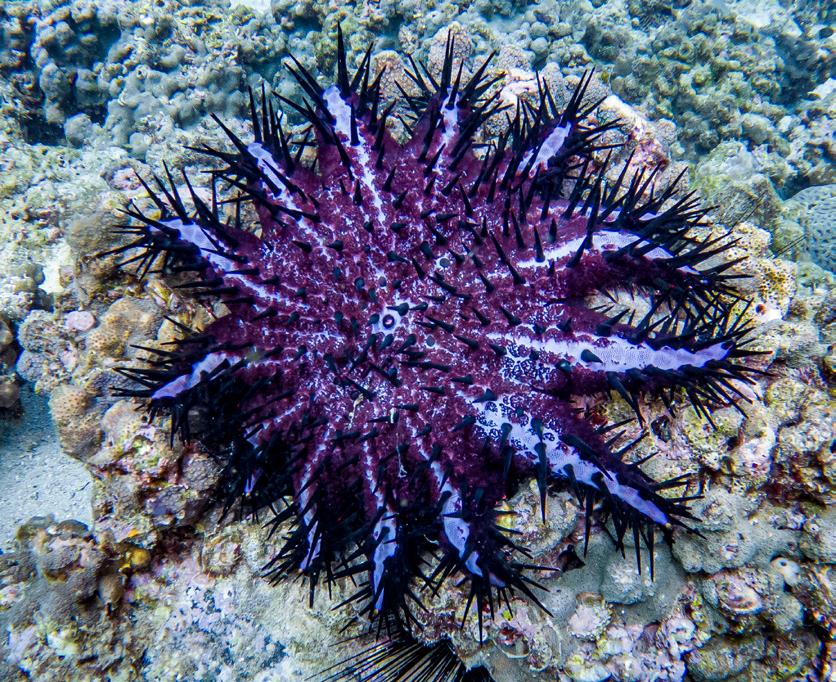
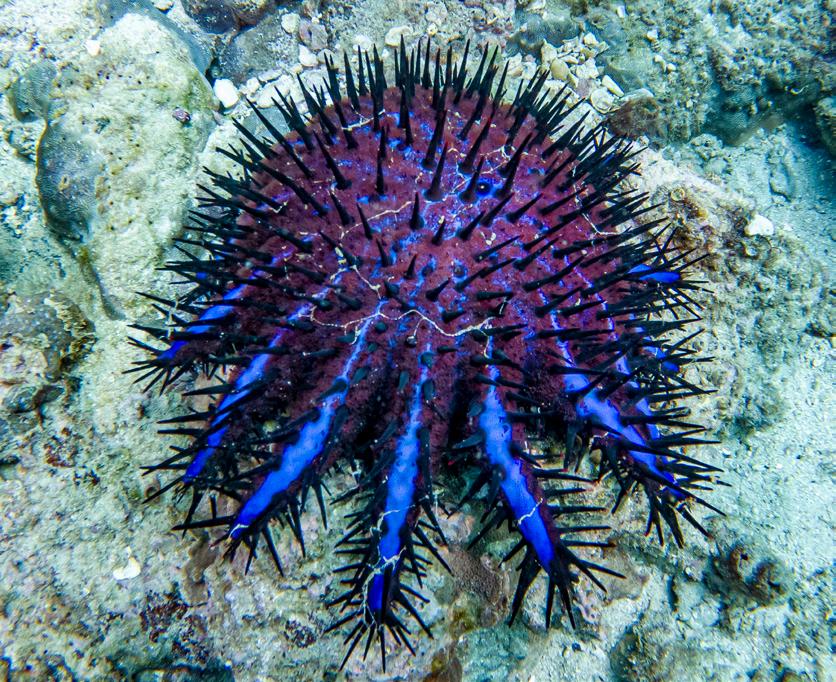
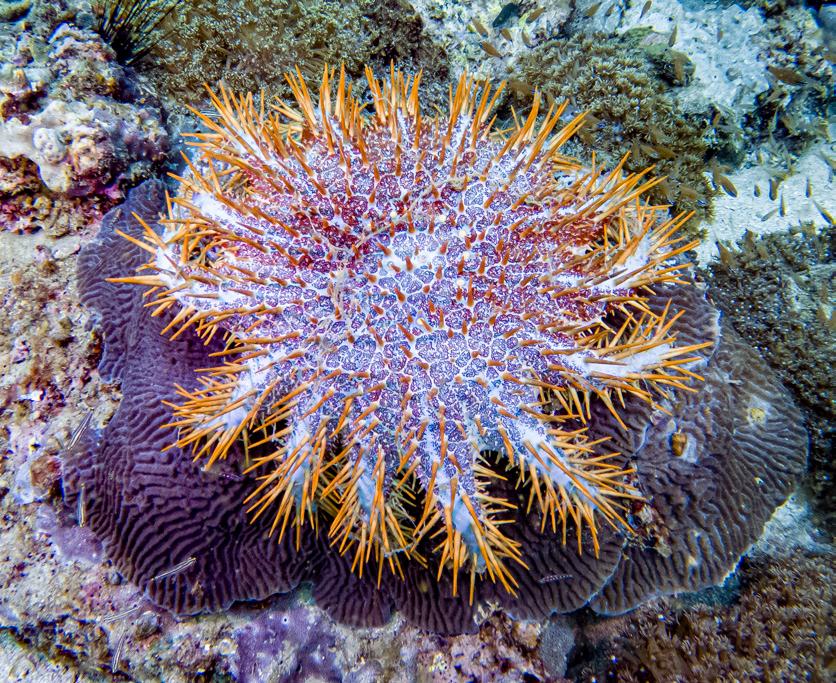

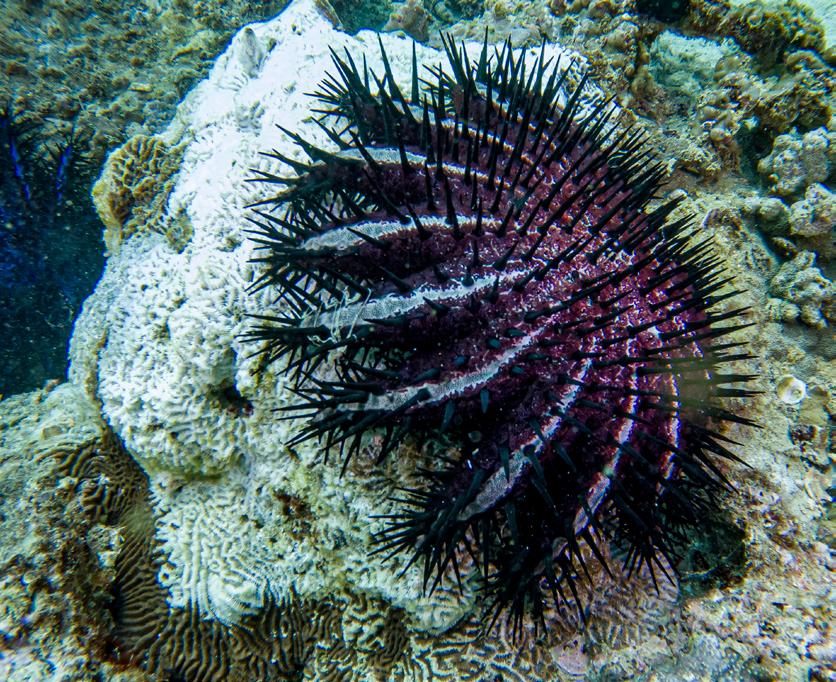


MARCH 2024 |
FEATURES


FEATURES
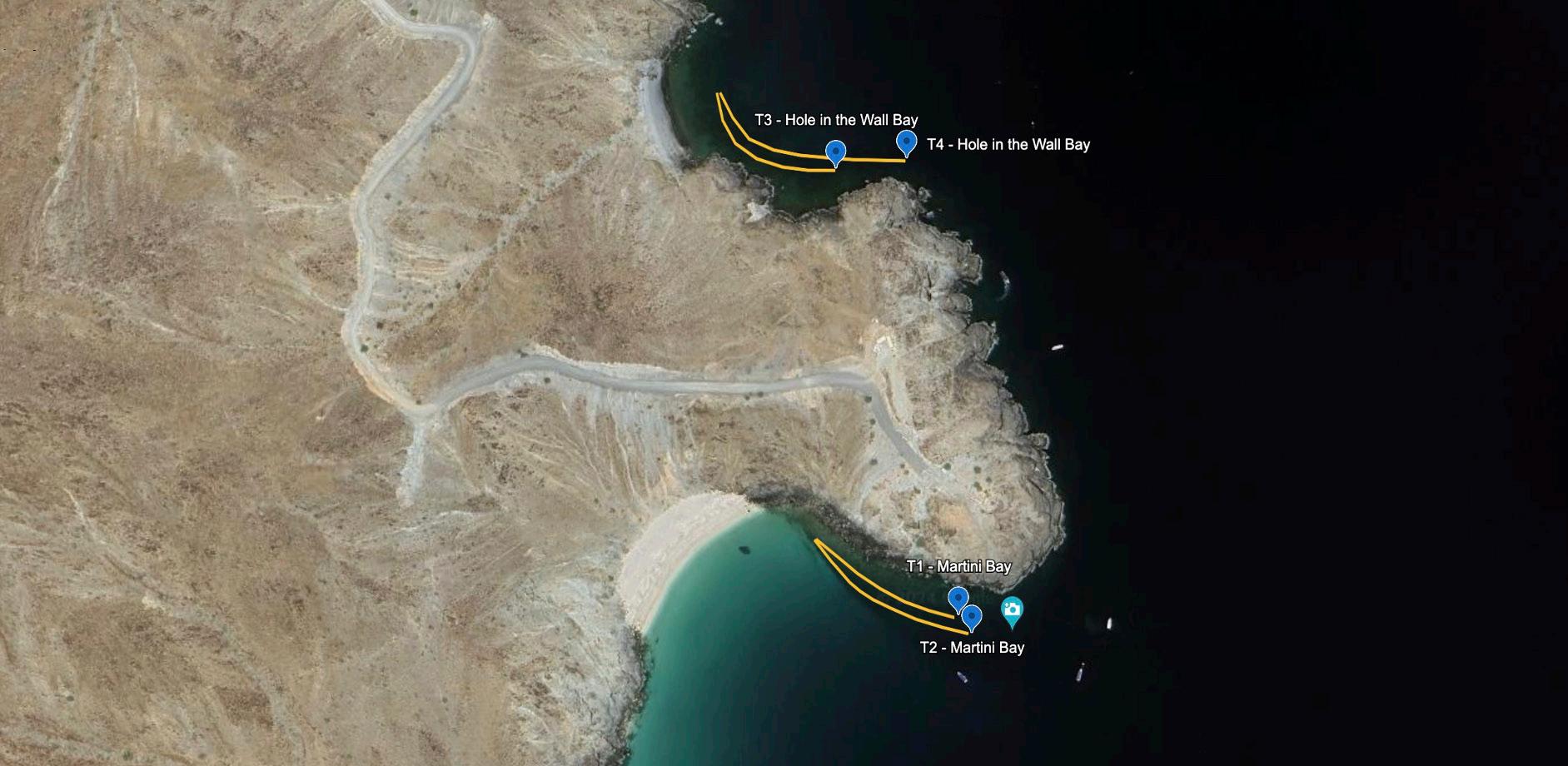
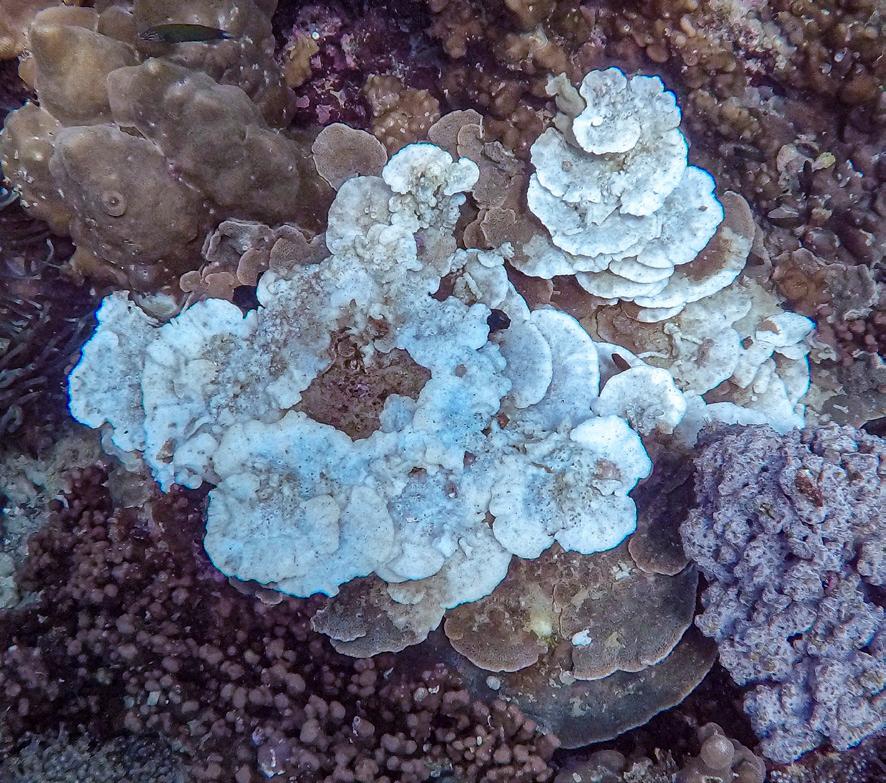
the presence of a localised outbreak of CoTS, posing a significant threat to the coral population in this area. Divers participating in the survey reported observing a significant number of white coral skeletons at Martini Bay, often with a CoTS attached to it, further indicating the potential detrimental impacts of CoTS to this site.
Exactly what has caused this outbreak is difficult to tell at this point, but it is known from other sites in the world that CoTS typically undergo cyclic population dynamics, with periods of growth and decline influenced by environmental and biological interactions. For example, nutrient rich surface waters may fuel algal blooms, providing abundant food for CoTS larvae. Overfishing of natural predators may disrupt the ecological balance, allowing CoTS populations to increase unchecked. Coral reef degradation weakens coral defences, making them more vulnerable to CoTS predation, and changes in oceanographic conditions may influence larval dispersal and settlement patterns. Understanding and addressing

these factors are essential for managing and mitigating the impacts of CoTS outbreaks on coral reef ecosystems.
To address the threat posed by this particular CoTS outbreak, the survey team recommends culling of CoTS at the surveyed dive sites, a technique that has been used successfully on other reefs around the world facing the same threat. However, before any intervention can take place, the team is actively seeking permission from the appropriate authorities to ensure compliance with conservation regulations and protocols.
In conclusion, the recent survey highlights the urgent need to address the threat of a localised CoTS outbreak off the east coast of the UAE. The collaboration between Dr Henrik Stahl and the Emirates Diving Association underscores the importance of scientific research and community engagement in safeguarding the health and resilience of coral reef ecosystems, and the contributions of the voluntary divers from the Emirates Diving
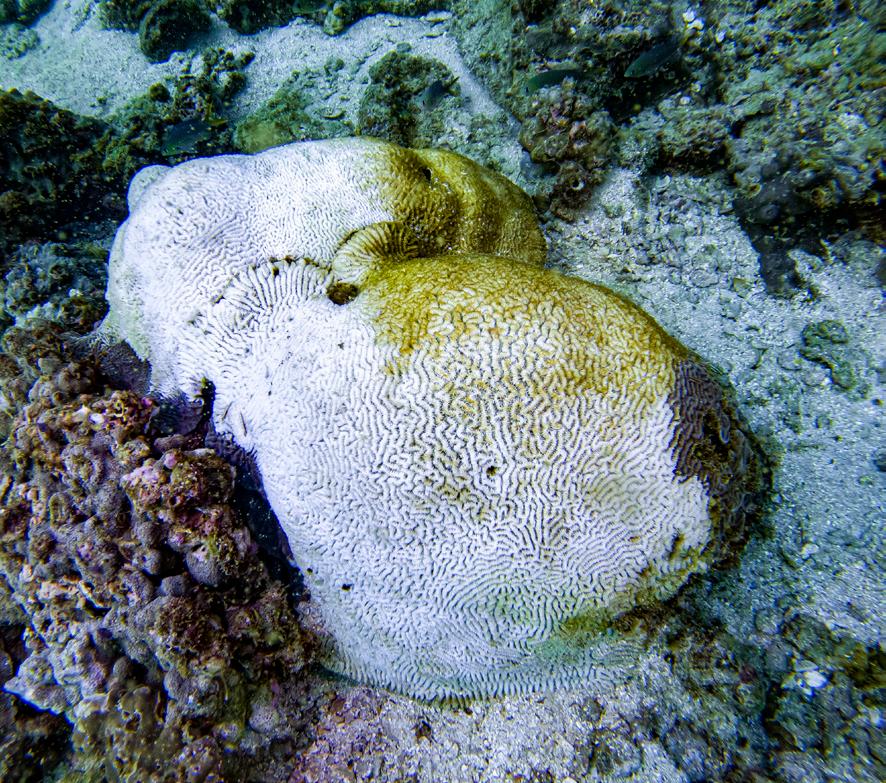
Association are gratefully acknowledged for their invaluable assistance and efforts in conducting these surveys.
Together, with proactive conservation efforts and ongoing monitoring, we can work towards mitigating the impacts of CoTS outbreaks and preserving the beauty and biodiversity of our coral reefs for future generations. We encourage divers to report any CoTS sightings to relevant authorities or research organisations to support ongoing monitoring and conservation initiatives in the region.
A BIG THANK YOU
We would like to give a big shout out to Barracuda Diving Centre and Divers Down for the support in assisting us to curry out these important surveys.
And a big thank you to the first survey’s EDA team: Gordon T. Smith, Chloe King, and Vickie Langton, and to the second survey’s EDA team: Felipe Morales, Tony Sidgwick, and Rania Shawki Mostafa. To a job well done!
71 MARCH 2024 | DIVERS FOR THE ENVIRONMENT FEATURES


PROBING THE DEPTHS:
NYU ABU DHABI COLLABORATES WITH OCEANX FOR MARINE RESEARCH ON THE UAE’S COASTS
FEATURE PENTTI R., RIVOIRA B., AMIN S., BURT J., PAPARELLA F. PHOTOGRAPHY OCEANX
The OceanXplorer expeditions have unveiled a wealth of new information about the UAE’s marine ecosystems. These discoveries not only enhance our understanding of local environments, but also contribute to global knowledge, aiding in sustainable ocean management and conservation efforts.
The Remotely Operated Vehicle (ROV).
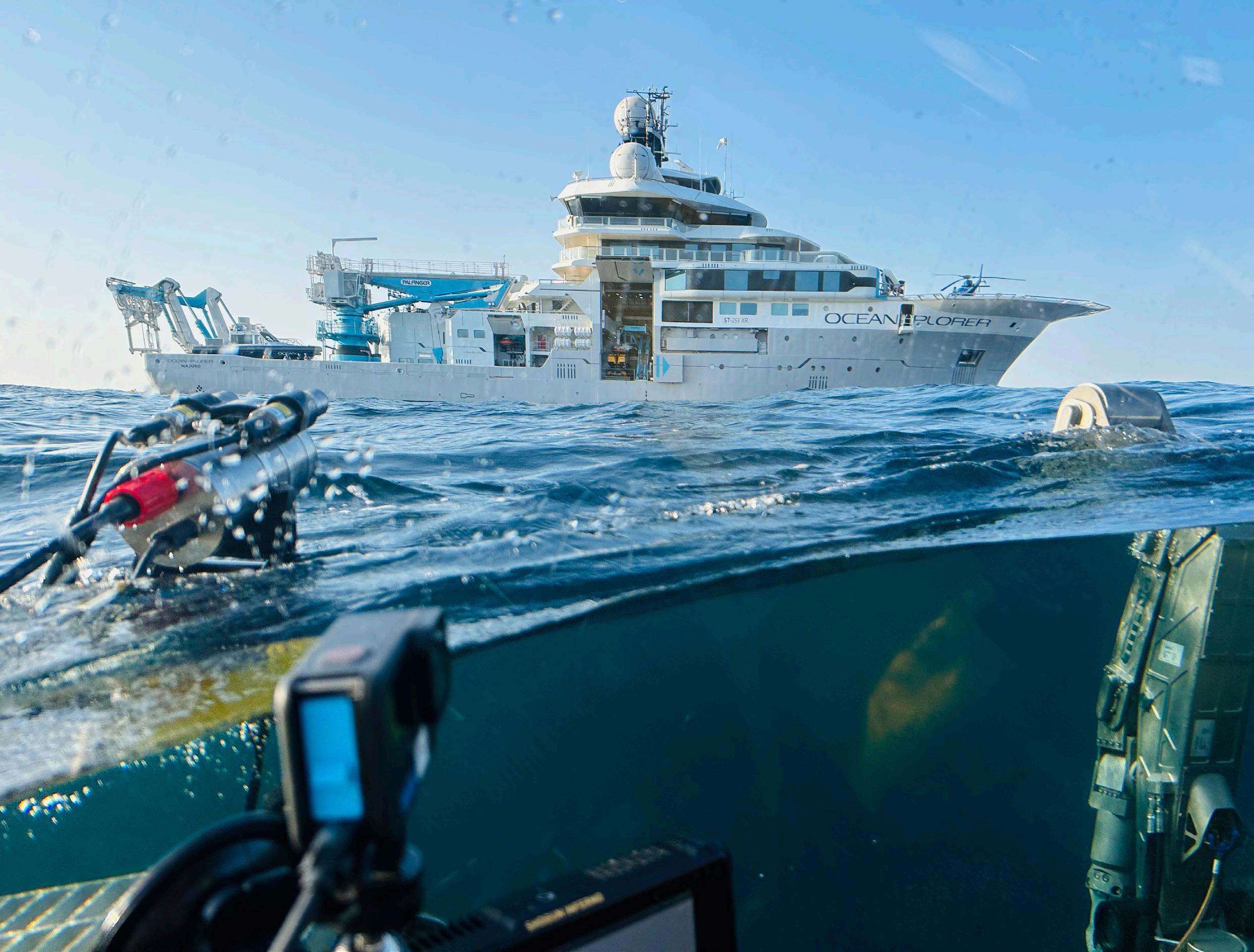
Late in 2023, selected groups from the marine science community of the UAE embarked on a groundbreaking collaboration onboard the OceanXplorer, a renowned oceanographic vessel, to conduct research in the UAE’s waters. The vessel was visiting the Arabian Gulf in anticipation of COP28 and provided an exciting opportunity for scientific exploration. OceanX, a programme of Dalio Philanthropies, uses this vessel with its state-of-the-art technology to support research and bring the findings to the world via captivating media. Three projects led by New York University Abu Dhabi (NYUAD) research teams from NYUAD’s Mubadala ACCESS Centre were selected from proposals, each aiming to uncover the secrets of the region's marine ecosystems. The work of NYUAD’s research teams onboard the OceanXplorer has yielded exciting initial discoveries.
NYUAD’s first survey took place within Abu Dhabi’s waters, and focused on the biogeochemistry and microbiome of the Arabian Gulf – the hottest body of water on Earth. Despite its significance in the
context of climate change, this region's biogeochemistry is poorly understood due to a lack of observational data. Recent research has suggested a trend of increasing hypoxia (low oxygen) in the central Gulf, where oxygen concentrations are detrimentally low for most marine organisms. The cause of this phenomenon is unknown. To address these knowledge gaps, the Mubadala Arabian Centre for Climate and Environmental Sciences (Mubadala ACCESS), the leading research group specialising in the climate and environment of the Arabian Peninsula and the Gulf region, joined the OceanXplorer for UAE Mission 1 in November 2023.
NYUAD’s objectives for the UAE Mission 1 were twofold. Firstly, the project aimed to shed light on the microbiology that comprises the base of the food web in the Gulf and how it functions in such extreme conditions. This effort would, for the first time, characterise the pelagic microbial composition of the Arabian Gulf, determining the dominant groups of primary producers that influence fisheries and coral reefs. Secondly, the project aimed
to determine the cause of seasonal hypoxia in the centre of the Gulf and whether microbial activity may be responsible for its occurrence. Researching these aspects is crucial for understanding the extent of hypoxia in the Gulf, its potential trajectory as temperatures rise and what this entails to the circulation and the biology of the Gulf.
Methods employed during UAE Mission 1 included the use of an instrument called the McLane Pump to simultaneous size-fractionate and filter large volumes of water for DNA/ RNA and metabolite extractions across several depths.Water samples were also collected with the onboard rosette across various depths for nutrient analyses, and opportunistic sediment grabs were conducted at sites of interest using the ship’s Argus Remotely Operated Vehicle (ROV). The ship’s onboard profiling instrument was used to conduct vertical profiles of temperature, salinity (conductivity), dissolved oxygen, chlorophyll and turbidity to support observations.
Sample extractions and bioinformatics analysis
74 DIVERS FOR THE ENVIRONMENT | MARCH 2024 FEATURES
ABOVE: Descending below the surface in the manned submersible.


from UAE Mission 1 are currently underway and will require several months to complete. The samples will be used to map out what organisms are there, how active they are and what chemical products they tend to produce under extreme heat. The nutrient concentration and budgets in the gulf will be mapped for the first time to define potential effects of nutrient limitations on marine life. This information will be helpful for governmental agencies and their activities relating to fisheries as these microbes are the foundation of fish populations. Characterising the microbial populations, particularly primary producers like phytoplankton, in some of the hottest temperatures on Earth will appeal to international scientists as it may resemble how other populations across the globe will behave as the planet warms.
NYUAD’s second survey on OceanXplorer focused on deep-water mesophotic reefs of Fujairah and the hydrodynamics of the Gulf of Oman. The mesophotic zone, located between brightly lit shallow waters and the dark 150 metre depths of the ocean where
little light penetrates, is a largely unexplored region in the UAE. The Gulf of Oman also has a complex hydrography due to the seasonal monsoon patterns, and it is largely unexplored.
NYUAD’s objectives for the UAE Mission 2 in December 2023 were to conduct the firstever on-site surveys of mesophotic corals along the Fujairah coast of the UAE in the Gulf of Oman, and to collect data with the onboard profiling instrument that would provide valuable information on how environmental factors affect mesophotic habitats and their species composition. The mission utilised OceanXplorer's unique capabilities, including manned submersibles, remotely operated vehicles, and acoustic mapping sonar, to explore these uncharted depths.
In total, 86 specimens of mesophotic corals, including species of scleractinians (hard corals), octocorals (soft corals), and black corals were collected in situ by OceanX’s manned and unmanned vehicles. Although overall coral diversity was limited, the taxa collected were the dominant corals across all sites surveyed.

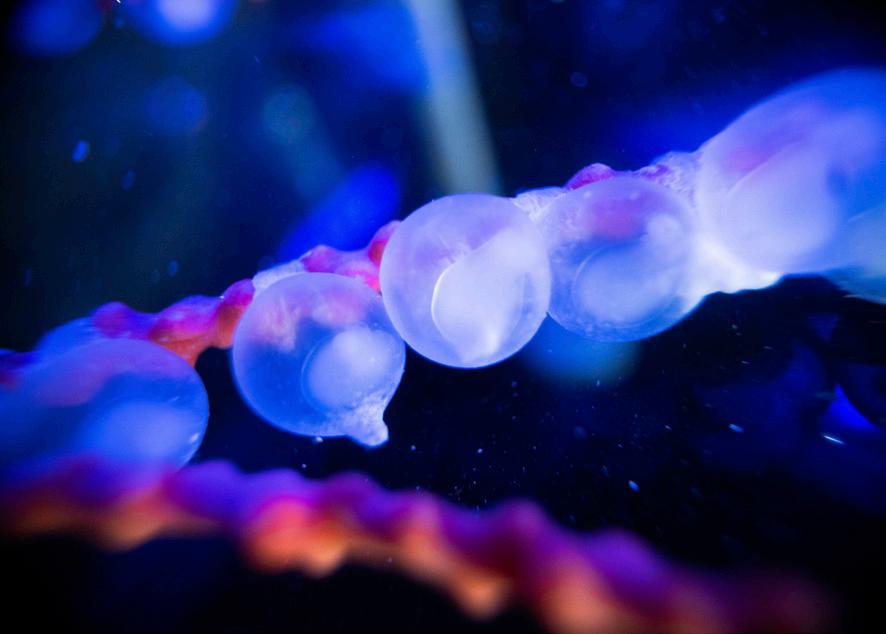
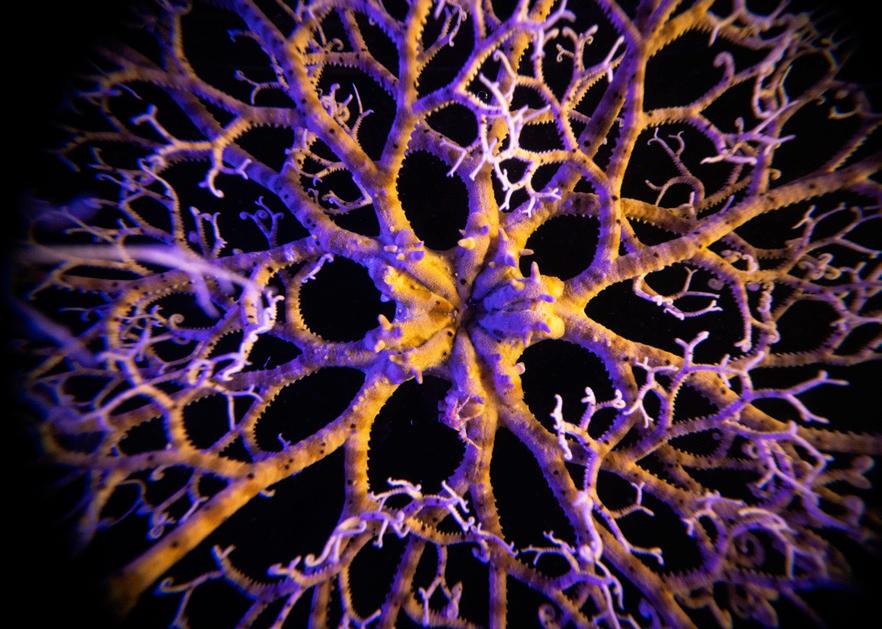
Therefore, a number of these corals are likely to be locally adapted to this environment, and very likely some are endemic populations that only occur in the UAE. As a general observation, coral colony size was typically small (<30cm) across all taxa. This may be due to growth limitation as a result of environmental factors (variable temperature, low oxygen, limited food/energy), or it may be a result of young age due to recent diebacks (e.g. a possible recent asphyxiation due to lack of oxygen). Overall, 26 non-coral invertebrate specimens (e.g. crabs, starfish, etc) that occurred at our survey sites were also collected for identification. All samples will be catalogued and archived in museum collections for posterity, available for future researchers to access.
Findings from the mesophotic reefs survey revealed several new coral records for the UAE and the Arabian Sea, with some likely to be new to science. All octocorals (soft corals and gorgonians) species and genera found at our survey sites are new records for the UAE with several soft coral groups found at
75 MARCH 2024 | DIVERS FOR THE ENVIRONMENT
CLOCKWORK L-R: Octocoral (Dendronephthya); Sea Urchin (Prinocidaris); Cuttlefish egg, attached to a branch of gorgonia; A Basket Star (Euryalida); and the Long-headed Spiny Lobster (Justitia longimana).
FEATURES

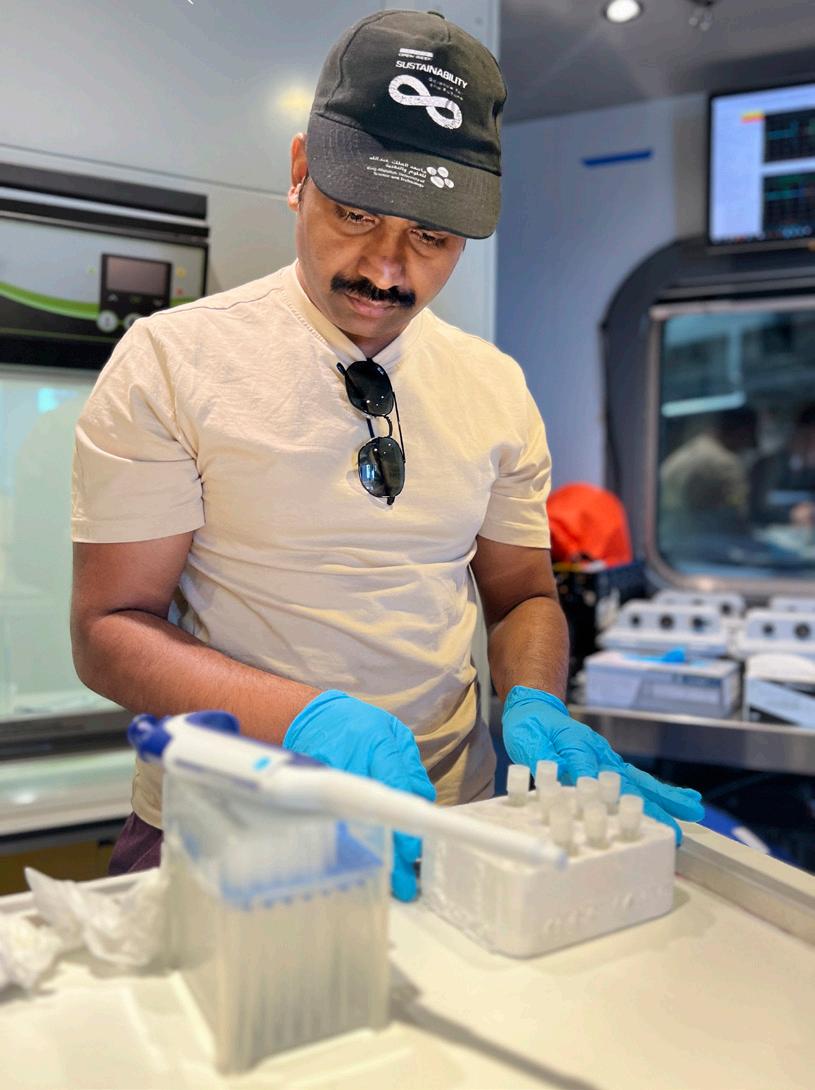

our surveyed sites being new records for the entire Arabian Sea. All scleractinians (hard corals) collected are new records for the UAE waters, and almost 90% are new records for the Arabian Sea. It is very likely that 1-2 hard coral species and several soft coral species collected are endemic and/or new to science. This will be confirmed after additional morphological and molecular analyses.
The vertical profiles conducted using the onboard CTD profiler also revealed interesting initial findings. CTD stands for Conductivity, Temperature and Depth, where temperature is measured directly with precision temperature sensors, salinity is measured indirectly by measuring the
electrical conductivity of the water and depth is measured indirectly by measuring pressure. The objective of the project was the study of the hydrodynamics of the basin with particular attention to the formation of deep currents, the analysis of the low oxygen levels found at depth, and identifying the Arabian Gulf outflow (the current of warm and salty water that comes out of the deepest part of Hormuz, and should follow the continental slope of the coast of Oman). The casts conducted during UAE Mission 2 in offshore waters of Fujairah, UAE, highlighted the presence of a spike in salinity and temperature between 130 and 220m. This spike could be the signature of the Arabian Gulf outflow. The CTD data is currently being further analysed and it will
likely provide valuable information on how environmental factors (Dissolved Oxygen, salinity, etc.) affect mesophotic habitats and their species composition in the Gulf of Oman.
NYUAD also engaged in other aspects of the larger mission (e.g. subsea geological sampling). During these events, the teams were involved in several other important events such as the first observation of Bramble Shark (Echinorhinus brucus) for the United Arab Emirates (including multiple observations in both submersibles and the ROV). The team also observed fossilised mangrove root casts. These were found in a submarine valley between 130 and 217 metres depths, and can provide important information on the location
76 DIVERS FOR THE ENVIRONMENT | MARCH 2024
FEATURES
TOP ROW: Setting up the McLane Pump; Processing samples from the McLane Pump. BOTTOM IMAGE: The Bramble Shark (Echinorhinus brucus).
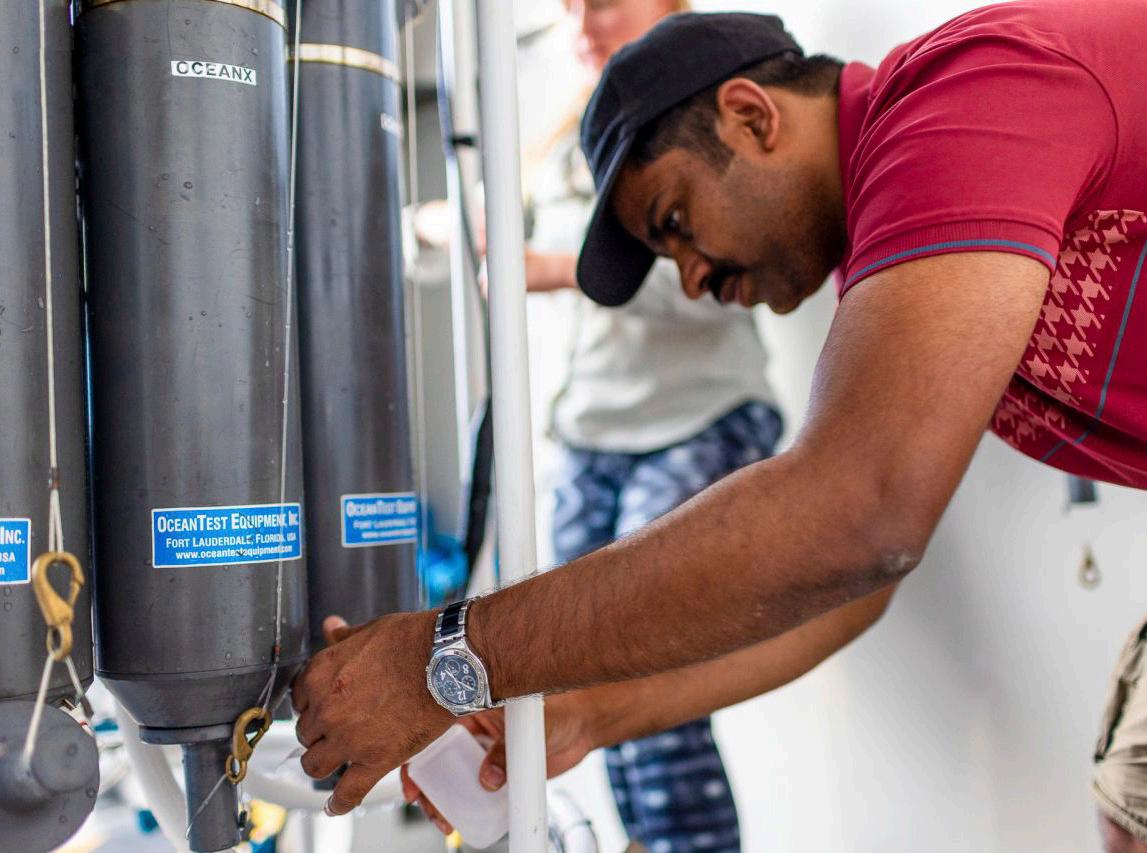
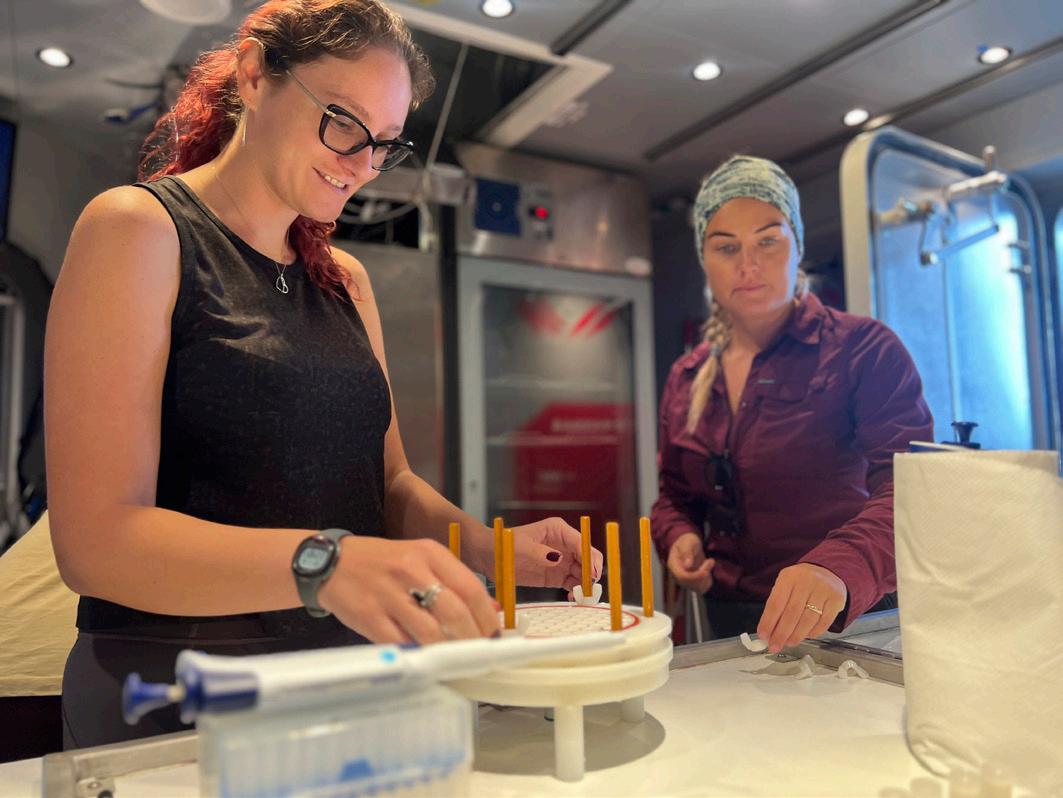

and depth of the coastline during the last ice age more than 18,000 years ago.
The discovery of new species and the observation of unique ecological phenomena highlight the importance of further exploration in these understudied regions. In every dive the NYUAD team came across new findings which suggest these organisms are distributed locally and in isolated microhabitats. Therefore, additional species will be expected with further explorations.
The collaboration between NYUAD and OceanX will not end here, as the Mubadala ACCESS Centre has recently received a grant from Dalio Philanthropies to support cutting-
edge climate research, including ways to increase coral resilience in a warming ocean. The $1 million USD grant will include two years of support for a project led by NYUAD biologist Dr John Burt that will explore the selection and crossbreeding of heat-resistant corals in the Arabian Gulf with heat-sensitive corals found elsewhere to produce climateresistant corals that can better withstand climate change. In initial experiments, Dr Burt’s team found that crossbreeding UAE corals with Indian Ocean corals can lead to 84% higher heat tolerance in hybrid offspring. OceanX and NYUAD are also exploring other collaborations, including innovative ocean education opportunities for NYUAD students and professors.
In conclusion, the OceanXplorer expeditions have unveiled a wealth of new information about the United Arab Emirates’ marine ecosystems.These discoveries not only enhance our understanding of local environments but also contribute to global knowledge, aiding in sustainable ocean management and conservation efforts.
As research continues, the mysteries of the UAE's waters are gradually being unveiled, paving the way for informed conservation and management strategies.The findings from these missions will be invaluable for governmental agencies and researchers worldwide, guiding efforts to protect and preserve these vital marine ecosystems for future generations.
77 MARCH 2024 | DIVERS FOR THE ENVIRONMENT
FEATURES
TOP ROW: Collecting water samples from the rosette; Disassembling the McLane Pump Filter Stack. BOTTOM IMAGE: The Remotely Operated Vehicle (ROV) Mission Control.
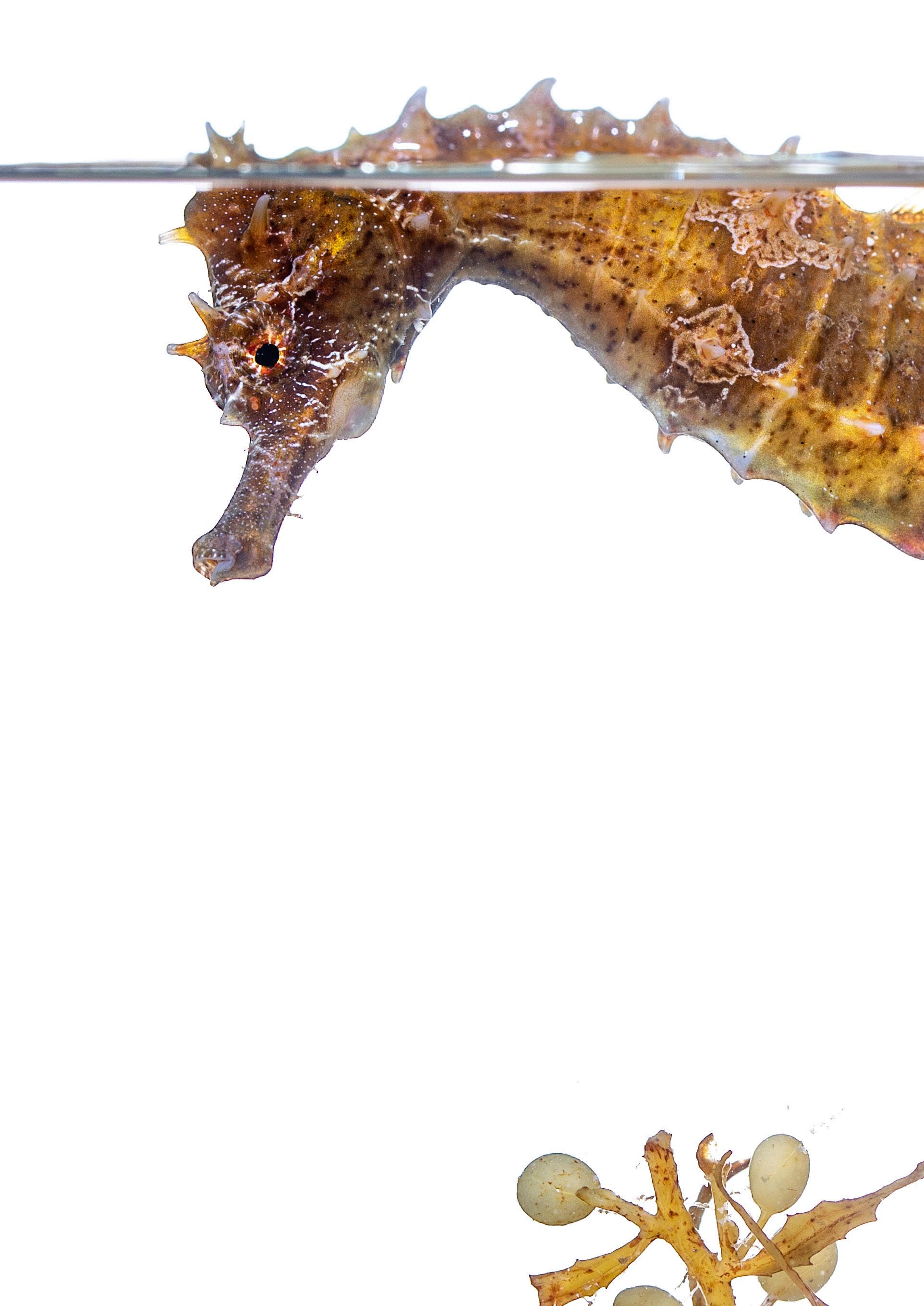
SAVING THE SARGASSO SEA
A MAJOR NEW PARTNERSHIP TO SUPPORT SCIENCEBASED
STEWARDSHIP
FEATURE TERESA MACKEY, PROGRAMME MANAGER, SARGASSO SEA COMMISSION
PHOTOGRAPHY JEAN-PIERRE ROUJA, AMBASSADOR, SARGASSO SEA COMMISSION
The Sargasso Sea, encompassing two million nautical square miles of the North Atlantic, is the only sea unconstrained by land. Instead, the shifting boundaries are formed by clockwise ocean currents. Aptly referred to as the “golden floating rainforest of the Atlantic,” this high seas ecosystem is comprised of floating Sargassum, which teems with life and shelters endangered and endemic species.
Lined seahorse (Hippocampus erectus) found in Sargassum (Sargassum fluitans) washed up on a Bermuda beach
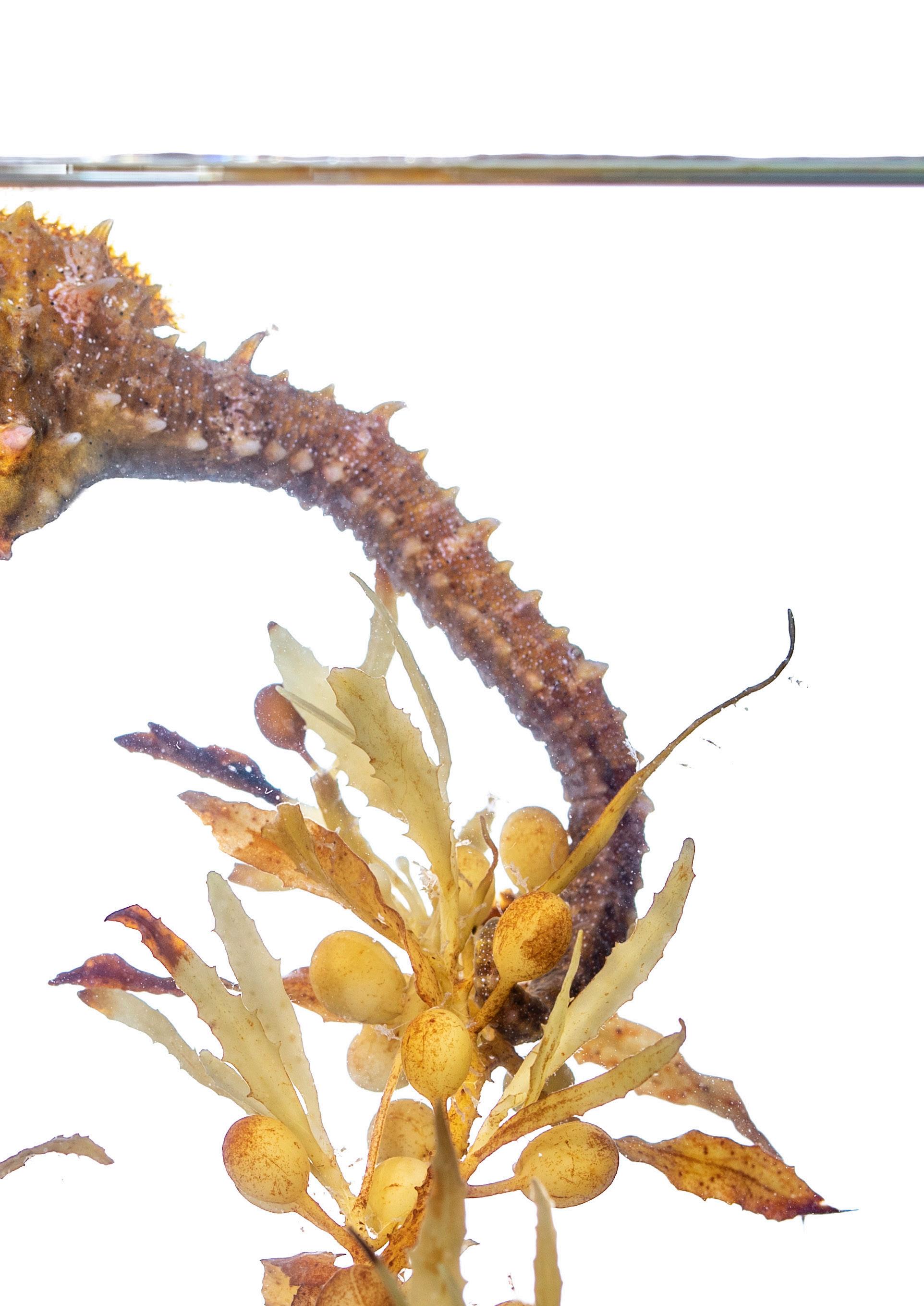

The Sargasso Sea, encompassing two million nautical square miles of the North Atlantic, is the only sea unconstrained by land. Instead, the shifting boundaries are formed by clockwise ocean currents. Aptly referred to as the “golden floating rainforest of the Atlantic,” this high seas ecosystem is comprised of floating Sargassum, which teems with life and shelters endangered and endemic species. The iconic humpback whale migrates through the Sargasso Sea, and it is also the only known spawning area for European and American eels. This ecosystem is threatened by several factors, including climate change and acidification, pollution (including plastics), increased fishing effort (for ocean species as well as eels), ocean shipping, and other activities that may be proposed, such as seabed mining. Data from the longest continuous open-ocean time series shows increases in surface temperature and upper ocean salinity. These changes may have a cascade effect on the Sargasso Sea ecosystem.
The greatest challenge to the protection of the Sargasso Sea is a matter of location. As part of the high seas, the Sargasso Sea falls outside the protection of any single national government. There is a complex tapestry of organisations which have mandates to address threats to the high seas. The conservation of the Sargasso Sea depends upon international decisions taken by these organisations.
Recognising that the current legal framework complicates the Sargasso Sea conservation efforts, the Sargasso Sea project was founded to use the area as a case study to test high seas governance.
The Hamilton Declaration on Collaboration for Conservation of the Sargasso Sea was signed in March 2014. The Governments of Bermuda, The Azores, The Bahamas, Canada, the Cayman Islands, the Dominican Republic, the Principality of Monaco, the United Kingdom, and the United States. The Declaration established the Sargasso Sea Commission as a new paradigm for high seas conservation. It is the first non-binding instrument to establish a means to collaborate through existing mechanisms in Areas Beyond National Jurisdiction. The Commission is charged with a stewardship role over the Sargasso Sea, and keeping its health, productivity, and resilience under continual review. The Commission has no management authority, but leads the Signatory governments in pursuing conservation measures for the Sargasso Sea through existing regional and sectoral organisations.
The Sargasso Sea Commission has successfully achieved widespread recognition of the international significance of the Sargasso Sea. The Sargasso Sea is the only named ecosystem
to merit an individual chapter in the first and second United Nations Ocean Assessments, and frequent references in the annual United Nations Law of the Sea Composite Resolution. However, the only legal protection measure secured for the Sargasso Sea to date has been the closure of the seamounts in the northern area to bottom fishing and gear type restrictions by the Northwest Atlantic Fisheries Organisation.
Through its work crafting important protection measures, the Commission has highlighted the limitations of the current voluntary arrangement under the auspices of the Hamilton Declaration and the need for more systematic governance of Areas Beyond National Jurisdiction. Significant sectoral and regional gaps exist in the warp and weft of this governance fabric. Dr David Freestone notes in his 2018 paper “The Limits of Sectoral and Regional Efforts to Designate High Seas Marine Protected Areas” that under the status quo, there is little coordination between these organisations, resulting in sectorspecific strategies to protect distinct areas from selected threats. Without the power to make intergovernmental decisions itself, the Sargasso Sea Commission cannot seek to establish protection measures independently.
In September 2018, the Commission
80 DIVERS FOR THE ENVIRONMENT | MARCH 2024 FEATURES
ABOVE: By-the-wind sailor (Velella velella) OPPOSITE PAGE: Portuguese man o’ war tentacles (Physalia physalis).
sponsored the preparation of a draft concept note for a possible Global Environment Facility (GEF) project. During the final day of the “Next Steps to Strengthen Stewardship of the Sargasso Sea” workshop held at the Bermuda Institute of Ocean Sciences in March 2019, a preliminary discussion of how such a project might be structured was held at the Joint Meeting of the Sargasso Sea Commission and the representatives of the Hamilton Declaration Signatory Governments.
It was decided that further detailed discussions were necessary with a wider range of stakeholders. In July 2019, the Commission, Signatories, the United Nations Development Programme (UNDP), and other partners were hosted by the Bahamian Government at the Royal Bahamas Defence Force base to discuss in more detail the plan for UNDP to submit the project to the GEF through the Food and Agriculture Organisation of the United Nations-led Common Ocean Programme. The project was allocated $3 million under the overall GEF7 Areas Beyond National Jurisdiction (ABNJ) programme, and submitted to the GEF in April 2020.
The GEF Council formally approved the overall global GEF Programmatic Approach entitled “Common Oceans- Sustainable utilisation and conservation of biodiversity in areas beyond national jurisdiction”, including the Sargasso Sea “child project”, in June 2020. Following a detailed review of several prospective partner organisations, UNDP selected the Intergovernmental Oceanographic Commission of the United Nations Educational, Scientific, and Cultural Organisation (IOC-UNESCO) as the executing agency for the project. IOC will work closely with stakeholders in leading the project development process in consultation with UNDP, the Sargasso Sea Commission and its Signatories, the GEF-eligible beneficiary countries, and other partners, including the Bermuda Institute for Ocean Sciences, the Duke University Marine Geospatial Ecology Lab, the Imperial College London Centre for Environmental Policy, the University of Edinburgh, the World Maritime University, and the French Global Environment Facility (which is also financing a parallel project on high seas governance targeting the Sargasso Sea and the Thermal Dome in Central America). The project will also benefit from efforts led by the recently established Western Tropical Atlantic Planning Group for the Ocean Decade, particularly in developing tools and building capacity to assess the impact of multiple ocean stressors and establish a baseline for ongoing monitoring and adaptive management for the Sargasso Sea.
In December 2020, the Sargasso Sea Commission, working with UNDP and the IOC, launched the preparations for the $3 million GEF grant by hosting a virtual Inception Workshop. The team has until June 2021 to

FEATURES

prepare the final project documents for consideration for approval by the GEF CEO.
This project is the first-ever GEF grant designed to address the conservation and governance of a well-defined high seas ecosystem. It is also the only project designed to apply an ecosystem-based approach in a specific Area Beyond National Jurisdiction.
The project’s overall objective is to facilitate a collaborative, cross-sectoral, and sustainable stewardship mechanism for the Sargasso Sea through improvement in the knowledge base and strengthened frameworks for collaborative management and governance. Stewardship of the Sargasso Sea is envisaged to be a collaborative venture through the development and adoption of sustainable management measures to conserve and protect its natural resources.
The GEF grant will finance a major Ecosystem Diagnostic Analysis of the Sargasso Sea and develop a Strategic Action Programme for future stewardship and sustainable governance. The Ecosystem Diagnostic Analysis will develop
an improved knowledge base to support a collaborative, adaptive, and ecosystem-based stewardship approach. This would build on the 2011 summary science case (developed by the Sargasso Sea Alliance that laid the groundwork for the establishment of the Commission) by establishing a baseline for ongoing monitoring and adaptive management and quantifying the latest threats and impacts. This work would also include a detailed socio-economic assessment and analysis of the global value of the Sargasso Sea ecosystem and a cost-benefit analysis of potential management approaches. The knowledge and data captured in these analyses aims to fill priority information and knowledge gaps arising from the Ecosystem Diagnostic Analysis. The Strategic Action Programme will identify immediate and longterm priority actions to mitigate threats and define the stewardship measures, as agreed and endorsed by the appropriately mandated institutions, partners, and collaborators. At the end of the project cycle, partners hope to have outlined a roadmap of the future actions to be taken under a broader ecosystembased stewardship approach for the Sargasso
Sea, with ongoing monitoring of baseline parameters and management and policy guidelines circulated to appropriate bodies.
Beyond the project’s horizon, the Sargasso Sea Commission hopes that the lessons and best practices that are learned over the next four years will serve as a practical model for possible replication in other areas of the high seas.
The Sargasso Sea Commission has made great progress in the implementation of two separate but complementary grants for the conservation of the Sargasso Sea: the SARGADOM project, focusing on the Sargasso Sea (SARGA) and the Thermal Dome (DOM), a collaboration between the Sargasso Sea Commission, Mar Viva, and the University of Western Brittany (UBO), financed by the French Facility for Global Environment (FFEM); and the Sargasso Sea project, a child project of the Common Oceans Programme, implemented by UNDP, executed by IOC-UNESCO, and funded by the Global Environment Facility (GEF).
These grants support the formulation of
82 DIVERS FOR THE ENVIRONMENT | MARCH 2024 FEATURES
ABOVE: Sargassum fish (Histrio histrio) collected from Sargassum mats.

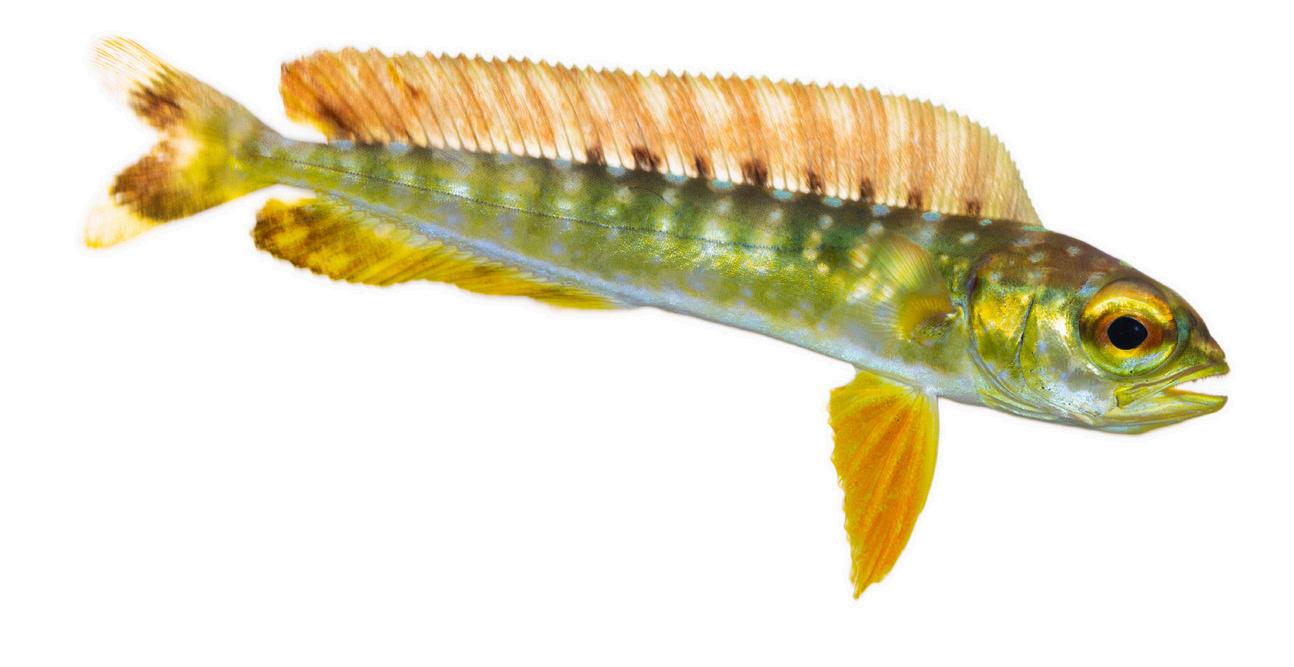
a Socio-Ecosystem Diagnostic Analysis (SEDA) of the Sargasso Sea – the first of its kind for a high seas ecosystem. The SEDA will be a science-based document, and will form the justification for the development of a Strategic Action Programme for the conservation of the Sargasso Sea, which will be agreed by key stakeholders.
The Sargasso Sea Commission has received reports from three implementing partners, Duke Marine Geospatial Ecology Laboratory (MGEL), Bermuda Institute of Ocean Sciences (BIOS), and Imperial College London, on oceanography, ecology, and human impacts on the Sargasso Sea, which will form part of the SEDA. It also plans to perform a data gaps analysis and bring in other partners to fill them. The Commission has already begun implementing a stakeholder engagement strategy to ensure that the inputs of scientists, conservationists, policy makers, and industry professionals are captured. Lessons learned from the project will be shared in order to inform conservation efforts for other high seas areas.
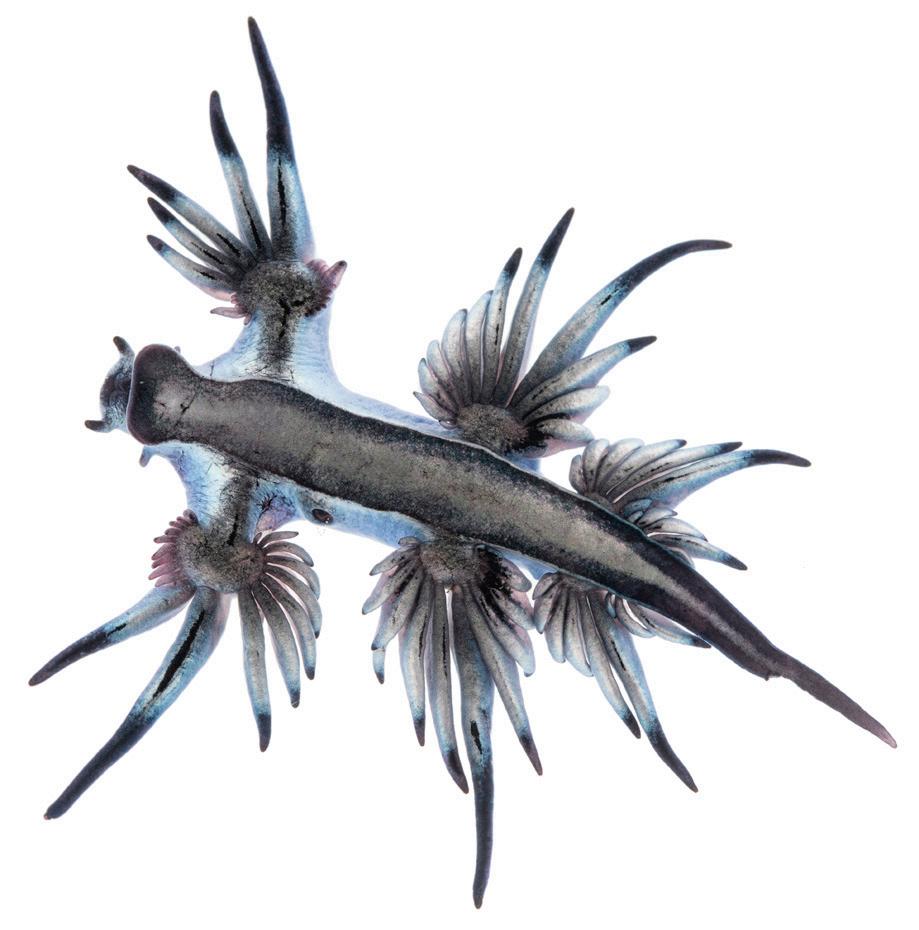
ABOUT THE SARGASSUM & NEUSTON BIODIVERSITY PROJECT
The Sargassum and Neuston biodiversity featured in this article was collected from, photographed, and then where possible, released back into the Sargassum mats and Neuston eco-systems which pass by and beach in Bermuda from the North Atlantic Gyre/Sargasso Sea.
They were taken by Sargasso Sea Commission Ambassador, Photographer Jean-Pierre Rouja, the Founder, Conservation Technology Developer and Media Producer for the Nonsuch Expeditions in Bermuda. He leverages the Nonsuch Island Nature Reserve, Bermuda’s surrounding reef platform, and the Sargasso Sea as a field station and testing ground for developing conservation technologies, whilst producing media for public outreach and education.
The 14 acre Nonsuch Island reserve is 60 years into a rewilding process and is the home to multiple Critically Endangered and Lazarus species, including the Bermuda Petrel or “Cahow”. It was thought extinct for 300 years until 17 pairs were rediscovered in the 1950s, now back up to 156 pairs due to a very successful translocation project. Learn more and watch LiveStreams from their underground nesting burrows:
www.nonsuchisland.com/cahowcam
Jean-Pierre is the Co-founder of Station-B, a Bermuda NGO that facilitates the development, rapid prototyping, and iteration of Ocean Conservation and Exploration tools, providing turnkey engineering facilities and easy access to Bermuda’s wide range of marine habitats, with mangroves, coral reefs, and 3,000+m deep ocean, all reachable within 30 minutes on a small vessel.
He is also the Director of “BioQuest” a new NGO using genomics for conservation in the Caribbean, building local capacity, teams, and labs: www.Bioquest.world
To support the ongoing conservation work, biodiversity art is available and printed on aluminium, with worldwide delivery options.
www.nonsuchisland.com/prints

83 MARCH 2024 | DIVERS FOR THE ENVIRONMENT FEATURES
CLOCKWISE FROM TOP: Juvenile octopus; Blue sea dragon (Glaucus atlanticus); and Juvenile Mahi-Mahi (Coryphaena hippurus) collected from Sargassum mats.

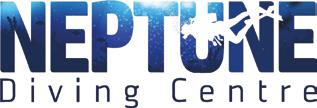
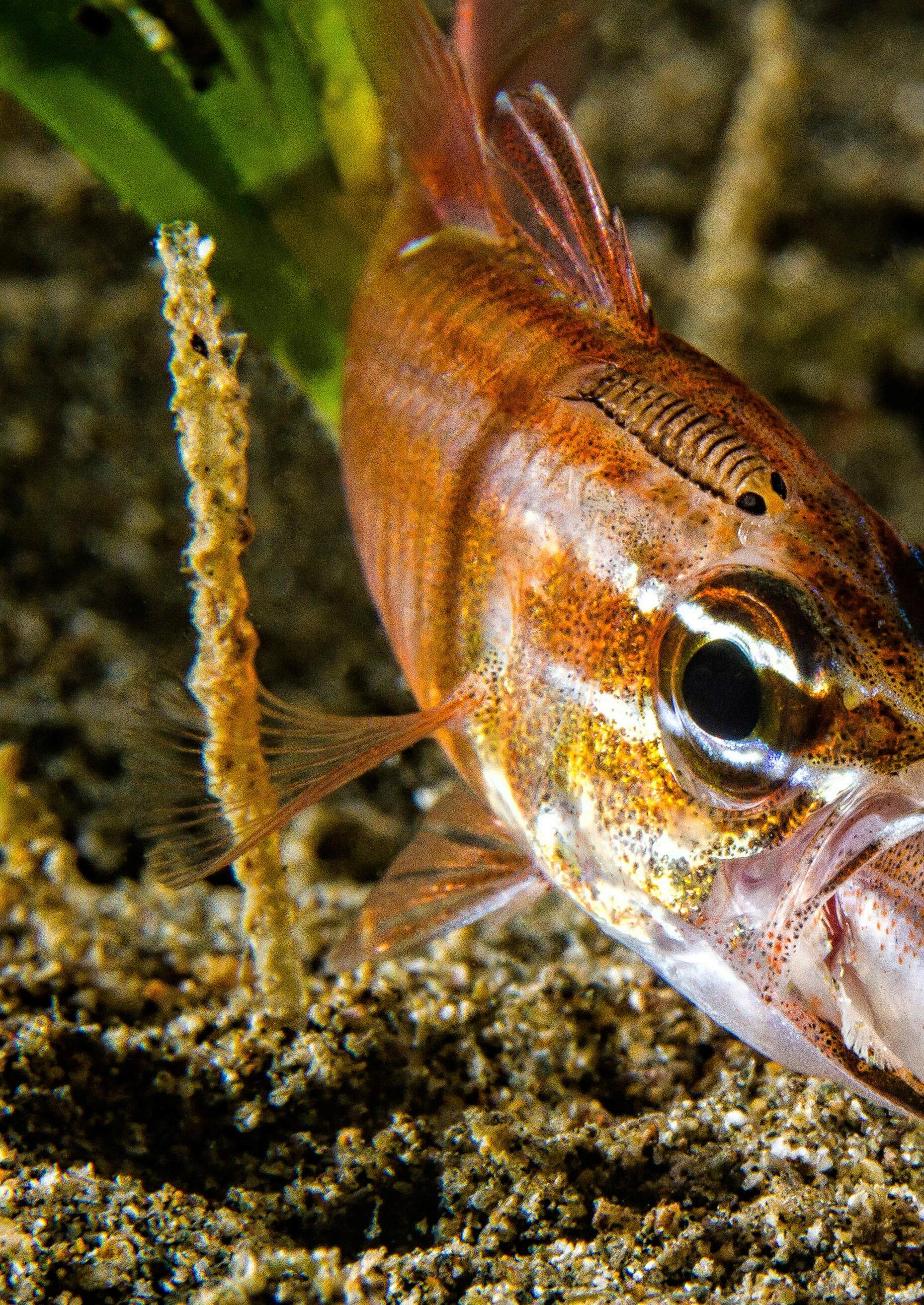



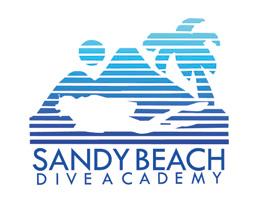
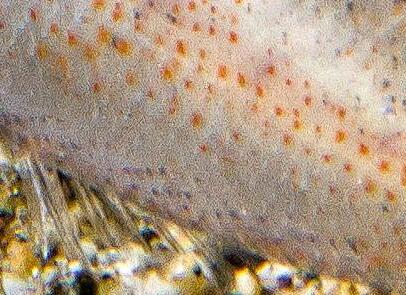
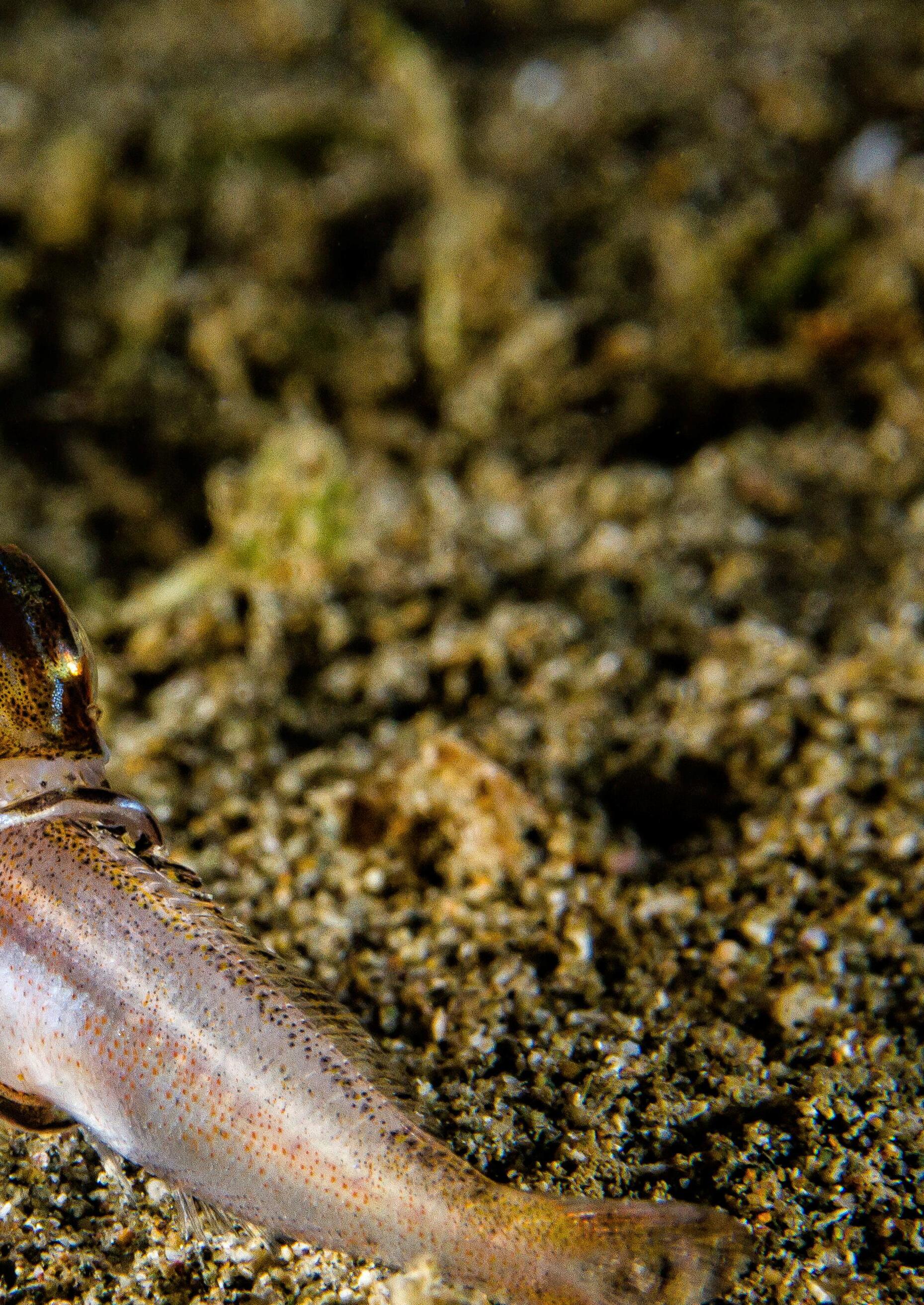
HOW TO TAKE PART Register for EDA Membership to take part in Digital Online and get the chance to win some amazing prizes. Membership gives you access to all of EDA’s annual events and activities. SUBMISSION DEADLINE Thursday 4th April 2024 at 11:59pm (GST) ENTER DIGITAL ONLINE EDA’S UNDERWATER PHOTOGRAPHY AND FILM COMPETITION 2024 WWW.EMIRATESDIVING.COM/EVENTS/DIGITAL-ONLINE
by Philippe Lecomte – Digital Online 2023
Photo
DIGITAL ONLINE 2024
EDA’S UNDERWATER PHOTOGRAPHY AND FILM COMPETITION
SUBMISSIONS OPEN: Monday 4th March 2024 | SUBMISSIONS CLOSE: Thursday 4th April 2024 at 11:59 PM (GST)
DIGITAL ONLINE AWARDS & EXHIBITION NIGHT: Thursday 16th May 2024 at Deep Dive Dubai
AN EVENT BY THE EVENT
EVENT PARTNER PRINTING PARTNER

DIGITAL ONLINE’S MAIN OBJECTIVES ARE:
• To develop the human interaction with the underwater environment and highlight the beauty of its flora and fauna.
• To gather information on the number of underwater photographers in the UAE.
• To discover new promising underwater photographers locally and internationally. Digital Online is open to all photographers and videographers of all skill levels with a valid EDA Membership status. EDA membership must be renewed if expired or acquired in order to take part: www.emiratesdiving.com/membership-form
DIGITAL ONLINE 2009-2024
Digital Online – EDA’s Underwater Photography and Film Competition, is about to celebrate its 15th year! The competition was introduced by EDA in 2009 to resident photographers to develop a relationship and human interaction amongst those unfamiliar with the underwater world environment. The competition holds both local and international marine life categories to offer variety between our local and international diving enthusiasts. The film category was introduced as an extension to the competition in 2012 to share our underwater world through motion pictures and deliver a better understanding of the habitats and surroundings.
The event sees continuous and steady growth with new underwater photographers taking part and joining our regular annual participants. The enthusiasm and passion strives on, and the drive to bring our underwater world’s conservation to the forefront increases even
more so. The purpose of Digital Online is to keep our underwater world visible by displaying its hidden beauties and to exemplify its importance to all life on Earth through the powers of its ecosystems.
The event has attained equal success with nondivers who come to support the participating photographers and videographers at the annual Awards & Exhibition Night. Whether it’s through discussions, or articles published
for our readers through our free quarterly magazine, Divers for the Environment, the inspiration the event brings, is a success in its own right.
COMPETITION CLAUSE
EDA does not disclose photographers’ names during the judging process. The competition is run fairly and without prejudice, professionally adhering to all of Digital Online’s rules and guidelines throughout.
86 DIVERS FOR THE ENVIRONMENT | MARCH 2024 UNDERWATER PHOTOGRAPHY
Digital Online 2023’s Awards & Exhibition Night was held on the 18th of May at Deep Dive Dubai. Thank you to all our prize sponsors and partners for making the event such a success.
RULES AND GUIDELINES 2024
• Digital Online is open to all photographers and videographers of all skill levels with a valid EDA membership status. EDA membership must be acquired or renewed if expired in order to take part which can be done through the EDA website: www.emiratesdiving.com/membership-form
• Each competitor can only win one prize. Other winning images will be displayed at the event as Highly Commended.
• The other prize or prizes, are awarded to the next photographer with the highest score, and so on.
• Winners will choose their own prize in order of winning status.
• Participants are obligated to follow environmental conservation regulations and to respect the underwater world during the process of taking their stills and videos. Any damage to the underwater world, including the disruption of the natural habitat of marine life, provocation through touching, displacing, feeding or annoying, is prohibited and will disqualify the images or the photographer/videographer.
• By entering the competition, entrants declare that they own copyright of the submitted photographs and films which generates an automatic acceptance of all the rules. EDA reserves the right to publish images in the ‘Divers for the Environment’ magazine, on EDA’s social media pages and EDA website. Images will also be used in any future promotional material for EDA events and competitions royalty free, but copyright remains with the photographer. Use of images or video will require no additional written or verbal permission from the photographer or videographer.
• Images (photos or videos) must not have already been submitted to previous Digital Online competitions.
PHOTOGRAPHY CATEGORIES
• Photos and videos must be taken underwater unless specified in a category description.
• Manipulation is restricted to colour correction, brightness, contrast, sharpening and cropping, except for the Creative Photography category. The Digital Online judges reserve the right to examine RAW/untouched images in the other categories if requested.
• Removing backscatter is allowed to an extent, this does not include the removal of subjects such as fish or divers, or cutting and pasting sections of images from one to another, except for the Creative Photography category.
• The winners will be announced and their work displayed at the exhibition and award ceremony on the 16th of May 2024. Participants who do not make it to the evening of the event will be asked to collect their prize from the EDA offices.
• Judges, Sponsors and prizes will be announced in the March 2024 magazine issue.
• We pledge to run this photography and video competition ethically, and with integrity. Our judges have volunteered their time to help. The photographers’ details remain hidden to the judges during the judging process.
• All judges’ decisions are final.
HOW TO ENTER
• Submissions may be entered from Monday 4th March 2024.
• The entry deadline is Thursday 4th April 2024 at 11:59pm (GST – Gulf Standard Time).
• Submit entries via email to: photo@emiratesdiving.com *with the requested category details included for each photo and film submission.
• File names should include participant’s name and the category as follows:
1. Your Name – Macro.jpg
Photographers may enter one image per photography category. The categories are open to photos taken with any type of camera: DSLR, mirrorless or compact.
*DETAILS TO INCLUDE FOR EACH PHOTO SUBMISSION:
• Photographer Name
• Category
• Location
• Story Behind the Shot
• Camera & Gear
• Settings
1. MACRO
Definition: Photographs taken with close-up equipment, portraying underwater flora and/or fauna. The photographer may not crop the original more than 20%. The original image may be requested.
2. WIDE ANGLE
Definition: Photographs taken with a wide angle lens (or adapters that provide an equal field-of-view), with or without human presence, portraying the natural beauty of the underwater environment.
3. BEST OF THE UAE
Definition: Any underwater subject taken in the UAE or Musandam.
4. BLACK & WHITE
Definition: Black and white photography is timeless and elegant. Focus on tonal contrast, shapes and textures and the composition of the shot.
5. BEHAVIOUR
Definition: A photograph showing marine life action, such as feeding, cleaning, schooling, mating, fighting, etc. May be captured under or above water.
2. Your Name – Wide Angle.jpg
3. Your Name – Best of the UAE.jpg
4. Your Name – Black & White.jpg
5. Your Name – Behaviour.jpg
6. Your Name – Creative Photography.jpg
7. Your Name – Coexistence.mp4
• Photo entries must be saved in jpeg format and should be sized between 2000 and 6000 pixels in the longest dimension. Please limit your images to a maximum file size of 5MB. Images will be viewed on a monitor and should be in the Adobe RGB 1998 or sRGB colour space.
• Video submissions must be in mp4 format.
• Photography and video entries are to be sent electronically through WeTransfer.
• You will receive an email to confirm your registration with photos and/or video upload. If you do not receive one within 24 hours, your email may not have come through and you may need to try again.
HOW PRIZES ARE AWARDED
Once the judging is complete, the winners will be able to choose a prize available to them on the list they will receive via email. Digital Online Judges award a 3-way point system to each photograph/ video consisting of Technique, Composition, and Impact which is added to give the image or video’s total grand score.
Best of show with the highest points will get first choice. 1st place winners by highest score will choose a prize before all other winners, 2nd place winners before 3rd place winners, etc. Please note, each individual can only win one prize. If photographers get a multiple win, their highest scoring image will win a prize and the other will get a highly commended mention which will also be displayed at the event.
6. CREATIVE UNDERWATER PHOTOGRAPHY
Definition: This field is wide open. It can involve a simple workflow used to capture a unique look of a photo. Or it can be a complex post-processing technique that is used to bring out the mood and textures in an image. Photos entered into this category can be taken in any underwater environment –including controlled environments (e.g. pools, tanks). The main subject can be anything ranging from an abstract concept to a person (a diver, freediver, model, etc.) to a fish. There are no post-processing (photoshop) limits in this category. This category is designed to let your imagination swim free.
VIDEO CATEGORY
Videographers may enter one film with the following title: COEXISTENCE
*DETAILS TO INCLUDE WITH VIDEO SUBMISSION:
• Videographer Name
• Genre
• Location
• Story Behind the Film
• Camera & Gear
7. COEXISTENCE
Guidelines: Looking for films of all genres – documentaries, narratives, shorts and animation films. Film subject must focus on all aspects of our underwater world including but not limited to: ocean exploration, wildlife, environmental, conservation and oceanography.
• All film genres will be accepted.
• Content must focus or relate to the ocean.
• Non-English films must have subtitles.
• If music is used, it must be from a public domain or royalty-free.
• Film length should be 5 minutes or less, including credits.
• Winning films will be chosen on creativity and the ability to tell a story that leaves the audience better informed and/or moved by the ocean.
87 MARCH 2024 | DIVERS FOR THE ENVIRONMENT UNDERWATER PHOTOGRAPHY
THE SPONSORS AND PRIZES
Digital Online’s 2024 Prize Sponsors will be offering this year’s 21 winners the following prizes to choose from:
NOTE: Participants are only able to win one prize each. Entrants with multiple winning entries will be given priority in the points awarded.

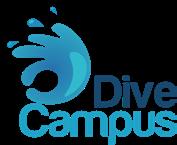

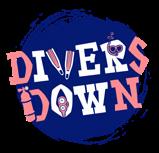
1. PELAGIC DIVERS FUVAHMULAH
www.pelagicdiversfuvahmulah.com
3 nights with bed & breakfast, 2 days of diving (3 dives/day) for one. Dive Ukulhas is one of the pioneer dive centres in Ukulhas that offers dive excursions to renowned sites such as Maaya Thila and Fish Head, exploring vibrant coral gardens, or navigating through intricate channels. Now led by Pelagic Divers Fuvahmulah, a leading dive centre in Fuvahmulah, we aim to extend similar unparalleled diving experiences in Maldives.
2. NEPTUNE DIVING CENTRE | www.neptunecenter.ae
2 days/2 nights on a shared liveaboard in the Musandam with 6 dives included.
Terms & Conditions:
• Valid for 4 months
• Dive equipment and Nitrox not included
• 25% discount on the trip to bring a buddy
3. GRAND STORES (3 Prizes) | www.grandstores.com
www.sealife-cameras.com
1. SEALIFE ReefMaster SL350 RM-4K Underwater Camera
• Image Stabilisation
• 2.0” 230K Hi-res TFT colour LCD
• Expandable memory up to 128GB
• 14 megapixel Panasonic CMOS image sensor
• 4K Ultra HD Video @ 30fps and 1080p HD video @ 60 fps
• All details: https://bit.ly/3H8lWn4
2. SEALIFE SportDiver SL400-U Underwater Smartphone Housing
• Moisture sensor
• Vacuum pressure alarm
• App to control all camera settings
• Compatible for Android and all iPhones
• Unique visual and audible protection underwater
• All details: https://bit.ly/3Rcucr2
3. SEALIFE Sea Dragon Mini 1300S Power Kit (SLKITO8)
• Sea Dragon Mini 1300 LED Underwater LED Dive Light
• Rechargeable 18650 battery (2600 mAh)
• USB battery charger
• USB cable
• Wrist lanyard with BCD clip
• Two spare O-rings
• O-ring lube
4. MONSTER MIDDLE EAST (2 Prizes)
MONSTER BUNDLES INCLUDE: A GoPro HERO12, a LARQ bottle, and a ROCKETBOOK.
• GoPro HERO12
The best HERO camera we’ve ever made – HERO12 Black takes GoPro’s best-in-class image quality to the next level with




new HDR (High Dynamic Range) 5.3K and 4K video, upgraded
HyperSmooth 6.0 video stabilisation and an industry-leading 177° field-of-view with Max Lens Mod 2.0.
Other new features include a totally redesigned power management system for improved thermal performance and up to 2x longer runtimes1, and Bluetooth audio support for Apple AirPods and other headphones to record sound and give remote voice commands.
There are also pro-level features such as wirelessly synchronising multiple HERO12s via timecode, advanced colour controls, and more. HERO12 wraps all of this into GoPro’s legendary waterproof, ultra-rugged design to ensure you get the shot, no matter the environment.
• LARQ Bottle PureVis™
The LARQ Bottle PureVis™ is the world’s first self-cleaning water bottle and water purification system.
It uses PureVis technology to eliminate up to 99%* of biocontaminants such as E. coli from your water and bottle.
*Based on elimination 99.8% of Ecoli in a 20-second cycle for all LARQ Bottles.
• ROCKETBOOK Core Executive Reusable Notebook
EASY AS PAPER. SMART LIKE A TABLET.
Rocketbook fits your lifestyle. Use it like a paper notebook and when you’re ready, harness the power of the cloud.
Best of all, the pages wipe clear with water to be used again and again.
5. CREST DIVING (6 Prizes) | www.crestdiving.com
1. CREST White Dive Computer CR-4 (2)
https://crestdiving.com/products/cr4
2. Folding Fins + Travel Bag (2)
https://crestdiving.com/products/foldingfins
https://crestdiving.com/products/foldingfinsbag
3. CREST Sexy Light SMB and Alunium Spool Combo (2)
https://crestdiving.com/products/smbsexylightaluminum
6. DIVE CAMPUS (2 Prizes) | www.divecampus.com
1. PADI Tec Course
Includes PADI eLearning, 1 Confined and 3 Open Water Dives
Terms & Conditions:
• This course can be used for self or offered to a friend
• Course should be redeemed within 1 year from receiving the award
• If recipient wishes to switch this to a PADI recreational course, it is possible upon discussion
• Tec equipment is not included and can be rented during the course
2. ORCA Dive Light 910V 5000 Lumens
OrcaTorch D910V is a high CRI neutral white diving video light for
88 DIVERS FOR THE ENVIRONMENT | MARCH 2024
UNDERWATER PHOTOGRAPHY
underwater photography. It features a chip-on-board CREE LED array to create even illumination with a 5000 lumens output and 120 degree wide angle beam. With the industry’s first magnetic fast charging technology, the led video dive light can be charged without taking out the battery.
7. XR HUB (2 Prizes) | www.xrdiving.com
1. One Issotta Housing for GoPro
Isotta GoPro HERO9, HERO10, HERO11, & HERO12 Underwater Housing GP12
• Double O-ring Seal
• M6 & 1/4-20 Threaded Mounts
• Machined Aluminium
• Included Rear Hood
• Depth Rating: 200m/656ft
• Compatible with flip filters
2. One Blackwater Dive
Experience a Blackwater night dive! Focus on finding unique creatures in the water column, attracted from the deep by high powered light sources that simulate the moon.
8. AL MAHARA DIVING CENTER | www.divemahara.com
2 hour kayak excursion at the Eastern Mangroves for 2 persons,
THE PEOPLE’S CHOICE AWARDS
and one Abu Dhabi day zone for one dive of choice for either a wreck or reef dive, and one shark dive at the National Aquarium for 1 person.
We are the first PADI Eco 5 Star IDC Dive Centre in the region. We focus on marine conservation, restoration, and making positive impacts with the community and youths.
9. GOBLIN DIVE CENTER (3 Prizes)
www.facebook.com/GoblinDC
4 Dives Package to dive the East Coast’s dive sites. Includes tank and weights.
10. DIVERS DOWN | www.diversdownuae.com
6 Dives Package to dive the East Coast’s dive sites. Includes tank and weights.
11. SANDY BEACH DIVE ACADEMY
www.divesandybeach.com
Two tank boat dive + one shore dive on East Coast (Fujairah).
12. AL BOOM DIVING | www.alboomdiving.com
Two tank boat dive on East Coast (Fujairah) with or without equipment, including tank and weights.
We will have 3 extra prizes to give away to 3 lucky winners who will receive the 1st, 2nd, and 3rd highest likes from the public! Includes both photo and video entries. Voting will take place on Facebook from the 20th of May. The results will be announced on the 24th of May.



89 MARCH 2024 | DIVERS FOR THE ENVIRONMENT
UNDERWATER PHOTOGRAPHY
WHO WILL MAKE THIS YEAR’S JUNE MAGAZINE COVER?
THE DIGITAL ONLINE JUDGES
PIER NIRANDARA
Author, Travel Writer, Film Producer, Underwater Photographer
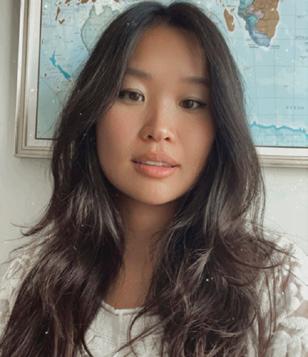
Pier began her career as Thailand’s youngest author of three bestselling novels, multiple graphic novels, and short stories with over 200,000 copies sold in multiple languages. She has served as Director of Development at Sony Columbia Pictures, and as VP of Film & TV at A-Major Media, Hollywood’s first Asian American-driven production company. A TEDx speaker and literary ambassador for the Bangkok Metropolitan/UNESCO, Pier has won 2 Solas Awards for Best Travel Writing of the Year, 2 Lowell Thomas Awards from the Society of American Travel Writers, and Gold at the Book Passage Travel Writers & Photographers Conference 2023. Pier is also a PADI AmbassaDiver™ and founder of Immersiv Expeditions, where she leads trips to swim with marine wildlife. Her photography has been recognised by competitions including Ocean Photographer of the Year, and she was awarded the 2023 Ocean Storytelling Photography Grant by the Save Our Seas Foundation.
WEBSITES: www.piernirandara.com and www.immersivexpeditions.com
INSTAGRAM: www.instagram.com/piersgreatperhaps
WILSON MCCOURTNEY
Underwater Cinematographer, Filmmaker & Wildlife Conservationist
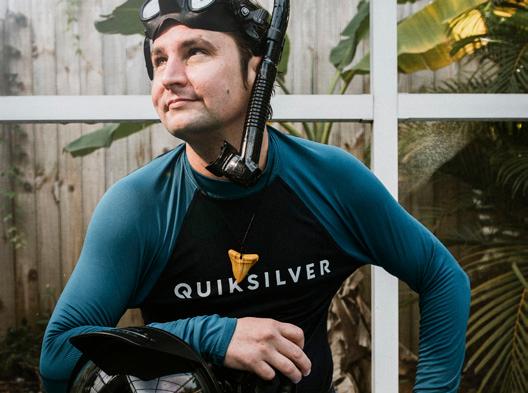
Wilson McCourtney is an underwater cinematographer, documentary filmmaker, and a wildlife conservationist. Having grown up in Florida, he developed a connection with the natural world at an early age that has fuelled his creative career and solidified his mission in life which is to protect our oceans and save wildlife.
In 2020 he played an instrumental role in passing the Kristin Jacobs Ocean Conservation Act which outlawed the import and export of shark fins in Florida. He directed a feature film called “Fighting For Florida” which is about saving sharks in Florida, minimising the horrific effects of Red Tide, and rescuing pelicans from fishing line entanglement which is slated to be released in 2024. When he’s not underwater or fighting for the planet, Wilson spends his time in Portland, Maine with friends and family hiking in the woods and exploring the vast wilderness of the NorthEast.
YOUTUBE: www.youtube.com/wilsonmccourtney
FACEBOOK: www.facebook.com/wilson.mccourtney
INSTAGRAM: www.instagram.com/wildlifewilson www.instagram.com/fightingforfloridafilm
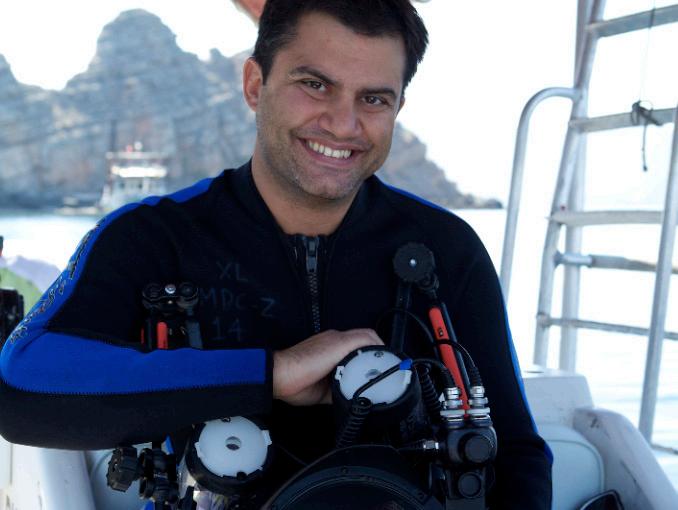
Simone is an Italian underwater photographer, who has been awarded in several prestigious competitions and published internationally. After over 10 years of corporate life in Dubai, he moved to Australia where he co-owns and manages Sundive Byron Bay, a PADI 5 Star Dive Centre offering dives at the amazing Julian Rocks in Byron Bay. After travelling to and photographing many unique diving destinations worldwide, he also runs expeditions with Sundive to help others experience and photograph his favourite ones such as the Sardine Run and Djibouti. Simone was the Overall Winner of Digital Online for two consecutive years until he became a judge for the competition and has been a main feature contributor to the EDA magazine, ‘Divers for the Environment’.
FACEBOOK: www.facebook.com/SimoneCaprodossiPhotography INSTAGRAM: www.instagram.com/scaprodossi

David is a multi-award winning Filmmaker, Underwater Cinematographer and Digital Colourist from the UK best known for his work with sharks and large marine megafauna as well as his multi-award winning feature documentary, “Of Shark and Man”. His profile has increased rapidly thanks to his work on a wide variety of projects for film and television, alongside his commercial work for a number of household brands.
David is the owner of Scarlet View Media, a high end boutique Production House in the north of England, and is a Panasonic Professional Ambassador and Angelbird Media Creative.
WEBSITE: www.scarletviewmedia.com
FACEBOOK: www.facebook.com/daviddileyfilmmaker
MOHAMED ALMUSALLAMI
Underwater Photographer and Marine Biologist

Mohamed is a son of the Arabian Gulf. Coming from a long line of legendary pearl divers and fishermen, a strong bond ties him to the deep blue. He started his passion as a freediver and a spear-fisherman at an early age and naturally fell in love with the beauty of the underwater world. He took up underwater photography in 2008, and has won several awards and been published internationally since. His eye-catching and distinctive style pushes the limits to how photographers represent life below the waves. Mohamed has dedicated himself to conservation and to the Art of Underwater Photography, putting forth the message, “The Ocean has given our ancestors everything, now it is our turn to give back”. As a marine scientist with a masters degree in Environmental Science, he works closely with sea turtles, dugongs, dolphins, and sharks, where he is also responsible for many rare scientific discoveries in the Arabian Gulf region. Mohamed is also a PADI Instructor, an affiliate at Mohammed bin Rashid Academy of Scientists (MBRAS), the Head of Fisheries Management at the Environment Agency – Abu Dhabi, and a Board Member at the Emirates Zoos and Aquariums Association.
INSTAGRAM: www.instagram.com/b47r
ALLY LANDES | EMIRATES
DIVING ASSOCIATION
Project Director, Editor, Graphic Designer, and Photographer
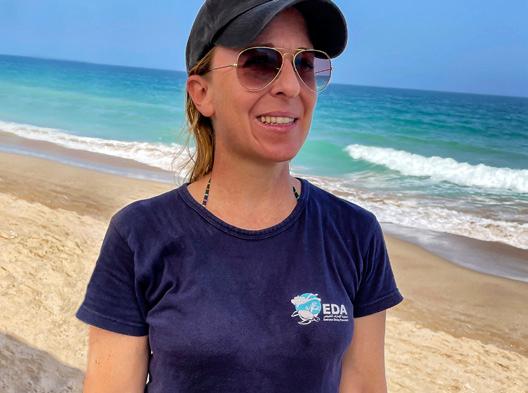
Ally joined EDA in December 2004 when she created and introduced the organisation’s quarterly magazine, “Divers for the Environment”. She played a central role in the development of Digital Online – EDA’s Underwater Photography and Film Competition from its launch in 2009, as well as introducing the film category as an extension in 2012 to share our underwater world through motion pictures, and has managed the event since inception. Today, Ally continues to oversee the EDA team and develop the brand, manages design and production of the magazine, handles photography and videography, and runs the organisation’s events and social media, all in the name of ocean conservation.
WEBSITE: www.emiratesdiving.com
INSTAGRAM: www.instagram.com/emiratesdivingassociation www.instagram.com/eda_uae
90 DIVERS FOR THE ENVIRONMENT | MARCH 2024 UNDERWATER PHOTOGRAPHY
SIMONE CAPRODOSSI | SUNDIVE BYRON BAY Underwater Photographer
DAVID DILEY | SCARLET VIEW MEDIA Filmmaker, Underwater Cinematographer and Digital Colourist
TOBIAS FRIEDRICH
TO MAKE A PERSONAL GUEST APPEARANCE

SPECIAL GUEST PRESENTATION
Grand Stores have very kindly organised a special guest to fly in for Digital Online’s Underwater Photography & Film Competition’s Awards Night on the 16th of May at Deep Dive Dubai. Professional Underwater Photographer and SEALIFE Brand Ambassador,Tobias Friedrich will be visiting our event to share a presentation with our members about his incredible experiences as an underwater photographer.
Grand Stores will be displaying their selected range of SEALIFE products at the Awards Night, and they will unveil their special offers, exclusively for EDA members.
ABOUT TOBIAS FRIEDRICH
Tobias Friedrich loved to watch the adventures of the Calypso featuring JacquesYves Cousteau during his childhood. The
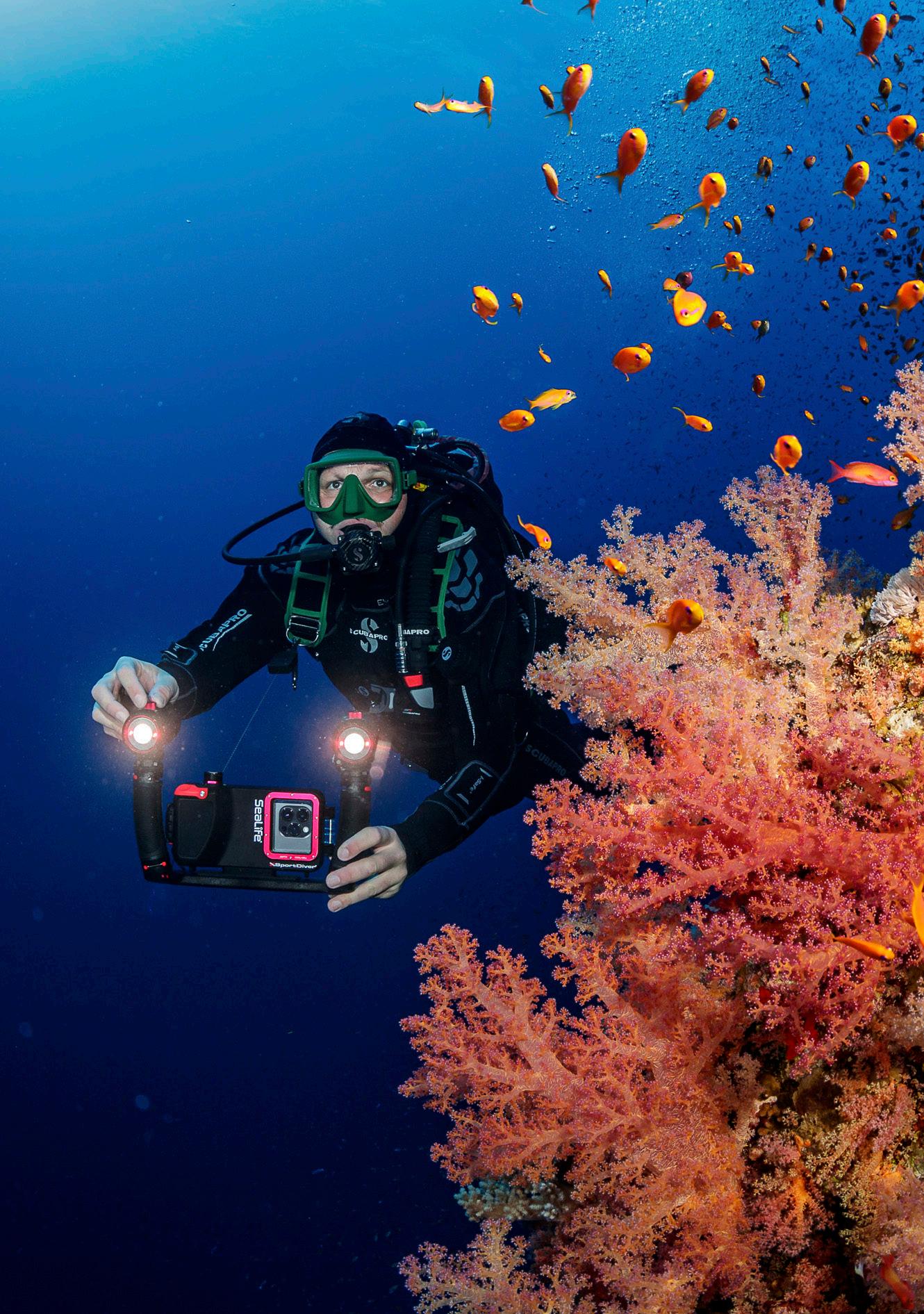
beauty of the world that is below the ocean’s surface mesmerised Tobias. It still overwhelms him every time he has the chance to dive. He loves the elegance and calmness of the world underwater contrasting with the hectic atmosphere above.
Tobias is based in Wiesbaden Germany which is conveniently close to Frankfurt Airport, a major hub for Germany. This facilitates his international travels for assignments around the globe. He first started taking underwater photographs with a DSLR in 2007. Since then, his images have been published in prestigious scuba diving magazines and newspapers all around the world, and several underwater photographic competitions have honoured his work, resulting in over 50 awards with 30 first places. He was awarded “Underwater Photographer of the Year 2018”
in the prestigious UPY London competition. In addition, he is the “German Photographer of the Year 2019” in the Worlds Shootout.
Tobias feels at home in all waters; ranging from subzero to 30° Celsius. As long as there are captivating images to shoot, he is game.
Another great passion is leading international expeditions and workshops where he invites anyone to join and share his love for the underwater world.
HOW TO FIND TOBIAS FRIEDRICH
www.instagram.com/tobias_friedrich_photography https://bit.ly/3wkGRl8
www.youtube.com/user/wwwbelowsurfacecom www.below-surface.com
91 MARCH 2024 | DIVERS FOR THE ENVIRONMENT UNDERWATER PHOTOGRAPHY
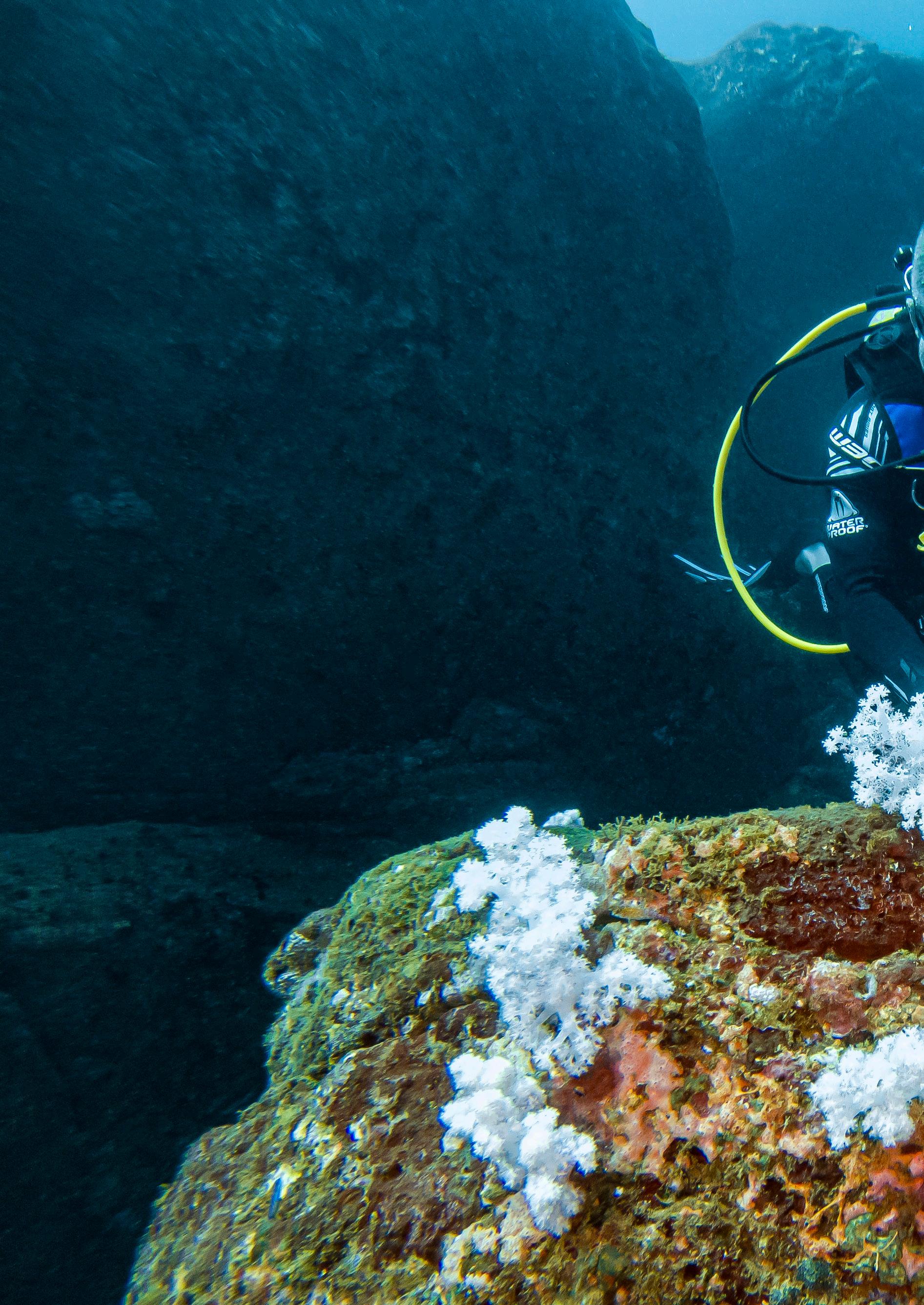
SRI LANKA SOUTH CEYLON TRAVEL DIARIES
I first discovered Sri Lankan island life back in March 2006 with a group of 10 other divers on a short 4 day FAM trip. It was organised by the Sri Lankan Tourism Board targeting EDA and a group of members to promote diving in Bentota after the devastating tsunami of December 2004. I published the articles in the summer 2006 issue of Divers for the Environment which had only just served its second year. How far the magazine has come since those days – 18 years ago.
FEATURE AND PHOTOGRAPHY ALLY LANDES
Diving Mada in Bentota with Lanka Sportreizen (LSR).

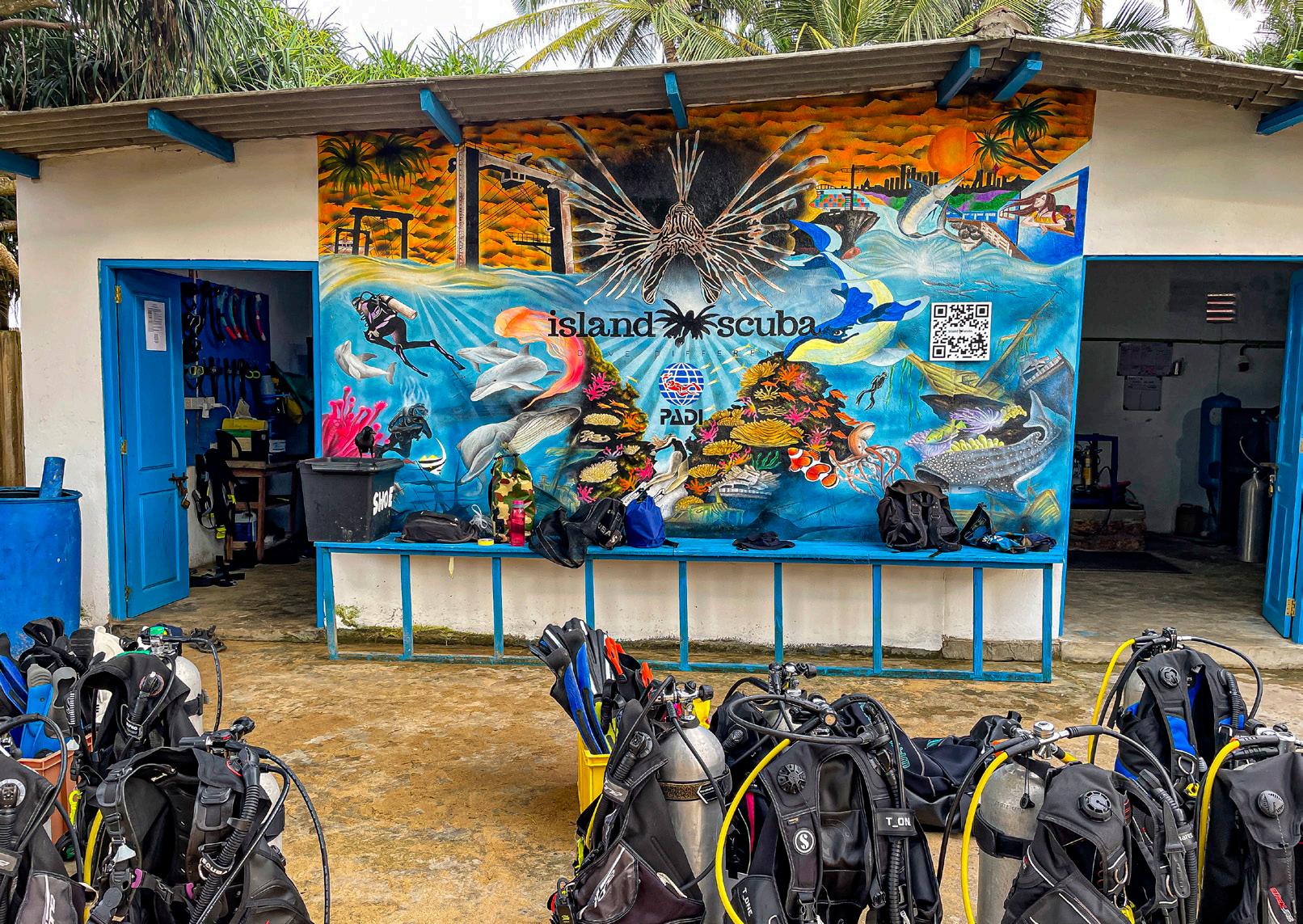

I first discovered Sri Lankan island life back in March 2006 with a group of 10 other divers on a short 4 day FAM trip that included a lot of moving around, with long bus journeys. It was organised by the Sri Lankan Tourism Board targeting EDA and a group of EDA members to promote diving in Bentota after the devastating tsunami of December 2004.
I published the articles in the summer 2006 issue of Divers for the Environment which had only just served its second year. How far the magazine has come since those days – 18 years ago.
I loved that whirlwind trip so much, I promised myself I would one day go back and take a slower approach to discover the south of the island properly. It turns out, it took me 17.5 years to do it, but I would like to think we did it justice in the 10 days we booked our visit.
As a tropical Indian Ocean island, we did a lot of research into the hiking options, wildlife
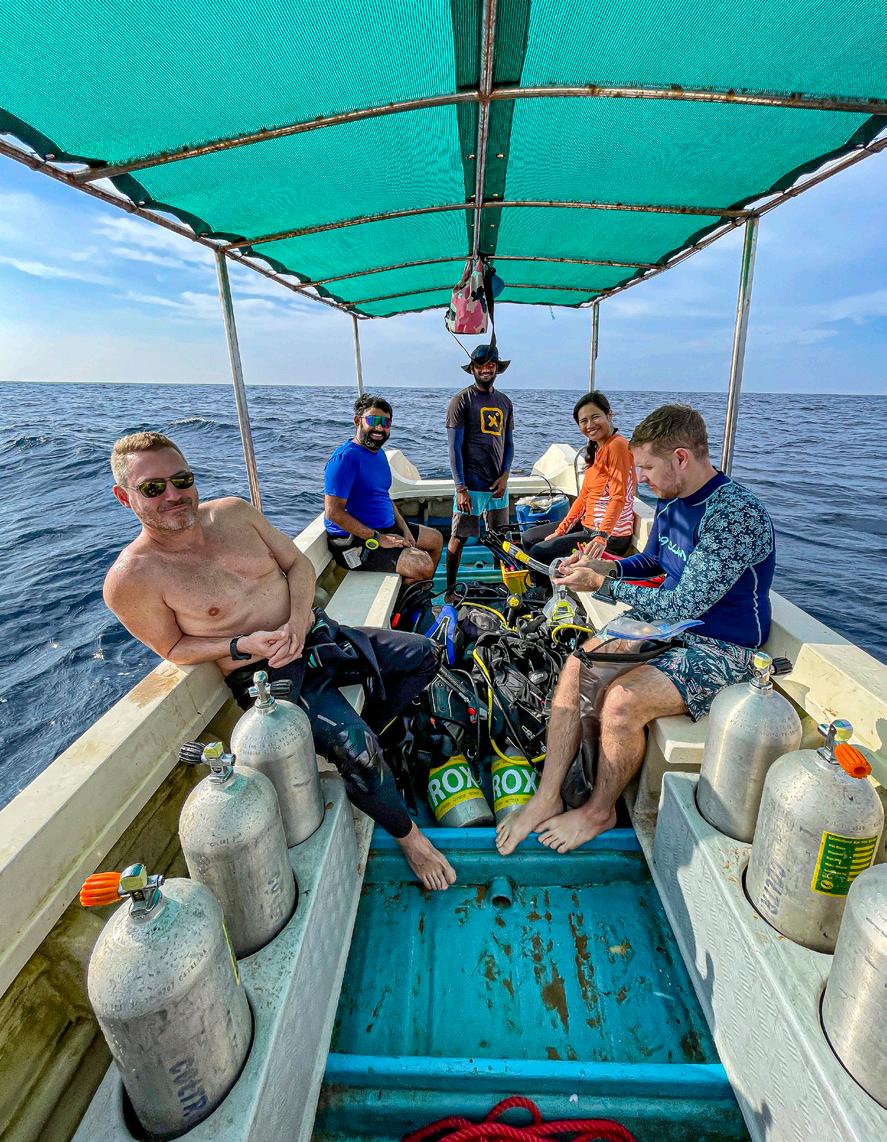

exploration, and diving in the south for our winter season in December. The South is definitely the place to be this time of year. Despite it not being the wet season, we did get 5 days of tropical rain after 5 superb weather days at the end of our trip. However, it did not dampen the holiday.
We planned quite the adventure, where my socalled slower approach was not so slow after all. We had originally looked into the possibility of hiring a car and driving ourselves around, but the logistics are complicated so we opted for a personal driver instead and we couldn’t have been happier. You can even hire a self drive tuktuk if you’re feeling REALLY adventurous.
Amal was recommended to us by fellow EDA Member, Joan Conde, and he was fantastic. It meant we could take in all the views, meet our schedules on time (we timed everything around our accommodation check-ins and check-outs) and have the occasional nap as
the drives can be quite long. It also meant we could get answers to all our questions while en route, and enjoy last minute recommendations we would have otherwise not known about.
MOUNT LAVINIA
Our first stop in Colombo straight from the airport was to Mount Lavinia where I had booked our dives through Island Scuba for the following morning, also recommended by Joan. Colombo is known for its wreck dives and we had two dives booked to Shipwreck Cargo (Pecheur Breton), and Shipwreck Medhufaru which we were really looking forward to.
We checked in to the Beverly Suites Mount Lavinia which is opposite the Mount Lavinia beach – you just need to walk 6 minutes and cross the train tracks. It’s only a 7 minute drive from the Island Scuba diving centre which was ideal. It was perfect for us, the room was spacious and clean for a great price, in a picturesque location, and had a convenient
94 DIVERS FOR THE ENVIRONMENT | MARCH 2024
DIVING DESTINATIONS
ABOVE: Island Scuba’s dive centre and dive boat. BELOW: The Shipwreck Cargo (Pecheur Breton) has some great swim-through tunnels.


late afternoon check-out. We unpacked the essentials and prepped our gear for the next day’s dives, before heading off for a walk on the beach to grab some lunch while enjoying the sea views with Colombo’s city skyline in the backdrop.
We can recommend going to the Mount Lavinia Hotel rooftop pool terrace in the afternoon to watch the spectacular sunset with a sundowner or two, and then head down to the beach on the Northern side of the hotel to have dinner and listen to some excellent live music at the Catamaran Beach Restaurant.
There, we got to chat with Thanuja Danwatte, the restaurant’s Director, who is strongly active in sustainable initiatives and takes part in local beach clean-ups with her team. Like most coastal island beaches, we had noticed the visible rubbish on our walk, most of which was plastics. Thanuja explained that aluminium items collected are recycled
DIVING DESTINATIONS

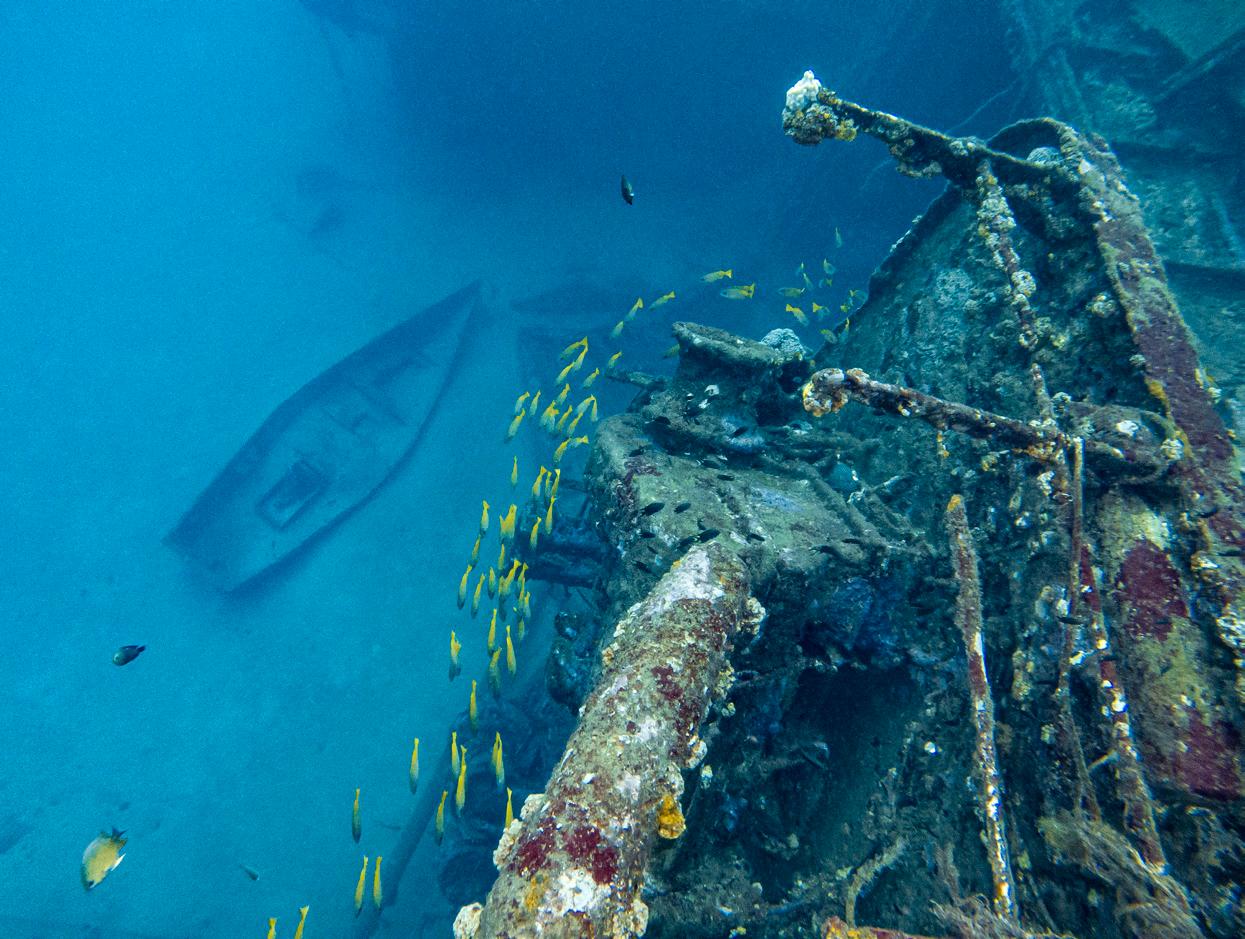
and sent to the Melting Point Aluminium Recycling Programme enforced by the Central Environmental Authority for the new government’s programme to protect the environment. Aluminium cans are considered the most recyclable and valuable of all materials in Sri Lanka. It’s good to learn that there is a concerned community involved in regular clean-ups, but as Thanuja said, they are continuous as the limited beach strip available around Colombo is only 5km. There is an adjoining canal that unfortunately pollutes the area despite the clean-up programmes initiated, but future upcoming programmes should help alleviate the problem.
The next morning, Amal picked us up and dropped us off at Island Scuba. It’s a really nice setup right on the beach where they share the space with Pink Salt, a great restaurant to stop at for lunch after the dives while you let your rinsed gear dry out.This was great for us as we always travel with our own equipment and are
constantly on the move.
WRECK DIVING
Like most dive centres in Sri Lanka, Island Scuba has 2 locations which are seasonal due to the monsoon. Their Colombo dive centre runs from November-April where they offer wreck (15 accessible wrecks within recreational diving depths), and sandstone and rock reef dives. In May-October, they operate in Trincomalee on the east coast offering coral reef and critter dives.
Our first dive on Shipwreck Cargo (Pecheur Breton) was fantastic. It’s only a 15 minute boat journey to the wreck and lies between 18-32m depths on its side. The 88m x 12.5m cargo ship sank back in 1994 from what was believed to be a leak in one of the hatches. This is a great wreck with fully collapsed cargo floors that have created two large swim-through tunnels and there are so many nooks and crannies to look into. It’s hard to
95 MARCH 2024 | DIVERS FOR THE ENVIRONMENT
ABOVE: Our dive on Shipwreck Cargo (Pecheur Breton) where colourful Tubastrea hard corals can be seen.




capture it all in one dive. Wooden lifeboats lie on the seabed next to the wreck, and there are plenty of schools of fish all over, in and under the wreck. The ship’s hull is stark with barnacle growth, but then there are plenty of areas with spurts of colourful Tubastrea hard corals which I’m told by Henrik Stahl, the Associate Professor in Marine Sciences from the University of Khorfakkan, “is a ahermatypic cup-coral that doesn’t have any symbiotic algae. Hence, it can grow deeper and in more shaded areas (such as shipwrecks) compared to hermatypic reef building corals. These are quite invasive in their nature and can compete (and sometimes outcompete) with other corals and sponges for hard substrates to grow


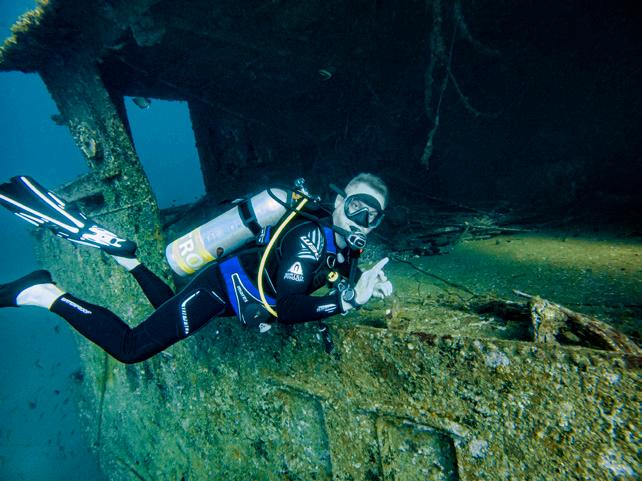

on. Tubastrea are sometimes called, “sun coral” due to their often bright yellow appearance.”
The obvious choice for photographers who have to decide which lens to use, is wide-angle – and good lighting is a must at these depths. I have both wide-angle and a macro option setup on 2 separate GoPros lined up side by side with 2 Black Molly V 2600 lumens video lights from Big Blue, and one extra [qudos] action light by knog with 70-400 lumens as a filler. I can easily position my lights for either GoPro I need to use. Anyone with a newer GoPro has the options to switch between the fields of view using just the one camera. I have yet to update my 5 and 8 with the latest
GoPro on the market. Sadly, I lost my 7 on this trip after the housing flooded, so I can tell you, I don’t regret having spares!
I came across a nudibranch without looking for it, so I’m sure there is a lot more macro subjects to find if giving it priority, but there’s so much going on as a whole, you would only want to prioritise macro if there is bad visibility, or you’ve got more dives coming up on the same wreck.
The second dive at Shipwreck Medhufaru is only a couple of minutes away and another fantastic wreck. It sank in 2009 due to structural damage. This upright 77m x 12m cargo ship is found at a maximum depth of 28m loaded with
96 DIVERS FOR THE ENVIRONMENT | MARCH 2024
DIVING DESTINATIONS
ABOVE: Our dive on Shirwreck Medhufaru with the marbled electric ray (Torpedo marmorata).
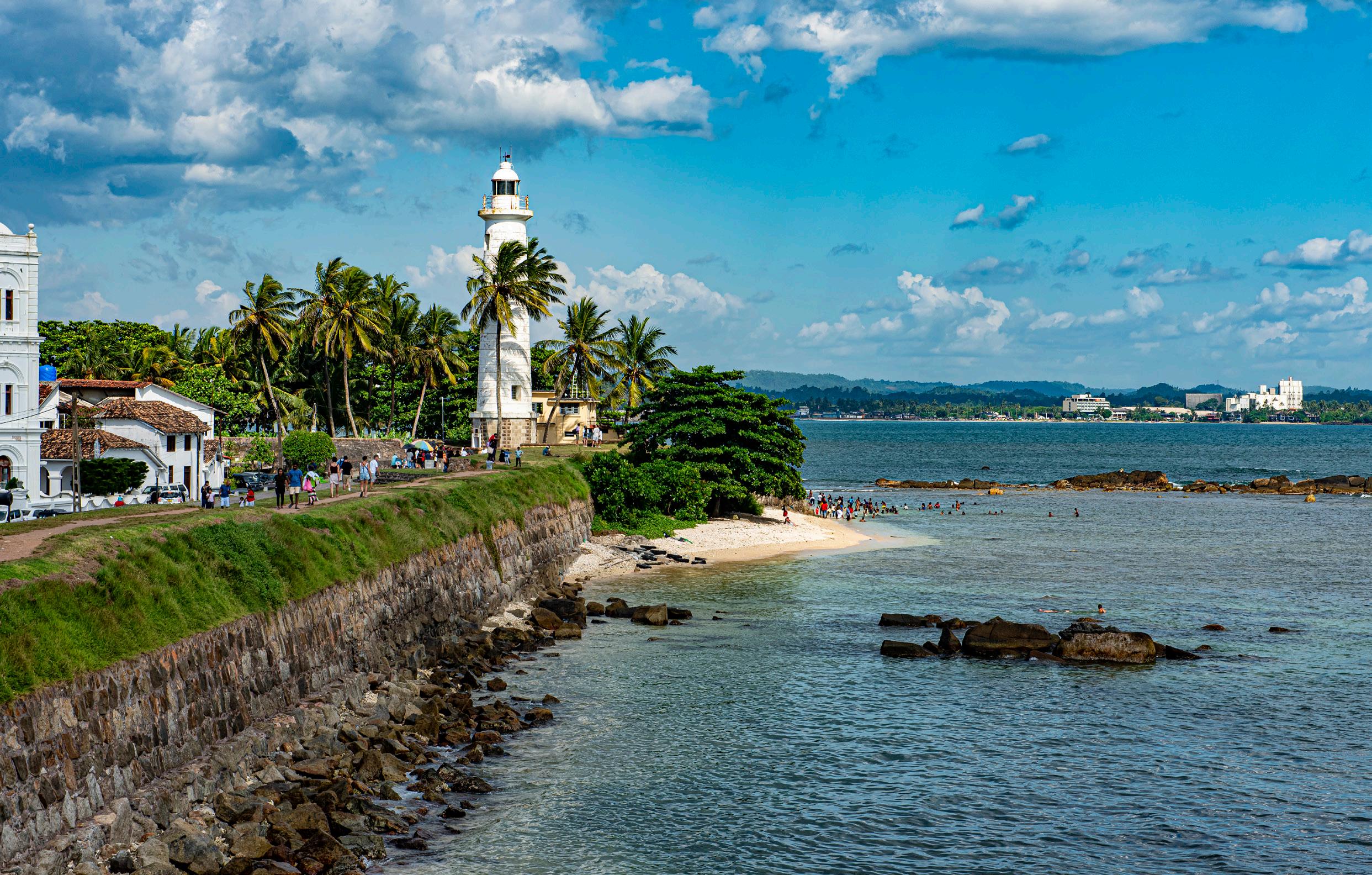
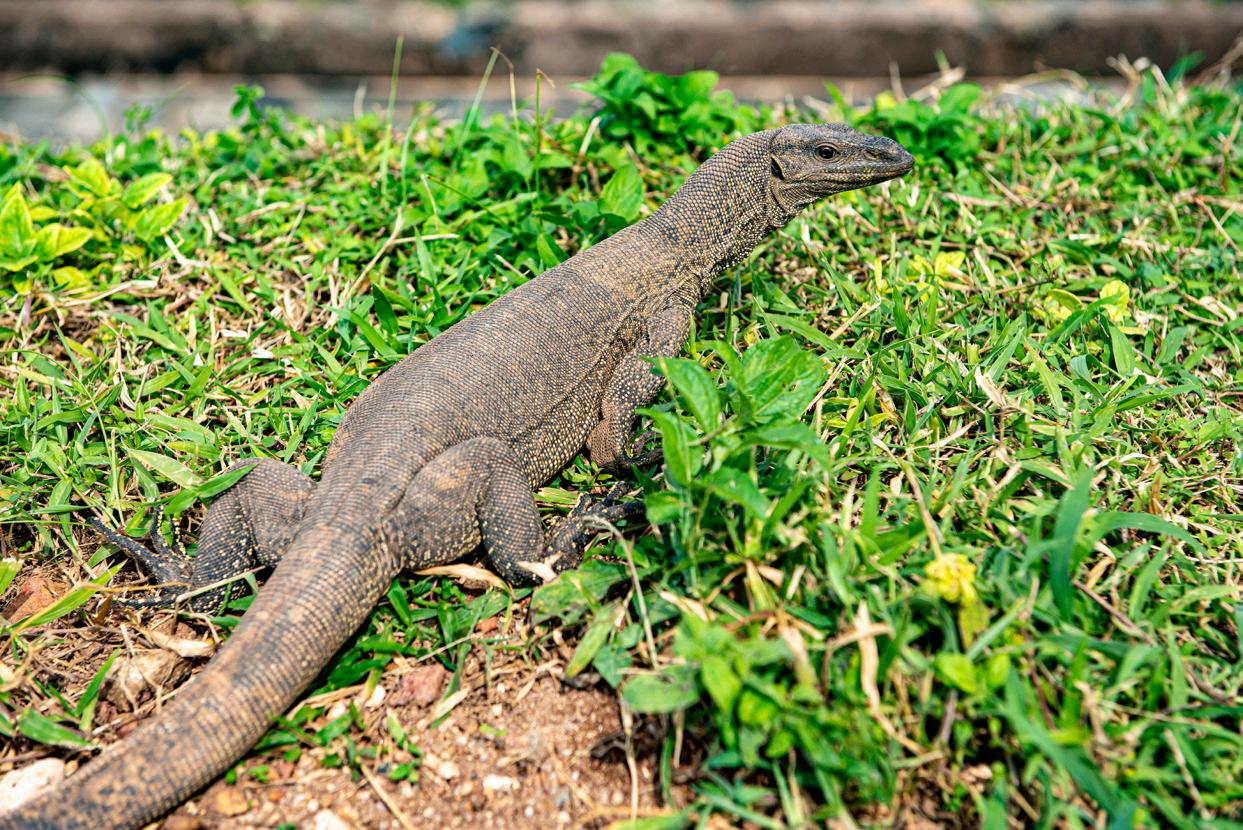
building materials, some vehicles, and I later found out there were old-school computers, a printer and air conditioners up by the galley and the bridge. Penetration on this wreck is for the more advanced wreck divers, but there is a staircase and wheelhouse for some fun exploration for those less experienced. We came across a gorgeous marbled electric ray (Torpedo marmorata) which was the first and only elasmobranch species we got to see. The dive guide said that they had a whale shark on their dive the day before, so it really is a matter of luck. Our safety stop was done with some inquisitive batfish (Platax teira).
Compared to the Pecheur Breton, this wreck

only had a few Tubastrea hard corals which I had expected more of being in such close proximity. Both wrecks are reputed for strong currents but we were lucky on both counts to have had some very relaxed conditions and some better than average visibility.
GALLE FORT
After our lunch at Pink Salt, we packed our almost dry dive gear away, said our farewells and hit the road to Galle Fort, a UNESCO World Heritage Site where we checked in to the very lovely Mango House Boutique Hotel & Restaurant for our next 2 nights. We highly recommend walking all around the fort’s outer walls, as it is very picturesque and a
great way to see much of the historic town. You also get to see the many monitor lizards roaming around the grassy outskirts which was a highlight if you like reptiles as much as I do. The Maritime Museum is also worth a visit, and we recommend eating at the very tiny Coconut Sambol restaurant on 68 Church Street for their home cooked all-you-can-eat curry clay pot buffet. Boasting quaint streets packed with small boutiques, cafes and bars, a full day’s exploring is enough time to see it all.
From Galle Fort, we drove 3 hours to the Sinharaja Forest Reserve where we booked our following 2 nights at the Rainforest Mount Lodge where wild peacocks run amuck.
97 MARCH 2024 | DIVERS FOR THE ENVIRONMENT
DESTINATIONS
DIVING
ABOVE: Galle Fort. BOTTOM ROW: The free roaming monitor lizards and peacocks of Galle Fort.
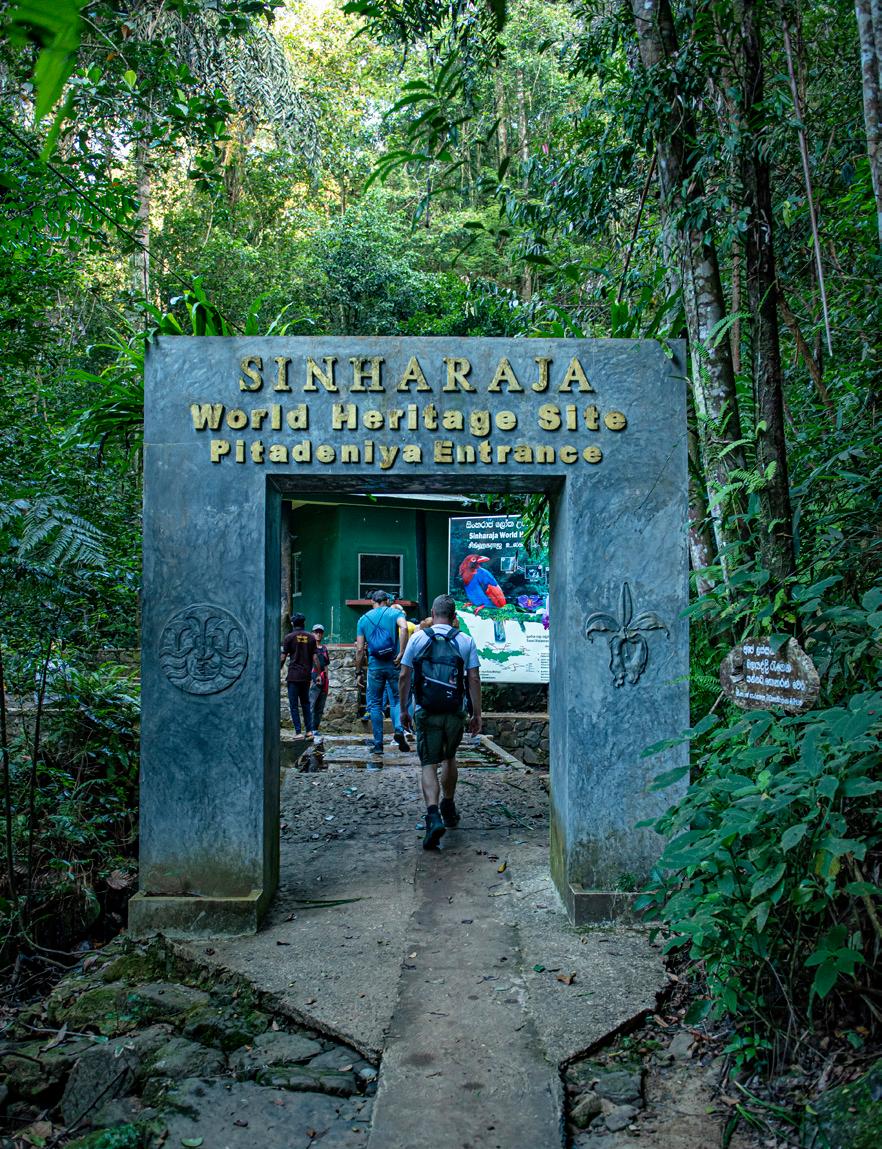

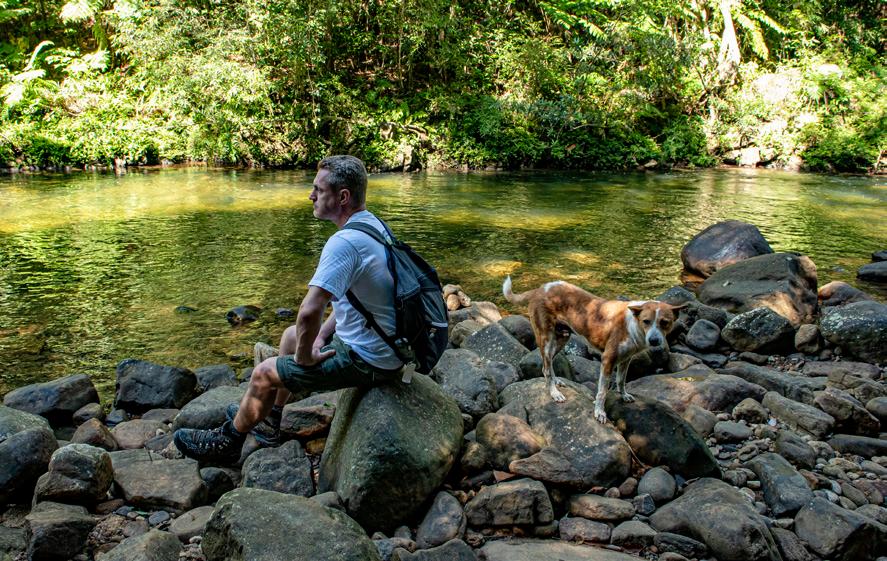
SINHARAJA RAINFOREST RESERVE
The Rainforest Mount Lodge is a family run business owned by Chamara and his parents. The lodge sits on a tea plantation with some spectacular views and a beautiful garden which is run by his father, while his mother cooks all the meals and looks after her garden flowers and spices for her kitchen. Mama, as she is affectionately referred to, makes the best Sri Lankan curry which we made sure to preorder both nights we were there.
Chamara runs the hikes and overall business and has a formidable knowledge of all the flora and fauna of the Sinharaja Rainforest which is a world heritage and biodiversity hotspot. We made friends with most of the dogs here and were accompanied for the duration of the hike which is said to not be great for the slim chance of spotting deer or the Sri Lankan leopard. We did see lots of different
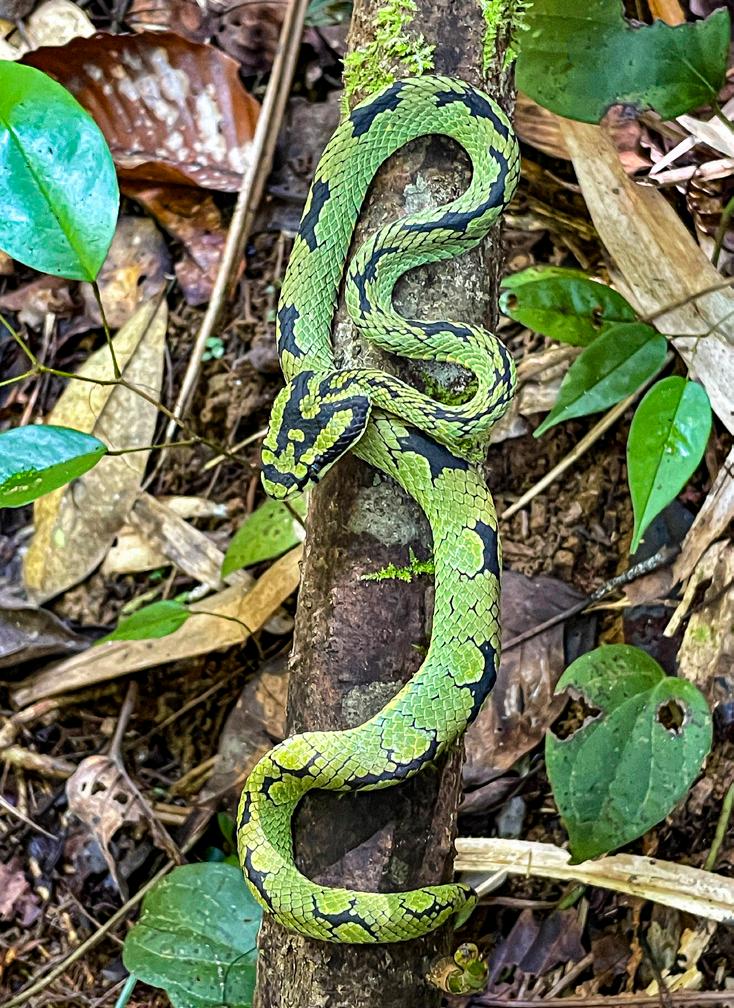
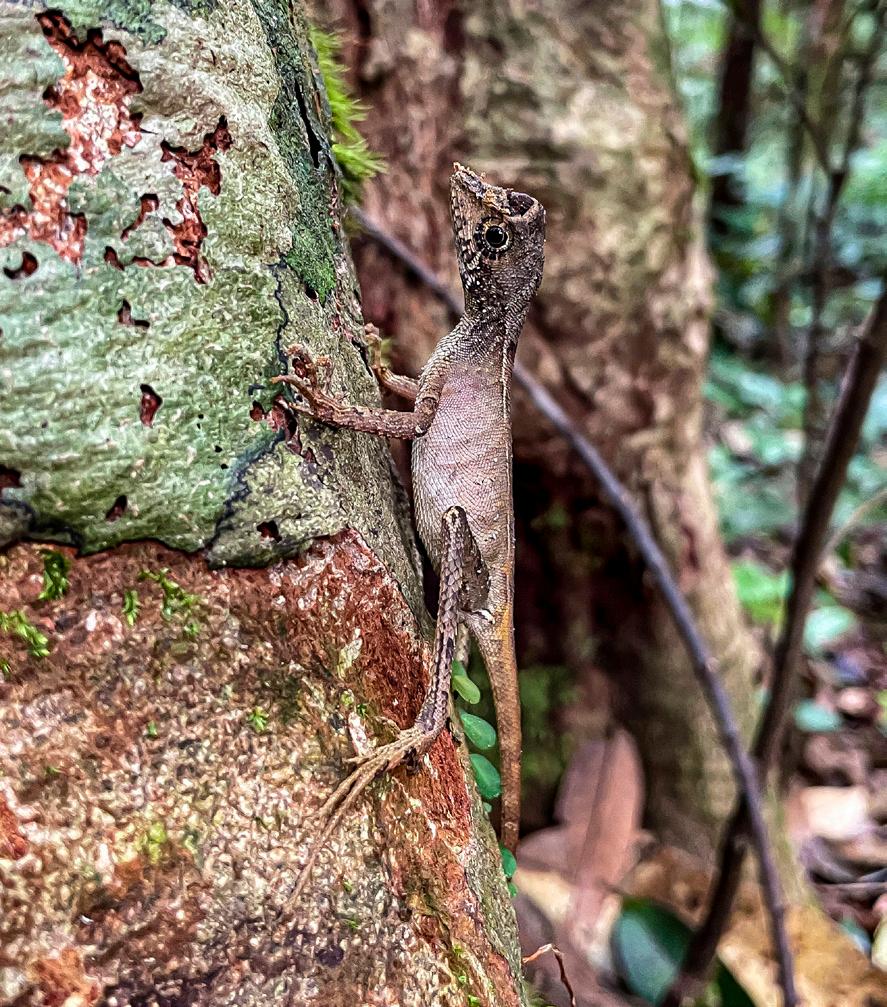
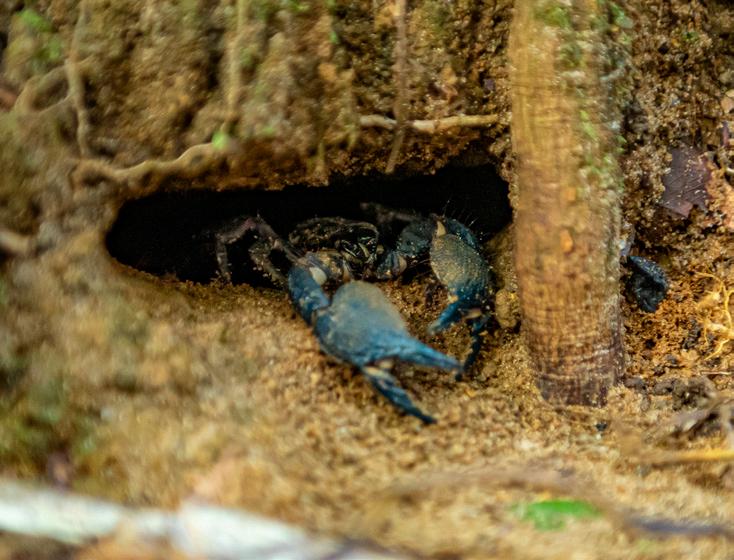
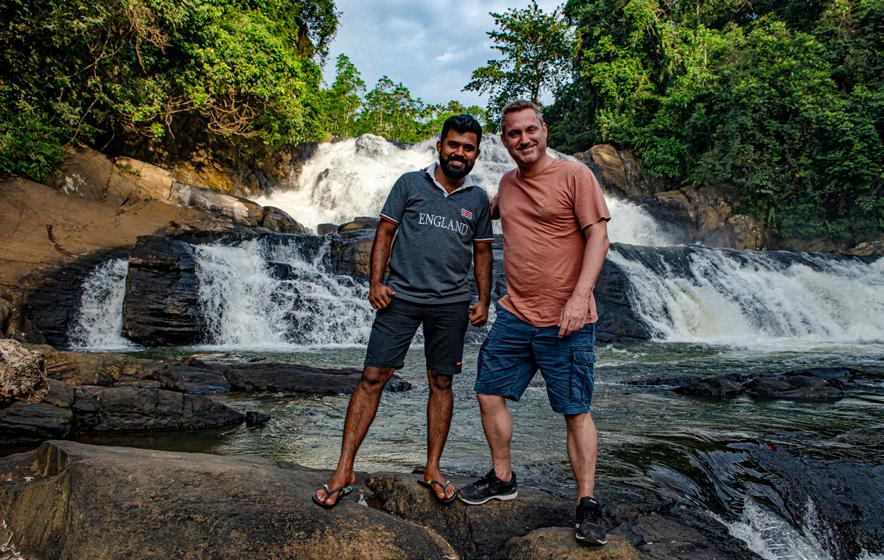
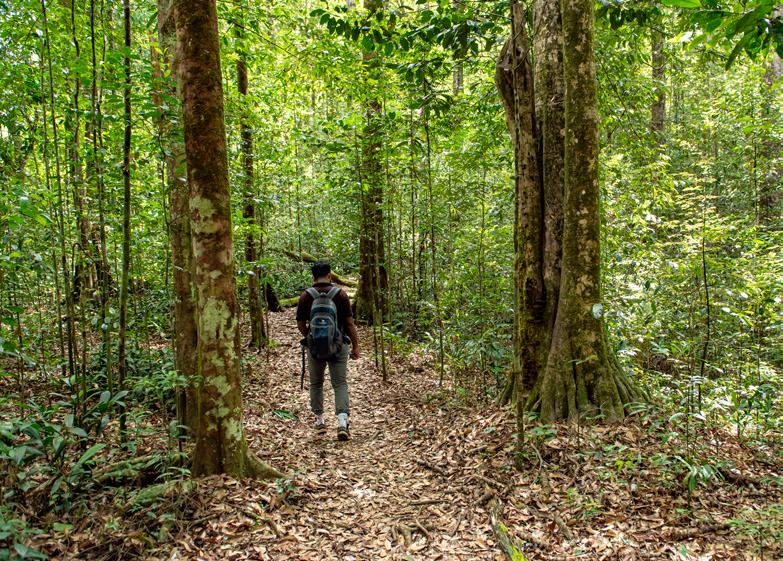
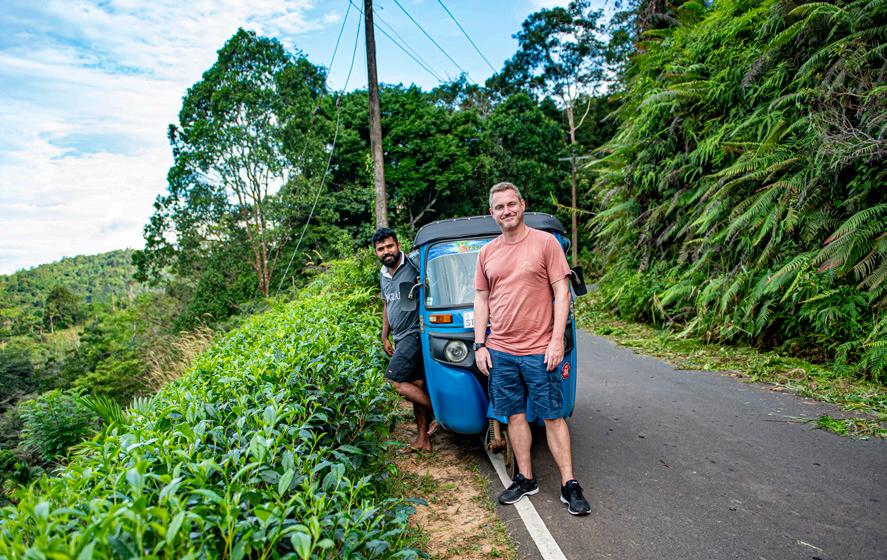
species of lizards, and our very first Sri Lankan kangaroo lizards at that, a stunning Sri Lankan pit viper, an evil looking scorpion that Chamara coaxed out of hiding, grey langur monkeys, and we heard the commotion of purple-faced leaf monkeys. We also saw how palm syrup is made by an indigenous couple that move around the forest to harvest the fruit and boil it down over a fire pit. The highlight at the end is a swim in the fresh waterfall pool. Swimsuits and towel are a must, and possibly some water shoes for walking over the rocks.
The hikes are available for all levels of fitness which are run as half day or full day treks. We booked the full day and it really was a first class experience. During the wet season you will want to be equipped with boot covers for leeches (we had brought them with us just in case), but this part of our trip was fortunately dry, though we had salt rubbed
into our hiking boots as a precaution.
After the hike we asked Chamara if it was possible to visit the nearby hilltop temple we’d heard music coming from during a walk on the evening we arrived. He proceeded to treat us to a full on tuktuk tour of the surrounding areas, stopping at 2 stunning view points, introducing us to the monk at the temple and translated the visit to see all the temple’s paintings (there are only 3 famous artists in Sri Lanka that paint these murals) and statues (we made a LKR5,000 donation), and he then took us to see another stunning waterfall where we drank fresh King coconuts. An unxpected, but highly memorable experience!
TANGALLE
Next up was a 2.5-hour drive to Tangalle where we booked a stay at the beachfront Omia Resort. This is a lovely resort owned
98 DIVERS FOR THE ENVIRONMENT | MARCH 2024
DIVING DESTINATIONS
TOP ROW L-R: Entrance for the rainforest hike; Sri Lankan pit viper; Kangaroo lizard, endemic to Sri Lanka. MIDDLE ROW: Hump-nosed lizard; scorpion, Chamara showing us another stunning waterfall. BOTTOM ROW: Admiring the beauty with our four legged companion; Chamara leading the hike; The tuktuk tour.
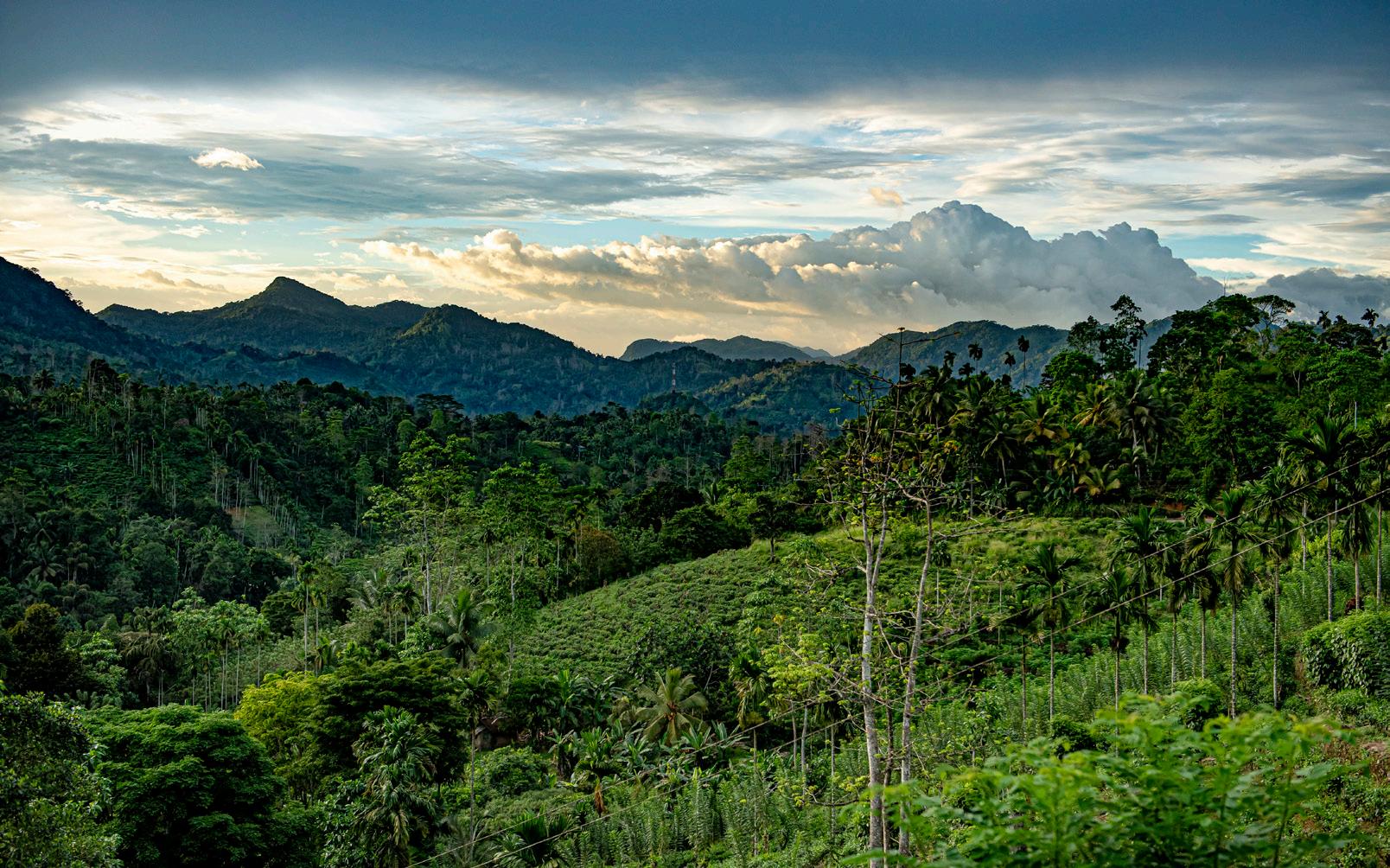
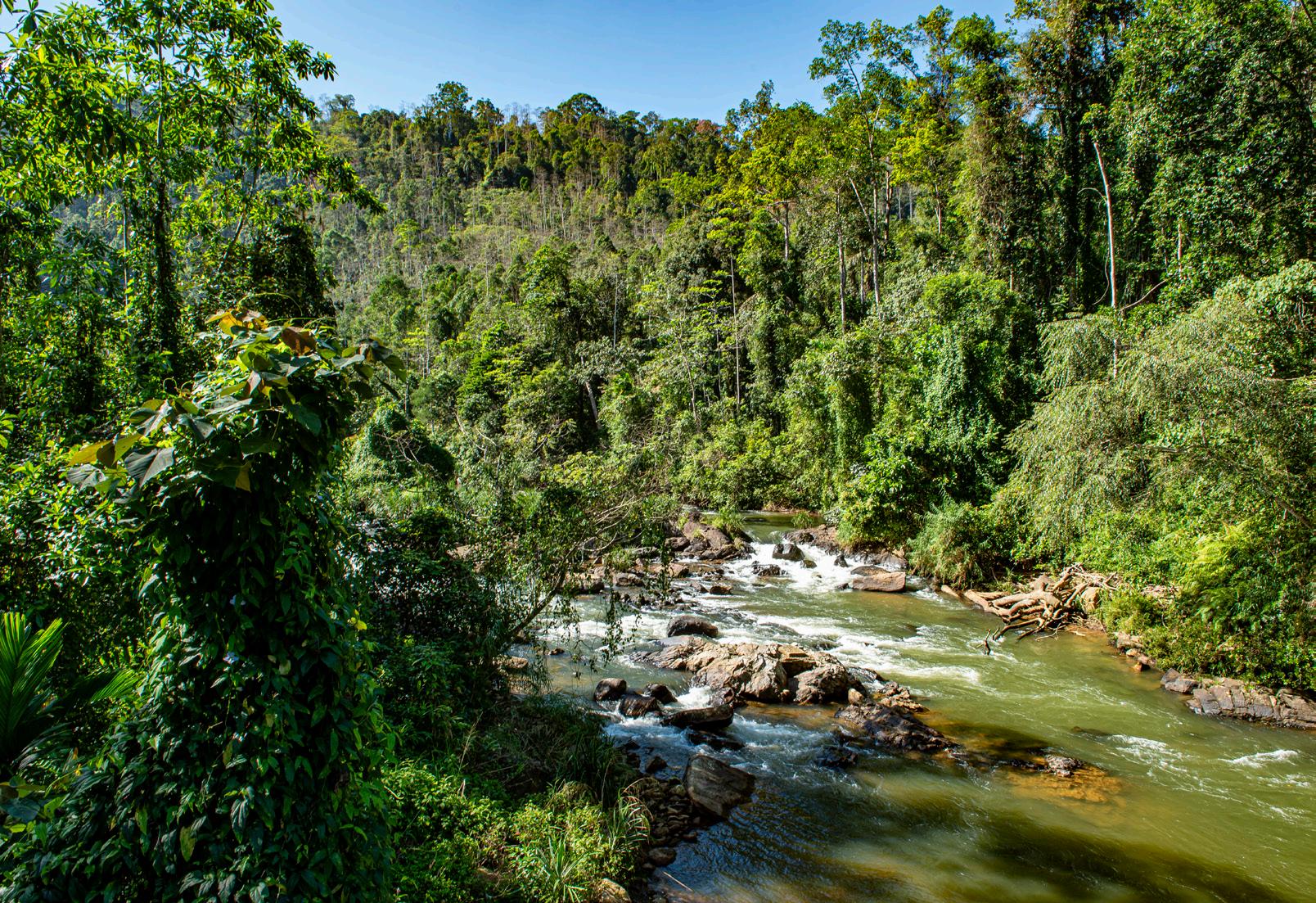
and built by a friendly expat couple on Rekawa Beach. It has a very tranquil setting as the centre of Tangalle is 8km away, and our room had a balcony with a stunning beach view. This choice was purely to unwind and relax as the next morning we were up at the crack of dawn to drive to Udawalawe National Park for a full day safari. We had not booked in advance for this part of our itinerary, but it just so happened that Chamara’s cousin Dusan ran a safari business at this very park. Chamara put us in touch, and we connected on WhatsApp to book it. It worked out perfectly for us and we were very well looked after as a private tour.
UDAWALAWE
NATIONAL PARK
This is the part of our trip where it rained cats and dogs for the next 24 hours! Amal came to pick us up, and we headed out at 4:30am to meet our jeep driver for the 6am park opening.
Our jeep thankfully had covers we could roll down or we would have been soaked through (camera and all) and we would most probably have cancelled the rest of the day’s 6-7 hour (full-day) tour as it got quite chilly. Another thing to remember here, is to ask your hotel the night before to prepare a packed lunch as the tour only provides fruit and water. Our hosts very kindly packed us a thermos with coffee to go with our sandwiches, fruit and carrot cake which was great to have when the rain got really heavy.
There is plenty to see on this trip, but elephants (up close and personal) and peacocks are guaranteed. We had a lovely encounter with a young male elephant who gave us quite a show as he lay down to roll around in the mud. You do need to ask your driver to stay clear of all the other jeeps as it can get very busy and they seem to like to stick together,
DIVING DESTINATIONS
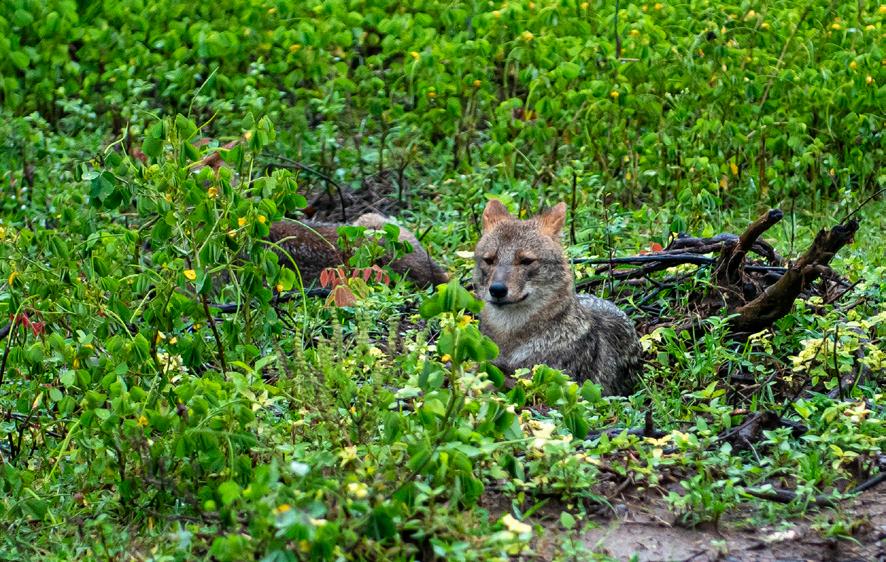

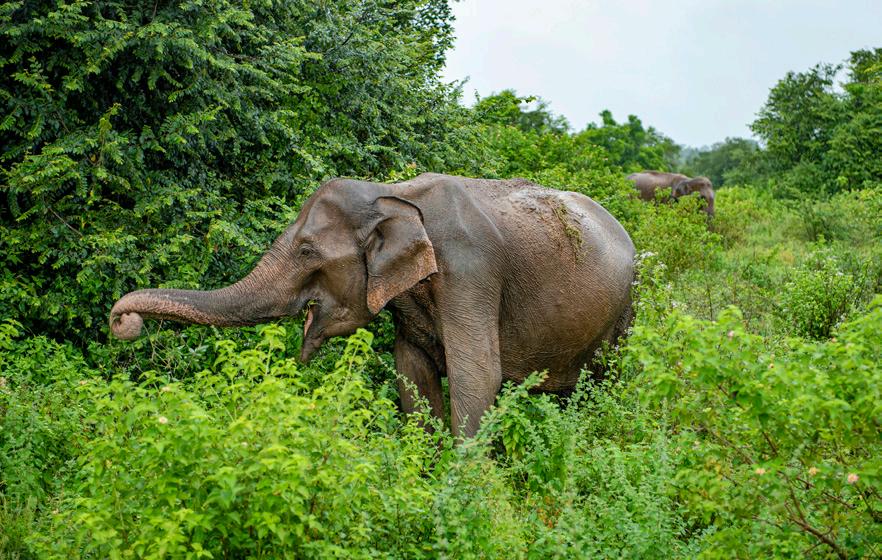

but we were very fortunate and ended up having the place mostly to ourselves for a lot of the safari. We saw Sri Lankan jackals, deer, water buffalo, toque monkeys, crocodiles, a huge water monitor lizard, and so many bird species that our driver was very knowledgeable about. He would open his bird book to show us the species in more detail which was great to fully understand what we were seeing from a distance.
On the way to the exit, our driver misjudged a very deep muddy ridge in the track and managed to get stuck. In all his efforts to try and get out, it was a no win situation with his very worn out tyre treads. Another vehicle soon showed up and miraculously pulled us out with tyres in worse shape than the ones on our jeep, much to our driver’s relief, as he was by now caked head to toe in mud. It was yet another great day for the memories!
99 MARCH 2024 | DIVERS FOR THE ENVIRONMENT
LEFT SECTION: Views of the lush green Sinharaja Rainforest Reserve and river, and surrounding areas with stunning tea plantations. RIGHT SECTION: Day at Udawalawe National Park with Sri Lankan jackals, toque monkey, elephants, and deer.
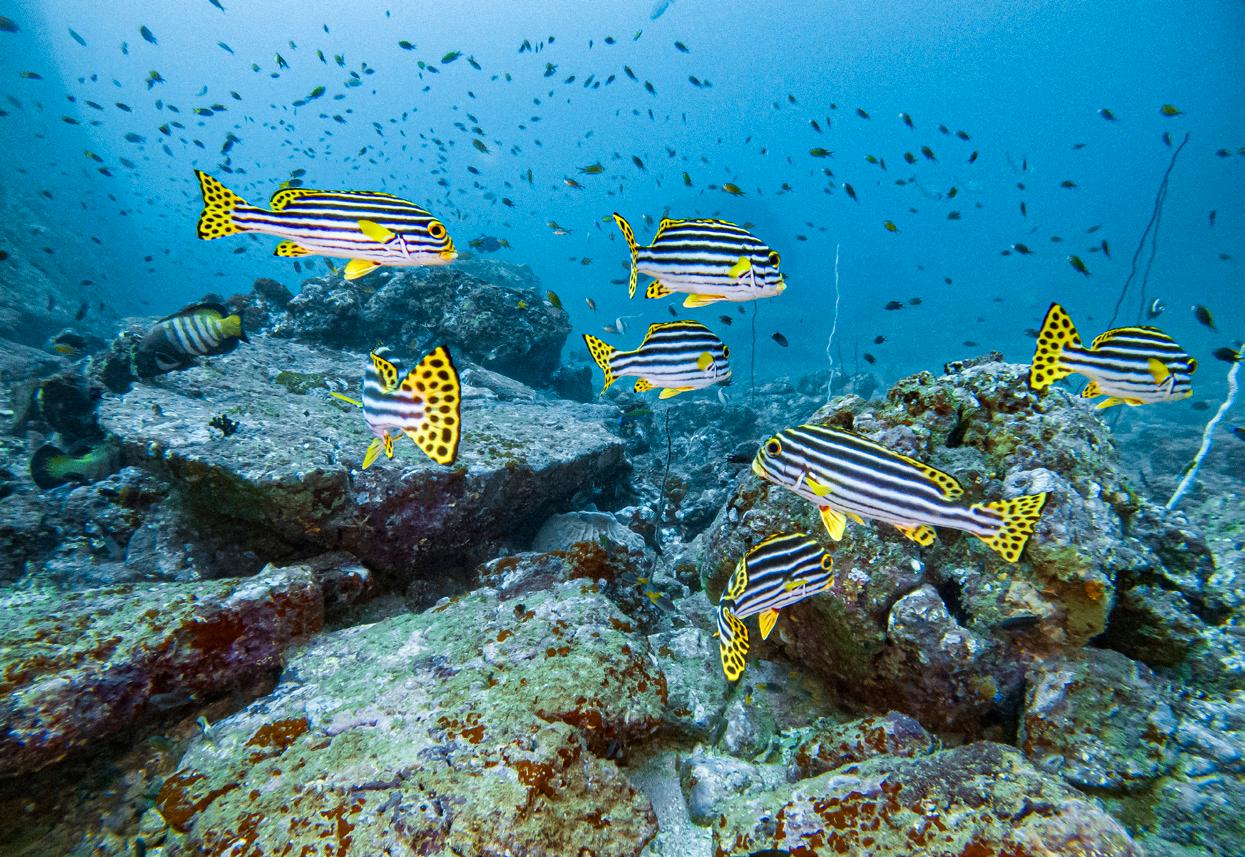

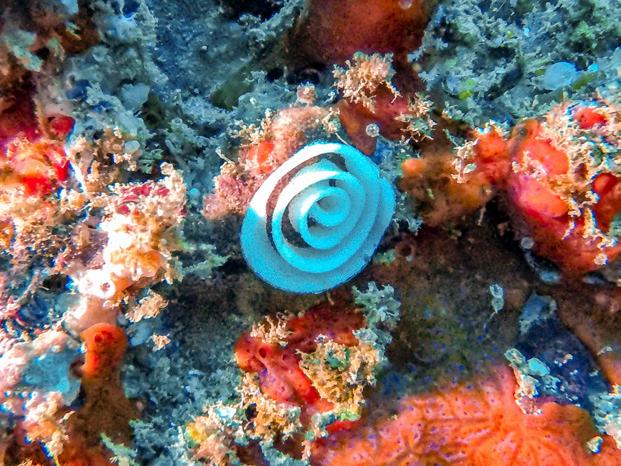


BENTOTA
Our last leg of the journey takes me back to where I started when I first came to Sri Lanka all those years ago - Bentota!
After our 3.5 hour drive, we checked into the idyllic Bella Vita Boutique Hotel which we found on Airbnb. We were met by our lovely Italian and Sri Lankan hosts, Susanna, and her husband Sanjeewa, and their son Luca. This is a relaxing, quiet and remote location, and you are going to eat well as they prepare freshly cooked Italian food – the pizza dough and pasta is all home made too.
For our dives the next morning, it was just a 10 minute drive over the Bentota Ganga river. I booked our dives with Lanka Sportreizen (LSR) at the Marina Hotel. I had been in touch by WhatsApp with Sujith, our dive guide, when we were still in Dubai to make sure we stayed in touch up to the day to make sure we were still good to go. We had sandstone and rock reefs planned for these dives, and the weather was great.
I didn’t recognise the dive centre at all as it’s a new location to the old one, just a few metres

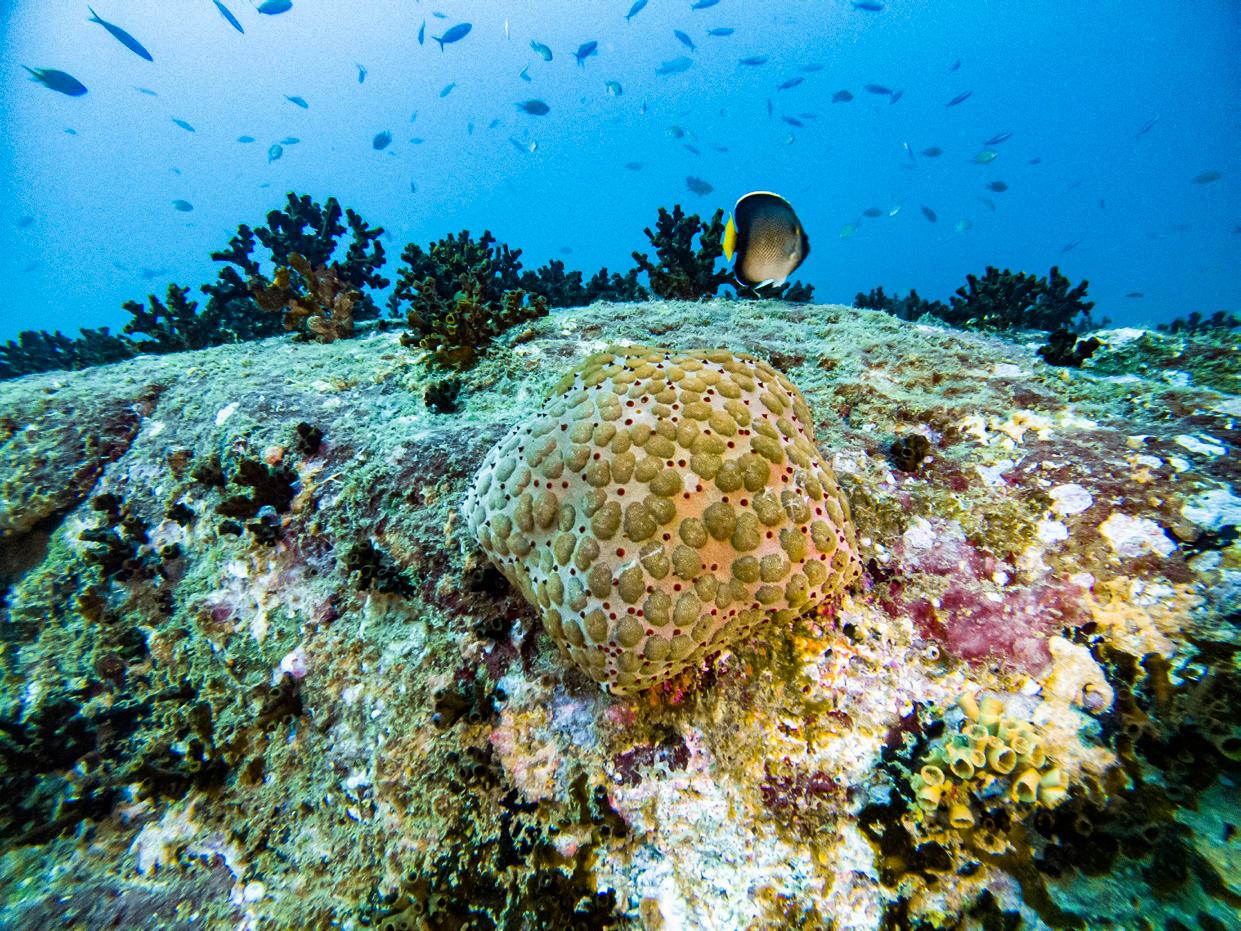
along the stretch, but it just so happens to be exactly the same dive operator I dived with 18 years ago. Fred was our dive guide at the time, but Sujith was also there, and there is an EDA sticker in the shop front window which led to the trigger! Sujith made sure to point out the old location when we set off in the boat. What a small world!
SANDSTONE AND ROCK REEF DIVES
It’s very pretty taking the boat out from the Bentota Ganga river side. You need to brace for the slight impact when the boat hits the surf of the river/sea crossing, and then look out to the right to see the Barberyn Lighthouse –one of the landmarks I do remember.
I struggled to find any details online about dive sites in Bentota, so I left it to Sujith to suggest the best options for us to experience that day. It was New Year’s Eve, and it was surprisingly quiet everywhere. We happened to only be three divers onboard with 2 dive guides. Sujith took us only as the other diver was newly certified Open Water.
Our first dive was to Modoun which is 8-28m deep. Macro photography will be more
enjoyable for photographers around Bentota as the visibility can be limited and the marine life is more dispersed. I found 3 nudibranchs that I have not seen before, and I found a spiral of nudibranch eggs, so getting in for a closer look will reveal a lot more.
I also found a very warty looking cushion star with a colouring I’ve not seen before (Culcita novaeguineae), lots of cleaner shrimps, and a teeny tiny octopus (species unknown), but I couldn’t get close enough due to its position in a deep crack between two rocks.You will come across lots of longfin bannerfish (Heniochus acuminatus), island trevally (Carangoides orthogrammus), and it’s common to find titan triggerfish here (Balistoides viridescens). Fred had told our group visiting in 2006 the story of one that had bitten off the tip of a divers ear which I have always remembered, so I’m a little anxious when I see these big fellas as they get very territorial. There are various species of butterfly and angelfish, and quite a few soft corals. We also found a large ghost net at this site which will hopefully be removed by a group of caring divers.
Our second dive was split between two dive
100 DIVERS FOR THE ENVIRONMENT | MARCH 2024
DIVING DESTINATIONS
TOP ROW: Indian Ocean oriental sweetlips (Plectorhinchus vittatus); Bluespotted grouper (Cephalopholis argus). LEFT SECTION: Soft coral, nudibranch eggs, diving Mada, and cleaner shrimp. RIGHT: Cushion star (Culcita novaeguineae).

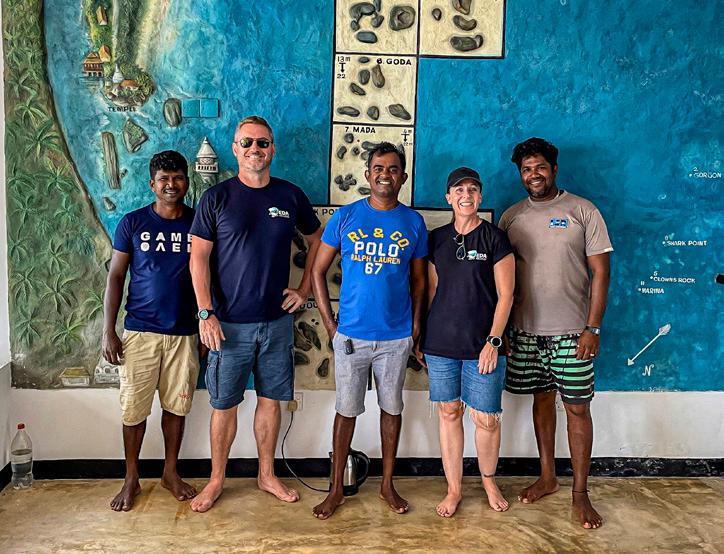

sites, Mada 4-22m and Atra Caves 13-24m. We saw the very beautiful Indian Ocean oriental sweetlips (Plectorhinchus vittatus) here, we saw a few stonefish, more bannerfish, a lot of lobsters at this site, island trevally (Carangoides orthogrammus), as well as lots of fusiliers and other smaller tropical fish.
All in all, it was a really fun day of diving and nostalgic for me. I enjoyed our conversations with Sujith, it was good to be back.
We rinsed all our dive gear and left it to dry while we got a boat ride over to Pier 88 which is a good spot for lunch. Back at the dive centre afterwards, we packed our dive gear, said our farewells and headed back to our Airbnb for the festivities of New Year’s Eve.
Susanna and Sanjeewa had invited us to join their family New Year’s Eve plans together with their son Luca, Sanjeewa’s mother, and two of their close friends. Sanjeewa had organised a boat over to Bentota Beach which is next door to the Dharmadeepa Aranya Senasanaya temple to get a five-star view of all the hotel resort firework displays – and much to my happiness – with a backdrop of fireflies. We
couldn’t have imagined a better way to ring in the new year.
COLOMBO
We checked out at 11am on the 1st of January 2024, and Amal drove us to Colombo for the day to see the Colombo National Museum which we enjoyed, and when we asked which Buddhist temple to visit, he recommended the Kelaniya Raja Maha Viharaya Temple, which was superb! It was busy, it was raining, it was hard work walking around barefoot in the course wet sand, but it was well worth seeing the reclining Gautama Buddha and the stunning paintings by native artist Solias Mendis, which depict important events in the life of the Buddha. We got just about everything we wanted for this trip with hiking, wildlife, diving and culture.
Amal dropped us off at the Mövenpick Hotel as we had read some really good reviews for the rooftop bar. It had zero atmosphere, a very limited menu, and it’s not covered for rain, so we ran over to the Granbell Hotel rooftop bar for a drink and dinner with a great atmosphere, and a much better city view, before heading to the airport at 11pm. We timed it all perfectly. A holiday well spent!
DIVING DESTINATIONS
TRAVEL SUGGESTIONS
VISA
Purchasing your visa online helps speed up arrivals. We used Global Visa Services (GVC) a week before the trip, but it can be done in as short a time as 5 hours from here:
https://bit.ly/4bpHFFA
CASH
Exchange Cash at the airport to acquire Sri Lankan Rupees (LKR). Most places accept card payments, but smaller premises and drivers will not. Due to the troubled economy, switching Sri Lankan Rupees back to local currency is difficult, if at all possible – depends on the size of the notes, not the overall amount.
DRIVER RECOMMENDATION
WhatsApp Amal for enquiries: +94 77 777 8271
Amal can be available anywhere in Sri Lanka for a minimum of 6 days. Advised to book as early as possible.
DIVE CENTRES
COLOMBO – MOUNT LAVINIA
Island Scuba
https://islandscuba.net
Email: dive@islandscuba.net
BENTOTA
Lanka Sportreizen (LSR)
Located at the Marina Hotel
https://lsrtravel.com/diving-watersports/ diving
Sujith Sanjeewa: MSDT Instructor
Email: LSRdive@sltnet.lk
ACCOMMODATION
COLOMBO – MOUNT LAVINIA
Beverly Suites Mount Lavinia
www.beverlysuites.lk
(7 min drive to Island Scuba)
FOR SUNSET ROOFTOP VIEWS: Mount Lavinia Hotel www.mountlaviniahotel.com
DINNER & LIVE MUSIC:
Catamaran Beach Restuarant www.instagram.com/catamaranbeachrestaurant
GALLE FORT
Mango House
(Boutique Hotel & Restaurant)
https://gallefortmangohouse.com
SINHARAJA FOREST RESERVE
Rainforest Mount Lodge
https://rainforestmountlodge.com
TANGALLE
Omia Resort
https://www.google.com/travel/hotels/s/ HTkBAp5QW5RPdVqV8
Email: omia@omiaresort.com
BENTOTA
Bella Vita Boutique Hotel (10 min drive to Lanka Sportreizen) https://bit.ly/42NPq43
101 MARCH 2024 | DIVERS FOR THE ENVIRONMENT
TOP ROW: Our group in 2006 with Sujith in the blue T-shirt, and today in the new dive centre location with Sujith in the light blue T-shirt and his team. ABOVE: A selection of faded stickers adorn the shop door window, the old EDA logo amongst them.

THREE DAYS OF DIVING THE DAYMANIYATS
FEATURE TONY SIDGWICK PHOTOGRAPHY ALLY LANDES
Abundant marinelife, exceptional visibility and expansive reefs combine to make these enchanting islands one of the GCC’s most popular diving destinations.
The healthy corals at Turtle City.
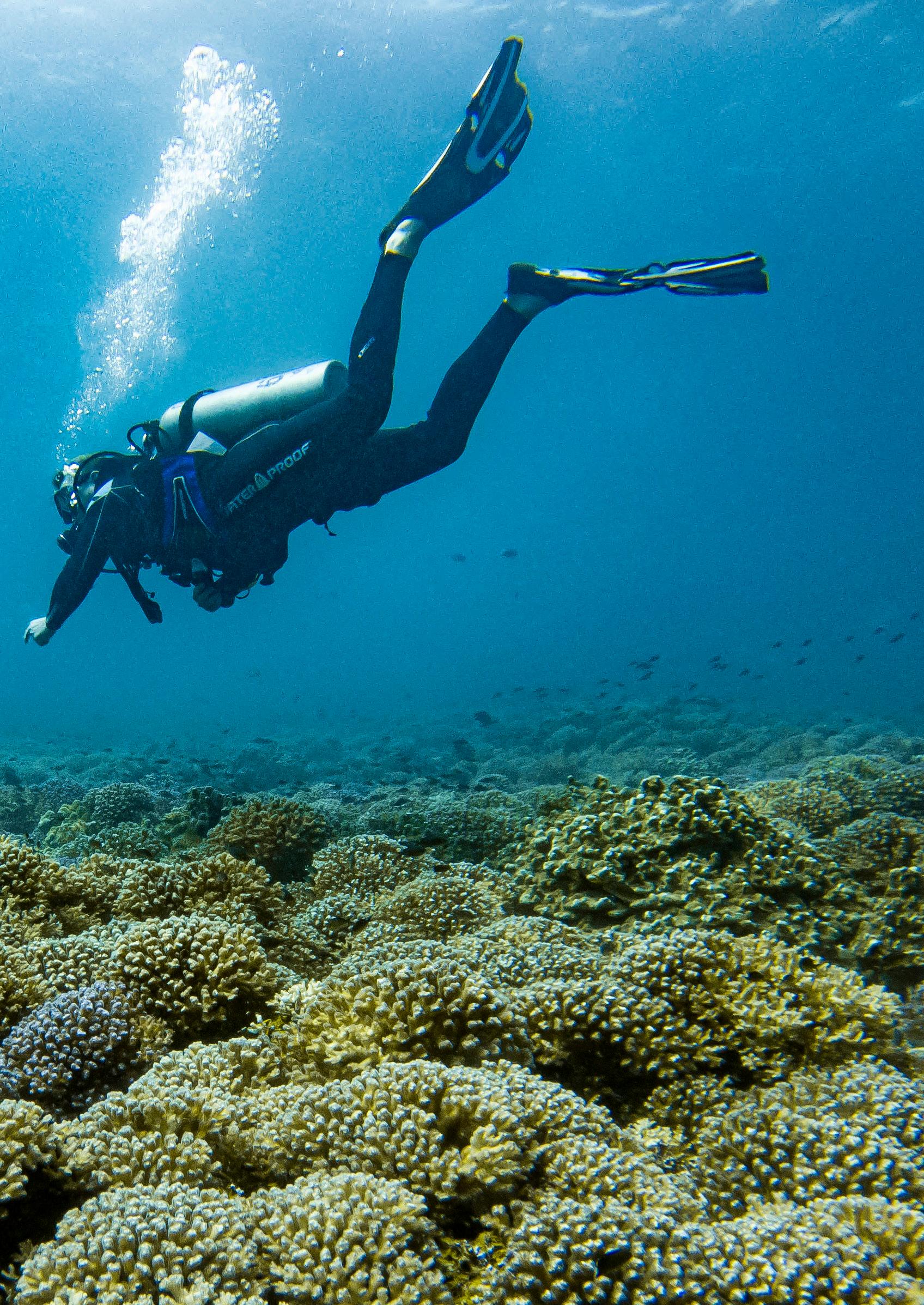




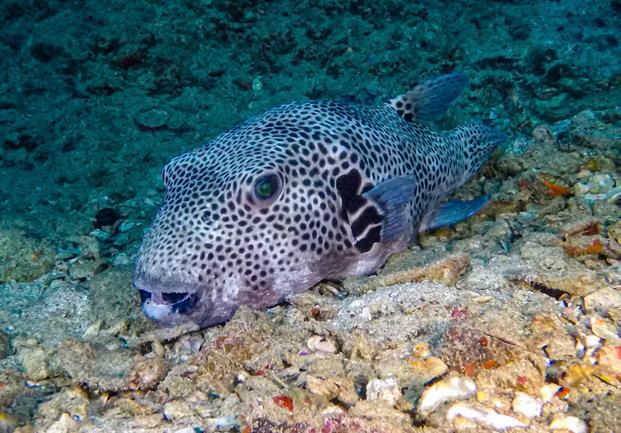
The first thing that strikes you on your approach to the Daymaniyats is the brilliant emerald green of the seas surrounding the island. The next is the glistening white sand of the idyllic beaches scattered across the archipelago.
As you approach your first dive site, the last thing to take your breath away is the water so crystal clear you can see the reefs passing under your boat 10m below the surface.
You have arrived at one of the GCC’s true diving gems.
A protected marine reserve in the Sultanate of Oman, the Daymaniyat Islands lie about 18km off the coast of Seeb, a short drive west of the capital city of Muscat. The reserve is composed of nine islands with a total area of 100 hectares (250 acres), with a rich natural heritage including several rare kinds
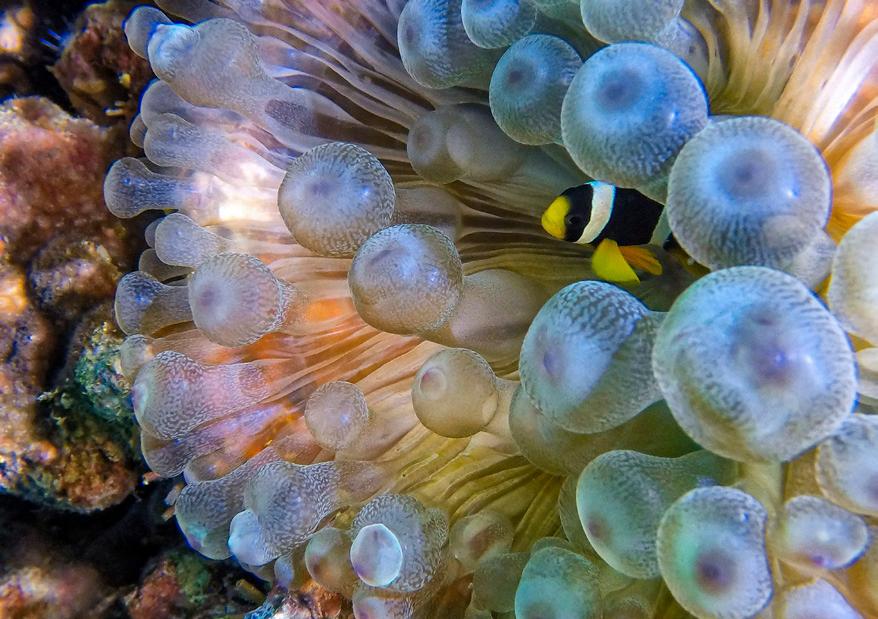


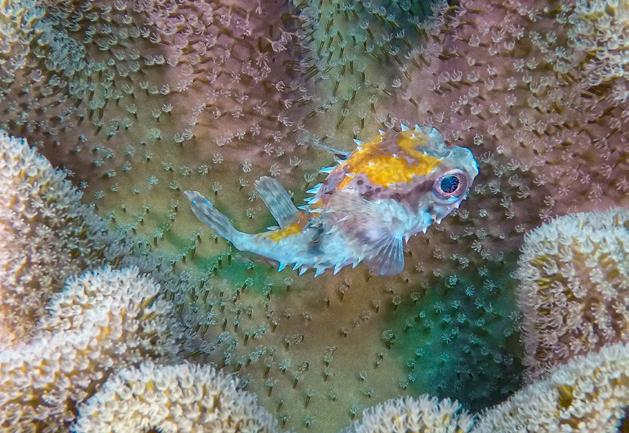
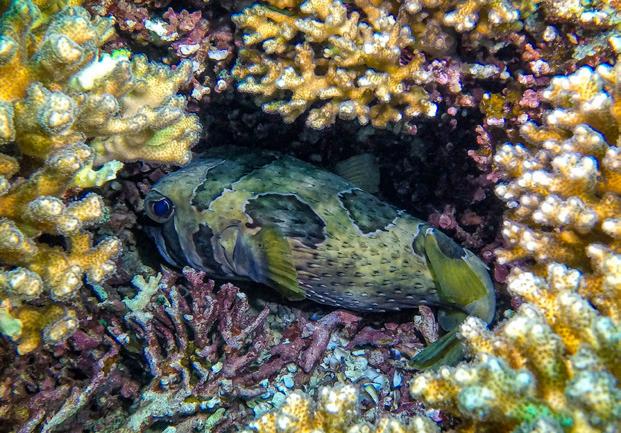
of reef, nesting sites for a large number of sea turtles, and a stop-off for migratory and indigenous birds.
Approval of the Ministry of Environmental Protection and Climate Affairs is required to visit the islands, which is usually arranged through the tour operators. In our case, it was the MolaMola Dive Centre operating out of Al Mouj Muscat, a coastal development close to Seeb International Airport.
Having visited the Daymaniyats ten years ago, it was disappointing to see the amount of rubbish visible on the beaches at the time, despite their protected status.
However, a recent tightening and improved enforcement of the laws by the Ministry of Environmental Protection and Climate Affairs, as well as an increase in prices for visitors, has
done wonders for the islands.
We saw almost no rubbish at all, either on the beaches or in the water, though, there are, unfortunately, quite a few ghost nets spread across the reefs which are illegal to remove for fear of damaging the fragile corals.
DAY ONE
A 40-minute boat journey from Al Mouj Marina brought us to our first dive site of the trip, the Three Sisters.
So named thanks to three large rocks which dominate the site, the dive progresses along a shallow wall with large boulders covered in hard and soft corals, which are interspersed with some nice colourful reefs and a small cave to explore. There is lots to see on the way, including box fish, pufferfish, lionfish, pipe fish, morays, turtles and more.
104 DIVERS FOR THE ENVIRONMENT | MARCH 2024
DIVING
DESTINATIONS
L-R: Divers at Juno’s Trace; Clownfish; Blenny; Scorpionfish; Blotched fantail ray(Taeniura meyeni); Cowtail stingray (Pastinachus sephen); a species of boxfish (Ostraciidae); and different species of pufferfish (Tetraodontidae).
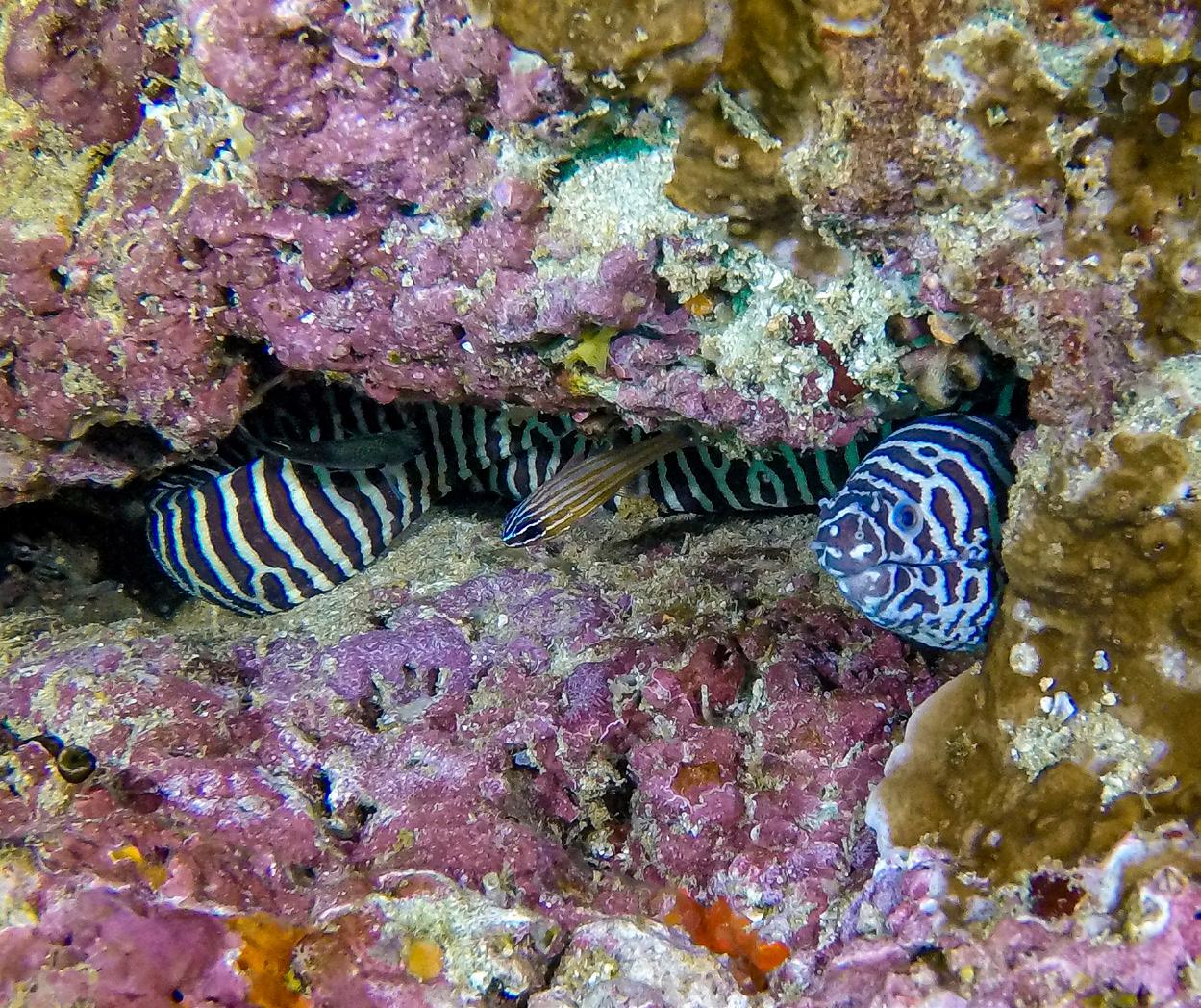



It’s a pleasant, easy dive with plenty to take in, but it was also to throw up one of our first surprises of the trip, as we rounded a large boulder to encounter a two-metre-long leopard shark resting on the sandy bottom. It suffered our presence for a few precious minutes before lifting off and swimming away, but this was only a taste of things to come…
Next up was Titto’s Run, a reef lying north off a small island in the archipelago with a similar topography to Three Sisters, large boulders, reefs boasting colourful hard and soft corals, and some sandy bottom. Plenty of lionfish to be seen here, amongst the other reef fish common to the area, but largely an uneventful dive.
DAY TWO
Our second day of diving started dramatically as we left the harbour to see an ominous black
cloud hanging over the horizon. Fortunately, we passed under the stormy weather front without incident, but just in time it seems!
As we looked back, several waterspouts (a kind of ocean-borne tornado, potentially lethal for small boats) began to form over the water. These are first indicated by points of twisting cloud which begin to reach down towards the ocean’s surface. Below them, a violent whirlpool forms, and eventually the two join to form a dramatic column of spinning water hundreds of feet high.
We watched awestruck as several of these extraordinary weather phenomena formed and dispersed in the span of twenty minutes or so, before the weather front disappeared over the coastline. A dramatic start to the day!
Our first dive of day two took us to Coral
Garden, so named because of its expansive and breathtaking bed of hard corals stretching for hundreds of metres. Unfortunately, there is quite a bit of damage to see on the reef, most likely from careless anchors, but thankfully most of the coral is still intact.
We spotted several different species of moray eel here, including yellowmouth, honeycomb, undulated and geometric morays, which are always a pleasure to see, but the star of the show was definitely our second leopard shark of the trip, a big fellow resting on the seabed coming in at almost three metres in length. We then spotted another on the seabed only a few minutes later, and I caught another smaller leopard shark of about 1.5m swimming over the reef, but I was the only one to see it, so nobody believed me…
Our next site of the day was Turtle City, with
105 MARCH 2024 | DIVERS FOR THE ENVIRONMENT
DIVING DESTINATIONS
L-R: Zebra Moray (Gymnomuraena zebra); Undulated Moray (Gymnothorax undulatus); Yellowmouth moray (Gymnothorax nudivomer); Geometric Moray (Gymnothorax griseus).

DIVING DESTINATIONS
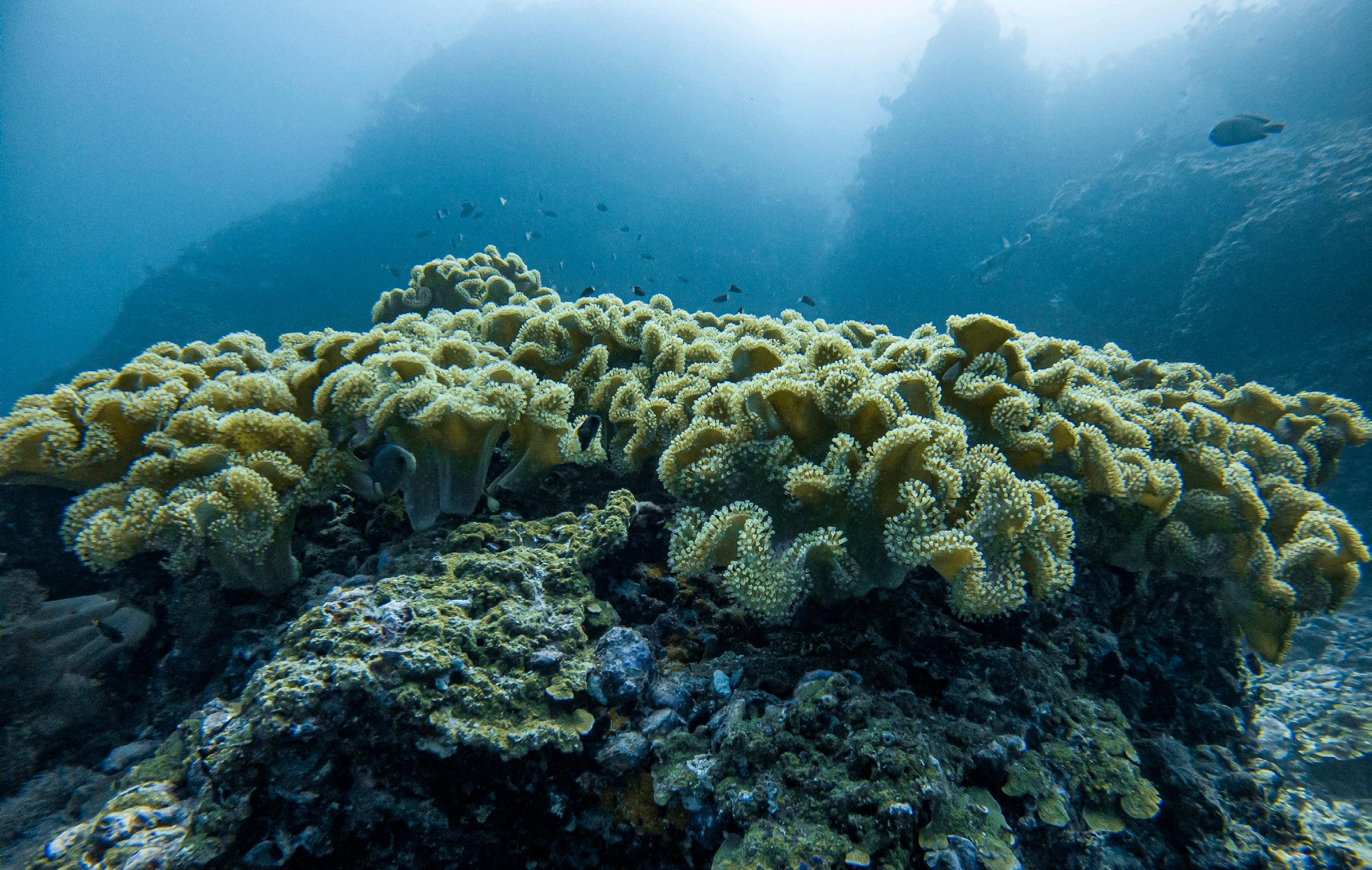
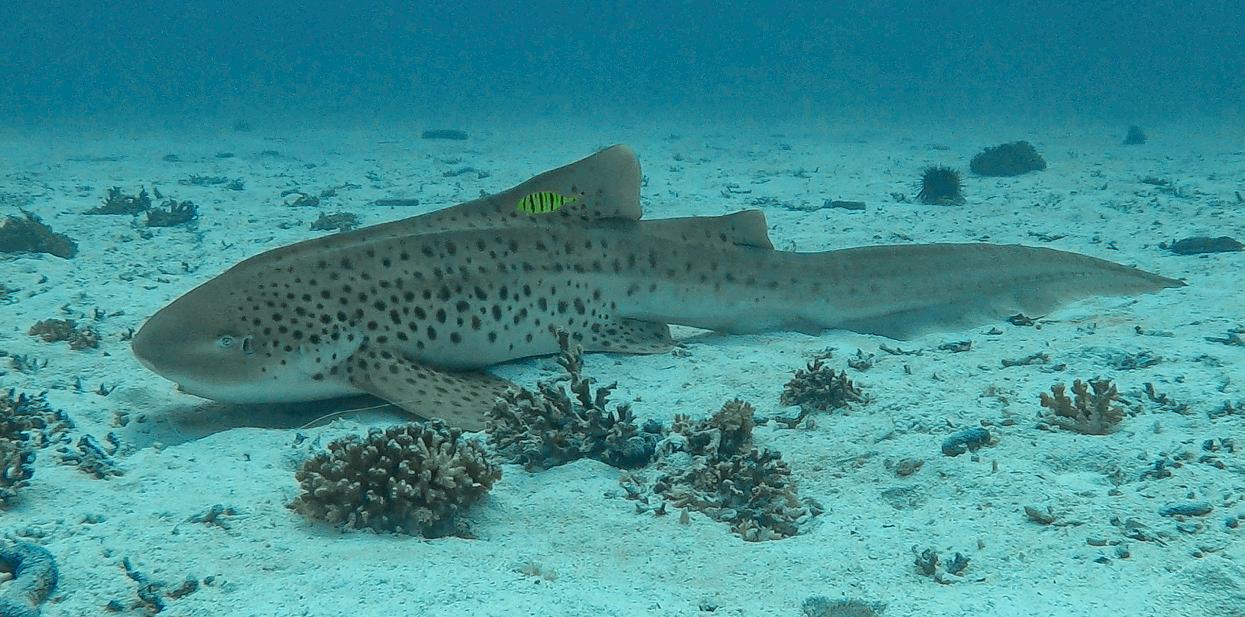


lots of hard and soft corals spread out on a sandy bed. As is usually the case, we’ve found, of sites so named, we didn’t see a single turtle. However, we did catch a gorgeous blotched fantail ray swimming by, as well as a few more large moray eels entwined around the corals posing dramatically for our photographs.
DAY THREE
Aquarium is basically a large underwater rock lying at about 22m depth on the eastern end of the Daymaniyats. Starting on the top at about seven metres, you descend around the side to swim along the rocks and reef around its base, where we instantly encountered a school of squid hovering in clusters around the rocky bottom. We also spotted some nudibranchs, a few more morays, including a lovely zebra moray, as well as a couple of scorpionfish on the seabed. The highlight of this dive, however, was a huge cowtail ray resting on the sandy bottom.
Our final dive of the trip, Juno’s Trace was, unfortunately, also the most uneventful. We ventured away from the rocks and reef in vain search of leopard sharks on the sandy bottom, to no avail. We did, however, spot a couple of scorpionfish sitting amongst the rubble on the seabed, a few more morays, and had an enjoyable encounter with a large green turtle as we neared our safety stop. Overall, the visibility was great, and it was a nice, relaxing dive to end our trip.
With Muscat being only a few hours’ drive, or a very short flight away from Dubai, any diver in the UAE who hasn’t visited the Daymaniyats yet should make it their next trip. If you’ve been there, you know. And you’ve probably been back. If you haven’t, you’re missing out! You can get two dives in during the first half of the day, leaving the afternoon and evening free to explore the scenic city of Muscat itself. It’s the ideal weekend getaway!
WE STAYED AT THE MYSK AL MOUJ HOTEL
A comfortable four-star hotel with fivestar facilities and service. The Mysk Al Mouj is more affordable due to its dry status, but those seeking lubrication can always visit the nearby Kempinksi Hotel Muscat, only a ten minutes’ walk away.
WE DIVED WITH
MOLAMOLA DIVE CENTRE
A well-run outfit with two sizeable and comfortable double-hull dive boats. MolaMola boasts a professional team of friendly and personable dive guides with considerable experience of the Daymaniyats.
www.molamoladivingcenter.com
107 MARCH 2024 | DIVERS FOR THE ENVIRONMENT
DIVING DESTINATIONS
OPPOSITE PAGE: Honeycomb moray (Gymnothorax favagineus). ABOVE: Beautiful soft corals of Titto’s Run. BOTTOM ROW: Leopard shark (Stegostoma tigrinum); Longfin bannerfish (Heniochus acuminatus); Green Turtle (Chelonia mydas).

MAURITIUS LUXURY DIVING
FEATURE AND PHOTOGRAPHY ANTHONY LEYDET
Mauritius is the perfect place to combine the joys of scuba diving, with the pleasures of discovering a most welcoming island, where nature offers a multitude of activities to delight everyone.
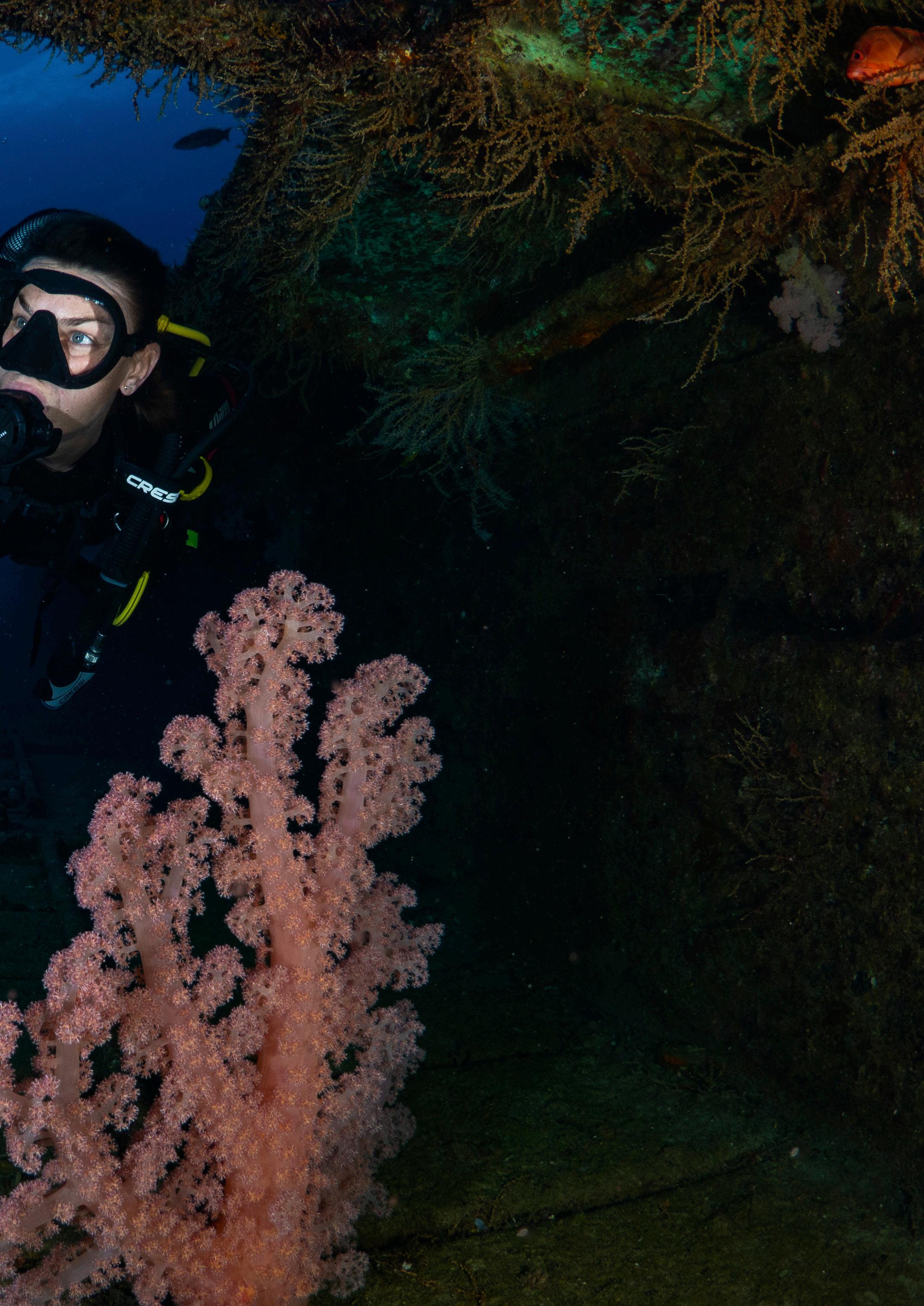

Although renowned as one of the most beautiful destinations chosen by newlyweds and families alike, Mauritius is also taking advantage of its position in the Indian Ocean to increasingly assert its offer in the field of scuba diving. With numerous shipwrecks serving as artificial reefs and a surprisingly generous fauna typical of the region, you'll find everything you need for a trip resolutely turned towards Nature and calm.
The Indian Ocean with its landscapes of unmistakable shades of blue and green, and its warm, festive atmosphere, is home to many dream destinations, including the Maldives, Seychelles and Mauritius. The latter, along with Rodrigues and Reunion Island, make up the Mascareignes archipelago, and is one of the most sought-after destinations for honeymooners. Its luxury hotels are generally well-integrated, respectful of nature and pampered, and bordered by heavenly beaches, offering a high quality rest and relaxation experience.
Of volcanic origin and surrounded by a coral reef, Mauritius has several diving areas along its 330km coastline. In the north, the majority of sites are concentrated near Trou aux Biches and Grand-Baie, and represent the most
renowned region for diving. Well sheltered from the wind and swell, there are calm sites and visibility often in excess of 20 metres.
From the sumptuous 5 Star Beachcomber Hotel on the endless Trou aux Biches beach, it takes no more than 10 minutes by boat to reach most of the dive sites behind the coral reef. The Diving World centre, set in the heart of the hotel and its tropical garden, boasts comfortable facilities just 50m from the beach, and offers the full range of recreational diving. Easily accessible, the dive sites are ideal for first dives and training courses, but will also be much appreciated by more experienced divers, as well as wreck and photography enthusiasts.
THE WRECKS OF TROU AUX BICHES BAY
To boost the attractiveness of Mauritian waters for divers, the authorities sunk several wrecks. The best known of these is the famous Stella Maru, a Japanese trawler sunk in Trou aux Biches Bay in December 1987. Surprisingly, she was originally sunk on her starboard side. But in 2002, Cyclone Dhina was so powerful that the swell lifted the wreck over, where she now sits perfectly upright! It’s a beautiful wreck, well colonised and in excellent condition. Schools
of snapper enliven the scene, as do the multitude of colourful species, but the most sensational are undoubtedly the big diodons that come to be cleaned around the mast and are easily approached by divers. Resting on the sand at 25m and starting at 17m, this wreck is easy to dive and accessible for all levels.
KT Mawar is another, more imposing wreck, lying on its starboard side on a 23m seabed. Sunk in 2018, it is now beginning to be well populated with some really interesting fauna such as some superb, perfectly camouflaged frogfish. A swarm of colourful soft corals are found along the ship and its mast which contrast with the still clearly visible sheets of metal. The ship offers some great penetration opportunities.
For some different dives, there are two small barges named Emily & Water Lilly that were sunk in 1981 and 1982 to a depth of 25m.They are a real treat for macro enthusiasts! There is a lot of life, including lutjans and butterflyfish, beautiful nudibranchs, a few porcelain crabs sheltered amongst the tentacles of anemones, tiny gobies and even leaf fish. If you look around on the sand, it's possible to spot a strolling mantis shrimp.
110 DIVERS FOR THE ENVIRONMENT | MARCH 2024 DIVING DESTINATIONS
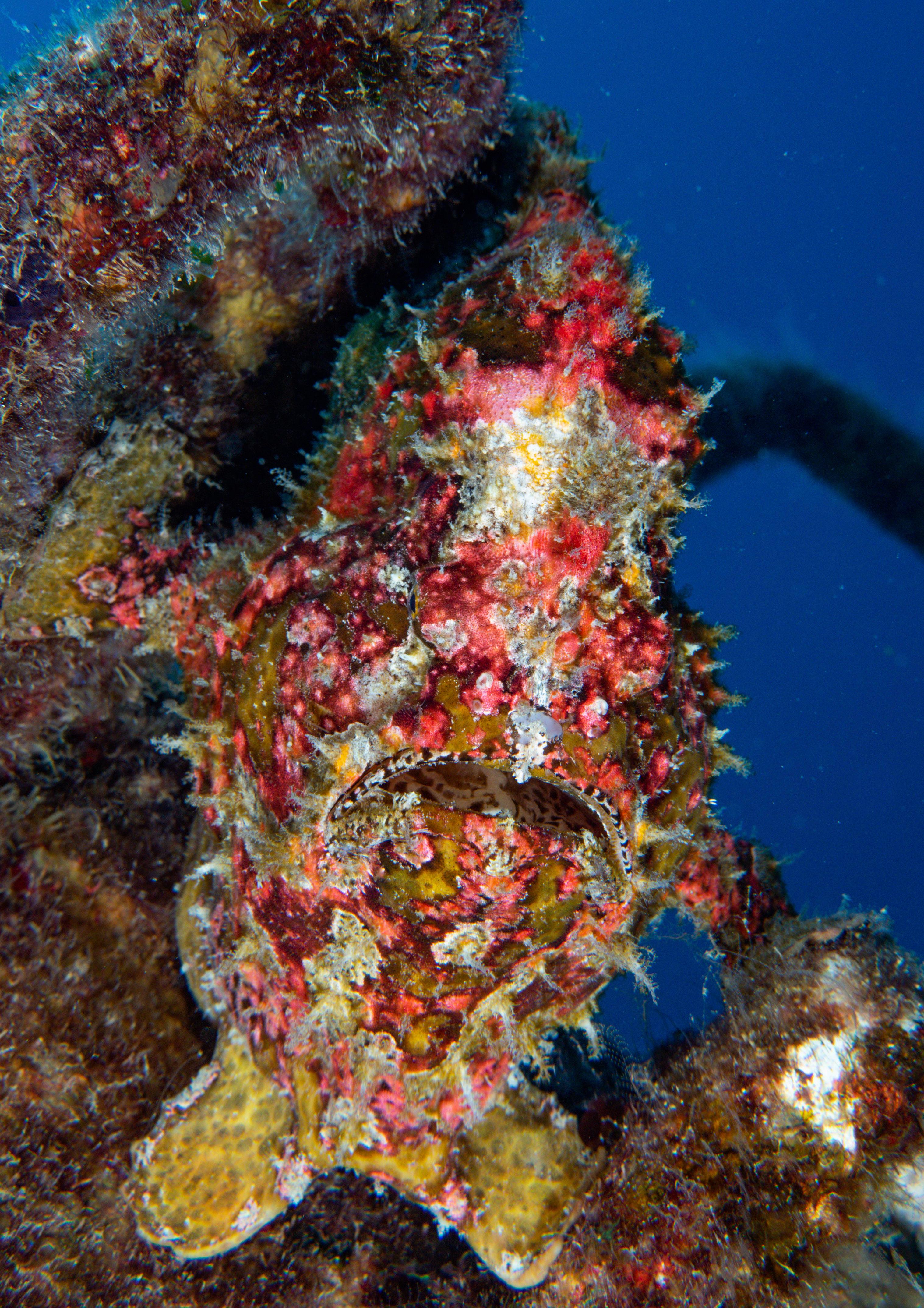
DIVING DESTINATIONS

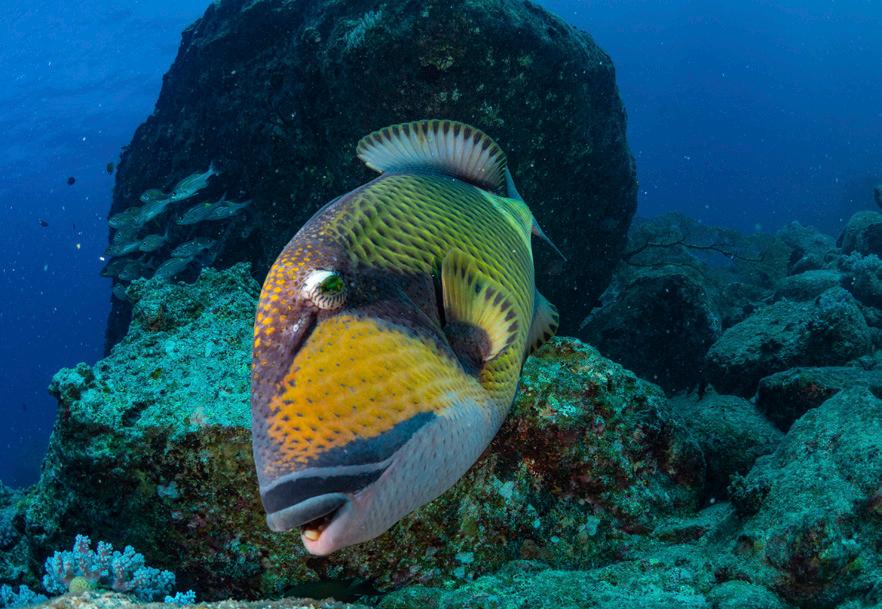



Last but not least, the Tawariq is also a beautiful wreck that can be entered for a thrilling experience. Fairly uncolonised, there are some nice schools of fish to be seen. A powerful cyclone has moved it several dozen metres, from its original location, leaving a wide furrow behind!
THE INCREDIBLE BIODIVERSITY OF MAURITIUS' REEFS
Discovering the seabed in Mauritius is full of surprises. With landscapes whose colours take on hues unique to the Indian Ocean, it's easy to find similarities with both the Red Sea and Southeast Asia beneath the surface. Although the coral cover may not be as extensive, the biodiversity is impressive. Your dive centre will probably take you to Coral Garden or Japanese
Garden. Wander amongst the corals in search of camouflaged species such as syngnathids, leaf fish and ghostpipefish, while schools of soldier fish and trumpetfish hide beneath the acropora tables. From time to time, the eye is drawn to a swarming ball in the hollow of a rock. Catfish are very common and always arouse curiosity. Will you catch one of the superb green turtles resting in the coral reefs? It's highly probable that you'll come across a few during your dives in Mauritian waters. As are hawksbill turtles.
Holt Rock, a little further north in the bay, offers a very different atmosphere. Here, the corals are replaced by large granite boulders, between which blossom superb, gigantic yellow gorgonians, some of which easily
exceed the size of a diver. Schools of striped emperors twist and turn with the rocks. A special guest makes an appearance,Tommy the Titan triggerfish, accustomed to encountering divers, and in the end far more docile than some of his congeners.
The Grand-Baie region, a few kilometres to the northeast, is the perfect place for a double dive to discover some remarkable reefs. Commonly known as "moray reefs", these relatively low rocky tongues stretch across the sand and are home to countless moray eels. Species such as the giant moray, the turkey moray, the geometric moray, the undulated moray, the zebra moray, and the incredible ribbon moray! Frogfish and ghostpipefish add to the list, not to mention the unexpected presence of the
112 DIVERS FOR THE ENVIRONMENT | MARCH 2024 DIVING DESTINATIONS
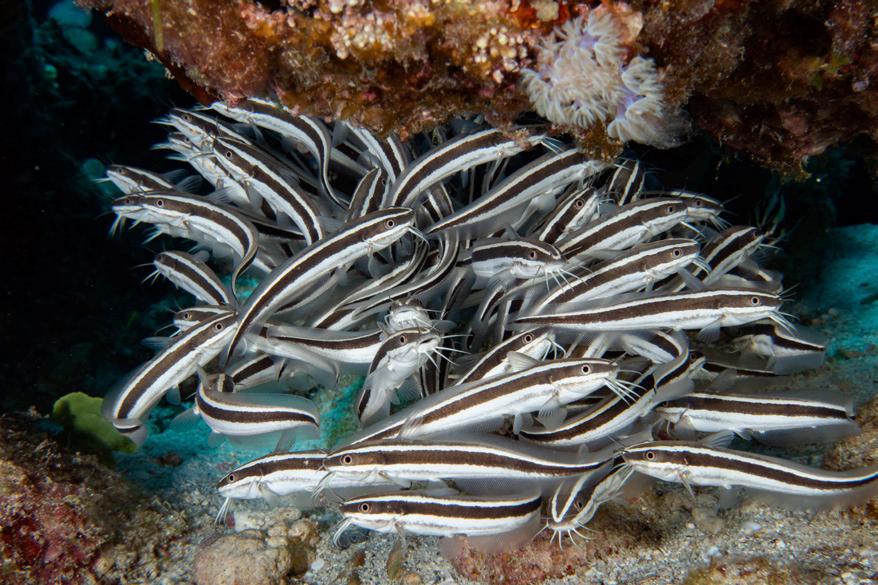
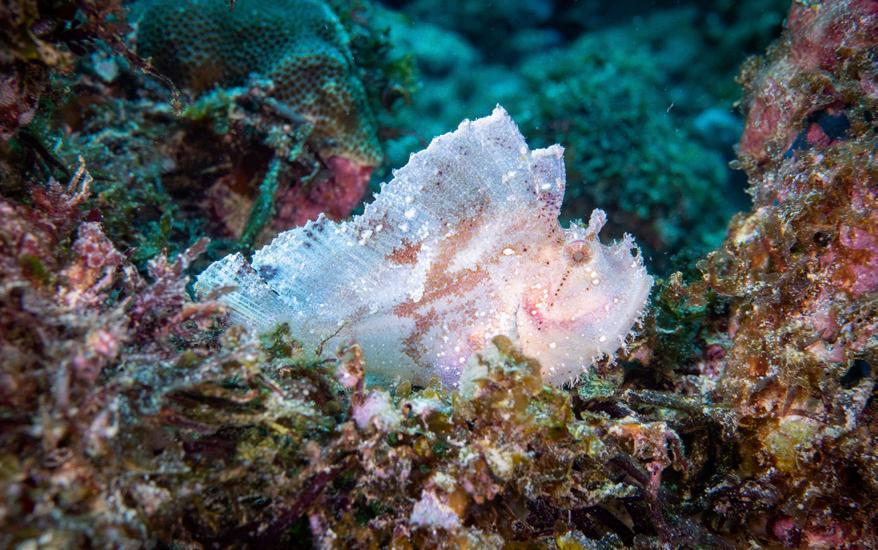
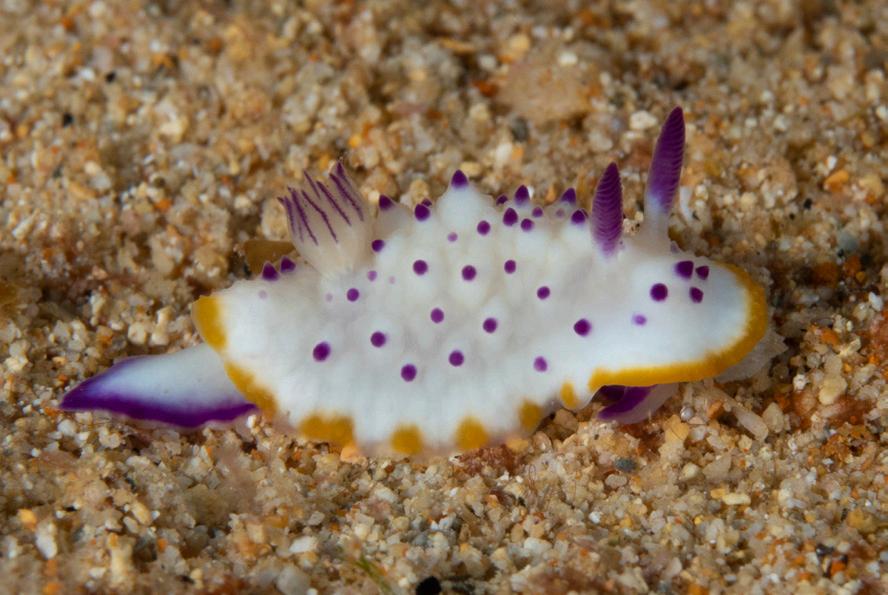



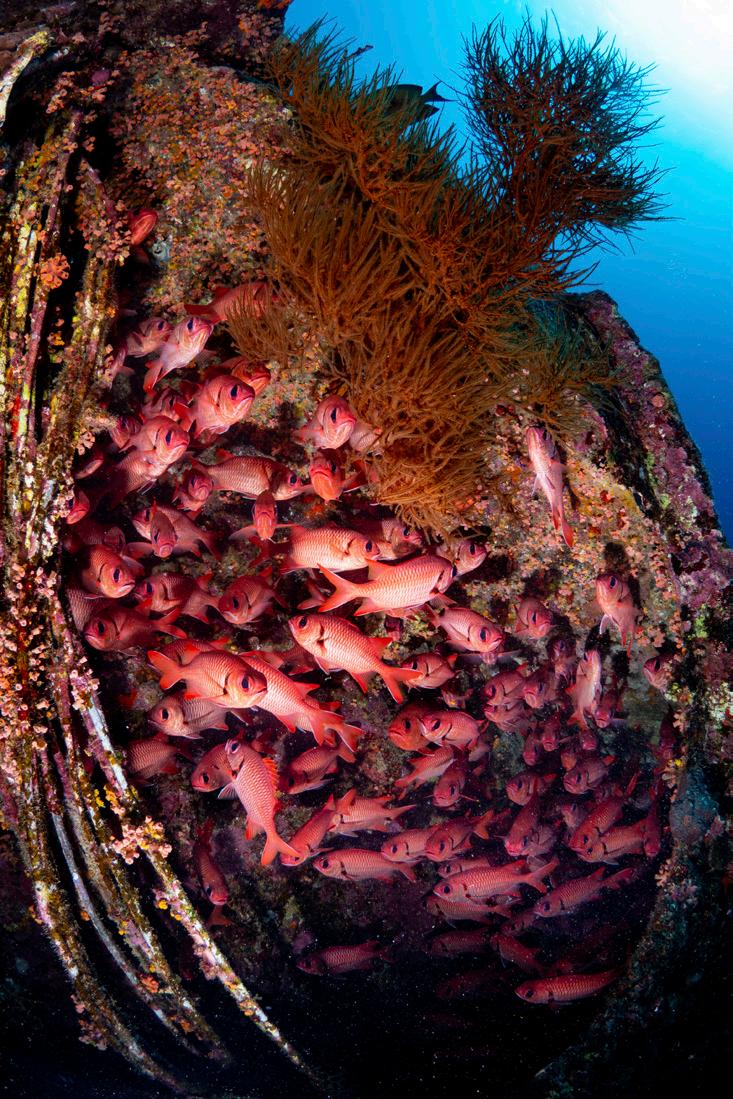






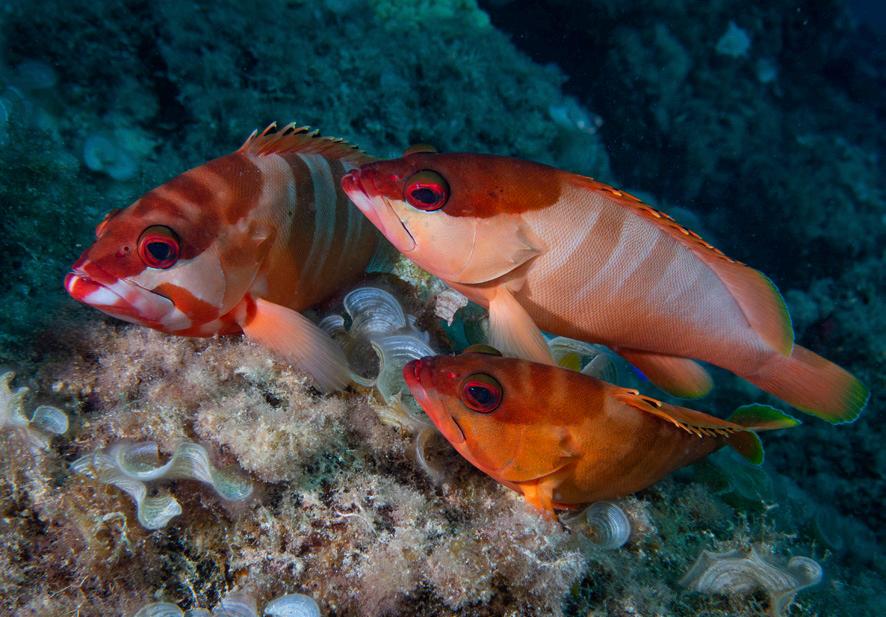
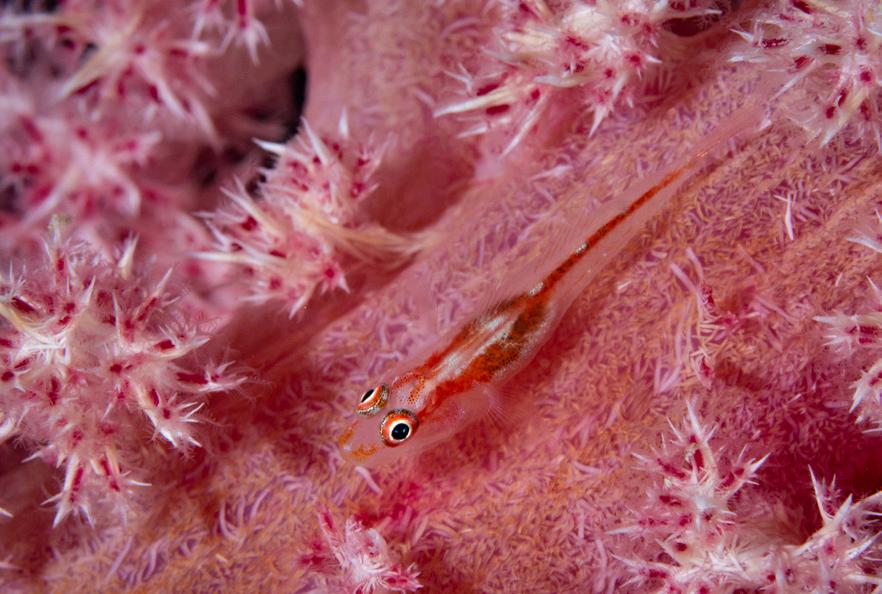

DIVING DESTINATIONS

DIVING DESTINATIONS


weedy scorpionfish (Rhinopias), a species favoured by photographers!
Greatly surprised by the biodiversity of Mauritian waters, I didn't expect to discover so many of the emblematic species that we look for in Asia. With its highly accessible diving, very pleasant conditions and astonishing biodiversity, it’s a surprise there are so few dive boats at the sites. Mauritius has everything it takes to become a must-see diving destination.
BESIDES DIVING, WHAT ELSE CAN YOU DO IN MAURITIUS?
Two dives a day are organised in the morning. Only initiation dives take place in the afternoon. Families usually take advantage of the hotel's magnificent Kids Club (a 2-minute walk from the diving centre) to dive in the morning, and enjoy the rest of the day with the kids. And there's plenty to do. In addition to the traditional activities of lounging by the pool or in deck chairs along the private beach, it's also possible to take a boat ride from the hotel's yacht club to snorkel behind the coral
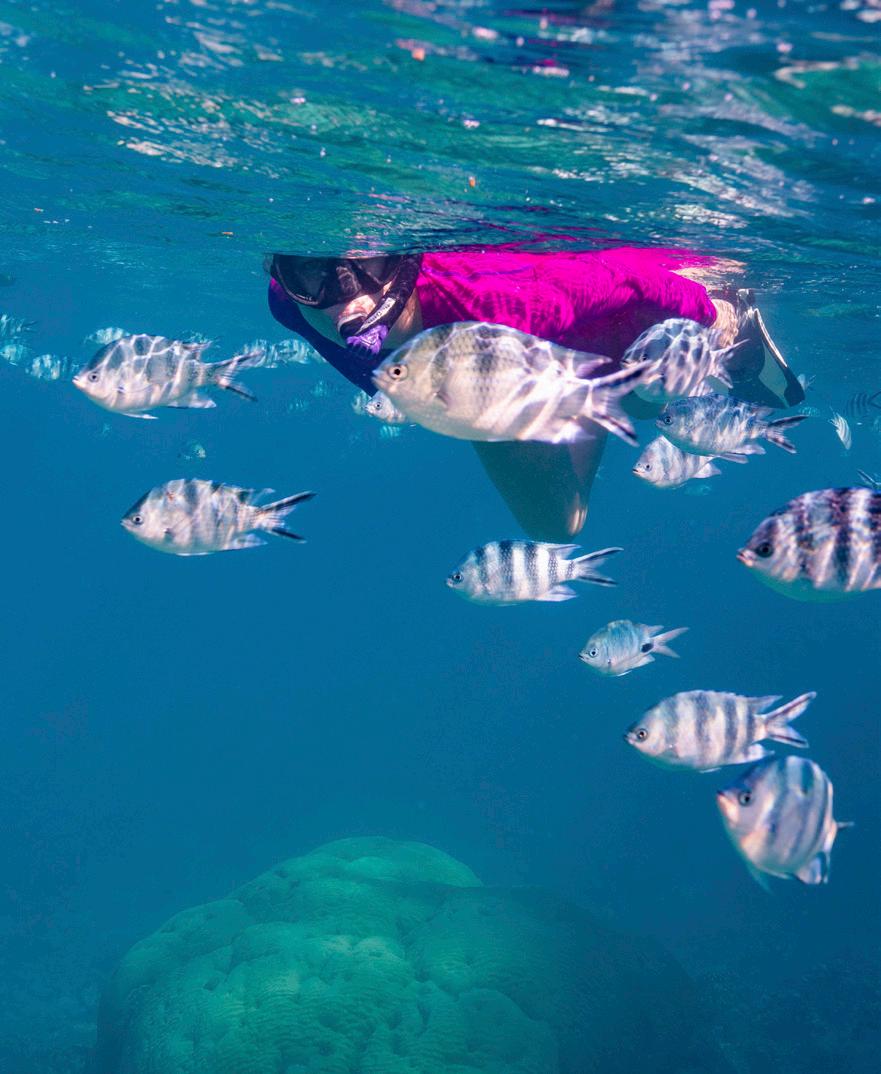

reef to discover a multitude of colourful fish and corals of all kinds.
A little further inland, there are many tourist attractions. A must-see is the famous Pamplemousse botanical garden, with its legendary ponds covered with gigantic water lilies. Cap Malheureux in the north of the island, with its red-and-white church and superb views of small islands such as Coin de Mire. Port-Louis's central market, undoubtedly the capital's liveliest spot, where you can discover the full range of fresh local produce. If you're looking for a good hike, the 7 cascades circuit in the Tamarin region is a fantastic place to combine hiking and swimming. Last but not least, don't miss a trip to the sea around Ile aux Bénitiers, where you can also admire the famous Crystal Rock.
Mauritius is the perfect place to combine the joys of scuba diving, with the pleasures of discovering a most welcoming island, where nature offers a multitude of activities to delight everyone.
LANGUAGES SPOKEN
Creole/English/French
WHEN TO GO
Avoid the months of January to March (hurricane season). The best time for diving is between September and December, but you can also dive the rest of the year. The northwest region (Trou aux Biches) is the least rainy.
CURRENCY
Mauritian rupees
VISA
No visa is required for European passport holders (valid until after the date of return).
HOTEL
Trou aux Biches Beachcomber 5 Star Golf Resort & Spa: www.beachcomber-hotels.com/en/hotel/trouaux-biches-beachcomber
DIVING WORLD DIVE CENTRE
www.diving-mauritius.com
CAB
Kushal will accompany you and show you around his island. Contact him on Whatsapp for details: +230 5717 4529
115 MARCH 2024 | DIVERS FOR THE ENVIRONMENT
DIVING DESTINATIONS
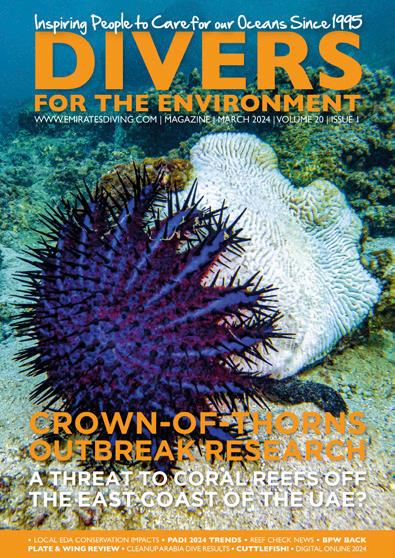


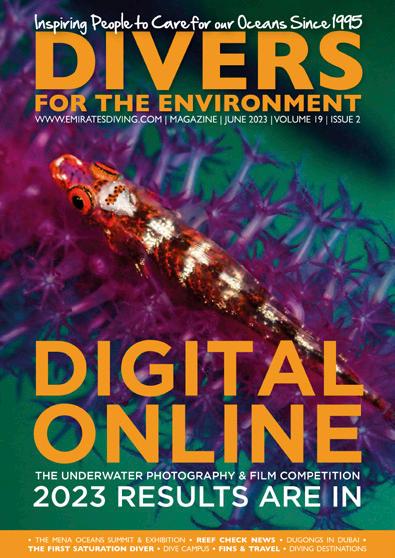



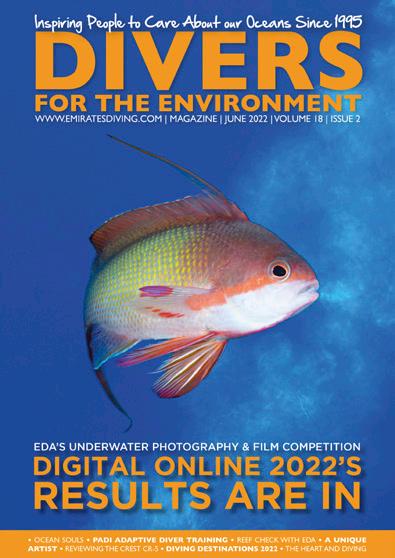
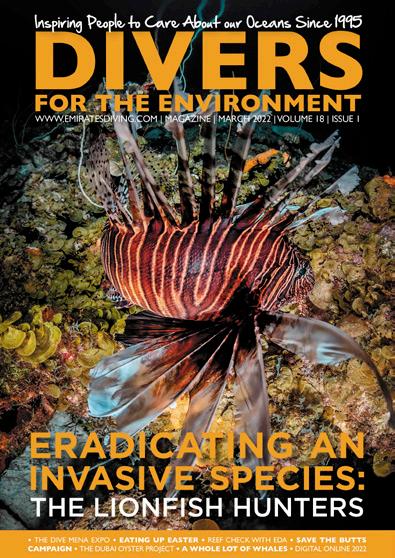










FOR THE OCEANS OCEAN STORIES | CONSERVATION | DIVE TRAVEL Tel: +971 4 393 9390 | Email: projects@emiratesdiving.com | Website: www.emiratesdiving.com EDA is a non-profit NGO accredited by UNEP as an International Environmental Organisation. CLICK HERE EXPLORE ALL OUR BACK ISSUES Beautiful photography and captivating stories, by divers for divers!
REGULATORS:
CE MARKING AND WARRANTY

As divers, we want to breathe as comfortably as possible and trust our regulator to provide us with the right amount of breathing gas during the dive. To help us purchase a reliable regulator, in Europe, manufacturers are legally required to test their regulators according to the European standard EN250 and stamp them with a CE marking. The EN250 standard defines the minimum technical requirements for recreational diving regulators. The latest revision is called EN250:2014.
However, a CE marking does not mean that all CE-marked regulators are the same. It only tells us that a regulator meets the minimum requirements for underwater breathing equipment as defined in EN250. Performance still varies depending on regulator design and operating conditions, such as temperature and depth.
WHAT DOES THE CE MARKING MEAN?
CE marking in accordance with EN250:2014 means that a ‘regulator’ (i.e. a set consisting of a first stage with a single second stage) has been tested for use at depths of up to 50m and water temperatures as low as 4°C. Tests have been performed to make sure the regulator performs well at depth (the breathing performance) and does not freeze up. You may find regulators marked “EN250 >10°C”. These regulators are only approved for use in water temperatures above 10°C.
When two divers are breathing from the same first stage (using a primary second stage and an octopus), the load on the first stage is increased.To be approved for use by two divers simultaneously, the first stage therefore needs to pass additional tests. First stages that have been tested for the intended use with two second stages are marked with the letter ‘A’ (for alternate air source) after the EN250 stamp.
Note however that use for two divers simultaneously is tested only for a maximum depth of 30m. Regulators for water temperatures down to 4°C will be marked EN250A. When limited to above 10°C, the marking is EN250A >10°C. For deeper dives, a cylinder may need to be fitted with two entirely, separate regulator sets (assuming that only one cylinder is used).
MAKING CHANGES
Many divers purchase a regulator and then add an octopus to it, or decide to exchange the hose for another, such as a braided hose or a hose of different length. The important thing to realise is that when changing or installing another second stage, or exchanging a hose (regardless whether any of these are individually CE marked products), the regulator performance might change. The manufacturer is responsible for the performance of the regulator, and you should follow the manufacturer’s instructions when
making changes. Unauthorised changes may result in the regulator being used outside of the approved range and may even void the warranty.
A good example would be if a high performance second stage were connected to an unbalanced first stage. This could result in an intermediate pressure drop, which could in turn increase breathing resistance –potentially to levels exceeding the EN250 requirements – and result in serious problems. Dive equipment manufacturers therefore will have a list of approved individual components (such as first stages, second stages and hoses) and approved additions (such as an octopus), which are certified to be safely used together.
Considering potential safety and even liability implications where operators rent out scuba equipment to divers, it is important to ensure that only regulator configurations certified and approved by the manufacturer are used. Manufacturers sometimes take this a step further and prohibit the use of non-original or non-approved spare parts, such as O-rings, or even lubricants. Many dive operators keep a supply of (non-specific) first-stage O-rings or lubricants. As the use of non-original or nonapproved spare parts could result in serious safety issues, even voiding CE marking and product warranties, manufacturers usually specify that only their authorised dealers, service centres, or trained technicians are permitted to make changes to their regulator sets, and that only manufacturer-approved components and lubricants may be used.
Special thanks to Scubapro for their input on CE certifications for regulators.
ABOUT THE AUTHOR
Guy Thomas is an expert Diving and First Aid Instructor Trainer and works fulltime as Director of Safety Programmes at DAN Europe, where he is responsible for the development and implementation of the DAN Europe Safety Initiatives. He is also a member of the Special Rescue Team of the Italian Red Cross and operates as a Helicopter Rescue Swimmer/Diver Medic, onboard a SAR helicopter of the Italian State Police.
117 MARCH 2024 | DIVERS FOR THE ENVIRONMENT HEALTH & SAFETY
FEATURE
GUY THOMAS
SILENCE IN THE TOWER OF BABEL: A BRIEF STORY ABOUT HAND SIGNALS
BY AUDREY CUDEL
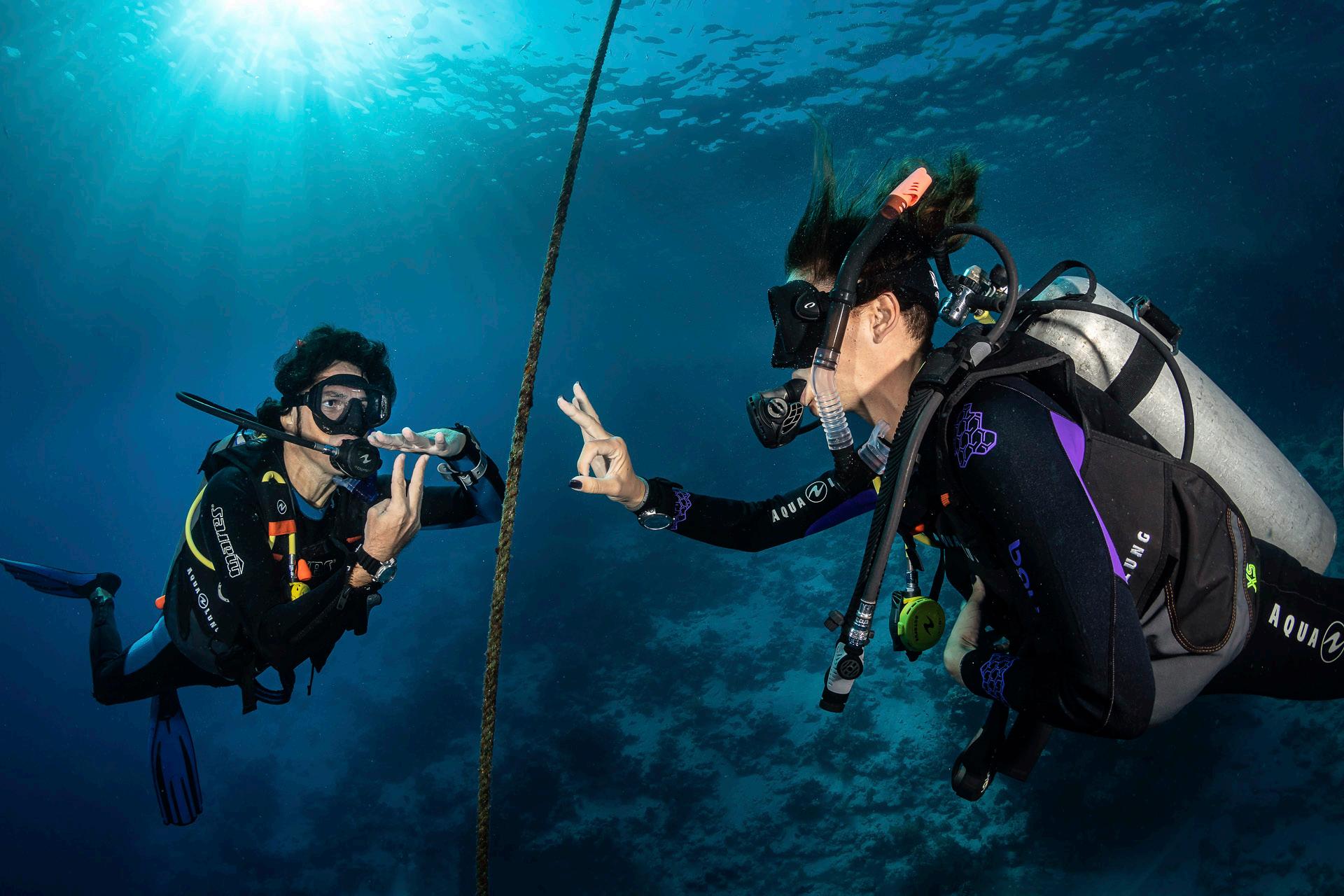
When landlubbers ask divers the reason why they are attracted to such a hostile world, the most common answer is that beyond the discovery of the underwater wonders, Jacques Cousteau’s Silent World provides a soothing feeling of zen and inner peace…until the noise of a diving shaker or your buddy’s agitated hands wake you up all of a sudden and bring you back to a basic reality: the need to communicate.
Communication underwater deals serve two main purposes, safety and decision making within the team. Safety-related communication entails assessing a divers condition, checking gauges, defining a depth, a level, an exit direction or a decompression constraint. Decision making is required to deal with unexpected events or emergency situations.
For the vast majority of open circuit divers, the means of communication underwater are nonverbal and quite limited. Writing is effective but time consuming. Light signals are pretty basic and only operate in dark environments. Touch signals are even more limited. And while voice communication in full-face masks is available, it hasn’t proven very popular in the diving community outside of scientific projects… maybe because in the end, we’d rather ‘talk to the hand’ and keep the underwater experience as silent as possible.
For the most part, we are left with two hands and ten fingers to engage in conversation. Some techies will argue that one hand and five
fingers must suffice, as the fact that the other hand might be busy with a light, spool, or other tool. Divers also use gestures familiar from everyday life, like nodding one’s head for ‘Yes’. Others may be local, for example to point out species of marine life. Special signals have been created for specific diving circumstances, to give instructions, provide information, or to indicate a condition or emergency.
It would be great if we all shared a common language of hand signals derived from those with similar meanings on land, to reduce learning effort and time and simplify the communication. The reality is slightly different. Despite the effort of the RSTC (Recreational Scuba Training Council), and even though there is a range of commonly used signals, the recreational diving community has developed a variety of confusing dialects which can make one feel lost in translation.Who hasn’t attended pre-dive briefings where flashing twice five fingers translates into a half cylinder’s pressure, when at other times it might be expressed by forming a ’T’ with one hand perpendicular to the other?
This diversity can make communication between divers imperfect at best and nonexistent at worst. Its cause isn’t so much a sundering of languages like in the story of the Tower of Babel as parallel developments in different communities isolated from each other. As a result, one could argue that in the recreational diving world, the risks are limited but the potential for miscommunication can
make emergencies worse.
In technical diving, the situation is different: Despite the variety of training agencies, the tech community can pride itself on speaking one common language, necessitated by the greater risk compared to recreational diving. Tech diving signals are onehanded using five fingers (with special adaptations when the hand is covered by mitts or three finger gloves). Information is often provided using a signal to indicate the subject (e.g., pressure, depth, time), followed by a number. Numbers are indicated by a sequence of digits. Digits from one up to five are given with the fingers pointing up and the palm facing outward, while digits from six to nine are given with the hand held horizontally and the palm facing inward. Ten, being a double-digits number, requires a ‘one’ followed by a ‘closed Ok’ for ‘zero’. As a rule, the use of the thumb is avoided whenever possible to avoid confusion with the thumb up signal for ‘end the dive’.
Technical diving usually involves decompression and/or overhead environments. Specific onehanded signals have been developed for both and are shared among all technical divers no matter their background. Reviewing each individual signal would go beyond the scope of this article, but if you’re interested, the information is easily available online.
Another major difference between recreational and technical communication is the avoidance of everyday gestures. Techies don’t like room for interpretation or trusting the ‘obvious’. Instead, they crave for clarity through confirmation of any given hand signal. Communication not just about delivering information but also about making sure it has been properly received and understood. Confirmation plays a major role in avoiding loss of information and is critical for the team’s safety.
In an ideal future silent world, signalling practices from technical diving will spread to the recreational world to avoid confusion and the need for re-learning processes, for the sake of safety. Hush…
118 DIVERS FOR THE ENVIRONMENT | MARCH 2024 HEALTH & SAFETY
UPCOMING EVENTS
DIVE MENA EXPO
CO-LOCATED AT THE DUBAI INTERNATIONAL BOAT SHOW
28 February - 3 March 2024 | 3-8pm | Dubai Harbour

Whether you are a seasoned diver or someone who has never even set foot in the water, there will be something for you to see and learn at the 2024 Dive MENA Expo. Discover the stories of men and women who serve as pioneers in the industry!
AN EDA MOVIE SCREENING
DIVING
INTO THE DARKNESS
Thursday 2nd May 2024 | 6:30pm | 96 mins | Deep Dive Dubai

Canadian explorer and storyteller Jill Heinerth is one of the world’s greatest living cave divers, fuelled by an insatiable curiosity to explore the unknown “veins of mother earth”. Jill has been involved in the most legendary and demanding cave diving expeditions of all time, from surveying the world’s longest caves in Mexico to discovering giant iceberg caves in Antarctica. Juxtaposed with these hair-raising dives are intimate, candid interviews and animated flashbacks to her younger years that reveal a complex array of motivations for taking on these challenges. Despite how over 100 of her friends have perished in the depths, for Jill, each adventure in this dive odyssey is one step closer to becoming the woman she wished she’d met when she was a child.
DIGITAL ONLINE 2024
1. OPEN FOR DIGITAL ONLINE PHOTOGRAPHY & FILM SUBMISSIONS
4 March - 4 April 2024 at 11:59pm (GST – Gulf Standard Time): Rules & Guidelines page 87.
2. AWARDS & NIGHT + SPECIAL GUEST PRESENTATION (page 91)
Thursday 16 May 2024 | 7pm | Deep Dive Dubai
We are very much looking forward to this year’s Digital Online – Underwater Photography & Film Competition Awards & Exhibition Night social with our partners at Deep Dive Dive. We have inspiring Judges on our panel, and our prize sponsors have offered this year’s winners some incredible prizes. We hope you will join us in congratulating this year’s winning photographers and videographers, and enjoy the evening mingling with other members to see the new photography and films that will be on display.

We want to invite you to discover the latest ninth issue of Shark News – the official IUCN Species Survival Commission (SSC) IUCN SSC Shark Specialist Group (SSG) magazine.
Shark News provides a forum for the exchange of information on all aspects of shark, ray, and chimaera conservation matters for SSG members and the general interested audience.
WEBSITE: https://lnkd.in/ei5J-Utc
ISSUU: https://lnkd.in/eC8APJkp
Rewilding Indo-Pacific Leopard Sharks, a groundbreaking step. Dive into Angola and Papua New Guinea’s shark fisheries with our Q&A series featuring emerging scientists. Learn about the impact of pollution on sharks and rays. Discover Oman’s crucial role in ray surveys for the fin and meat trade. Uncover the Mediterranean’s history as a hotspot for endangered sharks. Witness Iran’s innovative approach to shark conservation. Participate in the global Great Eggcase Hunt with citizen scientists. See the Canary Islands’ efforts in habitat protection, research, and policy integration. In Central America and the Caribbean, explore a new nurse shark species, Panama’s community interactions with sharks, and transformative shark education in Turks and Caicos. The ISRA project, with over 450 contributors, has identified 255 key shark and ray conservation areas. With three new regions in 2024, your support is vital for shark futures. Celebrate this year’s shark discoveries and the SSG’s achievements, thanks to your help.
BOARD OF DIRECTORS
Chairman | HE Essa Al Ghurair
Vice Chairman | Juma Khalifa Bin Thalith
Financial Director | HE Major General Khalfan Khalfan Quraiban Al Mheiri
Secretary General | Jamal Abdulla Buhannad
Head of Technical Committee | Dr Juma Khalifa Alrahoomi
Head of the Women’s Committee | Maitha Al Qader
Board Member | HE Talib Ali Aldhuhoori
Board Member | Abdulla Salem Alruwaihy
Board Member | Ahmed Sultan Al Hasawi Al Tamimi
EXECUTIVE TEAM
Co-Founder | Ibrahim Al Zu’bi
Email: projects@emiratesdiving.com
Project Director | Ally Landes
Email: magazine@emiratesdiving.com, photo@emiratesdiving.com
Project Coordinator | Layla Nouilati
Email: projects@emiratesdiving.com
Reef Check Trainer | Rania Shawki Mostafa
Email: reefcheck@emiratesdiving.com
Health, Safety & Technical Chief Inspector | Mohamed Faraj Abdulla Jaber
Email: inspection@emiratesdiving.com
MISSION STATEMENT
Our mission is to conserve, protect and restore the UAE’s marine resources by emphasising and promoting the underwater environment and environmental diving.
LEGISLATION
EDA is a non-profit NGO registered with the Ministry of Community Development as per the Ministerial Decree No. 149.
The Decree stipulates the following responsibilities for EDA:
• Ensure environmentally respectful diving practices in all EDA members.
• Support the diving industry within the UAE by coordinating the efforts of the diving community.
• Promote safety in the commercial and recreational diving fields through standardisation of practices.
• Preserve historical aspects of diving within the gulf region and enhance environmental education to diving and non-diving communities through EDA projects and events.
PUBLISHED BY
Emirates Diving Association
P.O. Box 33220, Dubai, UAE
Office Location: Jumeirah 1, Al Hudaiba Awards Buildings, Block B, 2nd Floor, Office #214
Tel: +971 4 393 9390
Email: projects@emiratesdiving.com
Website: www.emiratesdiving.com
While every effort and care has been made to ensure the accuracy of the information contained in this publication, the publisher cannot accept any responsibility for errors or omissions it may contain.
No part of this publication may be reproduced in a ny form or by any means without the prior written consent of the publisher.
Copyright © Emirates Diving Association 2024
SOCIAL MEDIA CHANNELS
www.Facebook.com/emiratesdivingassociation
www.Instagram.com/emiratesdivingassociation (EDA News)
www.Instagram.com/eda_uae (Digital Online Gallery)
www.twitter.com/EDA_UAE
www.YouTube.com/@emiratesdivingassociation
www.Issuu.com/allylandes
PRINTED BY
Al Ghurair Printing & Publishing LLC
119 MARCH 2024 | DIVERS FOR THE ENVIRONMENT
ROUND-UP
DO YOU KNOW? SHARK NEWS: ISSUE
JANUARY 2024
9 |
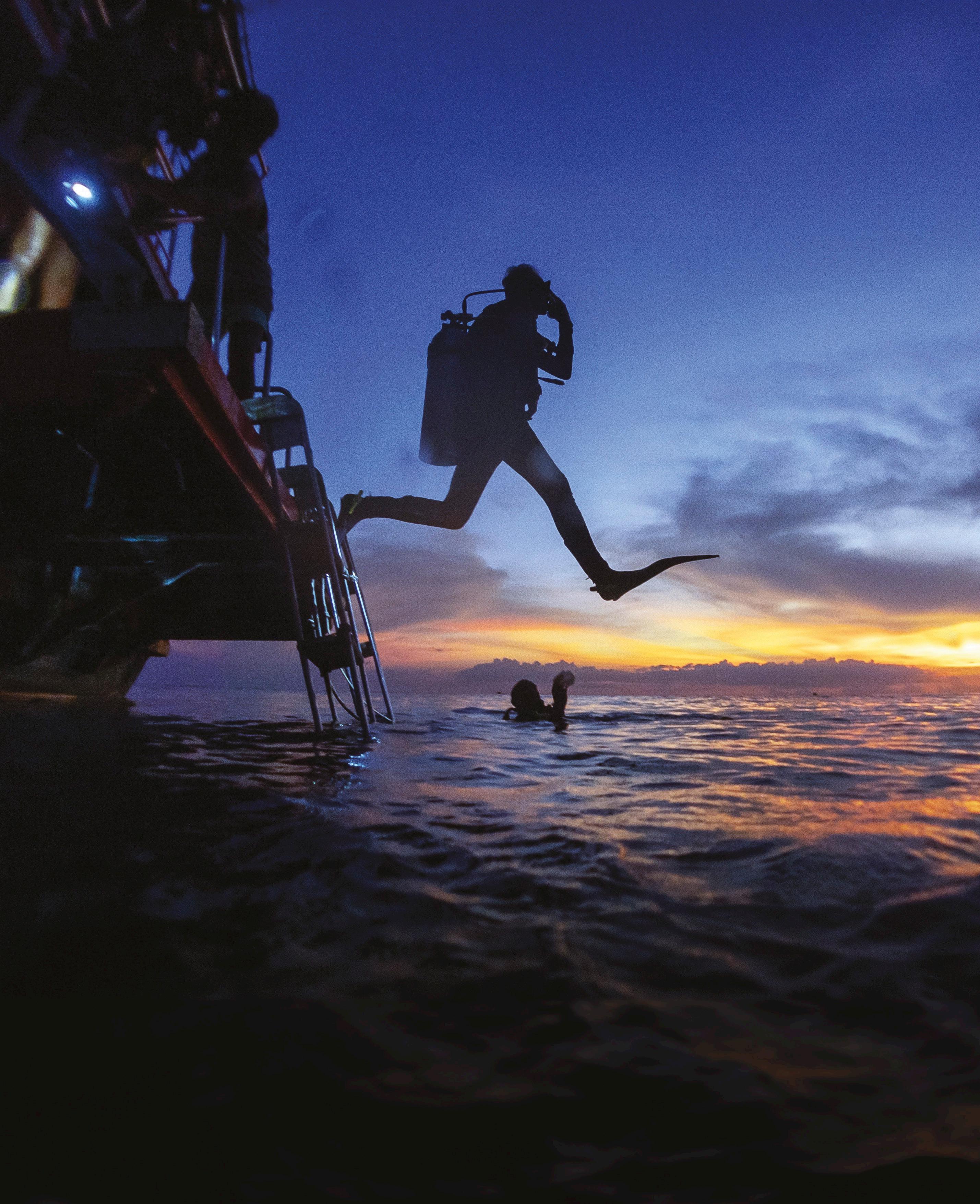
120 DIVERS FOR THE ENVIRONMENT | MARCH 2024 Join us at the 30th edition of the Dubai International Boat Show , the region’s largest and most established boat and marine lifestyle show, where professional divers and enthusiasts can learn about new techniques, try out the latest equipment and meet experts from the diving industry. It’s all at Dubai Harbour, the largest and most sophisticated marina in the MENA, from 28th Feb - 3rd Mar 2024, with DIBS 2024 ORGANISED BY SUPPORTING MARIN ACTIVITY HOSTED AT FREE ENTRY WITH YOUR DIVING LICENCE CO-LOCATED WITH OFFICIAL MEDIA PARTNER PARTNER EXPERIENCE AN EXTRAORDINARY JOURNEY 28 FEB - 03 MAR DUBAI HARBOUR HOSPITALITY PARTNER
























 AL-ZU’BI Co-Founder
AL-ZU’BI Co-Founder
 Ibrahim Al-Zu’bi
Ibrahim Al-Zu’bi




























































































































































 A dolphin leaping over the wake of the waves made by the OceanX vessel while moving. Observers stationed on the bridge spotted dolphins on multiple occasions.The team was able to get onto the smaller vessels and approach the dolphins from the surface whilst also observing from the bridge. Truly a team effort! Photo by Rebekka Pentti.
A dolphin leaping over the wake of the waves made by the OceanX vessel while moving. Observers stationed on the bridge spotted dolphins on multiple occasions.The team was able to get onto the smaller vessels and approach the dolphins from the surface whilst also observing from the bridge. Truly a team effort! Photo by Rebekka Pentti.
























































































































































































































